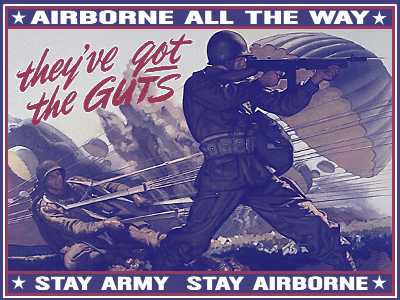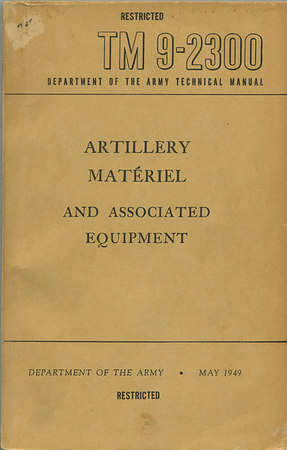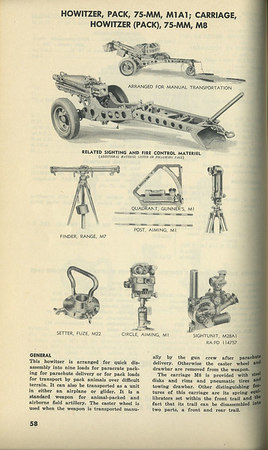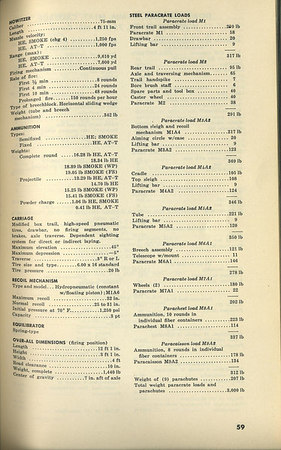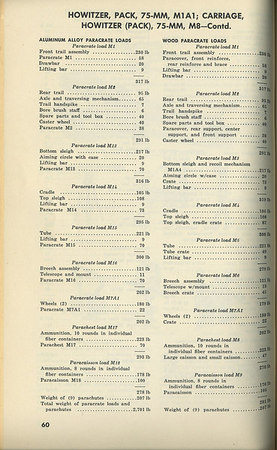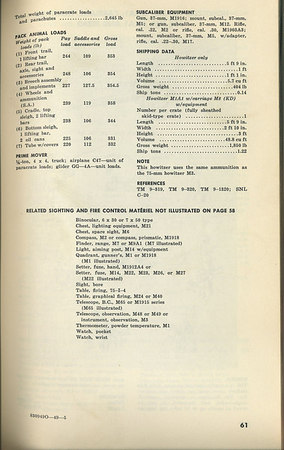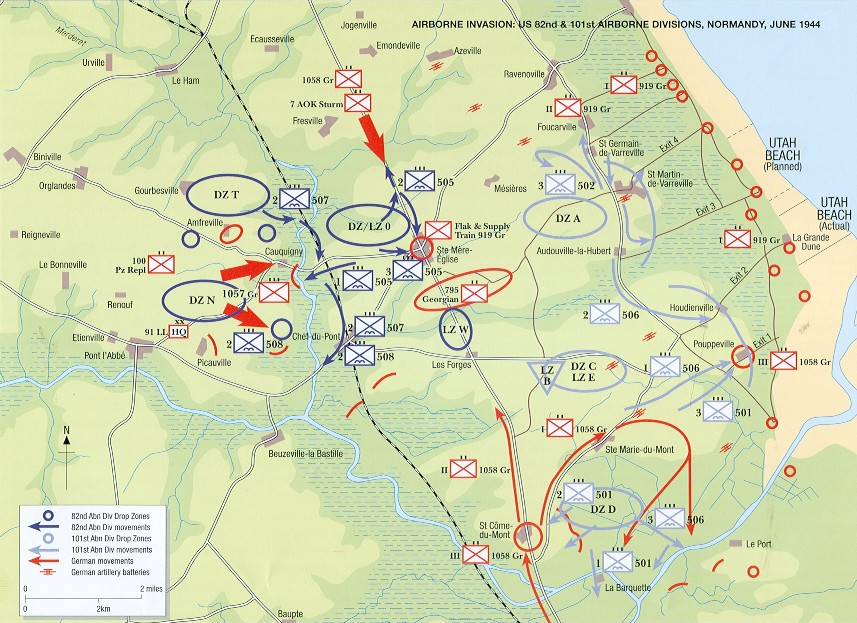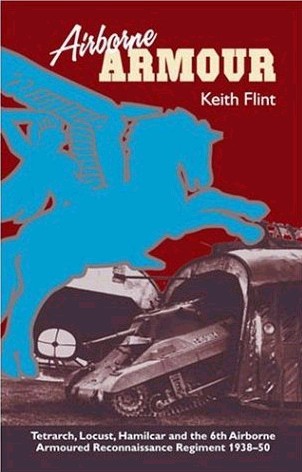
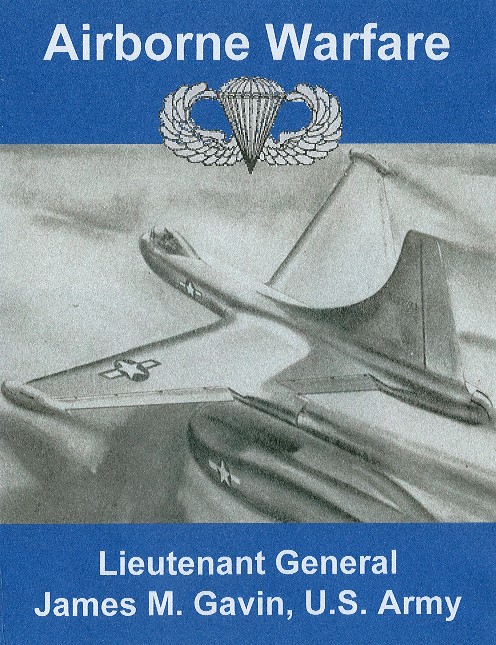
"It was 2,200 yeas later when sea power reached its full potential. Then, in the battle of Normandy, the Allied powers, using hundreds of seacraft of all types, invaded the Continent of Europe. The sea was used to its fullest. It is significant, however, that part of the invading forces were transported by AIR. It was significant because that battle saw sea power at its peak. AIR power was just beginning. And this is the critical point that we have arrived at, and this is the competition we are in. This media that envelops us we must use. We must imagine, design, and develop the means and methods of using it. We must--if our people and our institutions are to survive. For the people with their institutions who best learn how to use this media will survive in this highly competitive world.AIR power is now the decisive element in modern war. And by AIR power is meant every contribution to waging war that man has created and that can be flown. Men, weapons, ammunition, food, bombs, missiles, and all that it will take to fight a future war must FLY. Clearly, therefore, in the development of our AIR power and Airborne potential changes must be made in our ground force equipment as well as in our Air Force equipment.
...The conventional type steel and cast iron earth-bound tank cannot in its present form win the battle with air-transported shaped-charge weapons. In its present form it is as exctinct as the elephants of Zama and the heavily armed knights of Agincourt. The entire Airborne-armored problem must be viewed in the light of the capabilities of modern shaped-charge [RPGs] and rocket weapons. The same is true of our communications equipment, tracks, reconnaissance vehicles, artillery, food, and in fact, everything must be flown.
Organizations created to fight the last war better are not going to win the next. Nor is building an airplane around the ground weapons that won the last war an assurance that we will win the next. Keeping foremost in our minds the functional purposes of our means of ground combat, these means must be developed and produced so that they can be delivered to the battlefield in sufficient quantity to gain the decision. Not only must our airplanes, 'chutes, ..be developed but our ground fighting weapons and equipment as well. Only thus, will we attain a position of dominance in Airborne Warfare.
The nation that in the future has the best trained and equipped Airborne Forces has the best chance of survival. Indeed, more than this, only by having such security forces can any nation survive. For as long as these means of waging modern war are available to us, they are available to aggressor nations. And modern Airborne Forces of aggressor nations cannot be fought successfully with the weapons that fought past wars. Not if they are to be engaged at parity and beaten.
Airborne troops are our best national security and the world's most promising hope for international security.
The knowledge of the existence of a well trained Airborne Army, capable of moving anywhere on the globe on short notice, available to an international security body such as the United Nations, is our best guarantee of lasting peace. And the nation or nations that control the AIR control the peace."

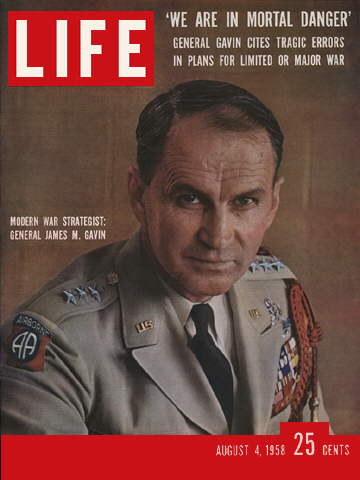
1st Tactical Studies Group OBSERVATIONS to Gavin's book are in DARK RED
Gavin's paratroopers in WW2 were handicapped by civilian DC-3s in Army green (C-47 nickname: SkyTrains or Dakotas) that couldn't carry an intact platoon of men and easily caught fire without armor or self-sealing fuel tanks resulting in preventable losses of the 22 it did carry. Unable to parachute drop intact towed guns much less parachute dropping ground vehicles, this forced DC-3s to tow CG-4A Waco gliders that could carry either a towed gun or a jeep---but not both. The British in contrast, had larger Horsa and Hamilcar gliders that could carry both towed gun + prime mover and even Tetrarch or Locust light tanks or a pair of Bren gun open-top armored personnel carriers. They even had Halifax bombers that could parachute drop either two jeeps or a jeep and a towed gun from their bomb bays. For the Americans to get anti-tank guns to the fight they had to C-47-tow gliders--this meant large, open area landing zones had to be secured for the gliders to roll to a stop. Unlike the British Halifax bombers, DC-3/C-47s were without armament--the DC-3s were vulnerable to enemy fighter planes, so Gavin revolutionized airborne operations by night jumps which also protected the planes from anti-aircraft fires. To overcome the confusion of being in the dark, Gavin had his men memorize terrain features and sand table rehearse plans and contingency plans and be self-reliant and able to take the initiative in non-linear battlefield situations not be lemming marines. He created pathfinders to mark drop zones in the dark to improve assembly on top of objectives so they didn't have to walk far. Studying the German's troubles jumping from the very small JU-52 jump door, he exploited the large C-47 jump doors by having every Paratrooper jump complete weapons and equipment and minimize separate container drops to just 75mm pack howitzers in pieces but roped together for fast re-assembly. Because supplies could only be dropped through small fuselage openings or under-wing shackles, they were spread out all over and difficult to recover from open areas where the enemy could fire, and paras lacked vehicles with armor protection.
All of these conditions are not true today so there is no excuse why the U.S. Airborne is still handicapped! The current U.S. Airborne is a disgrace to the memory of the Airborne forefathers sitting on laurels bought and paid for by others and accepting self-serving handicaps that don't exist.
GPS insures that t-tail aircraft not only drop EXACTLY where we intend, but tell paras on ground exactly where they are. No need for rolling open fields for gliders to roll, a single nitrogen inerted fuel tank C-17 t-tail ramp aircraft can drop 80 tons on supplies on pallets, and M113 Gavin light tracked armored fighting vehicles can be on these pallets to not only recover the supplies with forklifts but also transport para infantry and anti-tank weapons ready-to-fire on the vehicle not towed---at 60 mph under armor protection. Air refueling enables fighters to escort our t-tail transports but our transport aircraft could and should be armed with their own air-to-air missiles and radar-guided cannon to swat SAMs in self-defense. Delayed opening timer parachutes with small drogue chutes would enable every para to jump if needed from high altitudes around 10, 000 feet above enemy air defense and have his main chute open at low altitude for a normal jump. Furthermore, with M113 Gavins paras need not land on top of heavily defended objectives but can take them by surprise from indirect drop zones. An American Airborne that foot-slogs or rides in road-bound, wheeled trucks when it has the most airlift of any force in human history---more than enough to have hundreds of amphibious, cross-country-mobile light tracked AFVs in use---is a disgrace.
All of the handicaps of the WW2 Airborne are solved, we just need people with 21st century minds in today's Airborne who want to execute 3D maneuver warfare as a Gavin "Sky Cavalry" not sit on their asses and do taxpayer-funded, seize & hold WW2 re-enactments pretending they are crippled when its all in their minds.
Furthermore, reading the war diaries of the British light troops surrounded near Arnhem below:
www.pegasusarchive.org/arnhem/war.htm
Its increasingly clear that 3D maneuver troops must have a "hard shell" in the form of their own light tracked armored fighting vehicles (LTAFVs) so enemy high explosive pounding of them will not attrit them to where they cannot hold a position. These light tracked AFVs should also have back hoes attachments so overhead cover fighting positions and hull-down vehicle positions can be created to bolster the baseline vehicle armor. LTAFV armored mobility also insures airdropped supplies---however they are scattered---can be recovered so even though the 3D force is in a non-linear situation with enemy all around, their fighting strength can be perpetuated indefinitely til the heavier 2D forces link up or they themselves implode the enemy resistance by their own maneuver actions.
The other handicap light troops have against heavier enemy troops is that they don't have the supplies to artillery duel with them to keep them from laying down mortar, rocket and artillery pressures upon them since the latter has home field advantage of greater supplies in hand. The air-mechanized light force needs to never be outgunned and LTAFVs enable this because they can self-propel in a ready-to-fire manner tube and rocket/missile artillery that can through clever design keep the enemy's artillery shut down. Also notice how CAS fighter-bombers when overhead silence enemy guns---the AMS force should have its own "hip-pocket" air force of fighter-in-a-box (FINAB) aircraft in ISO container BATTLEBOXes delivered by KIWI pod aircraft right there on the scene operating from their airhead to do CAS as well as interdict enemy fighter-bombers and pesky UAVs from surveilling overhead to help target for the enemy.
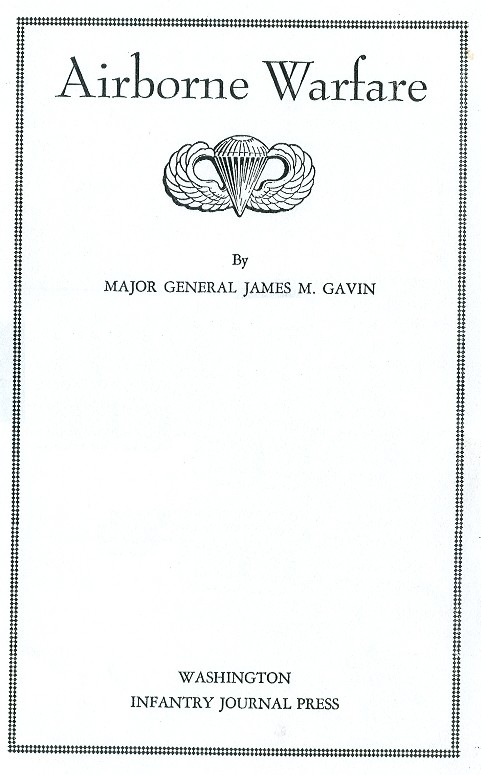
FIRST EDITION
PRINTED IN THE UNITED STATES OF AMERICA
CONTENTS
INTRODUCTION by Major General William C. Lee USA (R) Page VII
CHAPTER 1: PARATROOPS OVER SICILY Page 1
CHAPTER 2: PLANS AND OPERATIONS IN THE MEDITERRANEAN Page 18
CHAPTER 3: BACK DOOR TO NORMANDY Page 37
CHAPTER 4: HOLLAND: AIRBORNE ARMY'S FIRST TEST Page 68
CHAPTER 5: THE AIRBORNE OPERATIONS OF 1945. Page 123
CHAPTER 6: AIRBORNE ARMIES OF THE FUTURE Page 140
CHAPTER 7: ANTI-AIRBORNE DEFENSE Page 161
CHAPTER 8: THE USE OF AIRBORNE TROOPS IN THE FUTURE Page 170
INDEX Page 176
PHOTOGRAPHS Page 179
Page V
INTRODUCTION
THOUGH AIRBORNE WARFARE is new, the idea is old.
Throughout the centuries military men, watching the flight of birds or the drift of smoke on the wind, must have dreamed of the vertical envelopment. If we delve far enough back into history we would probably find that the ancient Chinese began the whole business by inventing the parachute. Records of old Peking indicate that they did. We know for certain also that in the fifteenth century, Leonardo da Vinci designed a parachute. In the eighteenth century, the Frenchman, Montgolfier, launched the first successful balloon, and late in the same century the famous European balloonist, Blanchard, made a parachute jump to save his life. After that, parachute jumps from balloons became common events and by the time the Wright brothers flew at Kitty Hawk the idea of the parachute was at least six centuries old. And it was over a hundred and fifty years ago, that Benjamin Franklin made his much quoted suggestion about the use of balloon-borne troops in war.
In more modern times, Mr. Winston Churchill and the late Brigadier General William Mitchell are both credited with advocating the use of parachute troops in World War 1. Even in relating it to World War II, we find that actual development of airborne warfare had progressed to a considerable extent at the time the Germans invaded Poland. By 1927, different armies of the world had carried out experiments of dropping equipment by parachute and transporting small numbers of fighting men by aircraft. In Texas the following year, our own Army dropped a small number of men by parachute with weapons and ammunition. In 1930, the Red Army dropped a group of military parachutists with equipment, and in 1936 it was reported that the Russians had dropped over five thousand parachute troops in a single operation during maneuvers at Kiev. By 1938, the Command and General Staff School of the U.S. Army was beginning to touch on airborne warfare in its theoretical tactical instruction. And, finally, in the Russo-Finnish War of 1939, came the significant
Page VII
report that Russian parachute troops had been dropped in actual combat. At the outbreak of World War II, both the USSR and Germany had trained many thousands of parachutists, and the German Army had done considerable experimentation with gliders. Germany used airborne troops in large numbers with effective results in the 1940 invasion of Holland and the next year in the conquest of Crete.
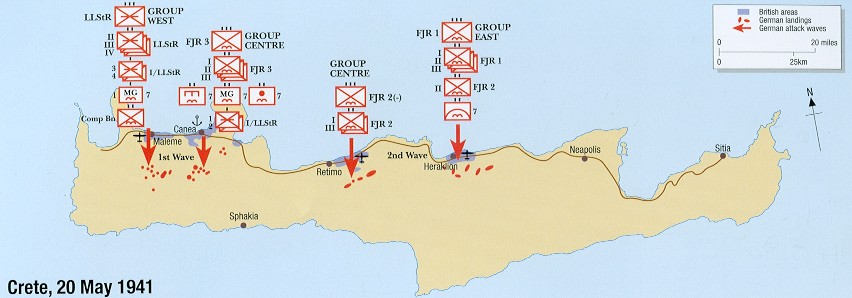
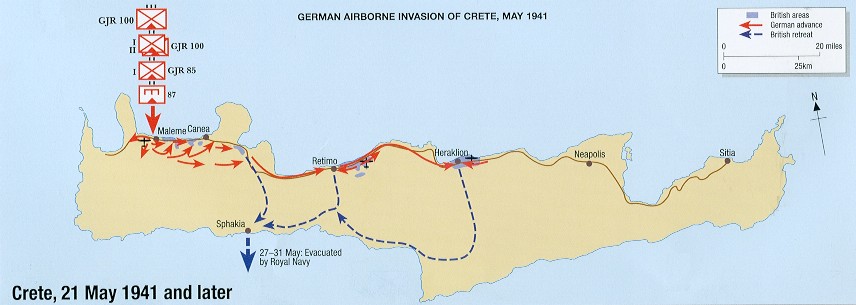
Early in 1940, our own War Department had taken steps to develop American airborne units. Under the direction of Major General George A. Lynch, Chief of Infantry, in collaboration with the Chief of Air Corps, a program of development was approved and airborne troops for the first time became an integral part of the Army.
Thus it is a historical fact that airborne warfare, at least in the modern sense, was originated by the Russians and developed to a state of combat effectiveness by the Germans.
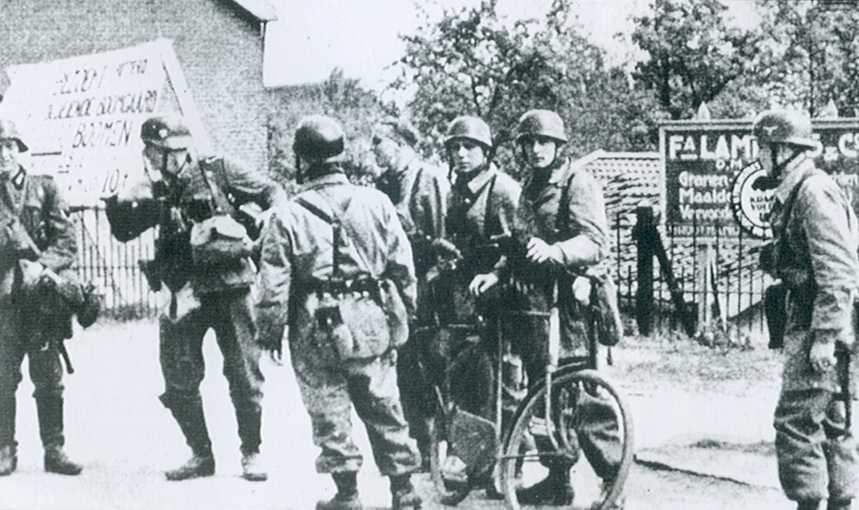
But it is also a historical fact that the American Army took this new instrument of warfare and, with the British, refined and improved it and unleashed upon our enemies airborne forces of such power and perfection as even they had not dreamed of.
The pioneering phase of our airborne development began at Fort Benning, Georgia, with the organization of one small platoon of volunteer paratroopers. These pioneers, and the small group of intrepid aviators who worked with them, were the fountainhead of the mighty airborne forces that wrote such glorious pages in the history of World War II. The glory of those achievements rightly belongs to those who won the victories on the field of battle, but the unsung pioneers who blazed the early trails from the skies to the red clay hills of Georgia and the sand hills of North Carolina deserve at the very least a modest tribute. They too sweated out their fear of the unknown and charted new roads of courage. Many of them died in training that their successors might conquer in battle. When, in July 1943, the world was thrilled by the exploits of the 82nd Airborne Division in Sicily, there was not a man of the pioneer group whose heart did not swell with the fiercest pride in the realization of a dream come true.
Page VIII
The author of this book was one of those pioneers.
It was a hot sultry day in August when Captain James M. Gavin, thirty four years of age, reported for duty with the Provisional Parachute Group at Fort Benning, Georgia. As a former enlisted man in the Regular Army and as a graduate of the United States Military Academy of the class of 1929, his service had been varied and broadening. His friends spoke exceedingly well of him, and he impressed his associates with his quiet dignified bearing, his appearance of lean physical toughness, and his keen and penetrating mind. His work as a battalion officer marked him for greater responsibilities and promotion to major, and then to lieutenant Colonel.
The rapid expansion of our airborne forces, immediately after the attack at Pearl Harbor, created many strange and complex problems and a vast amount of work, the activation of new units, the development of new types of weapons, all new equipment, new tactics and new methods of training were only a few of the arduous difficulties that confronted the builders of the new forces. Mistakes were made and many of them, but the building seems to have been fundamentally sound. No one man or no small group of men can be credited with this achievement. Many men and many elements made the project successful. But in the last analysis, the burden of building this great new force fell on the shoulders of the staffs of the Airborne Command of the Ground Forces and the Troop Carrier Command of the Air Forces, and on those staff officers in Washington who directed the planning on the higher levels. These were the architects and not the least of them was Gavin. In the building of this force, Gavin was a dynamo of intelligent energy. As the head of the Plans and Training Section of the Parachute Group, and later the Airborne Command, he wrote many of our basic training doctrines and our first textbooks on airborne training and tactics. By late 1942, he had received his colonelcy and the command of his own regiment. In January 1943, his regiment was assigned to the 82nd Airborne Division, and on the night of July 9 of that year he commanded the airborne
Page IX
combat team which spearheaded the American assault of Sicily. This book is Gavin's story of that assault as well as all the airborne combat that followed until the end of the war, and it is his interpretation of those events as applied to future war. From Sicily to Italy to England, Jim Gavin continued to pioneer, and to win his battles. In rising from Colonel to Brigadier general he continued to learn warfare. As airborne adviser to the Supreme Allied Commander in London, he was determined that costly mistakes made in Sicily must not be repeated in Normandy. Upon his arrival in England from Italy, he was immediately enmeshed in the intricate details of operational plans of the Allied airborne forces, working closely with the British and American airborne commanders. The success of those forces on D-Day is all the evidence needed of the brilliancy of his work. As assistant division commander of the 82nd Airborne Division he led the assault parachute echelon of that division into Normandy.
And later, on the elevation of Major General Matthew B. Ridgway, the division commander, to the command of the Airborne Corps, Gavin was made division commander and a Major General at the age of thirty-seven. He commanded the division throughout the rest or the war in its brilliantly successful operations in Holland, Belgium and Germany. As a young and dynamic commander he represents, to my mind, the type of American leadership produced in our greatest war. He writes here of a revolutionizing experiment in the art of war. Americans will do well to read his story and study his conclusions with care. There are many of us that served in our armed forces during the recent war who are old enough to remember the days of the youth of the gasoline engine. We are not old men yet as years are counted, and our memories are young enough to retain vivid recollections of the horseless buggies and flying crates. But in these days when the skies of the world are flecked with the swift, sleek machines that have telescoped time and distance, it seems a marvel that during one short lifetime the coarse oil of the earth could have revolutionized so completely our way of life and our manner of warfare. Perhaps Soldiers of past ages have always felt the same about the revolutionizing inventions of their times. Perhaps the wheel, gunpowder and the steam engine created in contemporary military men the same consciousness of accelerating destructiveness that many of us feel today. But in the past, new weapons of war have always brought new means of defense and, except for temporary periods, the delicately balanced scales of attack and defense have tended to balance. In the past, too, time moved more leisurely than now. It took hundreds of years to revolutionize warfare through the use of gunpowder, but the internal-combustion engine did it more recently in less than half a century. And now atomic energy and new methods of propulsion are increasing vastly the tempo of war with shocking suddenness. The scales are out of balance and victory favors the attack. No nation can consider itself secure from devastating aggression, and those of our leaders who fully comprehend the danger are filled with a sense of urgency to produce a pattern of peace that will endure.
But until the statesmen of the world can devise such a peace we of America must read the signals of danger and build our defensive forces accordingly. In the rebuilding of our armed forces, we must project into the future the significant developments of our past experiences. Changes in organization and equipment are indicated by certain developments in many components of our armed forces. For instance, airborne warfare and atomic energy have come out of this last war to change many of our former strategic concepts of the time and space factors of land warfare. These developments are in their infancy, crude and immature, their surfaces hardly scratched. We read that already designs are planned for missiles, aircraft and their adjuncts which startle the imagination even after what it has known. As scientific development gradually brings these craft and these weapons to completeness and perfection, the future employment of all land forces becomes inescapably involved. And should war scourge this earth again, vast armadas of the air will fly whole armies and their accouterments over hemispheres and oceans in hours instead of the days and weeks and months it formerly took to move them overseas.
Page X
To understand modern war one must have seen it at first hand, shared in it, shouldered a part of its terrible responsibilities, and known the cost in toil and blood and destruction. Our future army and future ways of war must be built on the knowledge of those who have done these things, and it is from them we must learn. They are the experts. This book is by an expert-an expert in airborne warfare. It is surprising that so very little has been published for public reading about such a significant and outstanding military development, especially in its relation to our future defensive needs. General Gavin's book helps greatly to fill this pressing need and I know of no man better fitted than he is to write it, either by experience or the ability to think clean and clear. His qualifications are complete.
WILLIAM C. LEE
Major General, USA, Retired
Dunn, North Carolina
8 June 1947
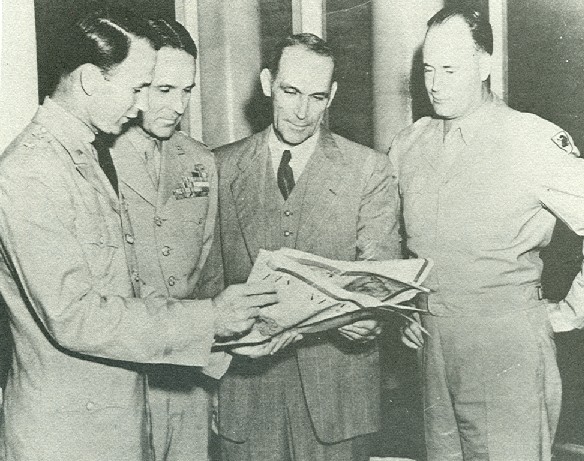
Generals Gavin, Taylor and Lee right after the end of WW2
Page XI
CHAPTER 1: Paratroops Over Sicily
SICILY IN JULY OF 1943 was the birthplace of American airborne technique. It was, as well, the crucible into which were thrown the brain storms, the cocktail cerebrations, and the intensely cherished unorthodox combat tactics of a young army. Theories originally conceived, nurtured and brought to apparent maturity without the test of battle were exposed to their first test. How well they fared, how well they fought, and what our airborne forces accomplished are questions not even partially answered to date. But the toddling tot that later became the First Allied Airborne Army was born in Sicily and survived a very rugged delivery. This Airborne Army was conceived in the planning staffs and headquarters of the North African Theater of Operations and the U. S. Seventh Army. The final Sicilian invasion plan envisioned an amphibious assault at Licata, Gela, and Scoglitti (see Map 1) by the U. S. 3rd ["Rock of the Marne"], 1st ["The Big Red One"] and 45th ["Thunderbird" National Guard] Infantry Divisions. The II Corps, commanded by General (then Major General) Omar N. Bradley, consisted of the two divisions on the right, the 1st and 45th. After landing, the airborne troops were to be attached to this corps. The plan of invasion called for one parachute combat team (CT) of the reinforced 82nd Airborne Division to drop between Caltagirone, where large enemy reserves were known to be, and the 1st Division's beaches. After the D-Day landings, the combat team was to be built up by successive air and sealifts in the zone of the Seventh Army [commanded by General George S. Patton] and participate in the conquest of the island. The 505th Parachute Combat Team (reinforced) made the initial assault with orders to seize key terrain south of Niscemi for use as an airhead and to block enemy movement toward Gela from the north. It was to destroy enemy communications and deny by fire the use of Ponto Olivio airfield. Particular attention was to be paid to the strong point at "Y" (see Map 2). This locality, heavily wired and mined, consisted of sixteen mutually-supporting reinforced concrete pillboxes and blockhouses. The strong point controlled all traffic on the Gela-Caltagirone and Gela-Vittoria
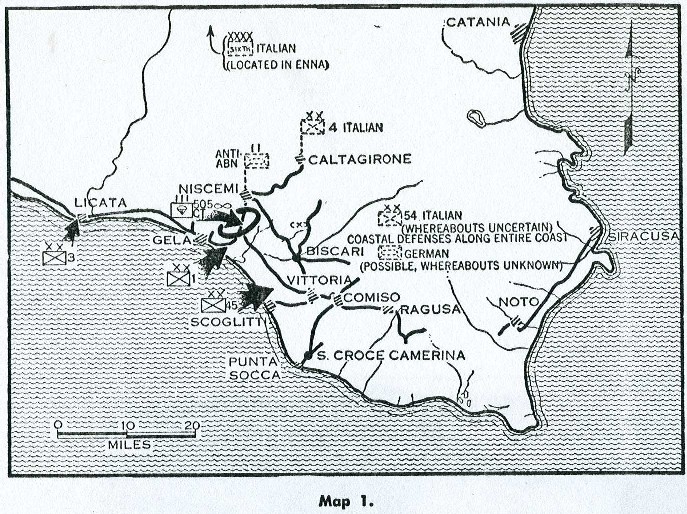
Map 1
roads. The road net at "X" also was to be seized, blocked, mined and held. After contact with the 1st Infantry Division, the CT was to assist it in its advance. The 505th Parachute Combat Team (reinforced) consisted of the following: 505th Parachute Infantry Regiment; 3rd Battalion, 504th Parachute Infantry; 456th Parachute Field Artillery Battalion; Company B, 307th Airborne Engineer Battalion; and Signal, Medical, Air Support, and Naval Support detachments. The force totaled 3,405 troopers, requiring 227 x C-47s for transport. The mission posed a number of problems never before encountered. Should the transports fly in formation as other American combat aircraft were being flown, or should they fly "bomber-stream" as the British were flying? Should the drop take place before or after the amphibious landing, or at the same time as the landing? Should the drop take place under cover of darkness, or in daylight hours? There were a number of opinions on these problems, all of them supported by strong statements and the firm belief of our critics in their own opinions.
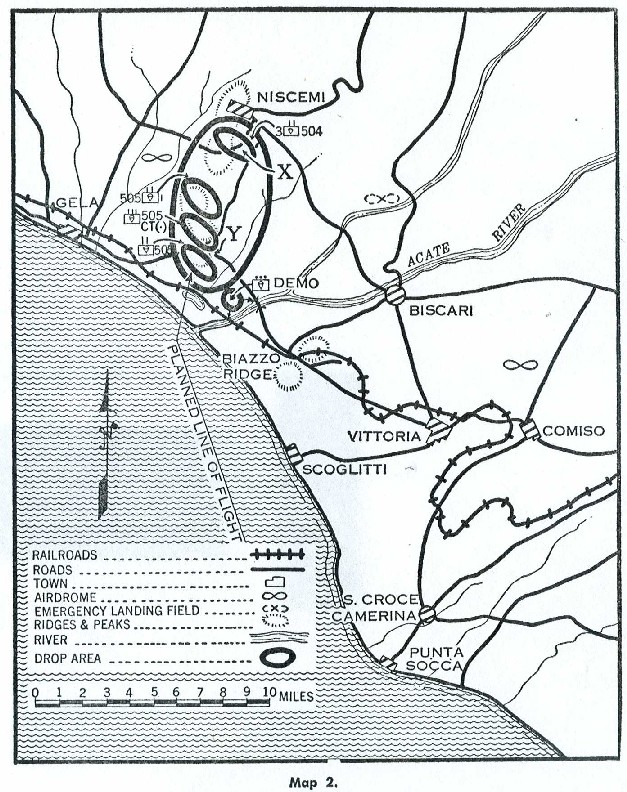
Map 2
Flying the transports in formation offered some advantages. It would permit a quick mass delivery of the troopers on their objectives. Offsetting this was the inflexibility of formation flying. This might prove costly in the event of hostile interception and' heavy flak. Formation flying would require intensive pilot training. On the other hand, an accurate delivery of troops from a formation would require fewer skilled navigators and the troops
Page 3
would be delivered en masse, over the objective, and not by single drops. Even if delivered at the wrong area, each unit would still be a complete force. It was finally decided to fly in nine-ship formations, with approximately one and one-half minutes between each flight. Serials contained up to fifty-two airplanes. The column was thirty-six minutes long. The timing of a drop is always a difficult problem to decide. Training experience had led us to believe that at least a half-moon would be necessary both for the flight and the drop. Moonlight would greatly facilitate the assembly and reorganization of the troops. On the target date selected, July 10, 1943, the moon would be almost full. The ideal solution would be to complete the dropping of all units before the moon set. This would then give us several hours of darkness to carry out defensive organization and operations against the enemy. We believed that the risk of interception by hostile fighters eliminated the possibility of a daylight drop, and by day extensive enemy ack-ack would cause heavy casualties. So, proper timing made it necessary for the parachute troops to land several hours before the amphibious troops. The decision was made to drop the leading airborne elements three hours and fifteen minutes before the beach assault.
A night parachute operation had never before been attempted by any army so organization and training for it offered many new problems. The many intangible and indefinable difficulties of fighting at night in hostile territory when every object appears to. be and often is the foe, all had to be overcome. Rapid assembly and reorganization of the troops appeared to be the greatest. Lacking combat experience, it was difficult to determine just how much security to sacrifice for speed. The actual combat proved that the assembly and reorganization were conducted too cautiously. Many visual aids could have been used to great advantage. Intensive, thorough training that built up boundless confidence in every man and in his unit was the only solution. The basic load of combat equipment for the individual parachutist was checked and rechecked. Complete plane loads were
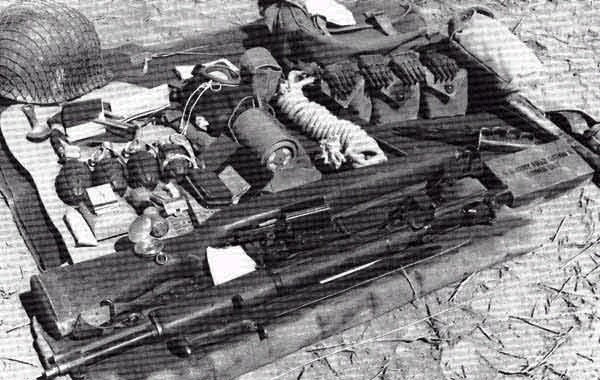
Page 5
weighed and checked in every detail. The complete loads of all units from squad to regiment were tried in all possible combinations, to arrive at the most efficient combat load. The complete lack of combat experience brought forth many original ideas. All were considered, tried, and either accepted or rejected. Replicas of the operational areas, particularly strong point "Y," complete to scale, were set up near Oudjda, French Morocco. Troops attacked with ball ammunition, and, as far as possible, realistically rehearsed their combat roles in every detail. In the final combat team drop rehearsal, token loads were dropped to check pilot accuracy. If the spirit of the troopers and their desire to fight the German was any criterion, they looked like winners. But the actual mechanics of night assembly and reorganization and initiation of combat still left much to be desired. In the final pay-off, this requires intensive training and much experience to be done well.
On June 10, the CT commander [Colonel Gavin-EDITOR], accompanied by two battalion commanders and three commanders from the 52nd Troop Carrier Group, flew to Malta, where the group made a night reconnaissance of the operational area. The reconnaissance was flown under conditions exactly as they would be one month later, the night of D minus 1 and D-Day. All check points and terrain showed up clearly in the moonlight, exactly as we had memorized them from the photographs. There was little reaction from the ground defenses. Considerable flak, however, came up from Ponto Olivio airdrome and vicinity, and several searchlights scanned the sky from around Biscari. All units were dispersed in bivouacs in the Kairouan take-off area ready to go, by July 4.
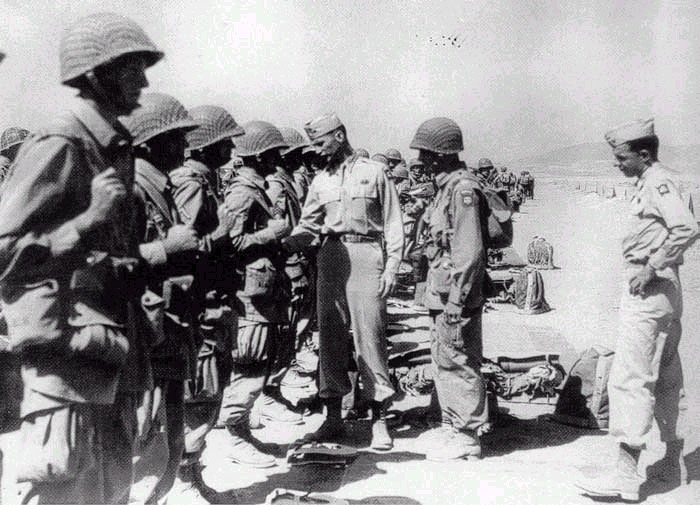
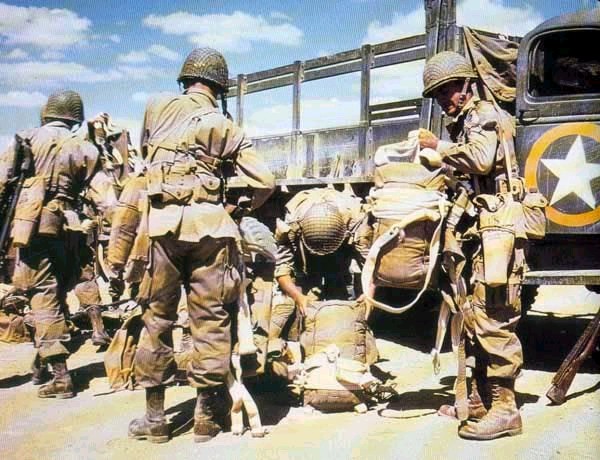
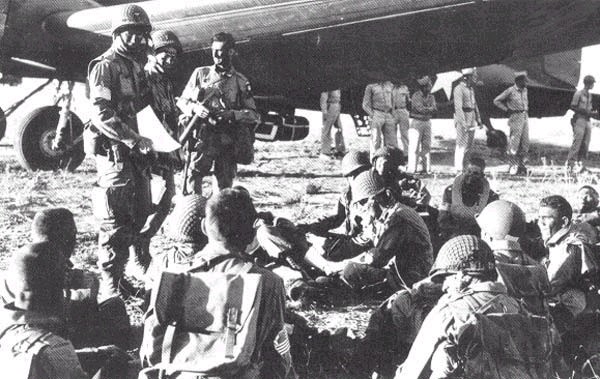
Final briefings were held and the planes took off exactly on schedule the evening of July 9. The final order included a paragraph that soon had real meaning. All pilots and troopers were told that every jumper and every piece of equipment would be dropped on Sicily. No one would be returned. If a pilot and jumpmaster could not locate the exact drop zone, the troops would jump and fight the best way they could.
Page 6
These orders were followed.
What happened after the take-off can best be told by some of the participants. This is the story told by Captain Edwin M. Sayre, who commanded Company A of the 505th, and was probably the first to land on the island:
A Company took off at 2030 hours for the first check point at Malta. I do not know whether or not we saw Malta as I had never seen it before, but when we were due to arrive there I thought I saw a light. In any event, we continued and about fifteen minutes before the scheduled jump time, we could see flashes of gunfire through the door of the plane, on the left. This surprised me, because I had expected to see Sicily appear on the right. There was considerable firing and the pilot turned to the right away from the island. We figured out later that we had hit the coast of Sicily somewhere between Noto and Siracusa. (As a matter of fact, 23 plane-loads [506 men] of this 1st Battalion of the 505th jumped near Noto where they met the British Eighth Army and joined in the ground fighting with it.)
We circled to the right, going out to sea, and came back in toward the southern coast. We followed along the shore until we saw the lake which was a check point. The squadron then turned in toward the island. About one minute after the turn, we met heavy ack-ack, apparently coming from the Ponto Olivio airdrome, The squadron turned to the right to avoid this fire and shortly thereafter the green light was given. It was about 0035. "The planes were under heavy machine-gun fire when we jumped and there was a lot of firing on the ground. By 0230, I had assembled fifteen men from the company and contacted the battalion executive officer. Company A was to attack a point from which about four machine guns were firing. We first attacked at 0300. The point from which the machine guns were firing was a garrison surrounded by pillboxes and was pretty strong. The attack was held up until about 0530, at which time fifty more men had been assembled. The attack was resumed and the garrison was killed or captured by 0615. It was held by one hundred Italians, with German noncoms from the Hermann Goering Panzer Di-
Page 6
vision. We could hear a lot of fire in the valley-up toward Niscemi and down toward the beach. At about 0630, Lieutenant Colonel Gorham, the battalion commander, arrived with about thirty troopers from headquarters. He ordered us to consolidate our position, since it commanded the road leading from Niscemi to the beaches.
At about 0700, a German armored column was seen about 4,000 yards away, coming from Niscemi. It was preceded by a point of two motorcycles and a Volkswagen. We let the point come into our position and then killed or captured the men. The armored column stopped about three thousand yards away when the point was fired on. Our position was then attacked from the front by two companies of Germans. We let them approach to within one hundred yards and then pinned them down in the open ground. Most of them were killed or captured.
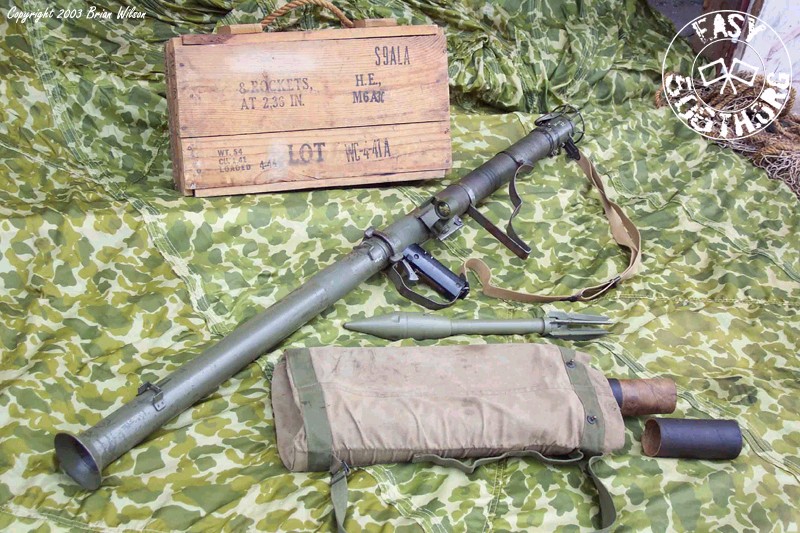
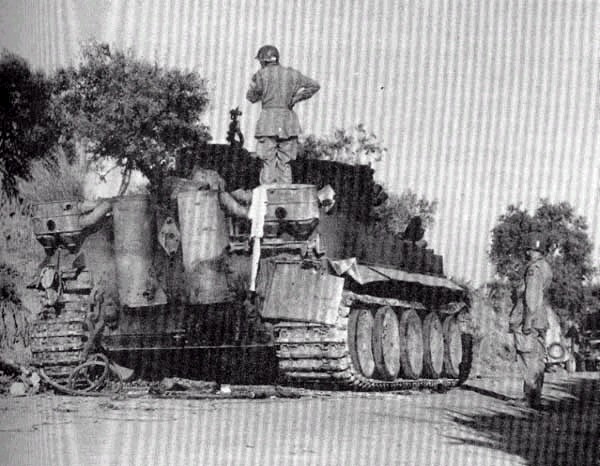
 www.youtube.com/watch?v=YjVpKS9n2n8
www.youtube.com/watch?v=YjVpKS9n2n8
At the same time, tanks hit us from the flank. Two of six attacking tanks were knocked out and two more were damaged by a bazooka squad. The tanks withdrew. During this fight, Colonel Gorham sent patrols to the high ground which was the regimental objective, and to the "Y". They reported that the crossroads at the "Y" was guarded by about thirty Italians in pillboxes surrounded by barbed wire. There was no one on the high ground.
Colonel Gorham moved our force to the high ground, using about fifty prisoners to carry the wounded.
After we had organized on the objective, a large part of our force moved out to capture strong point "Y", leaving about a squad and one officer to cover us from the north. When about four hundred yards from the strong point, heavy naval gunfire was seen falling about one hundred yards north of the pillboxes, but it could not reach the pillboxes which were in defilade. One of our Italian prisoners was told to go to the pillboxes and ask for their surrender. The occupants were told that if they did not surrender we would bring the naval gunfire right down on the pillboxes. We didn't have any communication with the Navy, but the men in the pillboxes didn't know that and surrendered. Our men moved into the pillboxes at about 1045.
Page 7
A few minutes, later four German tanks approached from the north. When troopers in the pillboxes fired on them, they withdrew. At 1130, scouts from the 2nd Battalion of the 16th Infantry, 1st Division, contacted us at strong point "Y". Colonel Gorham then attached all of our troops to the 16th Infantry and we advanced to the north. Shortly after this I [Captain Sayre] talked to Major General Ridgway by telephone and reported that the regiment had accomplished its mission, capturing strong point "Y" and seizing the high ground northwest of it.
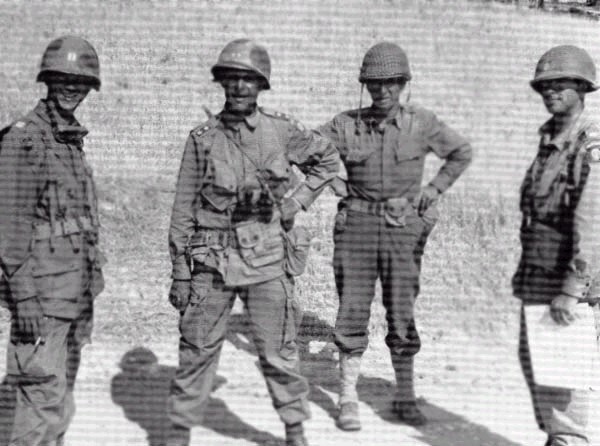
We continued the attack with the 16th Infantry, finally capturing some high ground about a mile north of the crossroads, toward Niscemi, at 1900. The battalion remained in place that night and launched another attack at dawn, July 11, its objective being a hill to its immediate front. About one hour after the hill was taken, a strong German counterattack, consisting of about a battalion of infantry and about twenty tanks, hit our position. When it looked like the tanks would overrun us, a number of the men moved back. We drove the German infantry off but the tanks managed to get through us.
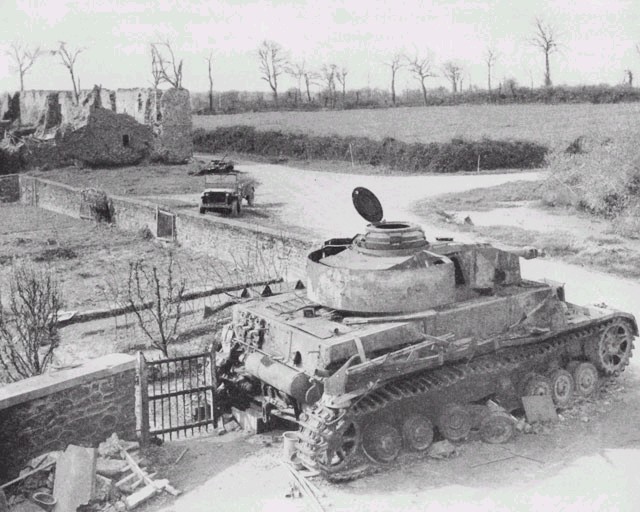
The next night we again attacked toward Niscemi and again, at about 0900, the Germans counterattacked, using several Mark VI tanks plus some [light] Mark IVs. We had good artillery support from the 1st Division and the tanks were finally stopped about one hundred yards from our position. During this action, Colonel Gorham was killed while engaging a tank. The following morning Niscemi was captured by the 1st Division and we were ordered to rejoin our combat team.
The Combat Team commander [Colonel Gavin-EDITOR] told this story:
I flew in the lead ship of the 316th Troop Carrier Group, commanded by Colonel McCauley. All preparations went according to plan. Just before I boarded the plane a messenger from base operations informed me that the latest reports showed a 35-mile-an-hour wind over the target area. [Usually training jumps are cancelled if the wind exceeds 15 mph.] But there was nothing we could do about it. Our ships rendezvoused over the take-off area and we started for Sicily. I had memorized the route and times and knew we should
Page 8
pass the island of Linosa at 2230. But 2230 came with no sign of Linosa. I thought perhaps we were slightly off course and correction would be made before reaching Malta. Malta was a big target and certainly would not be missed. The lights would be on, so I expected no difficulty in recognizing it.
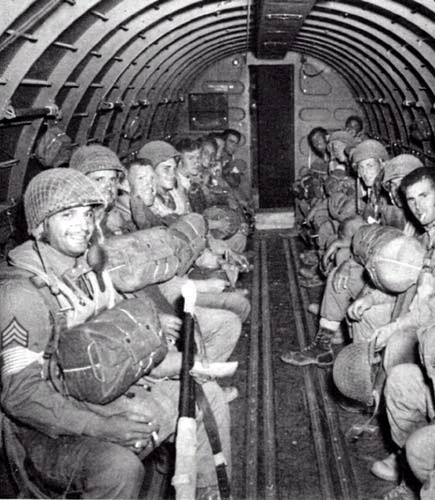
The troops were resting easily, overloaded with equipment but anxious to go. A few were sleeping. It was 2300 but there was no sign of Malta. Up to this point, we had seen no recognizable landmarks. The ocean appeared rather choppy. After flying on for some time, I became concerned about our location, and after a discussion with the navigator, it was decided that we must have missed Malta, since it was long overdue. Figuring the course that would bring us to Sicily if the 35-mile wind had blown us eastward, we made a left turn and the flight continued. Around this time we saw a number of vessels, all apparently headed for Sicily. They gave us an anxious moment, since we knew that we would probably draw fire if we flew over any ships. Our route had been changed several times to avoid-these convoys.
About midnight, the crew chief told me that land was in sight, evidently Sicily. Soon we could see occasional fires and tracers.
We turned and flew parallel to the coast for some time. All troops prepared to jump and we turned in toward the coast. I had memorized all the terrain surrounding the landfall we should have passed. We were supposed to fly over a large lake, the one I had already flown over a month before. But we saw none of the recognizable landmarks. It was almost time to jump. Finally the green light in the plane came on and we went out. There was some scattered firing on the ground when we left the planes. One C-47 crashed and blew up on the drop area.
The firing increased. Buildings and trees were moving by swiftly as we came in for the landing, a sure sign of a strong wind. Immediately after landing, reorganization and assembly were begun but many men were missing. After half an hour about 15 were assembled. We could hear a great deal of firing from all directions. We captured an Italian soldier but obtained no worthwhile information. We started to move toward where the drop
Page 9
zone should be. A few men were picked up during the night. My group finally consisted of myself, S-3, S-1, and several enlisted troopers. A number of the troopers had been injured in landing and fell by the wayside. Others were lost or engaged in small fights.
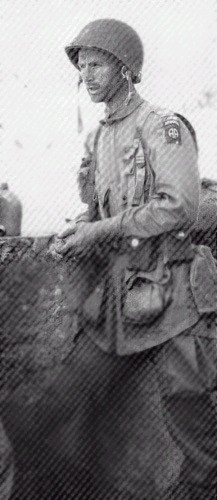
Up to this point, just before daylight, we had seen no familiar landmarks and we weren't sure whether or not we were actually in Sicily. Just before daylight, heavy naval shelling opened up to the west and south. We were happy to see it, since it proved at least that we were actually in Sicily. Based upon the location of the shelling and my knowledge of the naval support plan, we started west at once. About two hours after daylight, we engaged in a small-arms fight at close quarters. One trooper and three or four of the enemy were killed. Firing could still be heard in the surrounding country where parachutists were fighting wherever any enemy could be found.
Because of the hostile attitude of the civilians, and our inability to engage any major enemy force on favorable terms, we holed up just before noon. We moved out toward Gela before darkness and at 0230, we met Company I, 179th Infantry, 45th Division [National Guard], about five miles southeast of Vittoria. This was our first information of our exact location. We passed through Vittoria about 0500, picking up a number of troopers, and continuing toward Gela. Several miles west of Vittoria, we met the 3rd Battalion, 505th Parachute Infantry. We pushed westward. Our first contact with the enemy in force was where Biazzo Ridge crosses the Gela-Vittoria road.
About a mile short of the ridge, some Soldiers of the 45th Division stopped me and said that the Germans held the road ahead and that we should not try to go through. The situation looked about just right to take them on, since we now had about two hundred and fifty paratroopers, so we continued our march. A German motorcyclist, with an officer in a sidecar, was surprised and captured. He told us that large German forces were apparently astride the Gela-Vittoria road and moving in strength from Biscari to Vittoria. We could hear a great deal of firing. Since the
Page 10
road had to be opened to the 1st Division, where we hoped the rest of the 505th Combat Team was engaged, we continued our advance. German forces occupied the ridge and placed heavy small-arms fire on our leading elements. The Germans soon were driven off the ridge, which then was occupied by a platoon of Company B of the 307th Airborne Engineer Battalion.
Our entire force, reinforced by one platoon of Company L, 180th Infantry, 45th Division, several Sailors, and other miscellaneous groups which happened to be around, attacked toward the Acate River, in the face of intense fire. The Germans reacted violently. They counterattacked at noon, with about six Mark VI [Tiger heavy] tanks. These overran the assault elements of the parachute force and penetrated as far as the combat team CP, just over the top of the ridge. A staff officer dispatched [S-1 Major Al Ireland by bicycle] to General Bradley's II Corps Headquarters obtained a liaison party from a 155mm battalion (189th Field Artillery), also a company of Sherman [medium] tanks and a Navy artillery support party. At 1600, the Navy and the 155s fired on the Germans and quieted them down.
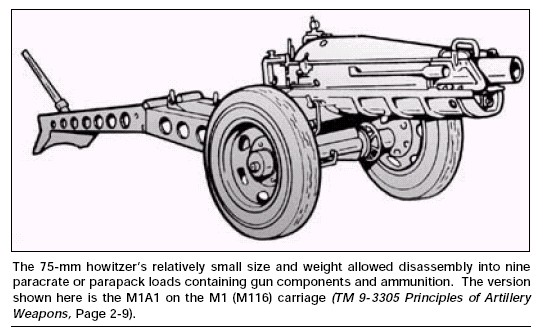
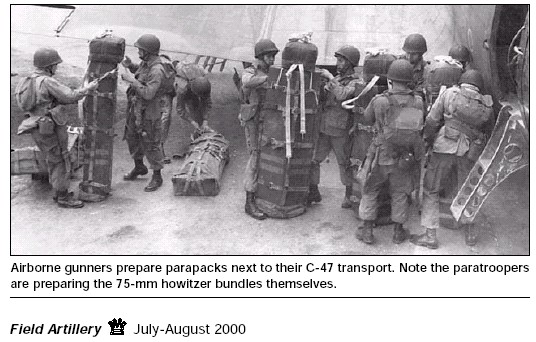
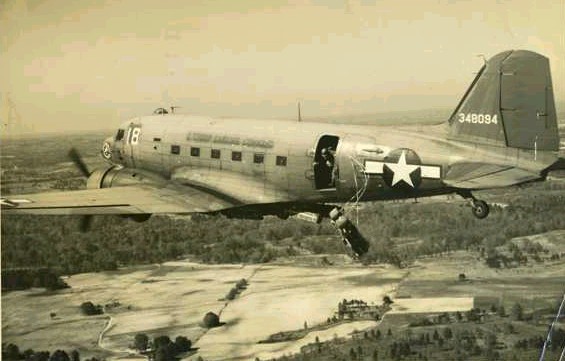
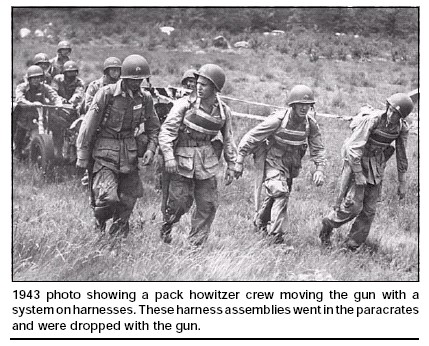
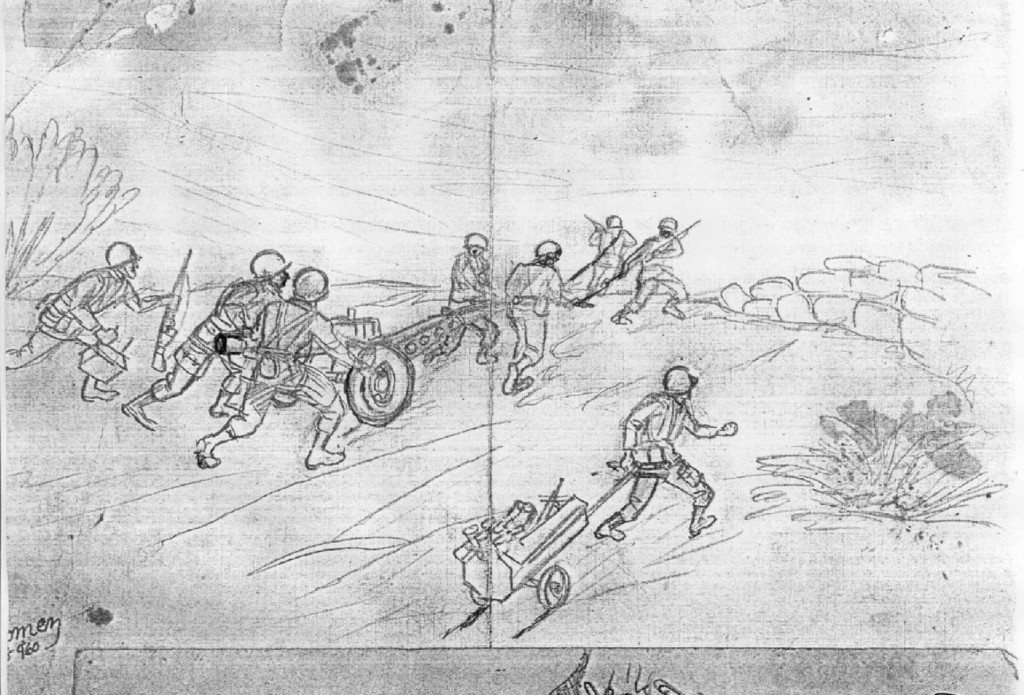
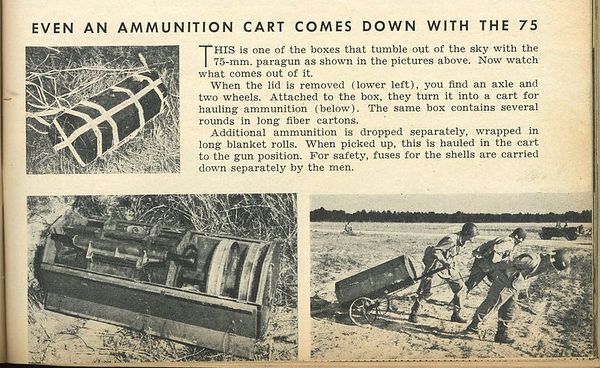
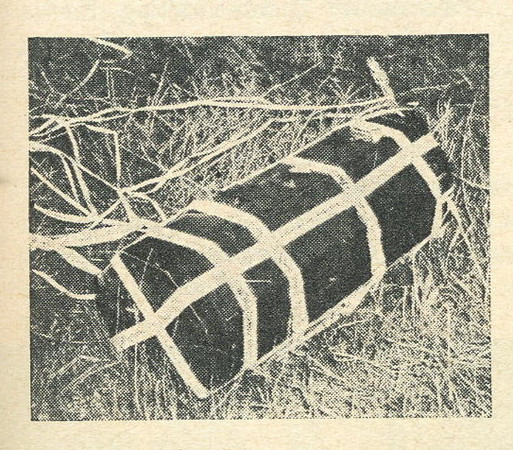
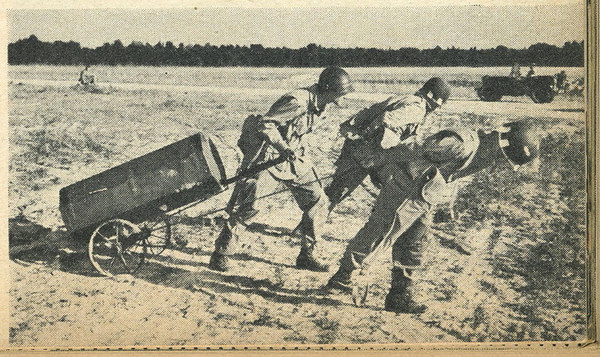
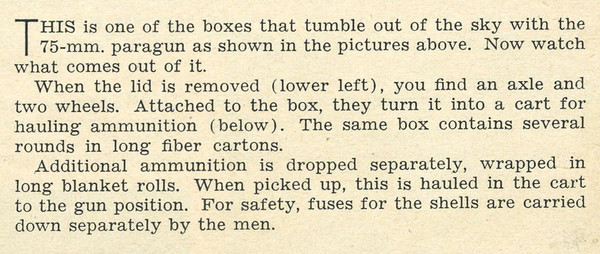
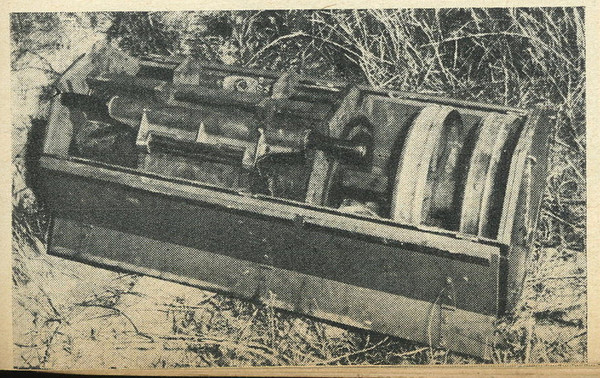
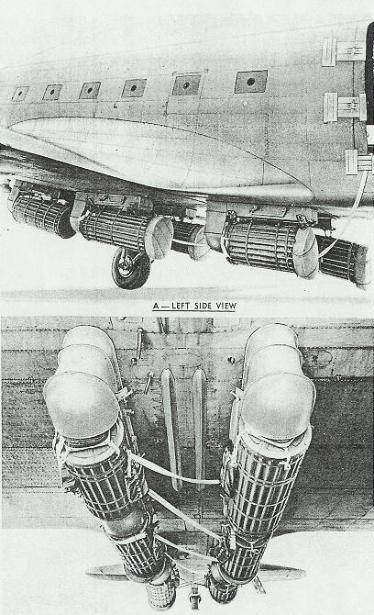
DOWNLOAD U.S. Army Field Artillery Journal ARTICLE "Cannons under canopy":
www.combatreform.org/fajournalcannonsundercanopyJULAUG2000.pdf
Gavin and his comrades got the idea of equipment containers made into carts from studying the German Airborne victory on Crete in 1941 though not being too dependant on them, by having each Paratrooper jumping in his own equipment using lowering line loads.
Up to this time we had had no artillery support except two 75mm pack howitzers, which were being effectively, used as antitank (AT) guns.
German prisoners all said that their force consisted of a battle group from the Hermann Goering Panzer Division that was moving from Biscari toward Vittoria together with another group moving from Niscemi to Gela. Some of the first prisoners taken said they had been in Sicily for several years in Luftwaffe ground crews and had just been transferred to the Hermann Goering Division. All German troops fought exceptionally well. All this day, July 11, our parachute force was being augmented by troops coming from the southeast. Approximately one hundred men, mostly engineers of the 307th Airborne Engineer Battalion, had joined by dark.
As a final effort on this day, we planned an attack to jump off at 2030, in which we would use every available man, clerks, runners and what not, this attack supported by the company of Sherman [medium] tanks which had just arrived. The attack jumped off on schedule and completely overran the German positions, cap-
Page 11
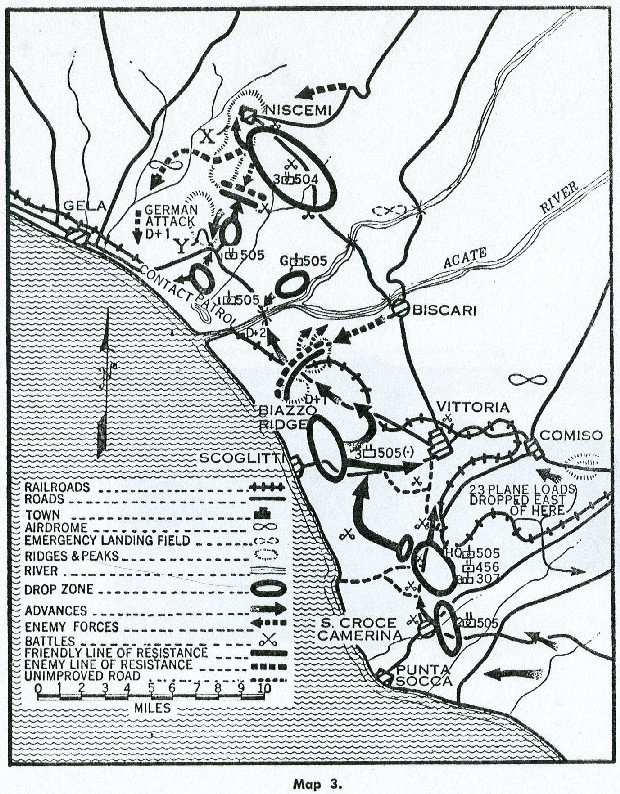
Map 3.
turing one Mark VI tank complete and destroying three others which were abandoned by the Germans during the night on the road to Biscari. We also captured twelve six-inch Russian mortars and a number of trucks, motorcycles, and a large quantity of small arms and ammunition. By 2200, we had consolidated our gains and at daylight we continued to the Acate River, where we were held up by orders from Corps Headquarters. The next day a pa-
Page 12
trol got through to Gela and contacted the remaining elements of the 505th Combat Team, which had fought with the 1st Division. By this time, our force on Biazzo Ridge was about two thousand strong. We reported to the commander of the 82nd Airborne Division, Major General Matthew B. Ridgway, at his CP [command post] three miles east of Gela, and the combat team came under division control.
Because of the 35-mile wind, the 505th Combat Team had flown considerably to the east of its originally planned course. Thus Malta was missed, and most of the troop carrier units arrived at the east coast of Sicily, with landfall first appearing on the left, instead of approaching the southern coast, with landfall first appearing on the right, as anticipated. When the planes did arrive over the island, the dust and haze stirred up by the pre-invasion bombing had obscured most of the check points and drop zones.
In addition, many pilots were under heavy fire for the first time.
In spite of these handicaps, they made a courageous effort to deliver their troops to the proper drop zones, some of them circling out to sea and making several run-ins. The collective limitations of bad weather, ground haze, inexperience and lack of better navigation means made the task almost impossible. The troops were delivered as shown by Map 3.
The 3rd Battalion of the 504th Parachute Infantry, the unit farthest north, was scattered widely over an area generally southeast of Niscemi. In the subsequent fighting, the paratroopers destroyed all enemy communications that they could get their hands on, attacked enemy troops and vehicles along roads, and denied the enemy the use of the road from Niscemi to Biscari. One group of between 95 and 100 troopers, under Lieutenant George J. Watts and Lieutenant Willis J. Ferrell, organized a strong point around a large chateau at the southern side of Niscemi. The Germans made repeated attempts to dislodge them, and failing to do so, tried to ignore them and by-pass the chateau, which overlooked the main Niscemi-Gela road. The paratroopers made several sorties on German troops moving south toward Gela. Finally, the German movement changed and started back northward. A
Page 13
German battalion stopped along the road for a break and was ambushed, suffering heavy losses. These troopers held their position continuously, inflicting heavy losses on the enemy until relieved by other elements of the 505th CT and the 16th Infantry, 1st Division, on D plus 3. Lieutenant Watts and Lieutenant Ferrell, both gallant young paratroopers, were later killed near Venafro, Italy. Farther south, Lieutenant Colonel Arthur Gorham, with elements of the 1st Battalion of the 505th, succeeded in blocking all German movement southward toward the "Y" and finally captured and occupied the "Y" itself. When the 1st Division resumed the attack northward, this battalion worked with it. The bulk of the 1st Battalion was dropped near Noto, on the east coast of the island, where it captured the town and fought with the British Eighth Army for several days.
The 3rd Battalion of the 505th landed Company I exactly on its drop zone. This company had the mission of establishing patrol and radio contact with the assault elements of the 16th Infantry. It was also to light a large bonfire at one end of the lake as a signal for the amphibious troops. The house and haystack were set afire by Lieutenant Clark, 2nd Platoon, Company I, as the signal. The leader of the 3rd Platoon, Lieutenant Vandevegt, reached the railroad at 0230. He placed demolitions as planned and shortly after daylight contacted the advance elements of the 16th Infantry.
The Italian resistance was intense, but spotty and short. Company G of the 3rd Battalion dropped several miles east of its drop zone, near the highway crossing over the Acate River. It attacked and destroyed the Italian force guarding the crossing. It set up an all-around defense in this vicinity, patrolled vigorously and, all in all, turned in a fine performance. It was commanded by Captain James McGinity, later killed leading his battalion in Normandy.
The remainder of the 3rd Battalion was dropped southeast of the Acate River. It was picked up by the combat team commander [Gavin] on D plus 1 and participated in the fight on Biazzo Ridge.
The 2nd Battalion of the 505th was dropped as a unit east of S. Croce Camerina. Many of these troops landed on or near pill-
Page 14
boxes and in well-organized defensive areas. Despite its initial difficulties, the battalion was completely assembled by daylight, and under the leadership of Major Mark Alexander, attacked and captured S. Croce Camerina. It then cleaned up road blocks and pillboxes toward the beaches and toward Vittoria and Comiso. Many of these pillboxes were formidable affairs, some being three stories high with basements. By dark, on D-Day they had the area in front of the 45th Division completely under control. One group of paratroopers fought into Ragusa where they later joined Canadian troops of the Eighth Army. Another group fought into Vittoria.
The 456th Parachute Field Artillery Battalion, although initially widely scattered, reorganized promptly and engaged the enemy wherever he could be found. Several sections of the battalion participated in the fight at Biazzo Ridge. The remainder fought with the 2nd Battalion of the 505th and joined the fight at Biazzo Ridge late on the day of D plus--1.
In the final analysis and evaluation of the merits and accomplishments of the D minus 1 and D-Day airborne assaults, it is interesting to note that although only about one-eighth of the force originally planned to land in front of the 1st Division actually landed there, most of the missions assigned to the combat team were accomplished. Only at Niscemi, was the block thrown in front of the German reserves not fully effective. In front of the 45th Division, a thorough and efficient job of neutralizing the enemy's defenses was accomplished. This was not according to plan. It had been considered in the preliminary planning but was thought to be too much for one combat team.
On the night of D plus 1, the 504th Parachute Infantry (minus the 3rd Battalion), took off from North Africa to jump on the Farello airstrip, midway between Gela and the "Y", to reinforce the 505th. This regiment was engaged in flight by gunfire from, our own surface ships and friendly ground troops. Heavy casualties were inflicted and 23 transports [506 men] lost. The regiment, however, was assembled on the twelfth and soon joined the 505th CT. Together they fought with the 82nd Airborne Division, participating
Page 15
in several weeks of hard fighting culminating in the capture of the city of Trapani and of Cape Vito, the northwestern extremity of the island.
It is of tactical interest to note that the German forces near Catania were also reinforced by the German 1st Parachute Division. Later in September, similar tactics were used when the 82nd jumped into the Salerno beachhead on the nights of D plus 4 and 5, to reinforce the hard-pressed assault units of the Fifth Army.
It is probably because of the wide dispersion of the units in the Sicilian drop (some with the British, some with the Canadians, and others with the U. S. 1st and 45th Divisions) that the general public looks upon the Sicilian operation as a badly dispersed and ineffective effort. About D plus 5, I heard someone say that it was "probably the best executed Snafu in the history of military operations". I believe it could better be termed a "Safu." A "Safu" is a "Self-Adjusting Foul Up." But in the last analysis, the real worth of the airborne phase of the Battle of Sicily can best be gauged by an enemy evaluation of it. Speaking of it to an interrogator in a British prisoner-of-war camp in October 1945, General Karl Student said:
The Allied airborne operation in Sicily was decisive despite widely scattered drops, which must be expected in a night landing. It is my opinion that if it had not been for the Allied airborne forces blocking the Hermann Goering Armored Division from reaching the beachhead, that division would have driven the initial seaborne forces back into the sea. I attribute the entire success of the Allied Sicilian operation to the delaying of German reserves until sufficient forces had been landed by sea to resist the counterattacks by our defending forces (the strength of which had been held in mobile reserve).
General Student should have known an effective airborne operation when he saw one. He was the foremost authority in the German Army on airborne operations and he commanded the German airborne operation on Crete. In addition, he was Chief of Staff of all German paratroops from 1943 until his capture by Allied forces after the German collapse.
Page 17
Little things going wrong can cause a great deal of confusion in combat, and a certain amount must be accepted as normal, but if "little things" go wrong in an airborne operation, you really have confusion.
The pay-off then is in the individual troopers and the small-unit commanders. If they have learned their missions and those of other units working with them and if they have the initiative and moral and physical courage to do something about it, everything will turn out all right.
The Sicilian operation is a splendid example of this. In the last analysis, the accomplishment of the missions is a tribute to the courage and skill of the pilots and crews of the 52nd Troop Carrier Wing, who flew them in, and the fighting heart, individual skill, courage and initiative of the American Paratrooper. Here, in Sicily, he proved the hard way that vertical envelopment at night was feasible and almost impossible to stop, that the American trooper has the mental and physical courage to try anything, asking and expecting no odds. For as the dispersal was widespread, so also were the surprise and confusion of the enemy. Everywhere the Germans and Italians saw small groups of troopers coming out of the night. The panic of not knowing how many were coming or from where had its demoralizing psychological effect. In addition, their accomplishments in ground fighting were an immeasurable contribution to the successful Sicilian campaign.
Perhaps the German high command should have heeded the opinions of General Student. Surely he knew, and it may well have known, that Salerno, Normandy, Holland and Wesel were all practicable within the foreseeable future.
CHAPTER 2: Plans and Operations in the Mediterranean
SICILY WAS A SOBERING EXPERIMENT for all of the troopers and staffs of the U.S. 82nd Airborne Division. But from it men and officers acquired new and more practical ideas about what they should carry into parachute combat. It was decided after the heavy loss of equipment containers in the Sicily operations that more weapons would have to be jumped on the person so that they would be immediately available. In particular the troopers would jump with more grenades and less food.
Another important change was the substitution of simple passwords for mechanical aids in night challenging.
From here on out the troopers of the 82nd Airborne knew what it meant to leap from the door of a plane into the inky black night. They knew full well that whether they lived or died depended entirely upon their mental and physical resources and what they carried out the door with them. Only God came along with you was the feeling after Sicily.
There had, of course, been far too much dispersal over Sicily.
In the next the staffs of all echelons were determined to obtain better massing and more accurate delivery. At this time, too, pathfinding was initiated and teams were trained to go ahead of the troop transports, jump, and set up radar and visual signals accurately in the drop zones to guide the transports in. New and more practical means of effecting a rapid assembly were improvised. Arrangements were also made to have the assault paratroop waves accompanied by more effective antitank means (glider-borne 57mm guns if possible). And many other innovations were designed to add to the striking and holding power of the next paratroop force to go in, wherever it would be.
Right after the Battle of Sicily the 82nd Division returned to North Africa, arriving there on August 20, 1943. There it received reinforcements and equipped and prepared itself for the coming invasion of Italy. For the Division Commander, Major General Matt Ridgway, and for the staffs of the division, this was an extremely busy period. Plans were made, and then there were
Page 18
changes, and more plans and changes. Yet all of that was typical of what usually happens in the planning stages of an airborne operation.
The student of future airborne operations has to realize how normal these shifts and changes are for any airborne operation that has to be planned and staged in a short period of time. And he must realize clearly how many planning details must be attended to, and checked and rechecked. There must be full coordination with the amphibious troops and with the naval and air forces. Coordination for bombing and fighter support is especially vital and air supply may be equally so. And very often there must also be a careful coordination with the activities of the State Department. All these agencies can be expected-in fact, you can depend on it-to make numerous changes in their own plans, but from the whole must emerge a cohesive, workable, well thought-out, operational airborne scheme.
The final plan for the amphibious invasion of Italy contained the following major elements (see Map 4):
(1) the main assault by the U.S. Fifth Army with the mission of capturing Naples;
(2) two attacks by the British Eighth Army, one against Calabria and another against Taranto;
(3) a naval diversionary attack in the Gulf of Gaeta. This was to be known as operation AVALANCHE;
named, one can suppose, for the avalanche of combat troops soon to swarm onto the war-weary Italian Peninsula. But to some of the wags on the staffs of the 82nd Airborne Division the name was more indicative of the avalanche of airborne plans and papers that engulfed them in the days that soon followed.
To carry out its mission, the Fifth Army planned to invade Italy at the Gulf of Salerno, fight northwestward, capture Naples, and continue the fight northward until all of Italy was overrun. The 82nd Airborne Division was made available to the commander of the Fifth Army, General Mark Clark, for this operation. How best to make use of the division now became a problem of much concern and speculation. The first mission presented to the 82nd called for the seizure by an airborne task force of the towns of Nocera and Sarno at the
Map 4.
exits to the passes leading northwest from Salerno. The purpose was to cover the debouchment of the Fifth Army from the Salerno area. All available transport planes and gliders, 318 of each, were to be used on the operation. The division commander gave missions to the regimental commanders at the division command post at Trapani, Sicily, about August 1.
The staffs made hurried studies to select drop zones for the parachutists and landing zones for the gliders. Our airborne assault was to be supported by an amphibious assault by troops from the infantry division landing in the Amalii-Maiori area on the Sorrento Peninsula. After considerable study in conjunction with the Air Forces, of the terrain, ack-ack, and possible flight routes, it was decided that the paratroopers of the 82nd would have to be dropped along Sorrento Ridge at altitudes from 4, 500 to 6, 000 feet, in moonlight. The airborne operation was also planned at extreme fighter range, and this, coupled with the ground conditions, the ack-ack, and the possibilities of hostile fighter interception, as well as the real vulnerability of the C-47s to any kind
Page 20
of an attack, ruled out anything but a night airborne show. Fighter range and support are critical factors in any airborne plan.
It was decided, however, on August 12 to throw this whole plan out and use the 82nd Airborne farther inland. On thinking back now to the situation at the time, it seems to me that this first plan contemplated the use of our airborne units merely to gain a temporary tactical advantage. Their use in the manner planned would hardly have had a decisive bearing on the outcome of the operation as a whole. It was a good thing that the decision was made to drop the plan.
On August 18, General Ridgway was told that a new decision had been reached to conduct an airborne operation on the Voltumo River, northwest of Naples and some forty miles from the nearest beach landings in Salerno. Initially, this new plan gave the 82nd Airborne Division the mission of destroying all crossings of the Volturno from Triflisco to the sea and of holding the Volturno itself against all enemy attempts to cross. The airborne force was to be given immediate support by an amphibious assault against beaches just to the south of the mouth of the Volturno, and contact between the 82nd and the nearest unit landing at Salerno, the British 46th Division, was to be expected, at the latest, in five days. I was designated as the airborne task force commander.
Staff planning for the new operation, known as GIANT I, was undertaken without delay at all staff levels concerned. But shortly the Navy announced that the beaches selected for the amphibious assault were unsuitable so this phase was dropped from the plan. Without this landing of a force from the sea to back up our airborne task force, the problem of resupply for the airborne forces now became a most critical factor. Our assault force was to be a task force of two regiments of parachute infantry, a battalion of parachute field artillery, two companies of parachute engineers, and two batteries of 57mm antitank guns, and medics, signal, and reconnaissance units to balance the force. To keep this force able to operate continuously, we would need a daily tonnage of supplies of all classes amounting to 175 tons. This minimum of food and ammunition had to be delivered to us in one way or
Page 22
another, for an airborne force is, like any other, dependent on supplies, and usually more so because it operates completely within the enemy's area. When the situation gets tight such a force can only keep on fighting. It cannot fall back toward a supply base.
Obviously, this would require considerable airlift. And it would equally require an almost incredible amount of good luck and good planning to deliver the needed supplies to each unit of the task force at the times and places required in the face of hostile interference and the many circumstances of combat that can cause the best of plans to go awry.
At the very least, the airborne task force would need regular supplies for a period of five days-until contact was made between our force and units of the British 46th Division which would have landed at Salerno. There was some chance, as well, that the progress of these other forces would be slower than expected, and in that event we would need steady resupply for many days. Intact, had the operation been carried out as planned, it is probable that we would have been on our own for a whole month.
Any serious failure in the resupply of the 82nd Airborne Division task force could only mean its loss. This is true of any airborne force that drops into territory strongly held by an alert and able enemy. No surrounded force can hold out long without food, and when the ammunition is gone the situation naturally becomes hopeless. The planning for the airborne operation was carried through in the smallest detail. General Ridgway emphatically presented the resupply problem to the Fifth Army staff. Approximately three groups of troop carrier transports, about 145 ships in all, would be needed to bring in our daily re-supply by parachute. Because of the great likelihood of interception by hostile fighters, the supplies would have to be delivered at night, on a time schedule that was changed daily. Each day a fast observation ship would fly over our operational area on a prearranged schedule to confirm the daily delivery plan by panel and smoke signals.
One novel twist was given to the planning when it was realized that there were several thousand Allied prisoners of war in the area between Capua and Caserta. Resupply for these prisoners ap-
Page 23
peared to be a necessity, and just what we should do with them in the event of their liberation was a difficult problem. It was also of highest interest to the troopers of the 82nd that the rear echelons of the German 1st Parachute Division and the Hermann Goering Panzer Division were bivouacked near our proposed area of operations. Word was going the rounds that if the Hermann Goering outfit had anything left after Sicily they were about to lose it now. And every man was curious about the 1st Parachute Division and extra willing to tie into them.
As task force commander, I visited the command post of Major General Hawksworth, commanding the British 46th Division, at Bizerte in late August. I arranged for delivery of American-type ammunition and evacuation of our wounded, and for an exchange of information on day and night visual recognition signals, radio frequencies and vehicular markings. General Hawksworth estimated then that he would contact the airborne troops in four to five days at the most. Concurrently with all of this the 82nd Airborne Division was directed to be prepared to drop a separate parachute battalion on either Battipaglia, Avellino, Nocera, or Sarno, for the purpose of blocking movement through those localities. The 2nd Battalion, 509th Parachute Infantry, was attached to the division. This was the battalion that had jumped in North Africa after a 1500-mile flight from England in November 1942.
A final briefing for all higher commanders was held at the Fifth Army forward command post on August 26. Each commander in turn outlined his plan to carry out the mission assigned him by the Commanding General of the Fifth Army.
The destruction of all crossings over the Volturno from above Capua to the sea and the denial of all Volturno crossing sites to the Germans was a satisfying, if not most pleasant, mission to study and prepare for. But the job proved much more difficult of realization on analysis than the higher staffs had first thought. It was the daily air resupply of 175 tons which proved to be the obstacle that couldn't quite be overcome. At least it couldn't be overcome unless the North African Air Force was willing to take an
Page 24
almost certain daily loss of transports or bombers, whichever would be used. There was an extensive bombing program already under way. The big ships of the North African Air Force were working over the boot of Italy from top to toe. The Air Force had already carried out its costly, long-distance raid from bases in Libya on the Ploesti oil fields in Rumania. As for the ships of the Troop Carrier Command, they would be operating beyond fighter support, which certainly made it look like a heavy loss of transport planes to keep our task force going.
Still in the minds of all of the pilots was the recent interception of a German air transport column on the way to North Africa with badly needed supplies for the beleaguered troops of Von Arnin. Seventy-five transports were shot down in not many more seconds.
Rommel's Afrika Corps was starved into submission by German supply ships being sunk by combined Allied naval and air actions. They tried air resupply with slow JU-52s and Me-323 transports.
Corey Jordan writes in his online book,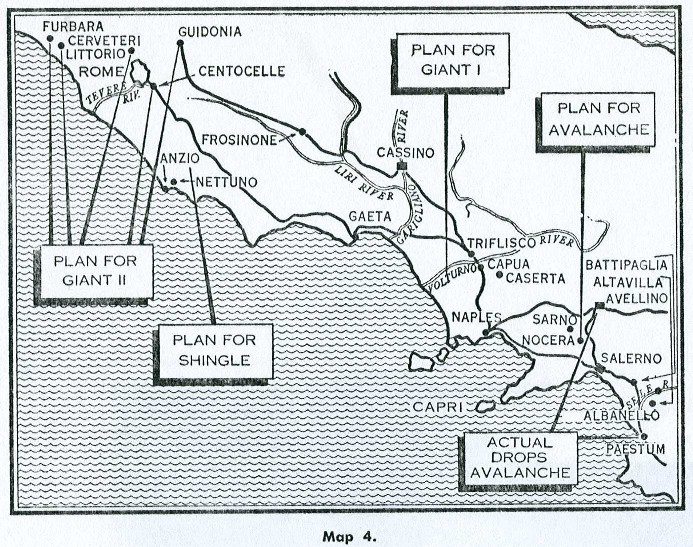
SIDEBAR: Transports without Air Superiority
http://home.att.net/~C.C.Jordan/P-38MTO.html
By late winter, the Luftwaffe was flying as many as 100 transport sorties across the Straits of Sicily to re-supply the exhausted Afrika Korps, who had been squeezed into Tunisia by U.S. forces from the west and the British 8th Army from the east and south. Generally flying at altitudes below 100 feet, these transports were usually escorted by Bf-109 and Fw-190 fighters. Allied fighters were deployed to intercept these transports, the North African Air Force P-38's being cut loose to hunt down the Luftwaffe.
On April 5th, twenty-six P-38's intercepted a huge formation of German transports and their escort. 16 of the German aircraft went down, including two of the escorts. A pair of P-38's were lost, with one pilot missing in action. Elsewhere, P-38's accounted for another 15 German fighters. Combined efforts of NAAF fighters and bombers destroyed up to 200 x Luftwaffe aircraft on April 5th,with many destroyed on their airfields. Just 5 days later, on April 10th, the P-38's destroyed another twenty German transports and 8 escorting German and Italian fighters. Later that afternoon, B-25 Mitchell medium bombers and their escort splashed 21 more transports and four of the escorting fighters. Despite these serious losses, the Luftwaffe continued to fly these aerial "convoys". On April 11th, the Lightnings located and destroyed another twenty six Ju-52 transports and 5 x Bf-109 fighters did not return to their airfields that evening. The Luftwaffe was being bled white. Finally, the German re-supply effort came to a halt when an entire convoy of the massive Me-323 Gigant six-engine transports was shot down by a combined force of Spitfires and South African P-40 Kittyhawks.
The Allies had achieved air superiority by April 22nd. There remained some Luftwaffe aircraft in Tunisia, however, they were soon destroyed or evacuated to Sicily. On May 13th, 1943, the last of the Deutsches Afrika Korps surrendered to the Allies, having fired off all their remaining ammunition and destroying any usable equipment. About 240,000 Germans and Italians went into captivity. The focus of all now turned to Sicily. The Germans understood that this would be the next target of an Allied invasion. The question was, what could the Luftwaffe do to defend the island?
Air Marshal Tedder and General Clark decided in the end that the possible gain from our Volturno mission would not be worth the probable losses. The mission was called off, and thus ended GIANT 1.
Thirteen days remained until D-Day. General Ridgway and the staff of the 82nd Airborne Division returned to the headquarters of the division at Kairouan in North Africa, where preparations were continuing for any type of airborne mission that might fall to the division's lot.
On the evening of September 2, the division commander and several staff officers were called to the Headquarters 15th Army Group at Siracusa, Sicily, to receive the first information of a new mission. The new job was to be the seizure of Rome, one of the most interesting airborne plans of the war, and a plan that will be discussed pro and con for many years to come. This operation was known as GIANT II and called for placing the strongest airborne task force the available aircraft could carry on and near three airfields immediately east and northeast of Rome. Because of the range there was no possibility of fighter support. The date for, GIANT II was the night of September 8-9. The mission was to secure Rome by operating in conjunction with Italian forces in the Rome area. The airborne lift was to be repeated, the next night
Page 25
and as directed thereafter, until the mission of the 15th Army Group was accomplished. The airborne part of the operation was to be supported by a landing at the mouth of the Tiber River also staged by troops of the 82nd Airborne Division.
This mission posed some new and extremely interesting airborne problems. Again the operation was beyond friendly fighter range, and since enemy fighters were very active, the operation was limited to hours of darkness. The simplest method of delivering the troops was to air-land them on the airfields with the cooperation of the Italians. But since our transports were not to enter the enemy fighter range until after dark and they had to clear by daylight, rigid limitations had to be placed on the time that could be spent on the Rome airfields. Parachute troops of course require no landing time whatever; a completely equipped fighting force is dropped while the ships remain in flight. Airlanding C-47 transports on a one-strip airfield with a control officer on the field from the landing troop carrier unit can rarely be done at a faster rate than thirty-six transports an hour. That rate has been exceeded, but not under combat conditions. This means that at best a battalion of infantry [792 men] an hour per available airfield is all that could be landed. And for practical planning purposes, this is a pretty optimistic expectation.
Under the conditions existing in the Rome area and the time limitations these conditions imposed upon us, the forces that could be air-landed in a single night would be relatively small.
The airfields were small ones without runways. Effective cooperation of the Italian ground forces was especially doubtful.
We might well find units of the German Wehrmacht at or near the fields. There was no assurance of an efficient handling of aircraft damaged in landing and it was not clear how traffic in and over the fields was to be controlled.
The Rome area was beyond glider range from the take-off airfields in Sicily. It had to be accepted that the success of the mission was wholly contingent on such full cooperation from the Italian military forces as would insure the neutralization of German antiaircraft defenses along the planned flight route, the security of the
Page 26
landing fields or drop zones to be used, and the furnishing of essential supplies, and in addition full military cooperation of all Italian forces against German troops. This made quite a bill of goods.
Nevertheless the planning moved at a rapid pace and the afternoon of September 8 found the troops of the 82nd busily checking orders and plans, loading the para-containers, and making a last check on rations, ammo, and weapons.
The greatest difficulty was the lack of assurance from the Italian government that the airfields around Rome would be freed of Wehrmacht and German ack-ack troops. The flak we would run into on the way from Sicily to Rome was sure to be heavy, and losses from it likewise unless it were taken out beforehand. Of equal concern to the 82nd Airborne Division was the reception to be expected on the airfields. It was necessary not only to clear these fields of the enemy, but to have guides and interpreters, ammunition and food supplies, and vehicles ready for our use at the fields when we landed. There must also be further advance organization by the Italian Army for the control of traffic around the airfields, clear the airfields of our damaged and cracked-up planes, and for security against attack on the fields by German or hostile Italian forces.
The agreement reached between Allied authorities and the Italians at Siracusa provided for all of this. There were, in fact, several pages of itemized needs including such things as telephones, picks, shovels, wire, gasoline, and civilian laborers, all of which were to be furnished by the Italian commander to the airborne troops. The Italians had also agreed to clear the Tiber River so that there could be amphibious support for the airborne landl11gs.
But I think the fact is that the Italians at Siracusa had simply promised everything-about ten times as much as they could possibly have done. And it became fully evident that there were no guarantees of the needed support at the airfields where the regiments of the 82nd were to land, so the plans were changed almost at the last minute.
Page 27
The leading assault regiment, the 504th Parachute Infantry, was to land on the Furbara and Cerveteri airfields near the seacoast. From there they were to push inland towards Rome. The regiment jumped on the second night, the 505th Parachute Infantry, would land on Guidonia, Littorio, and Centocelle airfields, all of which are considerably nearer the center of the city of Rome.
Since the Sicily operation, we had paid a great deal of attention to pathfinders as means of having parachute transports home on the proper drop zones. For the Rome attack, pathfinder ships and men would precede the main landings of the 82nd and bring them accurately in. The pathfinder ships and personnel were based on the field at Agrigento, Sicily. On the evening of September 8, these ships were fully loaded, warmed up, and ready to take off. But minutes before the take-off, word came from higher authority that the mission had been postponed for twenty-four hours.
Brigadier General Maxwell D. Taylor, chief of artillery of the 82nd Airborne Division, had been sent through to Rome twenty four hours earlier to confer with the leading Italian authorities.
He was to inform the Allied commander by code whether or not in his opinion the operation should be attempted. General Taylor and a small staff were taken to the island of Ustica by a British PT boat where they were transferred to an Italian corvette which landed them at Gaeta, the scene of much bitter fighting later in the war. They were quickly taken from Gaeta to Rome where they conferred with General Carboni, commanding the Italian troops in the Rome area, and the aging Marshal Badoglio. The Marshal and General Carboni both agreed that in recent days the German forces in Italy had been greatly increased in strength. They said further that the Italian troops had little or no gasoline and only enough ammunition for a few hours of fighting, that they could not guarantee that airfields would be in Italian hands, and that, anyway, our airborne landings would cause the Germans to take drastic steps against the Italians and that therefore the whole plan as proposed would be nothing less than disastrous.
General Taylor decided they were right and radioed the pre-
Page 28
arranged code message, and the operation was called off. D-Day came and H-hour struck, and despite the many plans and the days and nights of staff work, the airborne troops found themselves sitting and waiting on their take-off airdromes. Patience is an essential attribute of a good airborne trooper.
The next morning, after we received word that we would not join in the attack, the Fifth Army hit the Salerno beaches and began one of the most bitterly contested amphibious operations of the war. Driving inland despite fierce well-prepared German opposition, the VI Corps was able to seize the dominating ridgeline extending from Altavilla to Roccadaspide along the west bank of the Calore River by the evening of September 11. The Germans struck back in a double-pincers movement on the VI Corps' left and finally drove that flank back to the Albanella Ridge. This created what those who write communiqués like to call a "fluid situation" between our VI Corps and the British X Corps on its left.
On September 12, it looked as if the German attack might drive clean through to the beach. This set the stage for the next participation of the 82nd Airborne Division in battle.
That afternoon about 1330, a tired, begrimed pilot landed at Licata Field in Sicily in a fighter from the Salerno beachhead. He had an urgent message for the division commander and refused to give it to anyone else. I talked to him on the field but finally had the chief of staff radio General Ridgway who had taken off for Termini. General Ridgway came back immediately.
The message was a personal letter from General Mark Clark, Fifth Army Commander. It contained an appeal for immediate help. Specifically, he wanted one regimental combat team dropped inside the beachhead south of the Sele River that night, another dropped in the same location the following night, and a separate battalion dropped on the mountain village of Avellino, far behind the German lines, on the night of September 15 (see Map 4).
The airborne and troop carrier staffs went into a hasty huddle.
They re-allocated the departure fields, re-shuffled troops as necessary and prepared the flight plans. An immediate check was made to insure that our own ground troops and our Navy received clear
Page 29
warning of our routes and times, with descriptions of our flights.
The messenger with General Clark's letter also delivered a plan for marking the drop zone prepared by a Fifth Army airborne staff officer. The troops already in the area would use cans of sand soaked with gasoline, laid out in the form of a large letter "T." They would light them up upon the approach of the first flight of transports over the drop zone, and douse them out with dirt when the transports had gone.
In addition to this, special pathfinding homing equipment was to be dropped on the Sele River beachhead drop zone with the stick from the first ship. This would then be used to assist the following ships to home accurately on the drop zone. All pilots and jumpmasters were briefed on this plan. Such pathfinder refinements could not be used, of course, for the Avellino drop zone which was well behind the German lines.
All plans were complete eight hours after the request for reinforcements came from General Clark, and the troops were loaded with their complete equipment, rations, and ammunition, and the C-47s were rolling down the runways on the way. By shortly after midnight the 504th Parachute Infantry, with Company C of the 307th Airborne Engineers attached, had made its landing and assembled near Paestum, and by daylight it was in the front lines, fresh, eager, and looking for a fight. Not long afterwards, it attacked from Albanella and recaptured Altavilla Ridge in close combat that was intensely bitter...
The next night, the 505th Parachute Infantry Regiment, with Company B of the 307th Airborne Engineers attached, landed by parachute on the same Paestum drop zone and was in place at daylight on the right of the 504th, holding the beachhead to the coast at Agropoli. Troops of the 505th were the first to contact the British Eighth Army in its advance northward.
The Salerno jump was reassuring to the survivors of Sicily. Up to the last second of the take-off, all commanders were very busy checking maps, orders, and last minute details of arms, equipment, ammunition, loading, marshalling, and flight plans. Any-
Page 30
one who had a few seconds to spare used them to memorize still more details of the country around the drop zone.
In night airborne operations, commanders and jumpmasters have to check each successive location of the entire route from memory. Lights cannot be used at the door of the plane and if used at all they interfere with night vision for some minutes afterward.
A good jumpmaster knows where he is every moment he is in the air and after he lands. He can check with the pilot by interphone but the pilot usually has his hands full, especially if he is running into flak, fighters, or searchlights. So the pilot is not inclined to discuss with enthusiasm whether the white road that shows up plainly in the moonlight is the road just south of Salerno or the road that runs east of Naples.
The Salerno flight was calmer than any of the other flights I've experienced. I remember the feeling of apprehension found in every parachute combat flight, but there were so many details to take care of at the last moment that I think it took our minds off the possibilities of another drop like that of Sicily. Take-off went off on schedule, as always gives you the feeling that things are starting well. It was beautiful night, too, and shortly after we cleared the northeast corner of Sicily the Italian mainland came clearly into view off to the east. I was in the lead ship of the 505th Regimental Combat Team.
Not long before we reached the drop zone we crossed a peninsula jutting out into the Tyrrhenian Sea. In the plane, the red warning light came on to tell us that we were approximately four minutes out from what we had hoped this time was the correct drop zone. We seemed to be flying over the peninsula forever when a white beach and river mouth appeared. The scene now looked exactly as the photos of the correct drop area, and about that instant the green light flashed on. There was no burning "T" down there on the ground as planned. But the area appeared in every way to be the right one so out we went.
The first chutes had barely opened when the great "T" did light up directly under us. To the Germans who occupied the hill, the positions from which they could look down upon it, the operation
Page 31
must have appeared bizarre and incredible. The units began at once to reorganize and they assembled without loss or interference, although too many pyrotechnic signals may have been used.
The combat team was in the front lines by daylight.
The accurate way in which this landing went off on schedule increased immeasurably the confidence of the troopers in their own commanders and staffs and in the troop carrier command.
The airborne troops had a decisive influence on the final outcome of the Salerno operation as a whole. At a moment when the scales of defeat and victory were in balance, the weight of the airborne reserves tipped them to the side of victory. By airborne action, reserves over two hundred miles from the scene of combat, separated by unfriendly seas and land, were committed to decisive action within twelve hours of receipt of orders. The implications of this were plain. The airborne troops had a mobility and striking power that no high commander could overlook in the future.
Correct and timely commitment and exploitation of such forces could turn the tide of battle.
But in contrast to the soundly conducted Salerno operation was the ill-fated battalion operation of Avellino. Its commander received the following mission: "During the night of September 14 the 2nd Battalion, 509th Parachute Infantry, with a demolition section attached, will drop in the Avellino area and block all roads leading to and from that area." Avellino is a typical small Italian town nestled in a deep mountain pass about twenty miles from the Salerno beaches. It lies at the junction of several important roads to the north toward which German reserves were likely to come from farther south where hard-pressed German divisions were withdrawing under pressure of the British Eighth Army, and to Salerno and Battipaglia. As a road center, Avellino was a stopping point for numerous transient units and was the location of several major German service units. There were, however, no suitable drop zones in the area; what few flat cleared areas the photographs showed were too small, and the mountains were so high that it was impossible to jump at proper low altitudes. Any battalion that received the mission of taking
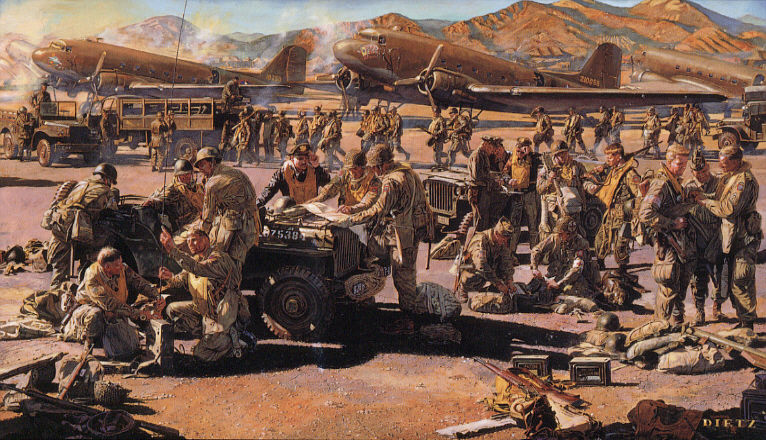
over Avellino and holding it indefinitely had the tiger-by-the-taiL But when the 2nd Battalion, 509th, flown by the 64th Troop Carrier Group, rolled down the runways at Licata Field, Sicily, early on the evening of September 14 and headed for Italy, it was undaunted and confident. But the small town of Avellino looked like many other small mountain towns, and the lower air was full of battle haze. And from the high altitude at which the mission had to be flown Avellino proved too hard to find. Few of the transport ships reached their proper drop zones.
What happened to the battalion is that troopers were actually scattered over an area of more than a hundred square miles.
Despite this first great handicap, individual trooper and small units did give a good account of themselves. They mined roads, blew bridges, and destroyed German communications. And they ambushed small enemy columns and shot isolated German messengers. Reports now available show well that what the 2nd Battalion of the 509th was able to do caused a considerable number of German troops to be committed to anti-parachute and searching work. Of the 640 troopers, who jumped approximately 510 eventually filtered back to the Allied lines. The experience of the battalion commander himself was typical of what happened to many who did not get back. He landed in the midst of a German tank park and immediately got into a small-arms fight. He was finally wounded and captured.
It is hard to arrive at a true evaluation of the Avellino operation. It is doubtful that it had any decisive bearing on the outcome of the Battle of Salerno. It disrupted German communications and partly blocked their supplies and reserves. It also caused the enemy to keep units on anti-parachute missions that otherwise could have been used at the point of his main effort at Salerno. In fact, he used many more troops for corrective and preventive purposes against the airborne troops than were committed by the Allied high command.
From the Salerno and Avellino operation on, the Allied airborne troops in Italy fought as ground forces. There were no more jumps until they were used in France, although a number of plans
Page 33
were made for their use by air as the Fifth and Eighth Armies fought steadily up the Italian boot. But none of these further plans was put into effect.
Probably the most promising of these was the plan known as SHINGLE. It called for dropping the 504th Parachute Regiment Combat Team astride the main north-south highway eighty miles inland from Anzio on the night of the Anzio invasion. The mission was to prevent the movement of enemy troops into the Anzio-Nettuno area. The combat team was to be accompanied by fifty CG-4A Waco gliders carrying reconnaissance vehicles and antitank guns. The commander was directed to conduct active reconnaissance at once upon landing. He planned to push strong motor patrols north beyond Field Marshal Kesselring's command post and into Rome. If the capabilities of the 504th in this situation can be gauged by its performance in combat throughout Italy, it would almost certainly have entered Rome.
But this is pure speculation, for at the last moment the operation was called off and the combat team was landed from the sea and not the air. Airborne participation in the Anzio operation is just a fine problem for the Monday morning quarterbacks, though I think that airborne troops could have been used gainfully and perhaps even decisively in their chief role.
Airborne operations during the Battle of Italy were not all on one side. The capture of the Island of Leros in the Dodecanese on November 12, 1943, is of particular significance and high tactical value. Leros was garrisoned by approximately 3,000 British troops and some 6,000 Italian and Greek troops. The British had organized the defenses as well as their limited means would permit.
They had British battalions in reserve in the northern, central, and southern sections of the island. The non-British troops manned the beach defenses. There was enough warning of the attack on November 9 to warrant ordering all troops to their battle positions. German air attack increased in intensity until November 12. Early that morning amphibious attacks were launched on the beaches northeast of Mount Vedetta and on those of Mount Appetici farther south. During the morning of the 12th the German
Page 34
air forces kept pounding the defense positions and at noon, after a brief calm, German dive-bombers and other aircraft concentrated their efforts on the British defenses between Gurna and Alinda Bays. These attacking planes were closely followed by transport planes that dropped their loads of paratroopers on the narrow, mile-wide neck of land between the two bays.
The defender had a hard decision to make. To turn and attack the parachute troops was to commit reserves that might be vitally needed against the assaults from the sea. On the other hand the German paratroopers, on their neck of land, cut the island in two and split the defender's forces, and something had to be done about that. The British decided to counterattack the German parachute units.
On the 13th, the Germans were able to expand both amphibious beachheads and reinforce their parachute units by sea from the Bay of Gurna. The British made a heavy attack against the now reinforced parachute battalion on the 14th but could not dislodge it. The Germans continued to expand their beachheads and gave all possible air and ground fire support to the parachute troops who continued to hold the vital neck of the island. In the end it became simply a question of time since Allied reinforcements did not materialize. The British capitulated on November 16.
Here an airborne battalion, outnumbered by the defenders more than ten to one, had played a decisive role in the defeat of the defending garrison. The attacking airborne commander realized that he would be clearly outnumbered but that by carefully selecting his terrain and then landing directly upon it he could contribute to the decisive defeat of the island's garrison. In execution it was a marginal performance. It was, in addition, another good example of an airborne truism: The offensive ability of an airborne force can best be measured in terms of its ability to defend.
By the end of 1943, the planners and fighters of the Allied troop carrier and airborne troops had a much better idea of their own capabilities than they had had in the spring of that year. Many hundred small technical problems of individual and unit equip-
Page 35
ment had been solved. And it was now known how much ammunition, food, and medical supplies were needed to carry on an isolated ground action successfully after a drop. We knew how to make all this into an airborne operation. How to marshal, take off and fly three to four hundred C-47 transports in close coordination with fighters, bombers, and surface craft was everyday working knowledge to the staffs. A few sound principles of the use of airborne troops had begun to emerge from the uncertainties that had enshrouded their tactical employment from their beginning. Clearly, they must be employed in mass and not in small packets. They must be used at the point where their action would be decisive, and not scattered about for local tactical gains. Their use had to be most carefully coordinated with all other participating forces-ground, air and naval. Equally, the combined employment of all these forces had to be given initial direction and coordination by the highest headquarters in a theater of operations. Airborne units are especially suitable for seizing key terrain and blocking the movement of enemy reserves. They are also a means of very rapidly reinforcing a seriously threatened major' operation. If properly trained they can paralyze the enemy's nerve system, his communications.
The troop carrier formation of Vs appeared to be ideal for parachute delivery. A group of C-47s (36 to 45) flying a tight formation could deliver a battalion of parachutists in an area 1000 yards long by 500 wide in about two minutes from the time the first chute appeared in the sky. A regiment could be landed in about ten minutes. A well-trained parachute battalion could be assembled and moving, with its ground mission well in hand, in twenty minutes, and at worst it should not take more than an hour. We had also learned that the drop zone must be as close as possible to the unit objectives. Best of all is to land right on the objective. In general, if the landing area around an objective is rather rough, it is better to take, say, five-to-ten per cent jump injuries and land on the objective than to land away from it and have to fight to reach it. And once on the objective, the troopers
Page 36
dig and hold. They destroy enemy communications, patrols, and reconnaissance parties. They reconnoiter energetically in all directions.
By early 1944, Allied troop carrier and airborne troops had the know-how of flying and fighting formations of 300 to 400 parachute ships. But on the horizon, larger masses of aircraft loomed -troop carrier formations of 1, 200 and 1, 500 transports with thousands of gliders of different types and capacities. These would come with the attack of the strong German fortress of northern Europe. Properly committed, and exploited, the airborne troops looked like the answer to Hitler's challenge that he awaited the Allied onslaught with pleasure, confident that it would be turned back utterly destroyed and decisively defeated for all time.
The Allied airborne fledglings had learned their lessons. The battles of Normandy showed every promise of being without precedent not merely in airborne history but in the military history of mankind.
CHAPTER 3: Back Door to Normandy
VIDEO: part 1: the 82nd Airborne in World War II: Sicily to Normandy
 www.youtube.com/watch?v=c6WD5jZxRkE
www.youtube.com/watch?v=c6WD5jZxRkE
AIRBORNE OPERATIONS are planned and staged with one eye on deception and one on the assault. They are, for the opposing commanders and staffs, keen contests of wits and ingenuity. The possible area of operations is vast and normally encompasses many thousands of square miles. The airborne targets and take-off airfields may be separated by hundreds of miles yet be within a few minutes' or a few hours' striking time.
The commander who intends to attack, marshals his troop-carrier aircraft and shifts his airborne troops with as much attention to a cover plan for deceit as to the actual assault plan itself.
On the other side, defensive troops are hidden and exposed, and moved and counter-moved. Anti-airborne obstacles are prepared to destroy the attackers; worthless but sinister facsimiles are prepared to scare them off. Good landing areas are totally neutralized by passive anti-airborne defensive measures, while others, equally as good or better, are left untouched to lure the assaulting airborne troops into organized and defended traps where they can be destroyed by well concealed weapons.
Thus in such situations there are two conditions that make airborne combat, in its broader aspects, markedly different from other types of fighting. First, the defender can prepare active and passive measures against an attack with comparative immunity from detection. Second, an airborne assault, once it is under way, is beyond immediate relief, alteration of direction, or even succor.
The battle, when finally joined, is the payoff.
Therefore, every factor that must be considered in planning for airborne and anti-airborne operations is worth the most thorough scrutiny and study if the greater airborne operations of the future are to be staged or coped with successfully.
The techniques of both operations-airborne and anti-airborne received a thorough combat test in the airborne battle of Normandy. In this battle three airborne divisions. participated in the most carefully planned airborne attack of military history. Many months were spent by our own forces in the preparations for at-
Page 37
tack, and equally as many were spent by the enemy in preparations for defense. Despite seven months of continuous planning on our part, it became necessary, just one week before the assault troops were to move to their departure airfields, to revise completely the over-all assault plan. The intelligence and counterintelligence on both sides had apparently been functioning inordinately well.
Yet, with all of the planning and cover-planning, when the airborne troopers came tumbling out of the Normandy skies the night of June 5-6, the defenders were manning all the anti-airborne defensive installations. And in one locality they were actually, as one German prisoner put it later, "having a realistic field exercise against airborne landings." Extensive preparations for the assault on Normandy began in November 1943. Most of the required troop-carrier aircraft were still in the United States and one of the airborne divisions was in Italy. But studies and planning for their commitment in Normandy were begun at COSSAC [Chief of Staff, Supreme Allied Command] in Norfolk House in London in the fall of that year.
British airborne troopers were represented by their newly appointed-commander, Lieutenant General F. A. M. Browning. U.S, Airborne troops were represented by the senior U.S. Airborne commander and the then commanding general of the 101st Airborne Division, Major General William C. Lee. Later, after the arrival of the 82nd Airborne Division in England, its commander, Major General Matthew B. Ridgway, was designated as commander of the U.S. Airborne control and advisory group.
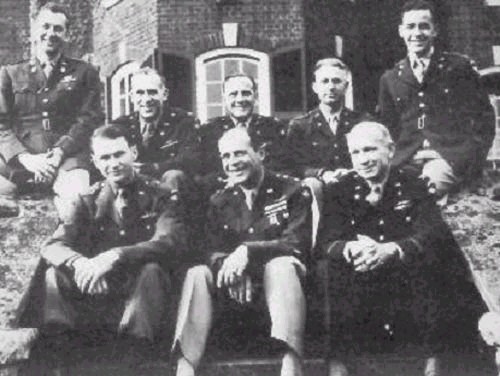
Generals Ridgway and Gavin before D-Day during a break from planning
The Allied troop-carrier and airborne strength for the battle of Normandy was sizable. The following shows rough totals of the available troop-carrier lift:
|
Carrier |
No. |
Payload (lbs) |
|
Troop-carrier Transports |
1384 |
5,850* |
|
Gliders (CG-4A Waco) |
2000 |
3,750 |
|
Gliders (Horsa) |
1250 |
6,900 |
|
Gliders (Hamilcar) |
50 |
16,000 |
|
*Payload of the C-47 transport |
||
Page 38
There was an acute shortage of glider pilots. In November 1943 it appeared that there would not be enough pilots to provide one for each glider. The normal complement is two, a pilot and co-pilot. In the final invasion each co-pilot's seat was occupied by an airborne trooper. Incredible as it may seem, these men sitting in the co-pilot's seat had been given no training either in flying or landing the glider, and some of them found themselves with a wounded pilot and a fully loaded glider on their hands as they came hurtling in through flak-filled space on June 6. Fortunately, the CG-4A is not too hard to fly or land. But having to do it for the first time in combat is a chastening experience; it gives a man religion.
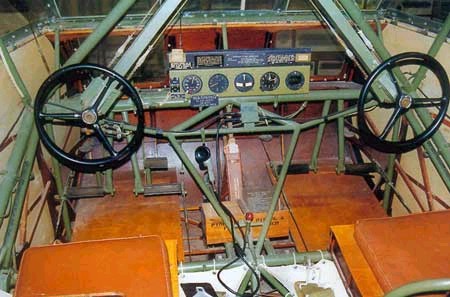
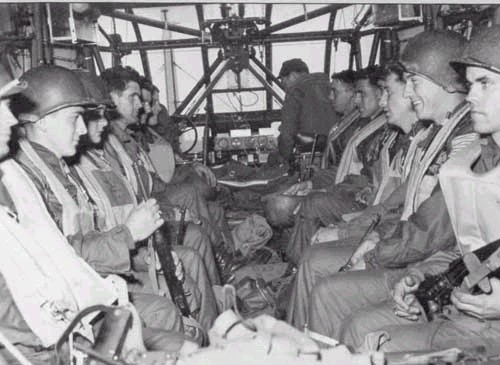
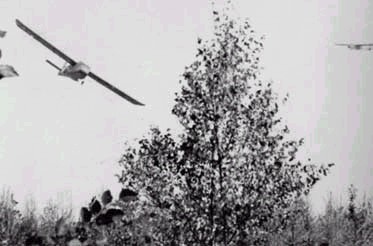
There were two American airborne divisions available, the 82nd and 101st. In addition there was a separate parachute brigade consisting of two parachute regiments, the 507th and 508th.
These were later attached to the 82nd. The 504th Parachute Infantry Regiment, organically part of the 82nd Airborne Division, was involved in the Anzio beachhead fighting, and it did not arrive in the United Kingdom until too late to participate in the Normandy fighting. There was an interesting sidelight here. The German high command was quite obviously confused by the apparent split of the 82nd Airborne Division. They had the division listed present in the Anzio beachhead during the time the 504th Parachute Regiment was fighting there, and consequently they figured it could not be ready for the Normandy assault. German interrogators in Normandy kept inquiring of American prisoners where the 504th was, since it did not participate in the Normandy assault.
The British had one division available, their 6th. And in addition they had a sizable group of French, Belgian, Norwegian and Dutch paratroopers who were not used in the major airborne landings in support of the amphibious D-Day assault, but many of whom jumped on special missions. The first planning estimates indicated that it would be possible to lift the parachute troops of the three divisions, and a small glider force besides, in a single lift; and that the rest of the airborne troops of all three divisions could be moved in the second lift. The second lift would be gliders. Each division would have a seaborne echelon that would come in as early as possible after a beachhead was established. These echelons would include tanks, bulldozers, trucks and heavy equipment not transportable by air.
The first and major Normandy mission for the airborne troops was a vital one. They were to block the German reserves that would attempt to reinforce the defending coastal units. The next airborne force mission was to attack the coastal defenses from the rear.
The amphibious assault was originally limited to the stretch of coast between the River Orne and the River Vire (see Map 5). On December 18, 1943 there was a meeting held at Headquarters, British 21st Army Group in London, for the purpose of outlining the proposed amphibious assault and discussing how the airborne
Page 40
troops would probably be used. Representatives of the U.S. and British airborne and troop-carrier commands were there, as well as staff officers of the U.S. First Army and British 21st Army Group. Extensive studies had already been made of the Normandy terrain for many miles inland, and it was quite evident that any major movement of reserves would have to use the corridor between Caen and Bayeux, probably funneling through the two towns themselves, for this corridor was excellent tank country.
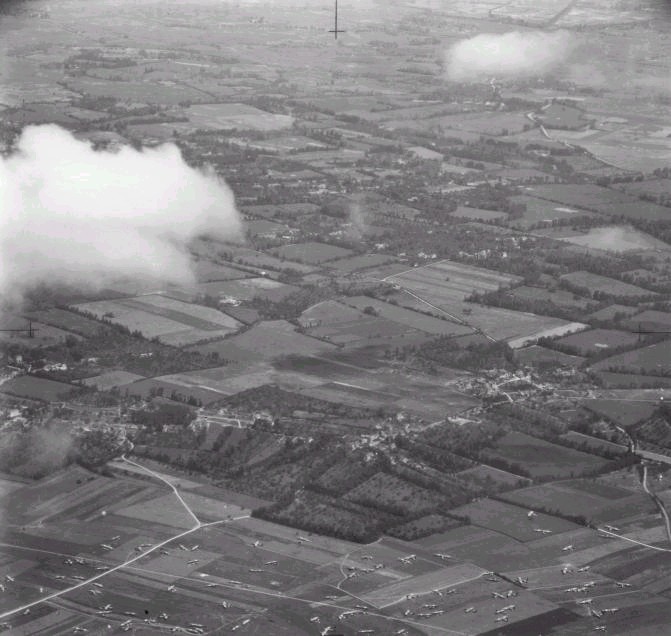
Area of Landing Zone "N" east of the Orne river and north of Caen where the British 6th Airborne Division landed is ideal drop zone area for Paratroopers as well as for gliders to slide to a halt, but good open terrain for heavy tanks to traverse; the Paras holding the eastern flank of the invasion had to hold regardless
Clearly, if the airborne troops were to block the hostile reserves, the place to do it was around these two towns and in the corridor between them. But unfortunately, airborne troops would be at a great disadvantage in such country fighting against armor. Whenever possible they like to pick their ground and their defensive positions in such a way that the enemy's armor is canalized in its attack. But here the German armor would have all kinds of maneuver room and would very likely play havoc with the airborne divisions. There was a good chance that they would be able to run through our airborne defense positions at will. I knew by then that I would participate in the airborne assault and I remembered our experiences with the Hermann Goering Panzer Division in Sicily. I was especially aware of the difficulties we would probably have in fighting off the German armor and so I took a rather dim view of the entire plan. The drop zones and landing zones, were suitable, the flak to be expected was not too bad, and the rest of the plan looked feasible enough. But it was obvious that the 21st Panzer Division, which was within ten miles of Caen, would be especially difficult to handle in such good tank country.
MISSION OF THE AIRBORNE ATTACK
Nevertheless the job had to be done. For, after considering the comparative rate of build-up of both the German and Allied troops in the beachhead, it became apparent that a full efficient exploitation of the airborne potential could indeed have a decisive bearing on the final outcome of the whole D-Day operation. The London conference agreed that one U.S. airborne division should
Page 42
be dropped southwest of Bayeux, one U.S. Division southeast of Bayeux and the British 6th Division near Caen (Map 5.) The main mission of all three divisions would be simply to block the movements of German troops toward the beachheads, and to keep on doing this until the ground landing troops had gained contact with them and relieved them.
I recall now that after I had left the conference somebody pointed out to me that in Major F. O. Miksche's book, Paratroops he had suggested a plan for the use of parachute troops in this same Normandy area-a plan exactly like the one just agreed upon. Well, undoubtedly the Germans had read Miksche too. And even if they hadn't, anyone studying the potentials of a Normandy landing could soon determine that the Caen-Bayeux corridor was the only area suitable for a blocking mission in support of an amphibious attack between the Orne and Vire rivers.
Later in December I was present at a conference at the headquarters of General Omar Bradley in Branston Square in London.
At this meeting, General Bradley showed a particular interest in widening the assault front to include a landing north of the Vire estuary, and in the event such a plan were adopted, using the airborne troops to assist the landings and cut off the Peninsula.
The prompt seizure of the port of Cherbourg was one of the missions of the First Army, and if Cherbourg could be blocked off speedily, it would be a decisive contribution to the whole operation.
The country between Carentan and Lessay in contrast to that between Caen and Bayeux, was excellent antitank country. There were very few areas of any size in which the tanks could maneuver with any freedom. And there were plenty of drop and landing zones. The mission appeared to be a natural.
The plan we finally arrived at was the one toward which all preparations, reconnaissance, and planning were pointed for the next six months-until just one week before our departure for the
Paratroops. By Major F. O. Miksche (Czechoslovakian Army), New York: 1943. This book was originally published in England many months before D-Day and greatly startled the airborne D-Day planners. Two of the three drop areas shown by Miksche coincided closely with those arrived at in planning. -ED.
Map 6.
take-off airfields. The plan called for the drop of one U.S. division north of Carentan. This division was to block the movement of German reserves, seize the western ends of the causeways leading from the assault beaches inland, and seize also crossings of the Merderet River in preparation for an advance to the west (Map 6).
The other U.S. division was to land several miles west of St. Sauveur-le-Vicomte (see Map 7) and capture that town and the bridge over the Douve River nearby to block all movement north of the Prairie Marecageuses and block all roads to the coast. It was assumed that the British airborne division would land in front of the British amphibious assault. Actually its mission remained substantially unchanged from its inception; to protect the left flank of the D-Day amphibious forces and aid the landings by seizing bridges over the Orne River and Caen Canal in order to
Page 43
Map 7.
block the movement of German troops and knock out German fixed installations and coast defense batteries on the British left flank.
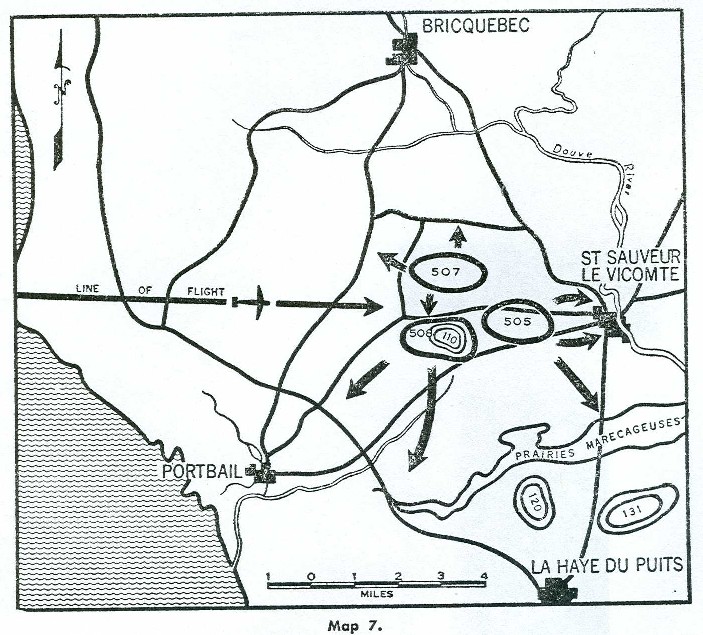
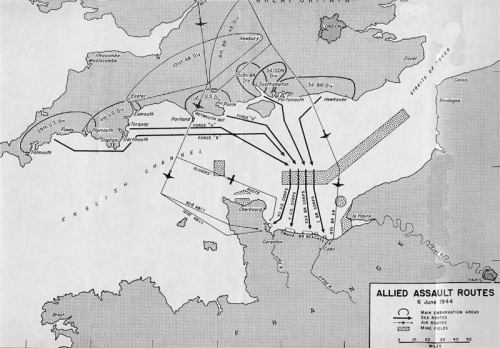
This was, in brief, the airborne plan for D-Day. Late in December Field Marshal Montgomery arrived in England and soon thereafter approved the plan suggested by General Bradley of expanding the proposed beachhead to the north of the Vire River.
The American effort was divided between the V Corps to the east of the Vire River and the VII Corps to the west of that river.
The use of the airborne divisions to support these landings was to be as recommended by General Bradley.
The next several months were months of coordinating the many details of a joint plan of such magnitude as Operation Neptune, the operational name for the Normandy invasion. Our first step was the publication of a training directive standardizing the use
Page 44
of all aircraft by British and American Paratroopers. Loading manifests, methods of marshalling and loading, alert and jump signals, and interior equipment of the ships were all arranged so that either force could be dropped by the Troop Carrier Command without change in technique or commands. British troopers trained with American aircraft and American troopers trained with British Horsa gliders. Thorough small-unit training was conducted and finally full-scale dress rehearsals were staged to check by actual performance the details of the final plans.
On the basis of our experiences in Sicily and Italy, the 82nd Airborne made highly detailed preparations for individual and unit loads. We balanced our plane-loads to provide for a proper distribution of weapons in case some plane load was dropped in the wrong area. Since tanks are the first concern of all troopers, we distributed bazookas and mines throughout the flight. Gammon [antitank] grenades were made available to every man. All "comfort" items were eliminated, and most troopers loaded themselves down with extra ammunition until they had to be helped aboard the planes. Sicily and Italy had taught us that it was undesirable to blacken our faces or use crickets as signals. We decided to rely solely on oral challenge and response, and a quick response it had better be. (This proved to be harder on the Normandy livestock than it was on the Germans, and there was certainly a lot of livestock wandering about that first night. )
Loads of planes and gliders were weighted and checked in order not to waste an ounce of the authorized payloads. The load for the C-47 was 5,850 pounds, and 3,750 pounds for the CG-4A glider. We memorized the terrain, the drop areas and the road nets, and we memorized all plans and orders so that no man would have to take a marked paper into combat. Time and again we held night reorganization and assembly problems. In these, we made use of all the assembly aids that had been improvised since the highly confused night fighting in Sicily. And we held war games on scaled sand tables for all units down to include the squads of every outfit until every man knew not only his own mission but that of his probable neighbors in combat.
Page 45
As D-Day neared, we studied intensively the air photos of the operational areas and naturally we did this with particular attention to the anti-airborne obstacles. The Cherbourg Peninsula was beginning to blossom out with them like a child breaking out with chicken pox.
GERMAN ANTI-AIRBORNE DEVICES
Typical of the anti-airborne measures we detected was the German preparation of Hill 110. This clear un-wooded height rising 110 meters above the surrounding hedgerows was about five thousand yards west of St-Sauveur-Ie-Vicomte (see Map 7). From its higher points, there was observation almost to the east coast on a clear day and to the west coast under any ordinary conditions of visibility. Seizing and holding it would undoubtedly have a decisive effect on the operations of the airborne troops destined to land in that vicinity. The task had been assigned to the 82nd Airborne Division.
The study of the day-by-day photo coverage of Hill 110 showed that its terrain was that of an average combat drop zone. Its slopes were too steep for gliders but they were free of large boulders or timber that would deny the use of an area to paratroopers. Along its western slope, running about a half mile, was a deep quarry about fifty yards wide. The hill itself was circular in shape and about a thousand as in diameter. It was not too good as a combat drop zone, but it was much better than many that paratroopers had landed upon without excessive losses in Sicily and Italy.
After a discussion of the probable losses, Hill 110 was designated as the drop zone for the 508th Parachute Infantry.
Then followed a careful and painstaking study of the enemy activity and disposition in and around the hill area. First, the hill had three windmills on it. Intelligence reports showed that these were now in use as radio towers. A small German caretaking detachment was always at these stations but it was not large enough to be of any great concern to us. Next, the quarry began to show signs of occupation. From the air photos it appeared that weapons
Page 47
were emplaced in or near the quarry. These might be light ack-ack weapons. It was impossible to tell.
On the lower slopes of Hill 110, where it blended into the wooded hedgerows, parking bays for vehicles began to appear, a sure sign, as we learned later, of a permanent installation. At several points on the lower slopes of the hill, the hedgerows were cleared away. We couldn't figure the answer to this and although we watched each new photo very closely for weapons emplacements, none showed up. Finally, about three weeks before D-Day, small black specks in a regular geometric pattern began to show up all over the hill. They continued to grow in number until the entire hill was covered with them. They were simply specks, apparently holes, for they didn't throw shadows on early morning photos as objects above the ground do.
Some of us who were familiar with the operational plans were sure now that the Germans knew our landing plans and were taking some measures to counter them. We had already heard of Rommelspargel, but usually when these were installed one small field was completed at a time. Rommelspargel (Rommel's asparagus) were poles about six to twelve inches in diameter and eight to twelve feet long. They were sunk a foot or two into the ground and stood seventy-five to a hundred feet apart. They were obviously intended to deny the use of good landing zones to Allied airborne troops.
Sure enough, after several days of worry over Hill 110, the telltale shadows of the Rommelspargel began to appear. It was impossible to say whether or not they were connected by wires, or whether there were actual troop defense installations among or near them. But since the hill was not to be used by gliders, it was decided to drop the 508th on it anyway, despite the evident preparations being made for its reception. We had to have the hill, and if we didn't land on it we would have to fight to get it. And it seemed likely that this would be more costly.
But it undoubtedly was fortunate that, just about a week before our movement to the departure airfields, the drop zones of all elements of the 82nd Airborne Division were moved about ten miles east of St-Sauveur-Ie-Vicomte. And so the drop on 110 was not made. I was so interested in it, however, that I made a thorough reconnaissance of it the very day that it was captured on D plus eleven. It was the most thorough job of anti-airborne organization I have ever seen. The entire hill was covered with Rommelspargel. They were all wired together with barbed wire, some from top to top, others from top of one pole to the bottom of opposite poles, and others from the bottom of one to the bottom of another. They were booby-trapped to artillery shells and some of them to mines. The whole perimeter of the hill was outlined with individual and crew-served weapons emplacements. All the emplacements were connected by narrow German-type trenches and also connected to dugouts where the troops apparently rested.
There were concealed observation posts equipped with alarms along the perimeter of the hill. The quarry contained large troop shelters and numerous mortar positions with emplacements well-camouflaged and with prepared concentrations covering the entire hill. All in all, Hill 110 would have been a red-hot place to find oneself during the hours of darkness on D-Day. The most interesting thing about the preparation of Hill 110 from an academic viewpoint is that the defender was not content to use passive measures only. Rommelspargel was usually considered to be adequate as an initial defensive measure, troops were kept in a mobile reserve.
But the importance of Hill 110 as a terrain keypoint certainly justified the extensive measures taken to insure its retention.
We studied intently the German use of "asparagus" for a long time as a possible indication of the enemy's evaluation of his sector from the defensive viewpoint. We figured that the areas thoroughly saturated with asparagus were the areas he wanted particularly to deny us. We felt that there must be a reason for his being especially thorough in the preparation of one area and not of another. Probably those areas he prepared so thoroughly had a worthwhile objective for us. But, as one always finds, in the final analysis, human nature is still the greatest factor to be dealt with in war. From interrogation of captured German commanders and
Page 49
French civilians we soon found that the amount of asparagus in anyone locality was more an indication of the efficiency and enthusiasm of the local German commander than anything else.
Good landing areas were in some instances left untouched because the defense commander was just plain lazy. In other areas, every square yard was covered because the defender had so much enthusiasm for doing his job as thoroughly as possible. The amount of asparagus had little relation to the tactical value of an area. But we realized that it would be a serious mistake in future planning to fail to realize that, when time or materials are limited, the most important areas from the defender's viewpoint would always be given priority in defensive preparation.
ACCELERATED PREPARATIONS
Throughout the tightly packed little island of England preparations now accelerated at an intensive pace. Pre-drop bombings were laid on, and smoke was planned to cover Hills 121 and 131 during daylight landing hours. Flights were carefully coordinated with the amphibious fleet. And we anticipated and took care of the thousand and one details of orders, equipment, and organization. Finally all seemed to be as ready as any fresh airborne plan can be.
But the enemy was not spending his time idling. Across the breadth of northern France-and to some German commanders there must have seemed a great deal of it-the enemy was taking hurried frantic measures with every means conceivable in his power to stop what was certain to be the greatest airborne invasion in the history of modern armies. According to what we later learned from Generaloberst Student, the senior German airborne officer and commander of the German forces in Crete, the German enemy had been greatly impressed by the static denial measures taken by the British in 1940. The potential results of such measures were given a heavy weight when the Germans decided to cancel their proposed invasion of England in the fall of that same year.
The Germans were particularly impressed by the posts, piles of
Page 50
rock and wrecked cars used to obstruct all landing fields. They were taking similar measures in France as rapidly as circumstances would permit. Colonel General Student made an interesting statement in his interrogation, to the effect that the Germans had prepared a counter-airborne plan in great detail, including maps that showed all extensively mined and staked areas, and all areas that could readily be flooded. But all of this was, according to Student, largely a work of imagination intended to fall into Allied hands and discourage airborne attempts.
If such a map was prepared I certainly never saw it either during the preparation phases or at any other time. Student said also that he tried to get Hitler's ear to gain approval for a plan to use the German paratroops against the ports of embarkation and thus break up the invasion before it got a good start. This was an interesting plan, and a plan of some merit. But according to Student, Goering rejected it and wouldn't let the intuitive Fuhrer hear of it.
But Colonel General Student did recommend to Hitler several times that German parachute troops be used in airborne counterattacks against the Allied airborne landings, if and when they came. But this idea of his got a cool reception until the Fuhrer saw how successful the Allied landings were. Then he ordered Student into action. But unfortunately for Colonel General Student, the only available German paratroop division was already committed in a ground role and it couldn't be disengaged in time to be effective.
While all of this high-level talking was going on, local small unit commanders were improvising and making the best of every anti-airborne means they could get their hands on. Asparagus was, of course, the favorite means. The extent to which asparagus was used in general, however, can be judged by Field Marshal Rommel's report after his inspection of the West Wall in the spring of 1944. Rommel said, "The construction of anti-paratroop obstacles has made great progress in many divisions. For example one division alone has erected almost 300,000 stakes, and one corps over 900,000." And Rommel further reported, "Erecting
Page 51
stakes alone does not make the obstacles complete, the stakes must be wired together, and shells and mines attached to them. The density must be about a thousand stakes per square kilometer...It will still be possible for tethered cattle to pasture underneath these mined obstacles." This last statement is of particular interest for our air photo interpreters were watching very carefully where the cattle showed up on the photos. It was assumed that where the cattle could go, the troopers could move with impunity.
Later, this was to have tragic consequences. The C-in-C West, Army Group D, published an excellent Soldier's handbook on April 15, 1944, entitled, "What Every Soldier Should Know About Airborne Troops". This was a printed booklet, well illustrated in colors, which served its purpose well judging from later prisoner of war interrogations. The German Division with which the 82nd Airborne Division was closely opposed in its first fighting, the 243rd, published an excellent memorandum of May 1 about anti-airborne obstacles. It followed this memo up with another on May 15 about the tactics the German units should employ in dealing with assaulting airborne troops.
Copies of both of these memorandums were captured by the 82nd Airborne Division in the fighting that followed the invasion. All echelons of the German 243rd Division had gone to work with imagination and vigor. They established static sentinel posts and lookouts at critical points, and they began regular anti-airborne patrols. They held frequent anti-airborne training exercises and alerts and, as far as possible, took every step they could think of to meet and destroy the threatening attack.
In mid-May 1944, however, the potential situation became so critical to the German high command that it was deemed necessary to move still another infantry division into the Cotentin Peninsula. They sent in the German 91st Infantry Division and located it generally, as well as we were able to determine at the time, in the vicinity of St-Sauveur-Ie-Vicomte.
The situation did not look too promising then for the U.S. 82nd. Indeed it looked so unpromising that it was decided to change our
Map 8.
landing areas. On May 26, we received new orders moving the Division farther east (see Map 8).
By this date, all plans were completed for the 82nd Division to carry out its original mission. Field and administrative orders for our D-Day operation had been published and distributed. And in a series of map maneuvers on a special 1/25,000 map, all regimental and battalion commanders of the Division had outlined their plans in order that all commanders down to those of the smallest units could be thoroughly made aware of the schemes of maneuver they and their outfits were intended to carry out.
The seaborne echelons of the 82nd had already departed for the marshalling yards. They were scattering along the coast of Wales and southern England. It was just five days until Y-day (Ready Day). The new line-up was as follows: The 82nd Airborne Division
Page 52
was to land astride the Merderet River. It was then to seize, clear and secure the general area Neuville au Plain-Ste. Mere Eglise Chef du Pont-Etienneville-Amfreville. It was to destroy crossings over the Douve, and the 82nd Division was then to be prepared to advance to the west on Corps order. The mission of the 101st remained generally unchanged, except that responsibility for capturing the bridges over the Merderet was now given the 82nd. The mission of the British 6th was also the same as before.
We received the new plan without a single regret. The 508th had never thought well of the Hill 110 mission. The 505th, although it was a veteran experienced regiment with two combat jumps to its credit, had plenty of respect for the defending German forces who were around St-Sauveur-Ie-Vicomte, the town it was to capture. The German activity around that town had been increasing steadily. According to the G-2 estimates, St-Sauveur-Ie-Vicomte probably housed a division headquarters plus division special troops, and possibly an infantry regiment besides. The Germans were stocking gas and oil dumps near the railroad yards.
They were clearing hedgerows around the town, and quite a few gun emplacements were coming into view day by day in the air reconnaissance photos. Just the same, most of the experienced officers of the Division thought it would have had a reasonably good chance of accomplishing this mission if it had landed on the western side of the Peninsula.
We assigned regimental missions to conform to the new division mission merely by sliding the regimental drop zones the necessary number of miles to the east. We left unchanged the relative location of the drop zones. Consequently no change had to be made in the assignment of units to take-off airfields and troop carrier units.
The whole success of an airborne operation depends more than anything else on the cooperation and teamwork between the troop-carrier commanders and pilots on the one hand, and on the airborne commanders and jumpmasters on the other. They must work together as often as possible. And the team should be changed as seldom as possible.
Map 9.
Despite the late change, all airborne troops were fully briefed and on their take-off airfields, ready to go on June 4. That was the night they had expected to take off. But D-Day was postponed one day.
But despite the postponement, calm and quiet prevailed and the expected attacks by the German air force and V-bombs did not materialize.
The several dry runs of Y-day and D-Day which had been held during the preceding month had taken the novelty out of the staging and sealing process. The cover plan for the D-Day operation had apparently worked very well. Then D-Day was finally announced as June 6.
Shortly after dark on the night of June 5 the pathfinder ships of the IX Troop Carrier Command roared down the runways of the airfield at North Witham, England. The airborne battle of
Page 54
Normandy, history's largest airborne assault, had gone into the pay-off stage.
The weather was not too good but it was not too bad. Over on the Continent, the chief German meteorological officer had informed his high command that the weather was such that no invasion could take place. But fortunately for the Germans, this information was not permitted to reach the troop commanders and their state of readiness was not affected by the report. General Eisenhower had similar information, but after considering the whole situation carefully, he decided to go ahead with the show.
Airborne operations are sensitive to weather conditions. Some airborne units found themselves in apparent difficulty. But in the end, all airborne outfits accomplished their missions.
The troop-carrier flight plan was the most complex that had ever been attempted up to that time. It involved several thousand aircraft. It had to be carefully coordinated with the operations of the largest amphibious landing force in history. And naturally it was the subject of many months of discussion and preparation.
The work of friendly bombers and fighters as well as the potential effect of German aircraft and flak all had to be given the most careful consideration.
The flight plan in its final form is shown in Map 9. In general, each troop-carrier unit marshaled over its home airfield and then moved on a time schedule to its place in the flight stream. All possible visual navigational aids were put to use in England so that the route was very well marked until the planes reached the coast of France.
The first flights of the U.S. airborne divisions flew to the west of the amphibious forces on the English Channel, and passed around the Normandy Peninsula, carefully staying out of range of the flak from the guns known to be on the islands to the west of the Peninsula. They kept this course until they reached the coast.
Then the planes made a straight run to the drop and landing areas. The ships then passed out of the east side of the Peninsula, gaining altitude for the return trip. The British division flew to its drop landing area staying to the east of the amphibious forces.
Page 55
The first airborne men of D-Day to touch French soil were the pathfinder personnel who landed between 0010 and 0020 hours, on D-Day. They encountered difficulties but marked their drop and landing zones as they had planned to.
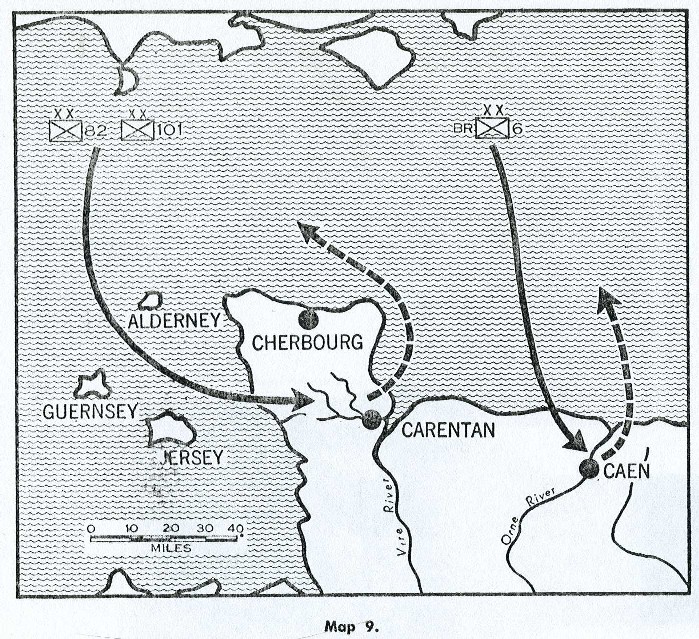
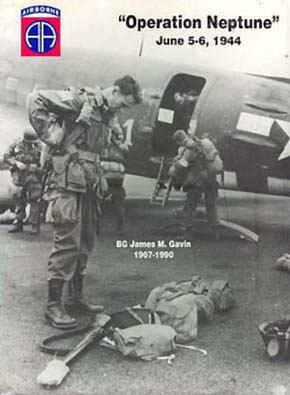
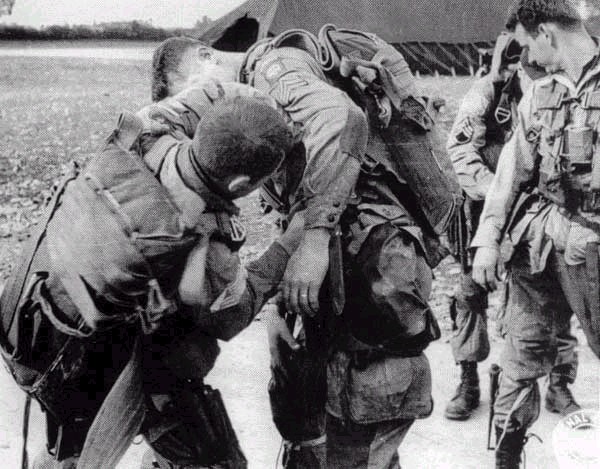
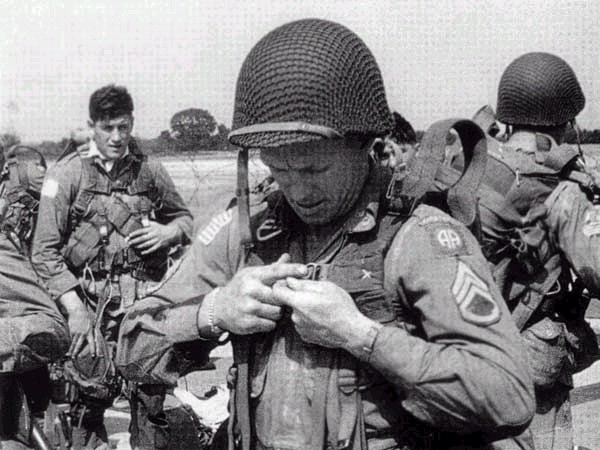
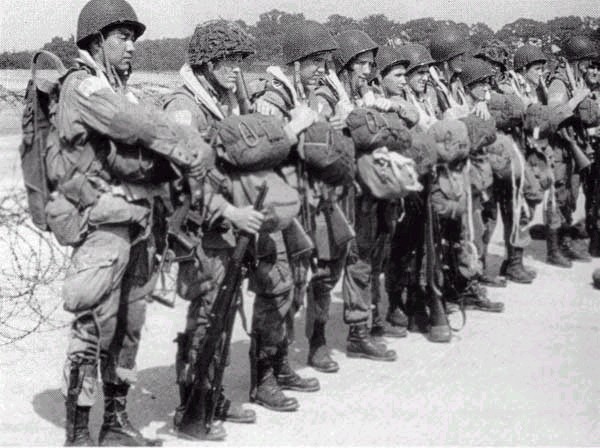
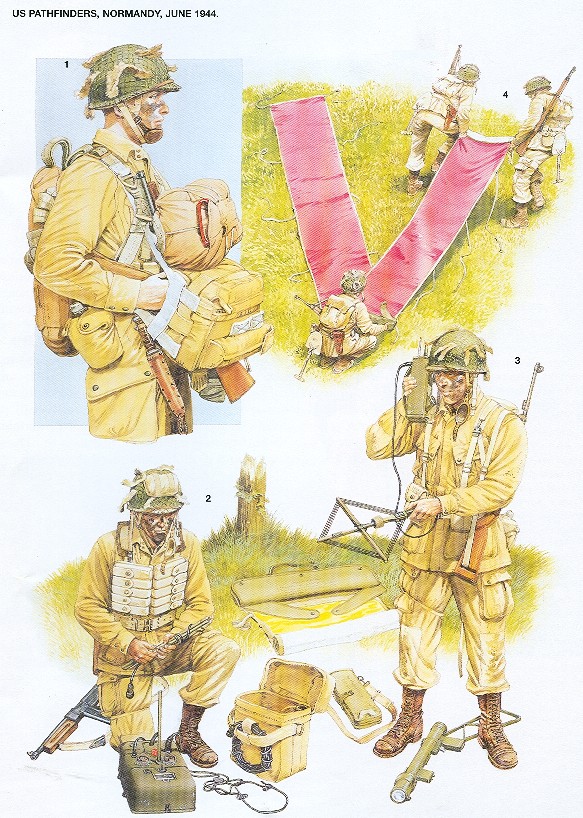
Artwork by Peter Dennis
The pathfinder teams of our U.S. Airborne forces preceded the main flights by thirty minutes. The team of the 101st Division was in the van. It was followed by the pathfinder team of the 82nd Airborne Division which actually touched French soil at 0121 on the morning of that day.
On the way through the Channel skies to France, they encountered some very bad weather which chewed them up a bit, and some formations were broken up by German antiaircraft fire.
Immediately upon their landing, some of the teams had to engage in ground fighting that badly hindered the work they were trying to do.
All in all, they proved fifty per cent effective. This, was a great gain over the previous troop-carrier airborne operations which had been conducted without pathfinder assistance.
OPERATIONS OF THE 82ND AIRBORNE DIVISION
My own experiences are typical of that of most unit commanders and it is therefore worth recounting. I was designated as commander of Task Force A. This force consisted of the three parachute regiments of the 82nd Airborne Division-plus one engineer company, an artillery detachment, an air support party, a naval fire control party and a force headquarters. My force was to land between the hours of 0100 and 0310 on D-Day. It was to land on the three drop zones shown in Map 8. My task force was flown in 378 x C-47 transports of the IX Troop Carrier Command. It was to be followed on the next flight by the rest of the airborne echelon of the 82nd Division in 428 gliders. Of these, fifty-two were to come before daylight and the rest thereafter.
My ship was the lead ship of one of the groups flying the 508th Parachute Infantry, which was scheduled to jump on drop zone N. The first ship of Task Force A was airborne 2315 on June 5.
Page 56
Marshalling and flight over England went exactly according to plan. Standing in the door of my ship, I found it possible to check all of the visual navigation aids. And from talking with the pilot, through the crew chief, I assured myself from time-to-time that all was well and moving on schedule.
After we left the skies of England, there was no activity for quite awhile. I could look back over the flight and see massed C-47s in tight formation as far as eye could reach. It was really a fine sight. It looked to me already like a good show from beginning to end.
As we passed the islands off the coast of the Normandy Peninsula, flak, both light and heavy, came up, burst, and fell short of the planes. It was a good omen. It was exactly as we had planned when we laid out the flight plan.
We continued on and crossed the coast on schedule. From my ship the shores of France looked just like the coasts we had invaded before-the land was reddish brown, and the roads and the small clusters of houses in the Normandy villages stood out sharply in the moonlight.
It was quiet now and there was no more flak-although later other airborne unit commanders reported that they were fired upon as soon as they passed across the coast. In a few minutes we went by the town of Bricquebec off to the north.
And then our planes entered into clouds, dense clouds. The clouds were so thick I could not see the wing ships from the door, and my first reaction was to think that we were in a smoke cloud put up by the German defenders. But we kept on riding through the clouds, and soon I had the feeling that we, in the ship in which I was riding and those nearby, were entirely on our own.
But every jumpmaster of every ship had memorized his time of flight from landfall to various check points within the Normandy countryside. I knew that we in the ship of which I was a passenger had to jump at about seven and a half minutes after passing above the French coast, if we were to hit our drop zone.
And as I remember now (a most important item), the east coast of France would come just about twelve minutes later. After that,
Page 57
if we jumped we would jump into the ocean. As a matter of airborne record some troopers did.
But we in my plane continued on into the fog. And about seven minutes, after we had crossed the coast the clouds began to clear.
As they did, I could see a great deal of heavy flak coming up off to the right of our flight. That ought to be Etienneville. A lot of heavy flak had been reported there and we should be just about over it at that time.
No other ships were in sight. And there were no landmarks I could recognize. But off in the distance to the north of our line of flight I could see a wide river with a turn to the west. I figured we must be south of the Douve River, but that didn't check with Etienneville and its flak.
Then some small-arms fire began to come up with its sound like pebbles on a tin roof. And then, quite some distance away, another ship or two began to come in sight. It continued to clear, and the small-arms fire continued to increase. But no one, so far, had been hit.
We were down to about six hundred feet when the green light went on. I waited about three seconds to get a last look at the terrain before I took the stick out. The time was about eight minutes after we had--crossed the coast. A lot of small-arms fire was still coming up from the ground. Straight ahead in the line of flight of our ships a very heavy ground fight appeared to be going on, judging by the sound and the number of tracers we could see flying about.
That had a good chance of being Ste. Mere Eglise. There was almost bound to be a good fight there as soon as the 505th Parachute Infantry landed, and they were to go in before we did.
I landed with a pretty loud thud in an orchard. Among the trees were some grazing cows. They kept on munching contentedly-entirely unconcerned with what to me was a most momentous occasion. My aide landed near me. Together we "rolled up the stick" * as per plan, and soon we came to the edge of a wide swamp.
* Assembled the men who had jumped.
Page 58
The troopers were busy retrieving or trying to retrieve equipment bundles from the deep marshes. From time to time another load of jumpers would land around us, or somewhere out in the swamp.
The Germans were making no attempt whatever to attack. In fact we could hear only an occasional shot somewhere not very close. But in the distance to the east there was every sign of a heavy ground fight.
In about fifteen minutes a red light appeared on the far side of the swamp. It was soon followed by a green one. These should be the assembly lights of the 507th and 508th Parachute Regiments.
I sent my aide across the swamp to gain contact with them and kept on trying myself to collect equipment and get some organization out of the confusion we had on our own west side of the swamp. He returned in about an hour and reported that there was a railroad directly to our east and a river that was passable but shoulder-deep in places. We could then determine that we were on the west bank of the Merderet River about two miles north of La Fiere. Colonel Lindquist commanding the 508th Parachute Infantry had moved south to seize the La Fiere bridge and move to his planned operational area.
Somewhere between 100 and 150 troopers from different units of the 507th gradually joined the group I was with. Some of them had been wounded, and a few had been injured as they landed.
Our equipment bundles, containing automatic weapons, bazookas and radios had been lost in the Merderet River. Near where we were, it was about a thousand yards wide, for the Germans had flooded it. A great deal of our equipment, and some of our troopers were lost by landing in its waters.
HEAVY FIGHTING BY THE 82nd DIVISION
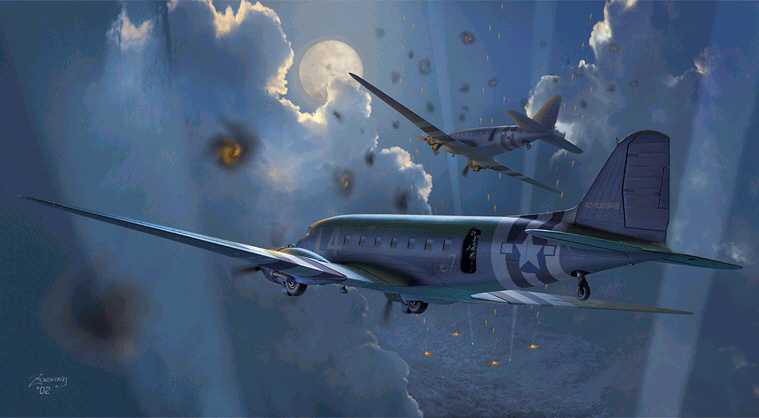
 WATCH THE CLASSIC MOVIE, "The Longest Day" based on Cornelius Ryan's Book
WATCH THE CLASSIC MOVIE, "The Longest Day" based on Cornelius Ryan's Book
Click on the picture to view the 2-hour movie
Movie details: www.imdb.com/rg/video/browser/title/tt0056197
After some delay, we tried our best to recover a glider that had landed in the swamp near us-the force that I was with moved to the village of La Fiere. There the 1st Battalion of the 505th, commanded by Major Kellam, was engaged with a small German
Page 59
force at the bridge. I established a temporary command post there and we made contact with the Division command post, which had already been set up near Ste. Mere Eglise. Major General Matt Ridgway, our 82nd Division commander, had landed by parachute with the 505th.
The fight for the La Fiere bridge and causeway proved to be hard and costly. I think it is of particular interest that during the several years that the Germans had occupied the area they had never posted troops at that bridge. They put a detachment there for the first time on D-Day night, the night of June 5-6. French civilians questioned after the fighting was over said that on the night of June 5 the Germans posted a group of about eighteen soldiers at the bridge. It was the only time that they had done that during their entire occupation of France.
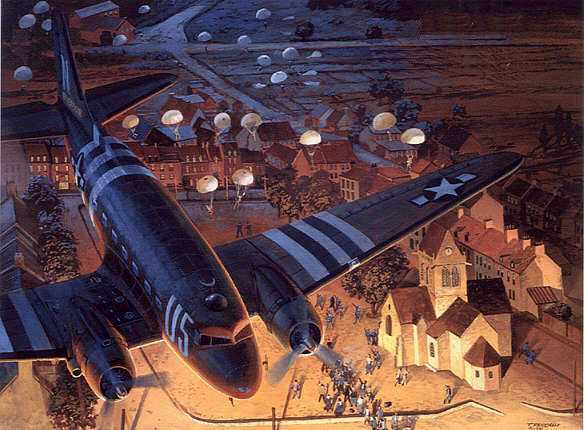
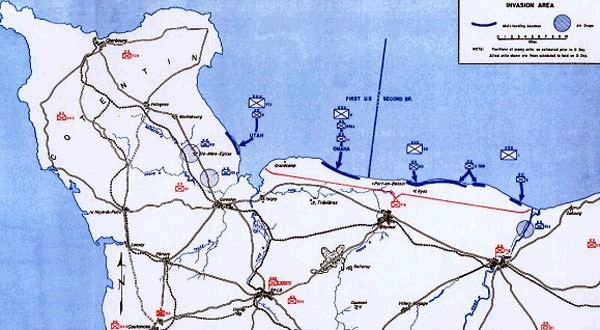
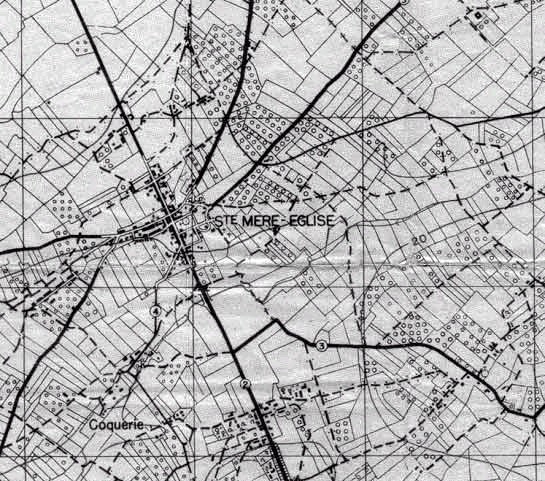
The first French town liberated was Ste. Mere Eglise.
The town was taken by the 3rd Battalion, 505th Parachute Infantry, commanded by Lieutenant Colonel Edward Krause. Krause was a veteran of Sicily and Italy. Before the take-off he assembled his troopers and an American flag up before them. He told them that it was the flag that was first flown over Naples on October 1, 1943, when the 3rd Battalion captured that city. He said he was going to fly that flag over Ste. Mere Eglise by daylight and he wanted every trooper there with him. No matter where they landed-even if they missed the planned assembly by miles-they were to move on to Ste. Mere Eglise.
He himself landed several miles from the town. Gathering all available troopers he moved out and just before daylight occupied the city. The heaviest fighting came after its capture. And even though Krause was wounded twice he was not evacuated but continued to command his battalion until it was relieved thirty-three days later.
The battalion commander of the 2nd Battalion of the same regiment, Lieutenant Colonel Benjamin Vandervort, had the mission of blocking all enemy attempts to move against Ste. Mere Eglise from the north. Vandervort broke his left ankle when he landed. But he improvised a cane, and between using his cane and riding
Page 60
in an ammunition cart he managed to keep going until D plus 3 or 4, when he was able to have a steel brace and walking cast put on his broken leg. He didn't lose a single hour of fighting time.
He continued to command his battalion until he was relieved thirty-three days after he hit the ground of France. His battalion stopped the German 1058th Regiment, which was moving south toward Ste. Mere Eglise, and practically destroyed it in a counterattack. The other battalion commander of the 505th Regiment, Major Kellam, was killed leading his battalion in the attack on the La Fiere bridge on D-Day. Kellam's executive, Major James McGinity, was also killed at the same place on the same mission.
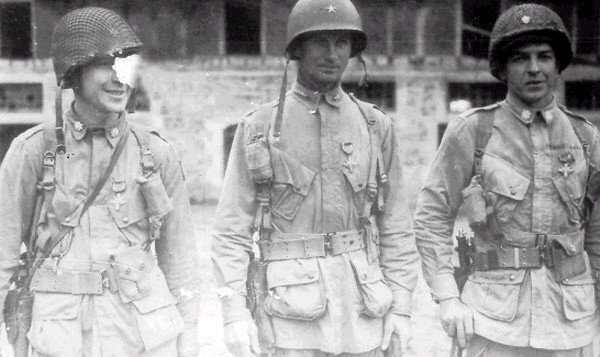
I speak of these battalion commanders because it is impossible to appreciate the caliber of the fighting done by airborne troops without knowing the caliber of the leadership they were given by their battalion, company and platoon leaders. It is taken for granted in airborne troops that each trooper is a potential leader himself. Every trooper does carry a baton in his knapsack. But more than this, he needs and expects exemplary personal leadership from his immediate superiors.
Except for approximately fifty plane loads, the parachute force of the 82nd Airborne Division was landed in an area about five by seven miles with its center of impact roughly at La Fiere. The night glider landings were badly scattered. Almost half of them failed to reach the Merderet River. Towing gliders in formation on three hundred feet, of rope, through dense fog and enemy flak and at night is something truly out of this world.
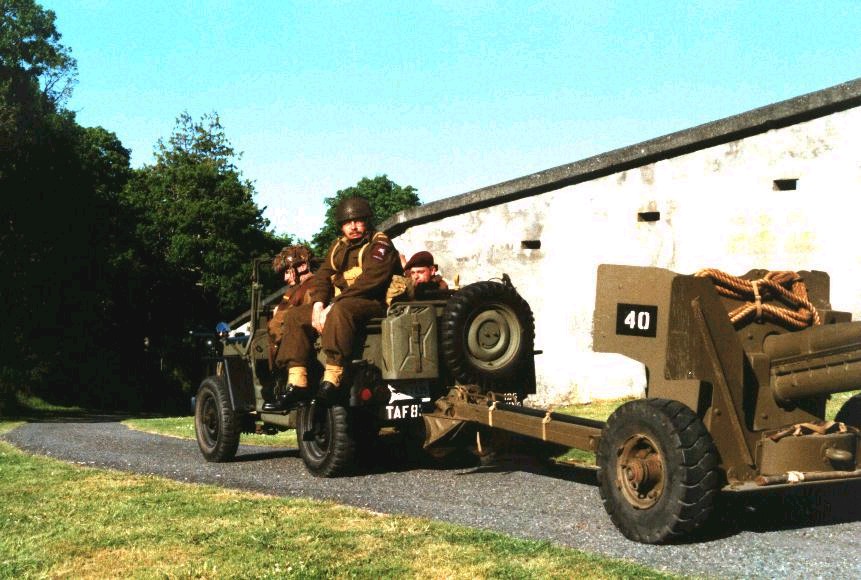
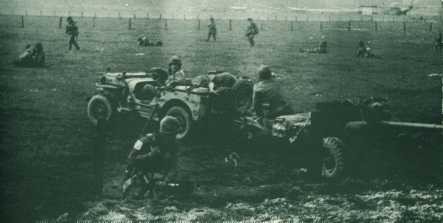
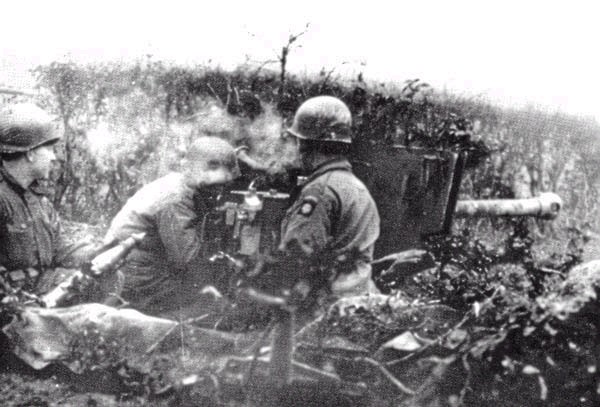
57mm "6-pounder" antitank gun towed by all-wheel drive (4x4) jeep
Six 57mm antitank guns were recovered from this glider serial and were in position fighting about Ste. Mere Eglise by the evening of D-Day. The D-Day and D-Day plus 1 glider landings were very successful. By then the Division was in reasonably good shape, holding a 12-mile airhead centered about Ste. Mere Eglise at dark on D plus 1. A planned resupply mission was flown on the morning of D plus 1, and although the troop carrier formations took much punishment, they delivered their loads. This job was, I believe, decisive in enabling the 82nd Airborne Division to hold
Page 61
its airhead until it could make contact with the amphibious landing force. This ended the purely airborne phase of the operations of the. 82nd Airborne Division. The Division continued in a ground role; it attacked to the west and captured St.-Sauveur-Ie-Vicomte, and then it drove south to the outskirts of La Haye du Puits where it was relieved on July 8. The 82nd had fought for thirty-three days in continuous action, without relief and without replacements. It accomplished every one of its missions. And no ground that it gained was ever relinquished. Its fighting had been severe; fifty-seven per cent of its infantry were listed as casualties and approximately eighteen per cent of its other troops.
OPERATIONS OF THE 101st AIRBORNE DIVISION
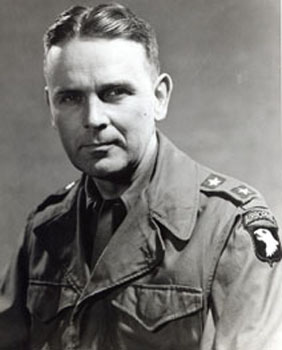
The 101st Airborne Division, commanded by Major General Maxwell Taylor, experienced flight conditions identically the
Page 62
same as those the 82nd went through. Of its 432 parachute aircraft, or 6, 500 troopers, dropped during the darkness early on D-Day, the 101st had approximately 1,100 on or near its Division objectives by H-hour. These arrived there by improvisation of both units and leadership. By midnight of D-Day this force had increased to about 2,500. Despite these initial handicaps the 101st also accomplished all of its missions. Early on D-Day it made contact with the 4th Infantry Division of the amphibious landing forces. The 101st Division then turned south, and in a gallant attack overran the German 6th Parachute Regiment and captured Carentan in a three-day fight making possible the junction of the U.S. V and VII Corps.
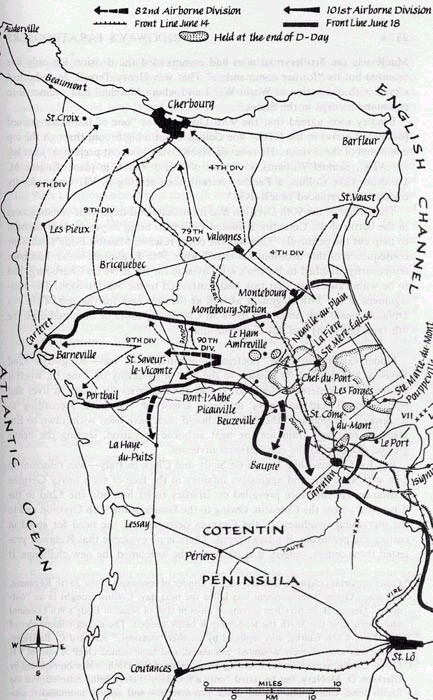
OPERATIONS OF THE BRITISH 6TH AIRBORNE DIVISION
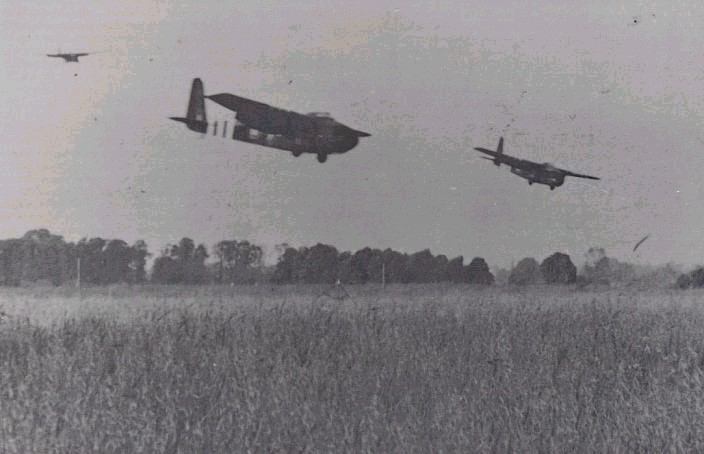
British Hamilcar heavy gliders landing Tetrarch light tanks into Landing Zone "N"
Farther east, the British 6th Division, commanded by Major General Gale, carried out its operations much more in accordance with plan (see Map 10). Following in the wake of its pathfinders, which touched down between 0010 and 0020 of D-Day, a force of six platoons of infantry, reinforced by engineers, landed by glider and captured the bridges over the Caen Canal and the River Orne.
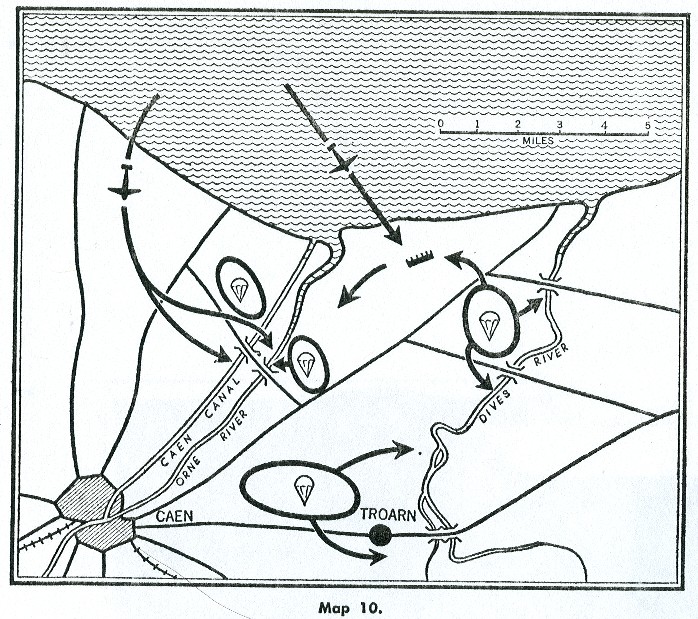
Map 10.
The approach technique of this flight was unusual. Right after taking off they started to climb so that when they reached the coast of France they were between five and six thousand feet. The gliders were released the moment they crossed the coast and then started in a glide for their objectives. This was done, so the official after-action report states, "so that they would arrive at the bridges alone and unheralded, like thieves in the night." This technique was preeminently successful and both bridges were captured intact.
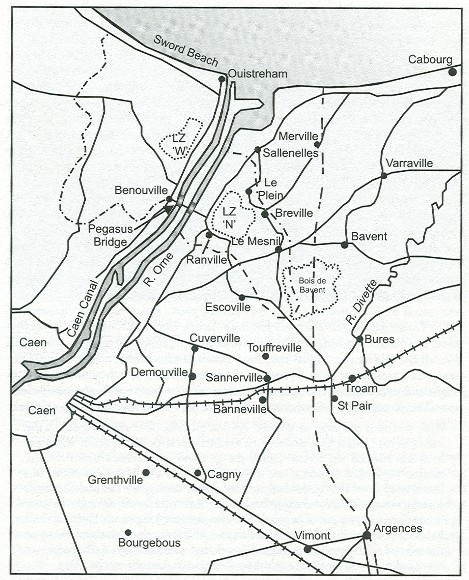
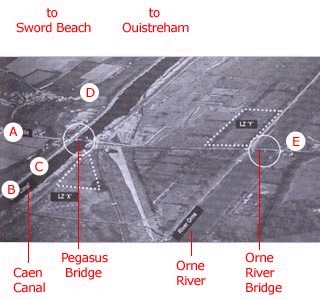
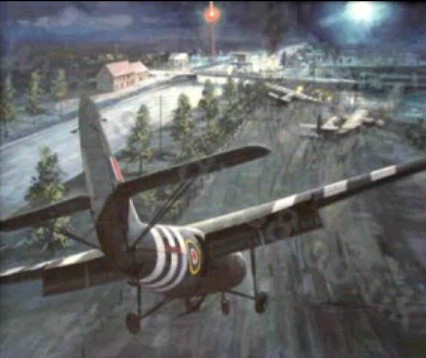
VIDEO: D-Day Secrets
Part 5: Hobart's Funnies, Pegasus bridge stand-off glider assault
 www.youtube.com/watch?v=uPHWero8ueE&NR=1
www.youtube.com/watch?v=uPHWero8ueE&NR=1
Part 6: Soft blue clay spurs creation of "BOBBIN" mat-laying tank, Pegasus bridge pilots recount their assault
 www.youtube.com/watch?v=hdBt2SvHHGk
www.youtube.com/watch?v=hdBt2SvHHGk
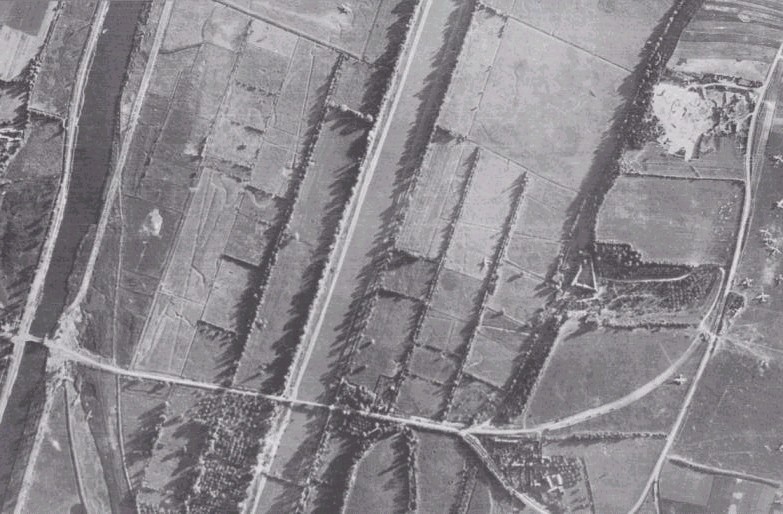
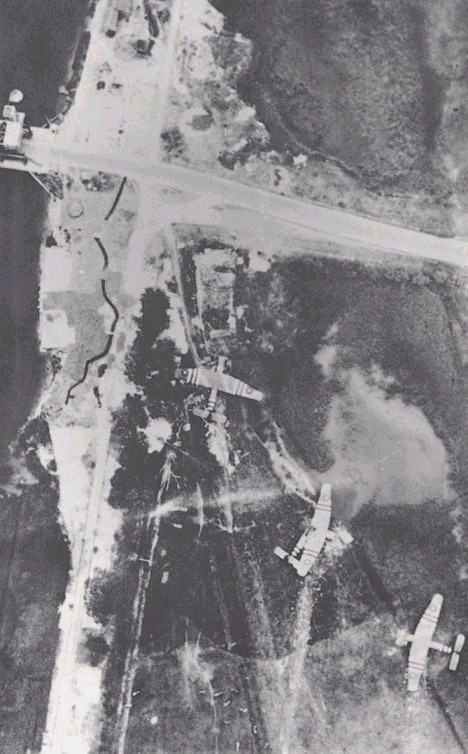
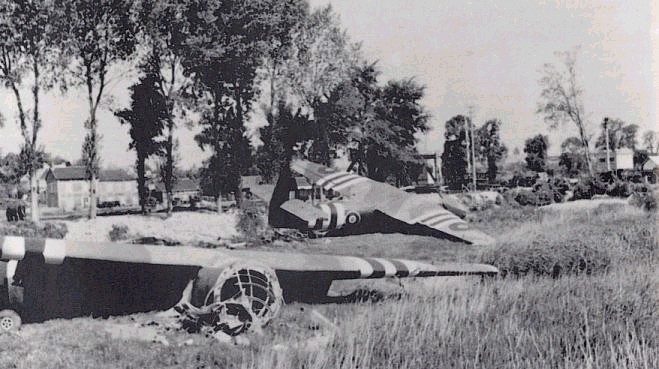
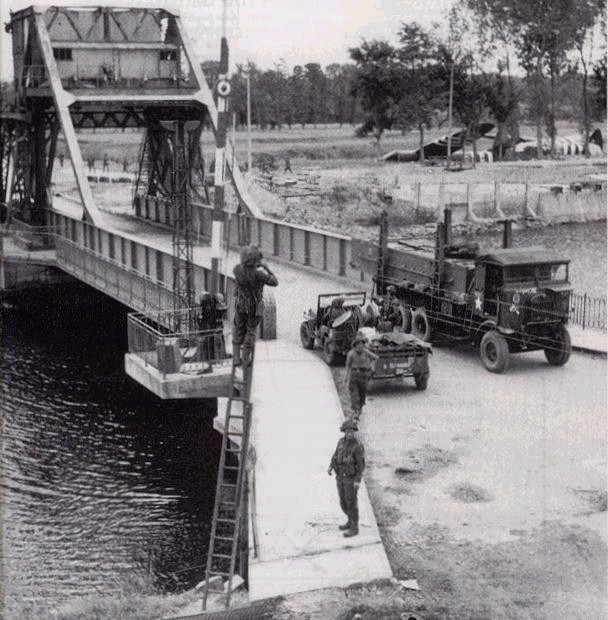
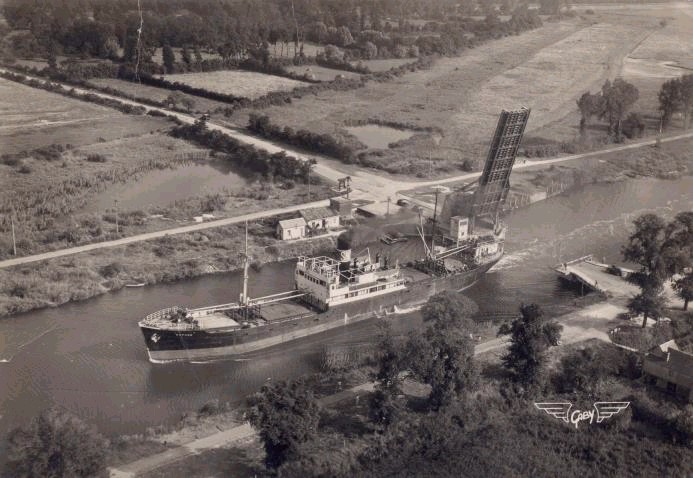
Hamilcar heavy gliders landed 20 x Tetrarch 8-ton light tanks and many Bren gun 3-ton light infantry personnel carriers of the 6th Airborne Recce Squadron on D-Day as Gavin proposes the U.S. Airborne should do later in this and his other books and magazine articles to create a "Sky Cavalry"
AIRBORNE ARMOUR: Tetrarch, Locust, Hamilcar and the 6th Airborne Armoured Reconnaissance Regiment 1938-50 (Hardcover)
by Keith Flint
Book Description
Despite all the works on airborne forces published since 1945, the full story of Britain's "airborne armour" has remained untold. This book is intended to correct that omission. The story has two main strands - the project to fly tanks onto the battlefield to support airborne forces, and the history of the unit which operated those tanks and supported 6th Airborne Division in the ground role - the 6th Airborne Armoured Reconnaissance Regiment. The book is the result of considerable original research and contact with surviving members of 6th AARR. It contains the full development background of both airborne tanks, the British Tetrarch and American Locust, and also that of the Hamilcar glider. It examines rival or complimentary projects, in particular the German Me-321 Gigant glider, and analyses the extent to which the British airborne armour project was a success. The history of 6th AARR is traced back to the little known Special Service Squadrons of the RAC which were pioneers of armoured amphibious assault, and who saw action in the invasion of Madagascar in 1942. One of these squadrons became the Airborne Light Tank Squadron, which grew into the Airborne Armoured Reconnaissance Regiment in time for D-Day. This unit flew 20 Tetrarch tanks into battle on the evening of D-Day in the first ever assault landing of tanks from the air, and did the same 10 months later when 8 Locust tanks were landed as part of the massive Rhine crossing operation. 6th AARR also had a proud history in ground combat in Normandy, the Ardennes, and Germany, often forming the spearhead for the advance of 6th Airborne Division. The unit has a fair claim to be the "forgotten regiment" of British Airborne forces, a fate which this book aims to put right. Airborne Armour describes and analyses a unique unit of the British army and some unique military operations.
|
Product Details
|
Airborne Armour is a must-have book for understanding Airborne 3D maneuver operations, period. Flint is a superb researcher and writer and this book is a masterpiece.
However, Keith Flint is also at times the typical whiny, turret tank dueler where every tracked tank is never good enough; who jumps around from complaint-to-complaint and comparison-to-comparison without any sound basis of basic land war understanding as a framework. Perhaps he has no direct military experience and is stuck with just war gamer's ratios, or he is a former tanker who has the stereotypical, knee-jerk prejudice against 2-man turrets where there is no loader and the already busy Commander or Gunner have to do it. The Russian T-34 medium tank had this overworked relationship and most tank gurus rate it as the best turreted tank of WW2; some of all time. If you want that "human-powered" gun loader and are limited in weight to work with, do without the turret and go with a powerful cannon in the hull, which is the highly successful German Sturmgeschutze (STUG) assault gun arrangement. What Flint fundamentally fails to realize is that if you take away the tanks he doesn't like, it leaves your fleshy men's bodies vulnerable to EVERY threat the enemy throws at them with the potential of WW1 level of casualties and at best a foot-slog or very likely pinned down and bleeding all around. His accounts of the 6th Recce Squadron's using these light tanks in Normandy and the far bank of the Rhine verifies their successful contributions in the "female" machine gun tank function. The "male" tank function is to blast bunkers and enemy tanks-but if a tank cannot kill other tanks, Flint has no use for it, which is a narrow view since a tank limited to infantry fire support is better than no tanks at all--look at American casualties on D-Day where Percy Hobart's "funnies" were not there in force to help.
When the British Hamilcar glider-land "imperfect" Tetrarch 40mm gun and Locust 37mm gun turreted light tanks and open-top Bren gun infantry carriers onto Normandy on D-Day and across the Rhine for Operation VARSITY in 1945, they WIN because imperfect light tanks that can move in the face of enemy bullets and mow them down with machine guns beats having your own men being mowed down without them. As a non-Soldier, Flint sometimes doesn't know the significance of what he writes, but thank goodness for what he has written! When the Germans saw gliders delivering tanks on D-Day, their commander realized they could be cut off if they over extended themselves in counterattack and withdrew. That right there validated all the effort to get the imperfect light tanks to the scene because this was the decision that won the battle since with every passing day the Allies would grow stronger with new forces arriving. For men facing imminent death, the moral is to the physical as 3 is to 1; by being on the defensive, the British 6th Airborne had another physical 3-to-1 advantage for a total overmatch of 6-to-1. Flint doesn't get it that light tanks where they are needed now are worth more than heavier tanks too late. What German tanks and infantry that did show up in weak counter-attacks were detected first by 6th Airborne Recce units on mobile patrols and taken out by air strikes, naval guns, the Tetrarch's own machine guns and cannon or if they reached the defensive line, their 6-pounder and 17-pounder antitank guns sitting and waiting. Not knowing this, fixated on only the obvious, the British Airborne's commanders make a fatal error of drawing the wrong lesson from their D-Day DEFENSIVE battle and placing delivery of towed 17-pounder anti-tank guns which cannot fire while moving higher in priority than their light tanks which can---vital for the fluid situation in the up-coming OFFENSIVE mission to take the bridge across the Rhine river at Arnhem.
When the British command does not loan the 1st Airborne's Freddy Gough the 6th Airborne's Tetrarch light tanks not being used, as he requested (his reputation is now vindicated, by the way) for Operation Market-Garden in Holland, they LOSE. Gough's unarmored wheeled machine gun jeeps towing 20mm anti-aircraft cannon don't make it to Arnhem bridge to reinforce LTC Frost, who then can't hold out long enough for the XXX Corps land advance to reach them and the Germans win the battle---preventing us from crossing the Rhine river in 1944 and ending the war sooner than it did. Flint with his detailed and pioneering research does show that 18 Bren gun carriers were glider-landing at Arnhem to carry SUPPLIES for the infantry battalion's 8 mile foot-march to Arnhem bridge but none of them had a German STUG-style fixed high explosive cannon to blast through the German armored cars and men with rifles blocking them. He reveals that the Alecto I 95mm assault gun based on a successor chassis to the Tetrarch was developed but not fielded in time before WW2 ended. Flint doesn't mention that several Bren gun chassis with even 25-pounder guns were prototyped during WW2 and could have been there to blast through "Tiger Route" opposition to Arnhem bridge. He does conclude that Tetrarch turreted light tanks should have been brought to the fight and would have greatly helped. Its good to hear a historian take a damn stand on the past so we can learn something from it, and not just wail and make excuses.
Another excellent point Flint shows is that a male "tank" with a gun big enough to destroy even heavy German Tiger tanks within the size and weight constraints of the Hamilcar or a larger glider like the German Me-321---was possible in WW2---the British just didn't do it. Flint ever the conventional male tank enthusiast, notes a 75mm gun-equipped Mark IV medium tank with 80mm thick armor protection was transportable by a Me-321 glider.
 www.youtube.com/watch?v=Z9FUAeRRpUg
www.youtube.com/watch?v=Z9FUAeRRpUg
Flint wants his 360 degree spinning turret with a big gun and thick armor protection to keep enemy big gun shells out, so to have his cake and eat it, too he wants a bigger transport plane. Do-able, look at today's C-17 Globemaster III turbofan transports that can lift 70-ton M1 Abrams tanks---if you have 3, 000 feet of smooth ground to land on. If you want to surprise the enemy by landing at unexpected places and swarm him with greater numbers to get decisive victories, then you need lighter tanks. Having a turret limits the space you have for a gun or a loader and adds weight you can do without when being light enough for WW2 piston-engined Airborne transport, and Flint shows how the American M22 Locust light tank had to have its turret removed to attach directly to the piston-powered 4-engine C-54 transport plane of that time.
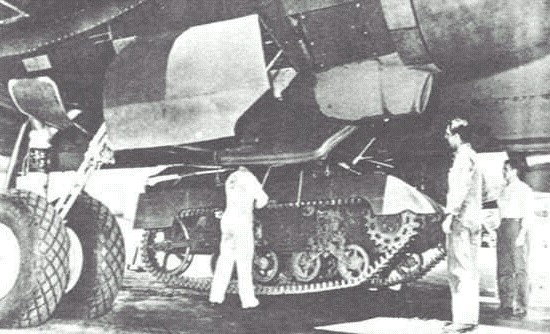
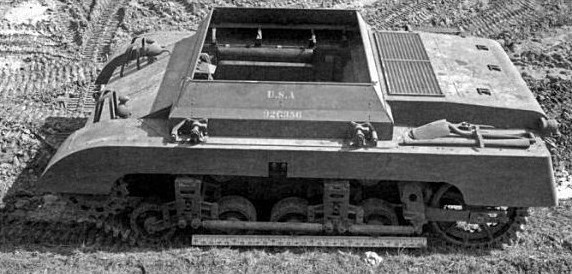
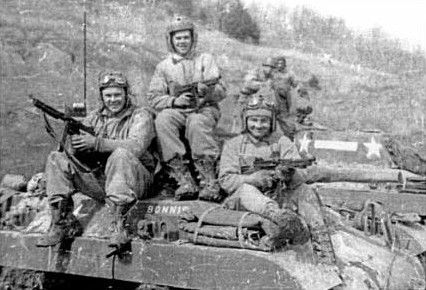
The ill-fated U.S. 28th Airborne Tank Battalion in WW2 did not see any combat due to our rejection of the British offer of Hamilcar gliders and failure to supply C-54s for delivering their turreted and turret-less M22 Locust light tanks.
Flint describes that upon landing, the pilot could drop the chassis 14 inches to the ground and the Driver could hop in and take it back to the tail and the turret could be lowered into position by untrained men in under 10 minutes!
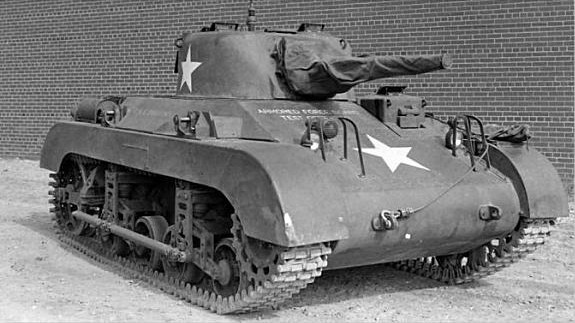
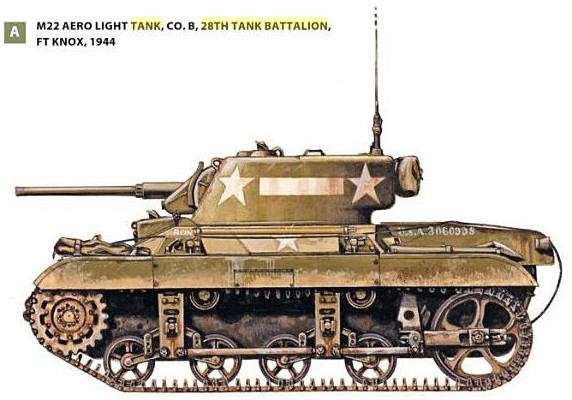
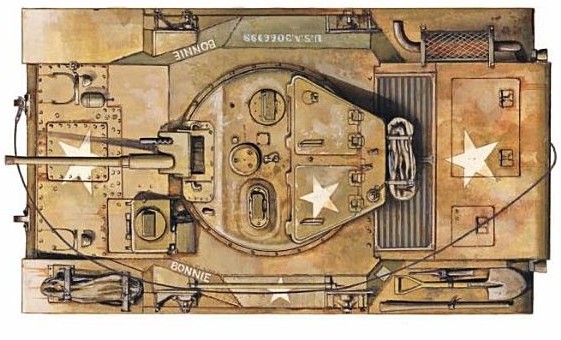
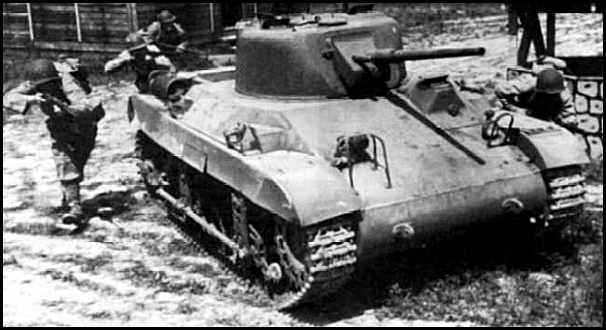
The advent of the "Flying Box Car" and "T-Tail" type transports enabled light tanks to be parachute-dropped and airlanded by Airborne forces.
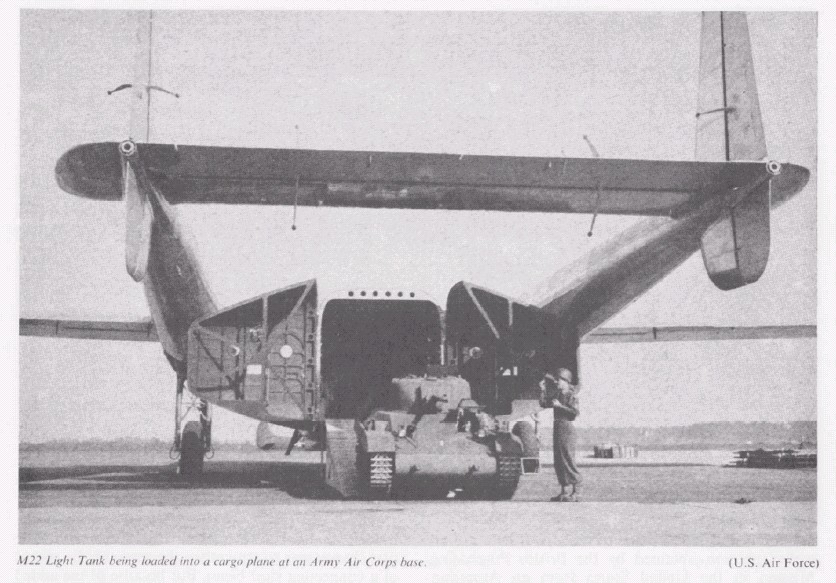
In 1961, the U.S. ill-lead Cuban 2506 Assault Brigade amphibious landings could have benefited greatly by seizing the Giron airfield immediately by Paratroopers and airlanding M22 Locust light tanks to break-out into the Escambray mountains to wage mobile warfare. For details:
Flint also sheds new light on the C-74 Globemaster I that its ingenious bomb bay floor could raise and lower an intact M22 Locust light tank in 1945.
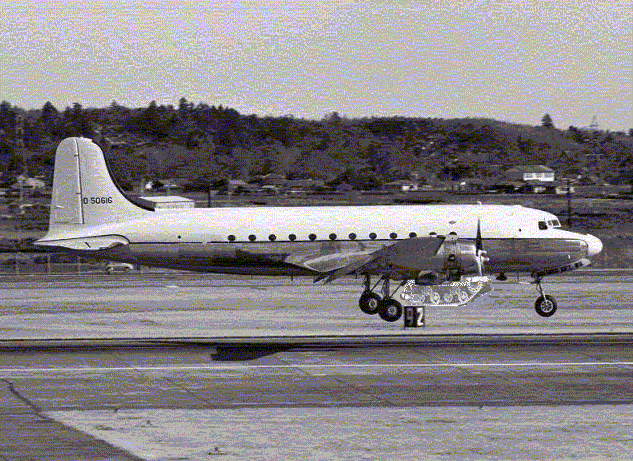
However, the American concept of C-74 or C-54/Locust requires a smooth RUNWAY to pre-exist and Flint duly notes this is a tactical planning handicap the glider that essentially CRASH LANDS onto any open area that is flat--doesn't have. He expertly describes how to crash land, a glider on skids can accommodate uneven, unprepared terrain best. However, with the excellent Hamilcar heavy glider, experienced pilots kept its wheels on so they could steer with braking and avoid obstacles like other gliders during the crash land. Two Hamilcars at Arnhem have their wheels stick into the soft ground causing them to roll-over killing 3 men, so the ideal cow pasture glider/airplane should have skids with small wheels not likely to stick in back for ground steering. Flint doesn't connect-the-dots that after WW2 regulars in an air force are not going to want to crash-land in ANY aircraft and the glider land-anywhere capability was lost not because it was "obsolete" which is the author's favorite word to dismiss something he doesn't like.
Something Flint does like--and justly so--is the awesome Hamilcar glider. Its two pilots sat tandem like in a fighter plane on top of their armored loads protecting them from enemy anti-aircraft explosions. Vents took exhaust gases out so the tanks inside could be started up for a quick drive-off upon landing. The shock absorbers could be lowered quickly upon landing to get a good angle for the tracks to drive out.
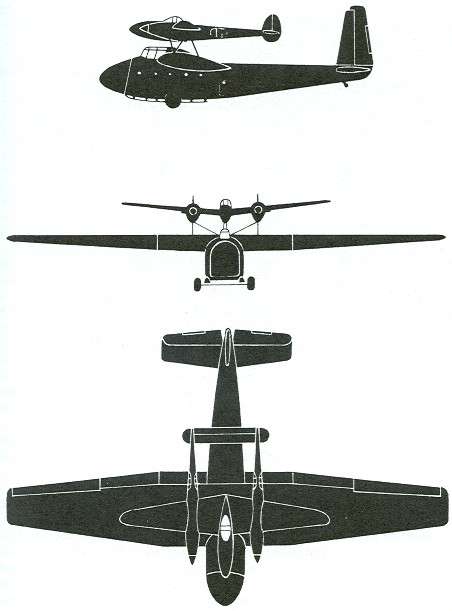
Very smart, but Flint reveals some more stunning facts about this great assault cargo glider---an U.S. Army Air Force (USAAF) officer saw a German Me-109 on top of a small German assault glider and proposed we put a P-38 Lightning twin-engined fighter on top of the Hamilcar. An American C-54 or B-17 or B-24 4-engined plane tows the Hamilcar/Lightning into the air, then disconnects and flies back to base for another glider combo to take-off. From that point on the P-38's engines would keep the Hamilcar glider aloft all the way to the target since the power to take-off is drastically more than what's required to stay aloft! Physicists point out the same is true with our cars, you don't need 200 hp once you get to 60 mph, only a fraction of this power so driving around with a bug engine is inefficient. It gets better. Once over the target area, the P-38 pilot releases the Hamilcar to land with its light tank and troopers and the fighter-bomber is now free to strafe the ground of enemy ack-ack guns, troops, tanks, trucks etc. or shoot down enemy fighters! Such an arrangement would free up our glider tow planes and get ALL OF THE HAMILCARS WORKING DELIVERING COMBAT POWER TO HOLLAND would have worked wonders during Operation Market-Garden where German mortars needed continual silencing by fighter-bombers to relieve pressure on LTC Frost's men at Arnhem bridge. General Gavin says the lack of en masse airlift is what doomed Market-Garden.
This realization that the power to fly once take-off was achieved resulted in the Hamilcar X fitted with two engines from "obsolete" aircraft of its own. When fitted with the most powerful engines available the Hamilcar COULD FLY ITSELF ALL THE WAY TO THE OBJECTIVE WITH ITS FULL LOAD OF LIGHT TANK(S). Now this is a class/type of assault transport WE DO NOT FULL UNDERSTAND even today. This is a POWERED CRASHLANDING GLIDER. This is a minimalist aircraft that if it breaks up in a rough landing, OK. We can accept this because we want to land where the enemy is not expecting us. We are not putting millions of dollars into it, its made of wood. This is NOT the C-130s we have today that are not only heavier and cannot crash-land but need runways, handicapping us with having to seize an airfield or stretch of road.
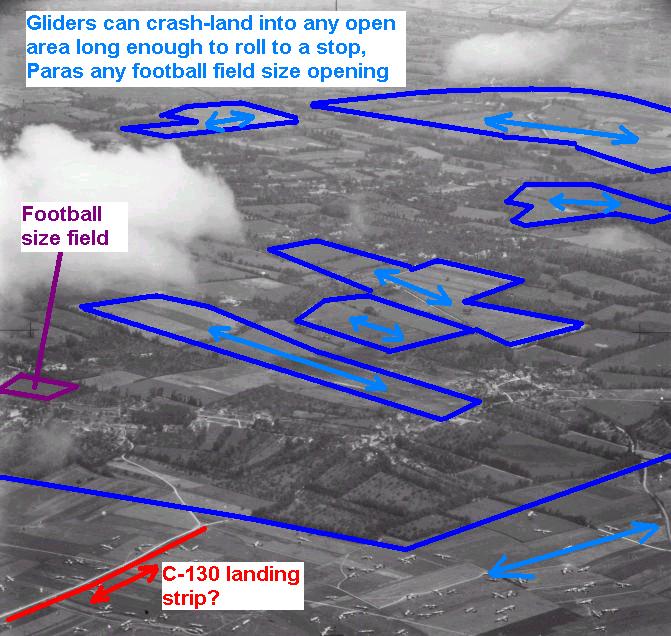
The BATTLEBOXattackgliderTM
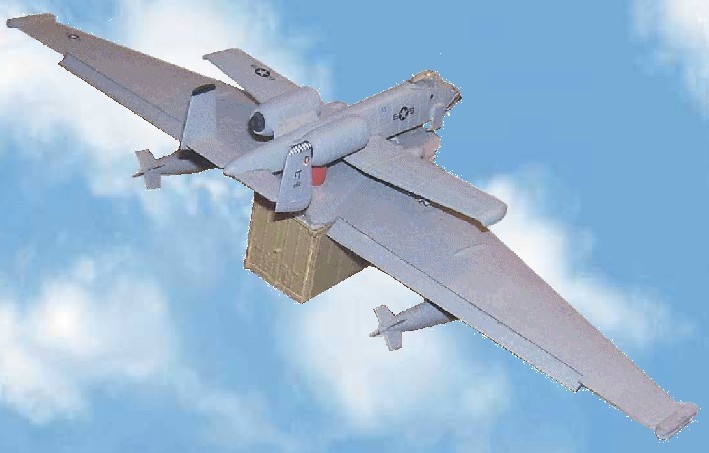
POWER POINT PRESENTATION
Some traditionalists may cite that the current Airborne Operation which is derived from post-WW2 decisions to stop crash-landing fixed-wing gliders and to parachute airdrop everything from t-tail, rear ramp STOL aircraft as "AOK" and there is no need to drastically improve anything. This is a recipe of complacency sure to deliver us a feast of disaster--or worse irrelevancy of disuse since cleaning up all those parachutes is costly and time-consuming and the lazy would rather ride in noisy helicopters and land with the enemy long gone or get creamed in fuel-packed, contraptions packed full of men like sardines. The potential disaster lies in exposing USAF fixed-wing delivery aircraft to fly overhead drop zones and to release parachutes at low altitudes where AAA gun and missile fire abound. While we can and should field Russian-style, drogue-chute activated parachutes to enable high altitude, delayed opening to stay above AAA fires, the creation of a horizontal stand-off using a ram-air, forward thrust parachute to deliver large loads like a high technology M113 Gavin light tracked tank is dangerous and scares the shiite out of today's uninspired Paratroopers who want to cling to the aprons of their Airborne mothers. Large, ram-air parachutes can be deployed in the air after release but if they should fail lives would be lost if bail-outs can't be effected casting doubt on the whole glider stealth assault concept needlessly just because we have self-limited ourselves to trying to pop out glider wings from the post-WW2 Airborne rear ramp equipped aircraft. Moreover, the best glide ratios we could achieve from a parachute glider wing is 10-to-1; which is far less than what an already built fixed structure glider can attain.
Much has been lost by our decision to not employ gliders emanating from the Chase CG-20 rear ramp glider being fitted with engines and becoming a re-usable STOL transport; as the C-123 Provider; which then needed 2, 000 feet of flat runway to land--thusly, we lost in the process the WW2 glider ability to crash-land heavy equipment and intact small units onto any relatively flat open area. The USAF pampers its aircraft let alone allows them to be crash-landed onto unimproved ground--which the Army needs to deploy into to achieve strategic, operational and tactical surprise against alert enemies who are keen to defend existing runways and airfields with such flat surfaces. Yes, we can and we should field air-cushion landing systems (ACLSs) to our C-17s, C-130s and C-27s to open up many new areas to airlanding beyond pre-existing runways. However, these will have to be areas that are safe or made safe first of the enemy; so we still need an ASSAULT crash-land capability that can by stealth take over the first ground for the follow-on Airborne echelons.
Of course you will see we are building a case for the return of the glider and we are sure the whole WW2 tow-rope snapping, "ooops! this-isn't-where-we-wanted to-land" cliches' are likely to pop into your mind's eye if you have studied WW2 glider operations. You should already answer these objections if your mind is open and aware of common high technologies like kevlar and GPS and night vision aids. However, we are proposing something even better than the WW2 tow planes-dragging-a-glider-behind-it paradigm. The crafty and thrifty British in WW2 when actually glider landing light tanks by large Hamilcar gliders realized that IT TAKES FAR MORE POWER TO GET A GLIDER IN THE AIR FROM A STANDSTILL THAN IT TAKES TO KEEP IT IN THE AIR ONCE ITS AIRBORNE. They proposed that a twin-engined P-38 Lightning fighter-bomber be attached to the TOP of a Hamilcar glider holding a light tank and after towed by an obsolete bomber into the air, it would release its rope and FLY ITSELF TO THE OBJECTIVE AREA using the fighter-bomber's engine power. Then, near the target area the glider could be released from either a high stealthy stand-off or close-in at lower altitudes--with the P-38 then able to fly ahead and gun strafe and bomb any enemies on the ground or even shoot down any enemy fighters that may threaten. This eliminates the whole tow plane non-sense to just at the departure airfield to get the combination aloft; the tow planes can land right away and launch more attack glider combos so fewer numbers are needed. If you are really bold, the tow plane can be eliminated entirely if JATO rockets are used to blast the "Attack-Glider" into the air.
Why Attack-Gliders Today?
Now Luddites might again whine that we don't need Attack-Gliders because with air-to-air refueling we can extend the range of our current fighter-bombers indefinitely yadda yadda...This is true--MAYBE. The fact is we don't have enough tankers and are desperately trying to convert French airliners into tankers just to keep our air superiority F-22s and F-15s in the air. The sad truth is like in WW2, transporting the Army is always a low priority with the fighter jock USAF that wants to win wars all by themselves using firepower not ground maneuver. Transports will be left on their own like the C-141Bs that were bounced by Cuban MIGs en route to Panama in 1989. Fortunately Castro decided to mind-his-own-business and no men were lost--but that our transport planes were sent on defense-less was immoral and incompetent and all should be armed at least with self-defense air-to-air missiles if the fighter jocks are too busy trying to Warden-style strategic bomb with their lawn darts to provide fighter escort. LTG Gavin created the night parachute jump because he knew the fighter jocks were unwilling and/or unable to provide necessary fighter escort. The Army is not alone in the neglect; the USAF doesn't want to escort its own lower-life-form bomber pilots, either. To try to insure bombers get fighter escort they created a FICON parasite fighter concept where a bomber carried a F-84 (why not a more capable and smaller F-86?) under its belly but this concept was not refined and perfected so bomber pilots are often now on their own relying on a fragile stealth advantage if they are B-2s; the F-117s have already been retired.
However, by mating a fighter-bomber or say an A-10 observation/attack plane to a glider, a positive parasitic effect can be attained exploiting the glider's WINGS to carry enormous amounts of fuel; the power of the plane on top helps get the glider to the objective area and at the same time it provides fuel for the engines to create the necessary power. The attack glider's wings have now eliminated the need for fragile, vulnerable civilian airliner tankers doing an aerial ballet to transfer fuel and insured that fighting aircraft are embedded with the airborne force for self-protection against MIGs and provide fire support against enemies on the ground.
Creating an Attack-Glider Today: Start with a Box
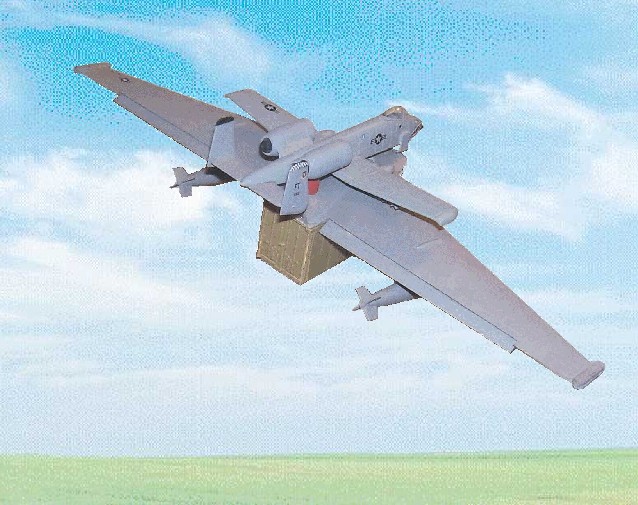
The entire world moves by ISO shipping containers; even the U.S. military--it just hasn't realized how to fully exploit these sturdy metal containers into full combat advantage as BATTLEBOXes--yet. The Attack-Glider would begin as a kit to attach large wet wings to a standard 20-foot shipping container and either small bogie wheels or an ACLS to roll for take-offs and crash-landings. A detachable pedestal mount or mounts on top would mate a twin-engined USAF fighter-bomber like a soon-to-be-retired F-15 Eagle or a F-22 Lightning II or an up-engined A-10 Warthog to power the Attack-Glider. To tow the BATTLEBOXattackgliderTM into the air would be a surplus old 747 too fuel-hungry for efficient daily airline use and eventually with R&D JATO rockets.

A small squadron of 12 old 747s could easily launch with an hour a hundred BATTLEBOXattackglidersTM using multiple runways. Once airborne, the BATTLEBOXattackgliderTM could circle until others are launched to create a formation if anything more than a single-ship, special operation is required.
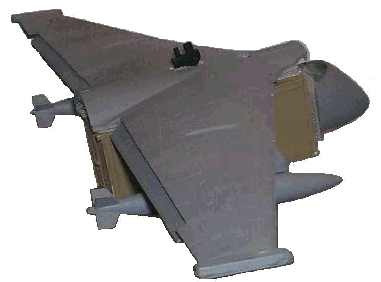
Then either a high or low-altitude release could be effected with the attack plane engaging the enemy or being on-call until fuel runs low and they have to fly back to a friendly base.
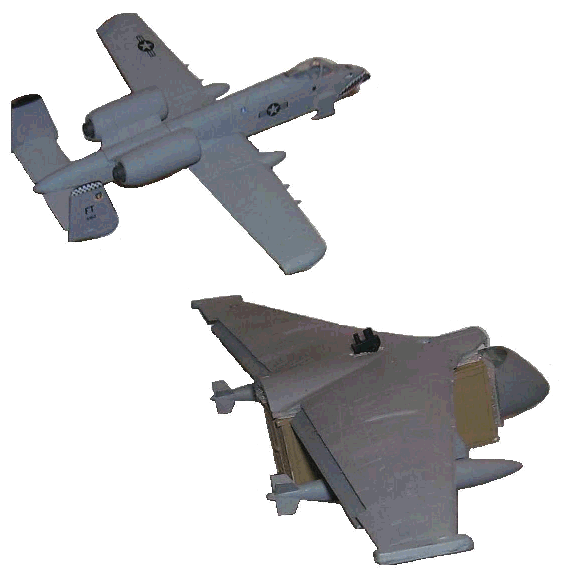
The BATTLEBOXattackglidersTM crash-land and out comes intact Airborne infantry squads each with a high-technology M113 Gavin light tank with 30mm autocannon, band tracks and electric drives to fan out and secure the assault landing zone for follow-on echelons of Paratroopers.
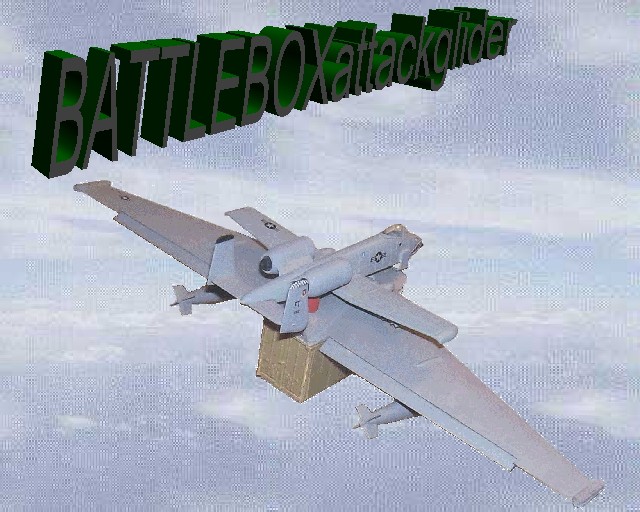
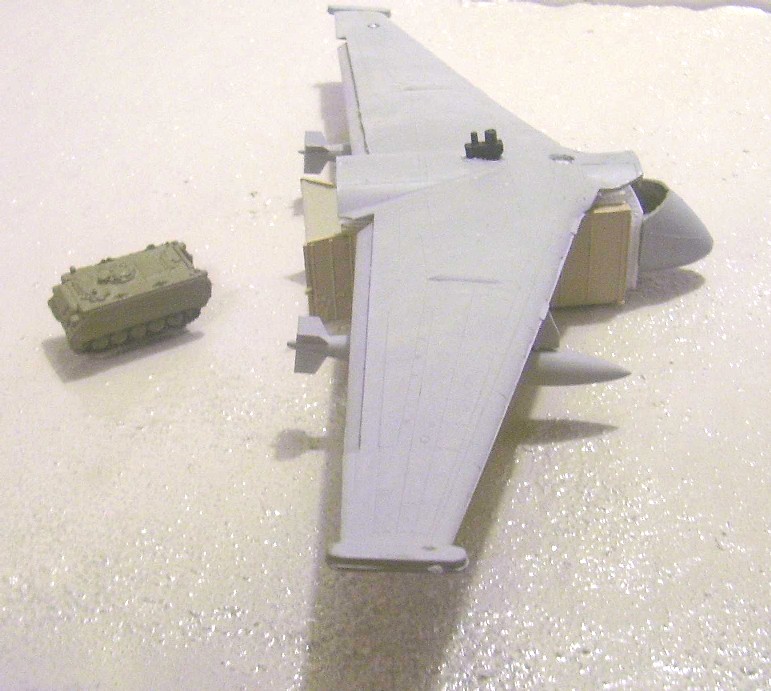
Those who fear their penis sizes will diminish if they train to land by glider will still remain as full-fledged Paratroopers because they will need to stay current with parachuting in case they have to bail-out from a stricken BATTLEBOXattackgliderTM that cannot finish its mission by crash-landing at the designated location.
If its a large Airborne Operation, the A-10 Warthogs could loiter overhead as on-call close/maneuver air support (C/MAS) assets and then use its STOL capabilities to airland on the airhead at a FAARP site which could simply by a BATTLEBOX which dispatches a M113 Gavin with a bulldozer blade to flatten out a landing strip and spray Rhino Snot soil sealant behind it. Once the A-10s are on the ground in the airhead, they can be refueled and rearmed by BATTLEBOXes containing fuel bladders with pumping hoses and those with 30mm cannon shell belts, 2.75" Hydra 70mm rockets etc.
BATTLEBOXattackgliderTMin the Context of Gavin's KIWI Pods
The BATTLEBOXattackgliderTM in concert with aircraft that can drop-off BATTLEBOXes like the proposed C-17 SkyCrane would fulfill LTG Gavin's vision of a KIWI pod Airborne Army that is always loaded and ready-to-fight. This would strengthen the Army-Air Force team so both would require eachother to do 3D maneuver warfare and guarantee large shares of the DoD budget.
Its also conceivable that the BATTLEBOXattackgliderTM system could be used by the USAF to self-deploy its short-ranged fighter-bombers to long ranges without need of mid-air refuel tankers and then upon releasing the glider-winged-BATTLEBOX have them fly by a pilot or unmanned guidance system to a collection point for recovery to conserve the taxpayer's monies. In essence, the BATTLEBOXattackgliderTM would be a winged, reusable "drop tank" for USAF fighter-bomber missions. So the USAF may not care enough about helping the Army out with the BATTLEBOXattackgliderTM system, they might be interested in it for their own Douhet agendas to make it a reality.
When Gavin is talking about a "cow pasture" powered plane he is talking about a plane that can CRASH LAND either on skis, skid-wheels or tracks or simply drops a KIWI pod that does the skidding to a halt. Yes, if the powered Hamilcar isn't wrecked it could take-off again and fly back to base, but when the pampered, doesn't-want-to-get-dirty U.S. Air Force heavyied up our own CG-20 glider to the point that it became a RUNWAY dependant airplane we lost the capability to land anywhere. Regulars in peacetime don't want to crash-land and pilots certainly don't want to be stranded and have to fight as ground troops if their powered glider can't take-off and get them back to base. What I'm saying is that the USAF's laziness and cowardice to not have to fight or get dirty has ruined our Airborne warfare capabilities because we now have to work around their planes that cannot and will not land anywhere. The USAF has also refused to field technologies that would enable extreme short take-off and landing (ESTOL) on their existing planes or to fund a vertical take-off and landing (VTOL) assault transport because it helps the Army win wars by maneuver and they want to try to win wars by themselves using Douhet bombing.
The U.S. Army Airborne should adopt a Land-with-Power concept of operation. We should parachute drop M113 Gavin light tanks to carry paratroopers and some with large cannon assault guns and others bulldozer blades and Rhino Snot soil sealant trailers from existing USAF C-130s and C-17s so they need not have to land and we need not have to seize a runway. We then build the runway ourselves just as we were going to do as Flint points out in Holland using British flown Hamilcars to carry our bulldozers and airfield combat engineers. This force in light tanks is Gavin's Sky Cavalry and Grange's Air-Mech-Strike Force that has armor protection, superior cross-country mobility, firepower and vital supplies to not just "seize and hold" but can go to where the enemy is and collapse him, an American blitzkrieg. In the meantime, we should press the USAF to field a C-17 derivative that can drop 10 ISO container BATTLEBOXes from a few feet over the ground without complicated parachutes in one pass or at higher altitudes glider pods for stand-off coup de main assaults and to create a VTOL assault transport that can deliver one M113 Gavin and a 9-man squad anywhere in the world while being invisible to radar. The American airhead becomes a fortified BATTLEBOX operating base, dispersed, hardened and with self-sufficient solar/wind staying power requiring minimal resupply sorties of fossil fuel and food since it can collect its own water and shoot the enemy's ammunition.
Some troubling questions are raised in the book, if 863 x M22 Locust tanks were built, why were they not used by our own American Airborne? The USAAF asked for 144 Hamilcars to deliver light tanks and settled on 50 for D-Day. When we couldn't even get 50 Hamilcars, the Americans just gave up. We know the Hamilcar heavy glider production was sluggish, but why wasn't American firms asked to build some? Even if Locusts were not used, the Hamilcars could have enabled jeeps and 57mm or 75mm towed guns to be carried together, since we had to have one CG-4A Waco carry the jeep and other the towed gun and hope to combine them on the ground under enemy fire. If jeeps were lost, guess what? you were pushing your gun! Studying Gavin's Airborne Warfare, "Cavalry and I Don't Mean Horses", and War and Peace in the Space Age, you discover General Ridgway had to scrounge from another American unit just to get towed 57mm anti-tank guns. It doesn't look like the American Airborne had the clout to get Tetrarches, mass-produced Brens and even on our own Locust light tanks---let alone Hamilcar heavy gliders. When two forces bump into each other in meeting engagement, the side that has to stop and unhitch a gun from a jeep loses against the side with a gun mounted on a vehicle ready-to-fire. How many G.I.s died because of this is a big question.
Flint's other conclusion that at war's end that the British turned against light tanks stems again from his whiny tank dueler bias and is factually incorrect; the highly cross-country mobile and easily air-transported by C-130 Hercules turboprop and CH-47 Chinook helicopter 8-ton Scorpion/Scimitar light recce tanks were fielded and are in use today to provide "Airborne Armor"---so the concept has been embraced not rejected by the British Army. Are we surprising enemies in Afghanistan/Iraq with the noisy approach of these motor-driven aircraft? No. Do we need to drop farther away and use stealthy electrical powered light tanks with band tracks? Yes. Do we still need a STUG assault gun on a M113 Gavin or a Scorpion/Scimitar or BV206-BV10S chassis? Sure do. That's where Flint's book shines because it lays out the raw facts that enables us today to ditch the bath water and take the infant Airborne Armor to adulthood as visionaries like Tuchayevsky, Simpkin, Gavin, Grange, Zumbro and Jarnot have been calling on us to do to have an effective 3D maneuver "Cavalry" for years.
KNOWLEDGE OF THE ENEMY'S ATTITUDE
Since there were more airborne operations in the offing, the
Page 63
survivors of this, the third airborne operation for the 82nd Airborne Division, were especially interested in the enemy's psychological and physical preparations to meet and cope with such attacks. If was becoming increasingly evident to all of us that both our chances of living and our technique of fighting were improving with our increasing knowledge of the German attitude toward airborne attacks, and of the means and methods the Germans were developing to frustrate them. With this in mind, the Division Commander, General Ridgway, directed the division G-2 on D plus 24 to make a thorough interrogation of all available German prisoners against whom we had fought. We were especially interested in what the German Soldier and small-unit commander thought about an airborne attack. How would he attempt to cope with it? Did he expect us in Normandy? What preparations were made, both by individual fighting men and units? And what, if anything, would they do if they had to defend against an airborne attack again?
Available for this questioning in the Normandy Peninsula Prisoner of War cages were a little over a thousand prisoners with whom the 82nd Division had been in contact in its airborne role in the early stages of the fighting.
In general, the German enlisted men had been well prepared mentally. They had received frequent lectures on airborne troops and their capabilities and limitations. They had felt confident they could handle them. In the first several days, whenever a German small-unit commander called for volunteers to patrol for parachutists believed to be in the vicinity there were always plenty of men ready to go. Field exercises were held in which one side took the place of airborne troops. A soldier of the 922nd Infantry Regiment of the 243rd German Infantry Division reported an interesting field exercise held in the vicinity of Ste. Mere Eglise, in which another regiment of his division, the 920th Infantry, assumed the role of a parachute force that had landed near by and expected to make ground contact with an amphibious force. Significantly enough, the airborne-amphibious team won the maneuver.
Page 64
Standard German anti-airborne measures included static posts at key points such as bridges, towns, road crossings. These were augmented by highly mobile patrols as soon as landings took place. On the night of the attack, the experience of the defenders was that when these patrols went out they became engaged all over the place because of the widespread landings. Higher German headquarters ordered troops to different points on the basis of information that reached them; and these, too, became engaged either en route to or at their objectives. Soon small units were fighting all around and in all directions. Unit commanders apparently lost control of everything except the troops right around their headquarters.
GERMAN TRAINING METHODS
The German training rehearsals had not contemplated this state of affairs, which came about from our unexpectedly widespread drops. Most unit commanders expected our airborne troops to land in groups at least of battalion-size. The actual situation proved very confusing, especially for unit commanders, who often made poor tactical decisions. The average enlisted man, however, was not particularly confused; and except for the, stories he had heard of the savagery of paratroopers and their refusal to take prisoners, he apparently didn't give a damn whether he was fighting paratroopers or other infantry. He was sure that his higher headquarters knew what it was doing.
This, unfortunately for him and fortunately for us, was far from the case. Typical was the reaction of Lieutenant General Falley, commanding general of the newly arrived German 91st Infantry Division. It was his division whose arrival caused the 82nd Airborne Division to move its landing areas farther east.
Upon arriving in the Peninsula, he established his headquarters in a chateau near Picauville. Shortly after our first parachute landings, he went out of his headquarters and started down the road toward Ste. Mere Eglise in his car. He was killed and his driver captured a few minutes later by a lieutenant of the 508th Parachute Infantry.
Page 65
The moral would seem to be, that in case of an airborne attack, the defending commander can do his job best by manning his command post where he can be found, instead of trying to influence the fighting by visiting his units. Of course, if his command post is attacked then he will probably have to pitch in with everyone else.
The German anti-airborne defensive plans called for the delivery of artillery fires on previously selected probable landing areas. All large suitable fields were noted, fire data figured and data all made ready at the gun positions when the landings took place. Unfortunately for them, and fortunately for us again, the anti-airborne patrols were moving all over without regard to the artillery plan so that the artillery couldn't safely fire. Captured artillery officers seemed rather upset and somewhat articulate in their displeasure over this-probably because they lost a number of batteries to the paratroopers without being able to fire a round.
It would certainly seem, however, that in an effective anti-airborne plan, the artillery and infantry should train together and coordinate their planned actions to meet a landing.
Some German prisoners said definitely that they knew the invasion would come about the time it did. These were very few, however. Night anti-airborne training exercises were a regular thing for all of the German troops inland. Some of them actually thought they were again alerted for a training exercise when our landings struck. The state of readiness our airborne forces encountered was plainly due to the thorough preparation and training given the defending troops.
In a number of instances, the defenders found themselves in a serious situation when they had to obtain ammunition from storage, or arms from locked places-or when anti-airborne patrols lost precious minutes getting their clothes on when landings took place nearby. .
Most of the prisoners of all grades felt that the problem of defending against an airborne attack, especially one of the magnitude they had just been through, was a. pretty hopeless one. A study and analysis of the operation and a careful evaluation of all
Page 66
the available facts tend to substantiate this view. An enemy who has the means to do the job can make an airborne landing anywhere within the range of his equipment, once he gets into the air.
To be stopped he must be destroyed before he becomes airborne.
Failing that, he will have to be engaged on the best terms possible on the home grounds. With the great advantage of initiative that is his, the vast choice of territory in which he can strike, and the great speed with which he can strike, he is not to be denied once he is aloft.
If he cannot be destroyed before he gets aloft, he can be deceived as to where the best places to strike would be. He can be misled into believing that it would be-unprofitable to land in areas where the defender does not want him to land. Or misled into landing in areas where prepared defenses and alerted troops will contain and destroy his assault echelons and ultimately neutralize his attack. These may be within the means of any defender.
AIRBORNE BATTLES OF THE FUTURE
I think that armies will never again fight in the close masses characteristic of World War II. There will be greater dispersion and airborne operations will be more commonplace. Although troops will be widespread, the use of aircraft in strategic and tactical troop-carrying roles will tend to compensate for this dispersion. Since surprise is the essence of airborne and anti-airborne warfare---for success both sides will endeavor to the utmost to attain it.
In engagements involving adversaries of comparable means, victory will go to the commander with the best-executed plan and cover plan. And although the attacker can rarely be denied some measure of success in landing, he can ultimately be destroyed if the defenders' means are properly disposed. Full use of static defensive measures, excellent communications, and better trained, equipped, and employed airborne forces for use in counterattacking roles, offer the greatest defensive promise at the present time.
Page 67
CHAPTER 4: Holland: Airborne Army's First Test
VIDEO: part 2: the 82nd Airborne in World War II: Holland to Berlin
The parachute and remaining glider elements of the 6th Division arrived as planned. By dark of D-Day, the Division had captured its objectives after severe and costly fighting. The Division stayed in line, fighting in a ground role, and it was in the van in the advance to the east after the breakout from the bridgehead, until it was relieved on August 26.
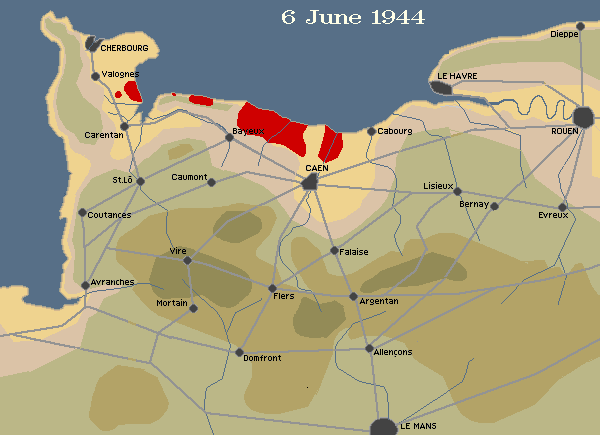
 www.youtube.com/watch?v=ekbYvtfPW0U
www.youtube.com/watch?v=ekbYvtfPW0U
CHALLENGING AND BREATH-TAKING in scope, the airborne operations of possible future wars will be like nothing previously experienced. Armies will take off, fly and land on distant objectives. There will be sudden attacks and complete and unexpected withdrawals. There will be rapid shifting of combatant masses by vastly improved airborne means.
Vital sources of strategic materials, essential military fabrication plants, and strategically valuable political areas-every such point and area can be expected to become immediately vulnerable and liable to airborne attack.
The present limitations upon obtaining current intelligence of the enemy make it probable that information of his defenses and dispositions for defense will be incomplete or even scanty. An enemy with whom we may come to close quarters In a matter of minutes may be several hundred miles away. Thus, once the attacker commits himself, he will always be, in a sense, leading with his chin. Mental courage, vision, and fortitude, are therefore bound to be essential attributes for commanders and staffs of the future. These, in my opinion are attributes that men of sound basic character and intelligence can acquire and cultivate, and we must cultivate for participation in airborne warfare. They cannot be developed except upon the primary basis of complete knowledge of the composition, capabilities, and potential of every troop carrier and airborne echelon.
There must also be a thorough knowledge of what has already been accomplished with airborne forces, and of all the World War II operations, that of Holland in September 1944 was outstanding in size, range, and complexity. It is unequalled as a study in airborne staff-planning, in the engagement of an airborne army and its corps, and in the independent tactical handling of isolated airborne divisions under many different but nevertheless typical conditions of airborne warfare.
The planning for the Holland operation deserves careful technical scrutiny. Flight routes, selection of landing and drop zones
Page 68
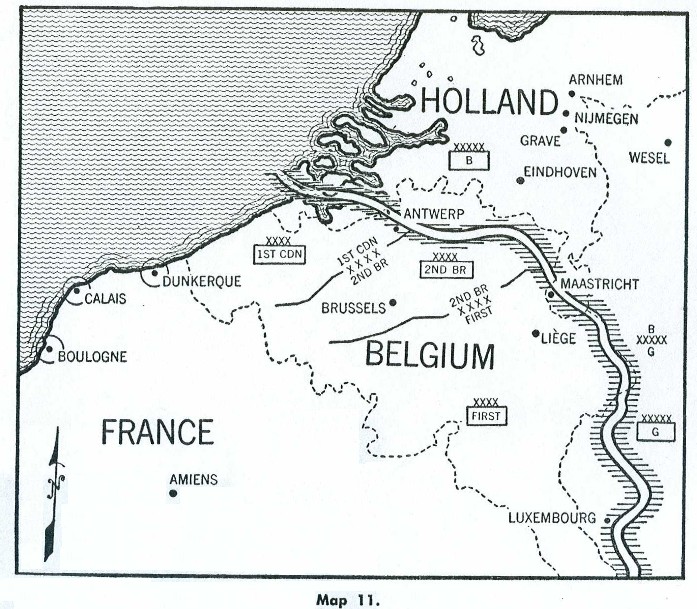
Map 11.
(especially in their relation to the terrain and objectives), air cooperation, air resupply, and tactics within an airborne divisional perimeter all require analysis and evaluation for the future.
Hopes for victory in Europe were high in the hearts and minds of the Allies in the late summer of 1944. The frantic retrograde movements of the units of the disintegrating German Army appeared to confirm earlier predictions by Allied leaders that 1944 would see the end of German resistance. There were few indeed who did not believe that in a few months the war in Europe would be over.
Despite this prevailing optimism and the great victories of the summer of 1944, the Allied armies were in a serious situation, especially as regards supply, by the early fall of that year. The German armies, although badly beaten and reeling back to the sanctuary of the Siegfried Line, still held all the major ports in the Netherlands and the lowlands of Belgium and France (see Map 11).
Page 69
The U.S. First Army, for example, which, by September 11 had broken into Germany, had consumed supplies at the rate of 5,752 tons daily during the month of August. The seaports serving the Allied armies were so far to the rear that the tenuous supply lines were becoming badly strained. Between mid-September and mid-October when additional ports were opened, the supplies available to the First Army fell, at times, below sixty per cent of its requisitioned requirements. The gasoline situation was particularly acute for the consumption of it was incredible. On one day (September 9) the First Army alone used 665,360 gallons.
The food situation was also critical. On September 1 in the First Army there were just 4.4 days of food supplies on hand.
This decreased rapidly until on September 8 there was but 0.7 day on hand. On September 11 and 12 rations had to be supplemented with 75,000 captured rations.
In the Third Army, the situation was even worse. At one time its supplies had to be cut to 2,000 tons daily and vehicles were stalled for lack of gasoline. Farther north, the British Second Army was still being supplied from over the beach near Caen by motor and it was in no better plight. As the summer had waned, so had the supplies. By early fall, no single army had supplies either on hand or in sight to undertake a sustained offensive.
Obviously, if the further accomplishments of the troops in the field were to measure up to the views of their leaders, great and unusual strategical effort, combining some rare legerdemain of supply was necessarily in order. The acute supply situation, which now showed every promise of becoming worse rather than better, needed improvement by some means, almost any means. Economy was therefore made the watchword. Existing supplies must be concentrated for a decisive effort. The armies must gather their strength for a decisive, quick and killing blow.
Otherwise the war would inevitably go on into the spring and summer of 1945. This would play right into the hands of the Axis leaders for what they wanted more than anything else was time. Time to recover from their losses in Normandy, time to improve the V-bomb attacks, and time for the Allies, made irritable...by the weariness and im-
Page 70
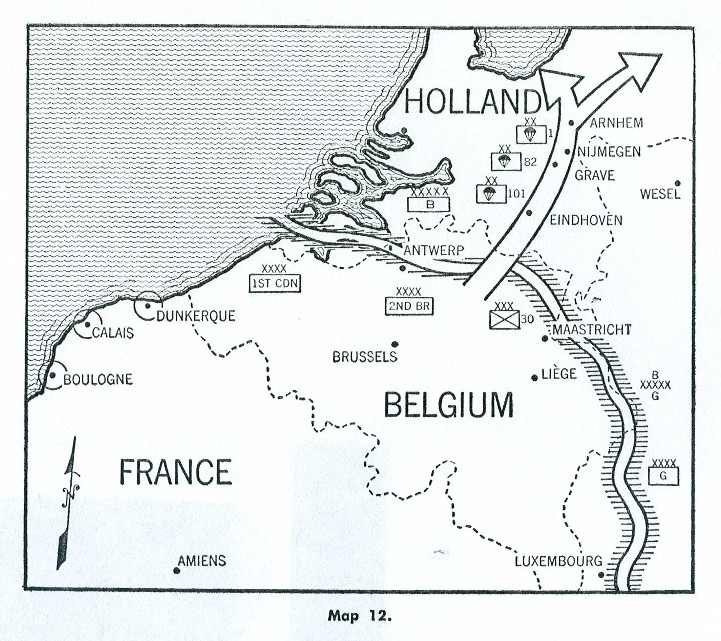
Map 12.
patience caused by a prolonged war, to create dissension in their own ranks. Time would gain for the Axis better peace terms and even, by their own estimates, final victory.
It was out of this state of affairs that there emerged the plan which came to be known as Operation MARKET-GARDEN. Operation MARKET was the airborne operation that would cooperate with the ground effort, Operation GARDEN.
The armies on the Western front, with the exception of the British Second Army, were to stop their further advance for the time being. Supplies would be diverted to the British Second Army as far as their suitability permitted, and concentrated behind that army for an all-out effort.
The British Second Army, assisted by the First Airborne Army was to advance from its positions along the general line of the Albert and Escaut Canals in Belgium to the Zuider Zee in Holland and thus cut off the German armies in western Holland
Page 71
(see Map 12). The Allies would then be in a position to strike into the heart of central Germany.
This plan made it possible to avoid a frontal attack on the Siegfried Line; instead its northern flank would be turned. The route of advance layover the widest parts of some of the largest rivers in Europe, and across numerous canals. The army was to drive forward on a narrow front as rapidly as possible, with the XXX Corps spearheading from the center generally along one road:
Eindhoven-St. Oedenrode-Veghel-Uden-Grave-Nijmegen-Arnhem-Apeldoorn-Zuider Zee. The flanking corps, the VIII and XII, were to advance more slowly.
Calculations indicated that there were just enough supplies, ammunition and transport for the job provided the opposition was not too strong. It was a daring plan. If it succeeded it could well cause the disintegration of the German armies. To carry it out was a challenge to every Soldier in the Allied armies, from the supreme commander to the lowest-ranking airborne trooper. This was the Sunday punch. If it struck through, the war was won in 1944. If it failed, well, only time could tell. Mid-September was the time selected for D-Day, the exact date to be decided later.
THE AIRBORNE PLANNING
The first airborne-troop carrier operational conference on Operation MARKET was held at the headquarters of the First Allied Airborne Army at Sunnyhill Park, England at 1800 hours, September 10, 1944. Present were the troop-carrier and airborne commanders and staffs, Lieutenant General Brereton, commanding the First Allied Airborne Army, and Lieutenant General F. A. M. Browning, commanding the British Airborne Corps, who was later designated as corps commander of the airborne corp participating in the operation. The commanding general of the U.S. XVIII Corps (Airborne) was participating in operational planning on the Continent at the time and was not present. General Browning outlined the general situation and mission of the First Allied Airborne Army. It was "to capture and hold the crossings over the canals and rivers on the British Second
Page 72
Army's main axis of advance from about Eindhoven to Arnhem inclusive." This mission envisioned a considerable dispersion of the airborne effort. It was later modified at the direction of General Brereton and the request of General Taylor, commanding the 101st Airborne Division, so as to include only specific bridges and those not too distant from each other. They are covered later as part of the separate division missions. At the conference there was much discussion on such planning details as available lift, parachute and glider take-off airfields, airborne division missions, troop-carrier missions, departure airfields and unit assignments to departure airfields, enemy flak and troop dispositions, flight routes, photo coverage, probable drop and landing zones, the air resupply plan, air cooperation and the time required for preparation.
Available Lift.
The actual operational troop carrier aircraft availability figures were in the hands of the commanders and staffs, but not the allocation to the different airborne units. A decision was required on this most important point. First consideration had to be given to the mission of the army and each of its divisions. If all troops could not be taken in the initial lift, and such was the case, then an allocation had to be made that would give the maximum support to the airborne main effort. The following aircraft were available for the first day's lift:
1,250 C-47 transports (available for either paratroops or glider tow) with a payload of 5,85 pounds for paratroopers.
354 British bombers (glider tow).
Waco, Horsa, Hamilcar glider as required. Capacities: CG-4A Waco, 3,750 pounds; Horsa, 6,900 pounds, Hamilcar, 16, 000 pounds
The following major airborne units were available for the operation: 1st British Airborne Division, 101st U.S. Airborne Division, 82nd U.S. Airborne Division, 1st Polish Parachute Brigade, Corps and Special Troops. We knew from past operations and studies that this size lift
Page 73
could accommodate all the parachutists and approximately fifty glider loads from each of the U.S. divisions and about one parachute brigade and half the glider troops of the British Division. Final allocation for the first day's lift was as follows:
|
C-47s |
Wacos |
Horsas |
Hamilcars |
|
|
(paratroops) |
(glider troops) |
(glider troops) |
(glider troops) |
|
|
1st British |
145 |
4 |
341 |
13 |
|
101st U.S. |
424 |
70 |
||
|
82nd U.S. |
480 |
50 |
It is an important, yes, a vital principle that missions assigned to airborne units should be well within their capabilities. Emphasis should always be placed on this, for an airborne unit once committed is beyond reinforcement or alteration for sometime afterward. Moreover, each mission may have a different requirement.
It follows therefore, that each unit assigned a mission must be organized and equipped for that particular mission. In the MARKET-GARDEN situation one division was fortunately as well-prepared and equipped as another to undertake the contemplated tasks. All were combat experienced, well-equipped, and imbued with a high morale.
The British Division had been studying Arnhem for some time, it had already prepared some plans for an operation in that area. Consequently, it received the mission "to seize and hold the bridges at Arnhem." In considering the assignment of missions to the 101st and 82nd U.S. Divisions one condition outweighed all others. The divisions were located in their take-off areas in England so that the 101st had to be dropped and landed south or west of the 82nd. Otherwise their troop-carrier columns would have to cross in the air en route. The assigned mission of the 101st was "to seize the bridges on the axis of the advance of the British Second Army from Veghel to Eindhoven inclusive." Initially it was expected that the 101st Division would drop in about seven small packets along the axis of the bridges and near them. Permission was later
Page 74
granted for the 101st to drop in three concentrated areas and, using these areas as airheads, to seize the bridges as rapidly as possible. The mission of the 82nd Division was to seize the bridges over the Maas River at Grave and the Waal River at Nijmegen, and seize, organize, and defend the high ground in the vicinity of Groesbeek.
After a thorough study of the Nijmegen area, and after consulting a Dutch officer who was to accompany the 82nd Airborne Division, it became quite evident that the key to the accomplishment of the 82nd's mission would be the prompt seizure, thorough organization, and tenacious holding of the Groesbeek heights.
This hill mass went up to one hundred meters and dominated the countryside for many miles. It had been used as a maneuver area by both the Dutch and Germans and was well known. It is the only high ground in all of the Netherlands. At a conference at the headquarters of the British Airborne Corps on September 16 (D minus 1) General Browning directed the CG of the 82nd "not to attempt the seizure of the Nijmegen Bridge until all other missions had been successfully accomplished and the Groesbeek-Bergendahl high ground was firmly in our hands." This expression of the Corps commander's evaluation of the separate portions of the mission given the 82nd Airborne Division was most helpful since the Division was to be so widespread.
Troop-Carrier Missions. The principal factors considered in assigning the troop-carrier missions were the locations of the troop-carrier units in relation to the airborne units, and the strength and type of aircraft in each unit, and their past association and familiarity with particular airborne units. Troop-carrier units stationed in the southern area, the Newbury area, were best located to fly the 101st and those in the Grantham area the 82nd.
Assignments were in general made accordingly. On every airborne troop-carrier operation one particular point comes up for discussion that never lends itself to a simple and completely satisfactory solution to both parties. Airborne units desire that their unit integrity remain undisturbed at all times.
They want platoons, companies, battalions, and regiments, to
Page 75
bivouac, to be briefed, and to have an opportunity to prepare their final combat plans, all with their unit organization intact that is, at the same airfields. They want to load as units, and fly and finally jump and land under their unit commanders immediately ready for ground engagements as intact combat units. Their arrival at their objectives as tactical units ready to fight especially appears to be imperative and fundamental.
Yet this is not as simple as it may seem. Troop-carrier units require identically the same things. Troop-carrier groups like to service their own aircraft and prefer to fly their own squadrons.
In any case they never like to break up a squadron or flight of nine planes to accommodate an odd-sized airborne organization for this would break up their command, control and administration.
But the C-47 carries only eighteen to twenty-two troopers. Thus to begin with paratroop platoons must be broken up. From there on, unless great care is exercised in the planning, every airborne unit may be broken up, with the result that the troops arrive on their drop or landing zone as groups of individuals rather than cohesive, commanded units, with little prospect of successfully undertaking their ground missions.
The solution of this problem goes, of course, all the way back to the design of the aircraft. Airplanes designed and equipped purely to fly airborne units will be the only type aircraft entirely satisfactory for that purpose. Anything else is a compromise. Airborne units could be modified to suit the airplanes but this obviously loses sight of the real purpose of having airborne units.
That purpose is to engage and destroy the enemy forces on the ground. The organization best suited to this ultimate purpose is the one that must be used. The airborne units and the troop-carrier units do not accommodate each other perfectly now, and I doubt if they ever will. But even if the effort to attain agreement would be too great, the utmost care must be taken in staff planning an airborne operation to see that as far as possible each unit remains intact in the staging area, en route, and upon landing.
Once lift assignments are made, division and subordinate missions assigned and troop-carrier assignments made, the assign-
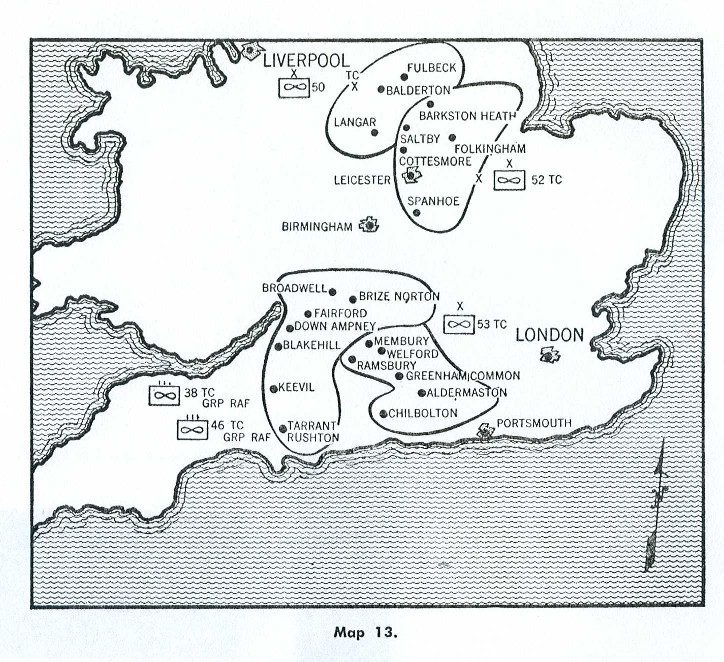
Map 13.
ments to departure airfields readily follow. Departure airfields for the Holland operation are shown on Map 13.
ENEMY FLAK AND ENEMY DISPOSITION
The moment a mission is announced, enemy flak becomes the number-one topic for all pilots and all airborne commanders.
Practically nothing can properly be decided about this until after a careful analysis and evaluation of the hostile dispositions. But from their first combat mission on there is no one thing of more concern to both troop-carrier and airborne personnel than the flak and ground dispositions of the enemy.
The flak dispositions have a direct bearing on the flight route and consequently on the drop and landing zones. The airborne commander may insist that it is necessary that he be dropped or landed in a certain area, and it may be imperative for the landings to be made as he wishes in order to give him a reasonable chance
Page 77
Map 14.
of accomplishing his mission. The troop-carrier commander, however, may estimate that his losses from flak over the areas Picked by the airborne troop commanders may be tremendously higher than they would if the landings could be but a short distance away. He will accordingly object to flying the route desired by the airborne commander and some compromise must usually be reached.
I believe that without exception in the airborne operations the IX Troop Carrier Command was always prepared, in the face of probable heavy losses to take flight losses and fly into any area the airborne units wanted to go into, if the airborne commander thought it tactically necessary to fly into the area. In Operation MARKET the flak map looked rather bad on September 10. It continued to build up during the week and by the 16th it was indeed discouraging. (Map 14 shows flak on northern route.)
Page 78
HOLLAND FLIGHT ROUTES
Page 79
Once the airborne commanders know where, in general they must land to accomplish their assigned mission and inform the troop-carrier commanders, it is the task of the troop-carrier commanders to figure out how to get them there. This is a difficult task at best, with many possibilities for confusion and conflict.
Vast as the ethereal expanse may be, there is always room somehow for collision, or at least confusion. The Sicilian flight plan was an example of a well-laid, and apparently well-thought-out plan that went amiss. Many ships failed to follow it and many that did were fired upon by our own Navy and ground ack-ack with heavy losses.
Operation MARKET had to be very carefully coordinated with the pre-landing bombings. The flight was also to have heavy escort. And during and after the landings support aircraft would be constantly in flight throughout the operational area. The troop carrier air column from the Grantham area was, for example thirty-five minutes long with 480 paratroop ships. A typical troop carrier group, the 313th, consisting of forty-five C-47s, took off, marshaled immediately over its field, and left on schedule for its drop zone at 1119 hours. It arrived over its drop zone at exactly 1300 hours, dropped its troopers and returned. Just four minutes were allowed from the head of this group to the head of the next group of forty-five planes. This was the tightest formation that had been attempted as to that date; it allowed but four minutes of flexibility and this meant almost perfect flying, which, as it did turn out, was remarkably good. Flights of nine ships were approximately twenty seconds apart and each flight carried in on an average a rifle company. Glider troops occupy a great deal more air space. Troop-carrier groups towing forty CG-4A Waco gliders which flew four in echelon were allowed seven minutes per group.
But aside from all consideration of serial and unit composition of flights, and this was very important, the matter of greatest concern and intense interest to all planning a flight and participating in a flight was the flak. Where was the flak? What types of flak
Map 15.
were in each area? How much of it was there? All of these questions were of vital concern to all participants, and for very sound reasons. The C-47s had no self-sealing gas tanks. They were to fly at an altitude of 400 to 500 feet. There was no protecting armor for the airborne troopers, although there was some for the crews. Keeping paramount the need for close coordination between the troop-carrier flights and the navy, ground troops, and air support, the flight plan is built around the islands of flak. (For the flight routes for Operation MARKET see Map 15.) Good photo coverage of the flight route and the probable drop and landing areas is always essential. Good photos of the flight route provide necessary information for the jumpmasters. They usually memorize key terrain features and check against the planned time schedule en route. Thus memorizing the terrain along the flight route and that immediately around the drop
Page 81
zones has enabled many a jumpmaster to orient himself quickly and move directly and promptly on his ground mission, even after he has been dropped a long way from the right area.
Photo coverage is just about essential to the proper execution of the ground mission itself. The principal use of photos is in selecting drop zones and landing areas. Used in conjunction with maps from which slopes and elevations are determined, air photos are about the only dependable means of determining the suitability of any area for landings. They also provide a last minute source of information on the type of anti airborne measures the enemy has taken-his use of Rommel's asparagus, flooded areas, roadblocks, new ack-ack. Photo coverage for Operation MARKET was especially full. It had been started well before September 10 by the British airborne corps which had long had an interest in the Nijmegen-Arnhem area. Beginning with that date the coverage was intensified and flown daily thereafter.
DROP AND LANDING ZONES
The selection of the drop and landing zones has a greater influence on the final outcome of an airborne operation than any other single planning step. Their proper selection is absolutely vital to the outcome. In their selection the following factors must be considered, which I have listed in the order of their importance:
* Proximity to objectives
* Enemy flak and ground defenses
* Accessibility of objectives
* Accessibility for troop-carrier aircraft
* Suitability of terrain
Suitability of terrain assumes an even greater importance in selecting glider landing zones than in selecting parachute drop zones. In some terrain it is of highest importance. The ideal airborne landing is to land directly on the objective. It is in general far better to take landing losses and land on the objective than to have to fight after landing in order to reach the objective. Air
Page 82
supply landing zones should also be within ground held by the ground troops. Otherwise, effort has to be expended to safeguard the supply landing zone at the expense of the tactical effort. Air supply should be delivered on the objective.
Flak in the immediate vicinity of the drop and landing zones should be avoided. Troop-carrier aircraft are never more vulnerable than during drops and landings-and they are certainly endowed with rare vulnerability at all times. There should be no obstacles to troop movement between the drop zones and objectives, unfordable streams for example, or mountains, large cities or towns, and so on.
The landing areas selected should be such that troop-carrier aircraft can get into them. Often, as in Italy, terrain makes it impossible for the troop-carrier formations to deliver airborne troops where they would like to be landed. The terrain should of course, be such that landings can take place without excessive landing loss. Parachutists can land in pretty rough terrain. Their greatest obstacles are tall timber and deep marshes and flooded areas. Gliders require carefully selected clearings.
The measure of exactly what constitutes suitable combat drop and landing zones can only be acquired by a thorough study of the suitability or unsuitability of such areas in past operations.
In the area of Operation MARKET there happened to be preeminently suitable areas from the viewpoint of terrain. The areas finally selected by each division commander are shown on the operational sketches for each unit. They are worth the most careful scrutiny by the student of airborne warfare-in the light of the assigned missions, the estimated probable direction and intensity of enemy reaction, and the actual ensuing operations.
AIR RESUPPLY
It was most apparent that air resupply was necessary to Operation MARKET. Although the westernmost division, the 101st, had excellent prospects of gaining contact with the ground forces on D-Day, there was a possibility that it might need air resupply. The deeper divisions, the 82nd and 1st, would by all means need such
Page 83
help. They would take in sufficient supplies for the first day's fighting on the initial landings; hence resupply would not be necessary until the second day. But on the second day, all available troop-carrier lift would be needed to continue the landings of the divisions. The bombers, however, were to make their greatest effort in pre-operational support on the morning of D-Day and it appeared that they would be available for a resupply run on D plus 1.
This proved the case and the Eighth Air Force received the parachute resupply mission for D plus 1. Thereafter, it was flown by the troop-carrier command. Resupply was to be automatic both as to composition and quantity for four days, unless the rear base received notice to the contrary. We assumed that the airborne divisions and corps would be in radio contact both with their rear bases direct and through XXX Corps and the Second Army.
The American division, for example, planned on a daily resupply of 264 tons, mostly food, ammunition, and medical supplies, but also included were many other items such as tools and replacement weapons. In the past, air resupply had not been too successful. The worst difficulty had been a lack of prompt dependable communications between the combat divisions and the rear air bases. It obviously requires much planning and many skilled men to package and deliver 264 tons of supplies per division by parachute daily. Yet this was the very lifeblood of the division.
It had to be pumped into the divisions daily if they were to continue as living combat entities. Resupply is a difficult type of mission for the Air Forces. Often it is very costly. Reacting quickly to the first landings, the enemy is usually waiting for resupply transports on their subsequent runs. None of us who saw the resupply flights coming into the 82nd Airborne Division along the Merderet River in Normandy will ever forget the amount of flak and small-arms fire the troop-carrier formations had to take. It was "murder on the Merderet" as some of the troopers described it at the time. Yet that dangerous and difficult resupply mission was vital to the continued combat existence of the airborne units on the ground.
Page 84
The air resupply plan for MARKET itself was the most ambitious yet attempted.
AIR COOPERATION
Flying heavily loaded, tightly flown, low altitude, troop-carrier planes at slow speeds through definitely known heavy flak areas would certainly require the maximum amount of air cooperation, or as we called it then, air support. The airborne divisions that would have to fight for days isolated from normal medium artillery and armored support, would also need every bit of air cooperation possible after they landed. Fighters and rocket-fighters are the artillery and the heavy antitank defense of an airborne force. This was fully appreciated by General Brereton, the Airborne Army Commander.
Once the decision on MARKET-GARDEN was made, General Brereton directed his staff to arrange at once for the necessary air cooperation through the Royal Air Force and the Eighth and Ninth Air Forces. The air support itself consisted of (1) knocking out all enemy interceptor fields within striking range of the air columns during the twenty-four hours before the landings; (2) flying continuous cover during the flight of the airborne troop columns (this included the destruction of threatening enemy ground installations); and (3) close air support during the ground fighting and resupply missions. The implications of a well-integrated air cooperation plan and the complexities and ramifications innate in such planning all become more apparent when its realized that 1,113 bombers and 1, 240 fighters were in-support of Operation MARKET on D-Day alone. These plus the 1,600 troop-carrier aircraft and the hundreds of gliders filled the sky, of the MARKET area. At the time it was hard to believe that barely three years before, our early airborne enthusiasts had been loud and alone in their insistence that it was quite possible to fly three ships together and have airborne troops drop from them simultaneously.
PREPARATION TIME
Preparation time for a major airborne operation, although an apparently simple matter that is readily adaptable to standardization, can become difficult and may be prolonged needlessly.
Troops must of course be organized, armed, and equipped for the mission before they arrive at their departure airfields. If air photo coverage and maps are not readily available these must be obtained. When they arrive in their combat areas, the troops themselves must have some idea of where they are and what they are to do. Without at least an air photo in their possession, they will have difficulty in determining where they are upon landing, let alone undertaking to move in any planned direction. Procuring and distributing maps and photographs may take several days, and expeditious planning must anticipate this requirement.
If the troops have a long distance to travel to the take-off airfields, and if there is any shortage of transportation, this will take at least another day, and this "movement phase" may take several days. After all, a large amount of transportation is required to move three divisions and corps troops simultaneously and in Operation MARKET this phase was the worst time consumer. Troops should be on their take-off airfields at least twenty-four hours before take-off. This is short enough time for their final briefing after they are "sealed." Final issues of ammunition, rations, maps, etc., also have to be made, the airplanes have to be equipment-loaded, and the last conferences held between pilots and jumpmasters and unit commanders. All this must be crowded into the final few hours. For MARKET, D-Day was at first planned for September 15 and later, through necessity, this was changed to September 17.
Before concluding the first conference on September 10, General Brereton announced several decisions of concern to those present. The XVIII U.S. Airborne Corps under Major General Matthew B. Ridgway to be responsible for the supply of the U.S. airborne divisions. The operation was to be flown in during daylight-which was a good indication of the extent to which we were gaining complete air superiority on the western front. It is of particular
Map 16
interest that the first allied airborne operations had been conducted under cover of darkness whereas the German operations had been carried out by day, but in the final operations of the war, the allied operations were staged in daylight whereas the final German airborne effort in the Ardennes was staged under cover of darkness.
The entire conference had not taken much more than an hour at the end of which each commander returned to his own command to start his own staff working on analysis and planning in preparation for the next conference which was to be held at the headquarters of the IX Troop Carrier Command at Eastcote near London the following morning, September 11, at 0900. Since I was a member of the 82nd Airborne Division at the time, I can best describe the sequence of steps in the planning as conducted in that division.
Page 86
The division staff was briefed as soon as possible which was shortly before midnight. Emphasis was initially placed on a careful study of enemy flak, enemy dispositions, terrain suitable for landing, and recommended landing areas, and upon tentative missions for units that would land on each drop and landing zone.
We completed these studies by 0500 hours and held a final staff conference at that hour, just before take-off for Troop Carrier Command headquarters.
From the viewpoint of the 82nd Airborne Division, Operation MARKET did not appear to pose any new type of problem that had not been encountered in the planning for Sicily, Italy, Normandy, or for the many operations we had planned but not carried into execution.
The determination of the relative suitability of different areas for glider landings and the calculation of the numbers of gliders that can be landed with reasonable safety in a given area require considerable background and study. Holland, fortunately, did not present too formidable a problem in this respect. As for the terrain in the 82nd Airborne Division sector (see Map 16), parachutists could be dropped anywhere except in the densely wooded area on the western side of the Groesbeek heights. Flak was another matter. The density of flak near the Nijmegen and Grave bridges made it appear certain that the troop-carrier flights would not approach them except with the greatest reluctance.
Considering the situation solely in the light of the objectives that had to be seized, it appeared imperative that a large portion of the parachute force land on the Groesbeek heights. Next order of priority would come (1) Grave, (2) the bridges on the Maas-Waal Canal, (3) Nijmegen. Considering the matter from the viewpoint of probable enemy reaction to the landings, it seemed advisable to place a large portion of the parachute echelon between the Groesbeek heights and the Reichswald. Also, the force given the mission of seizing the Grave bridge must be of such size and composition that it could carryon if necessary a sustained fight for several days on its own. Next the enemy must be prevented from interposing himself between the force on the west side of
Page 87
the Maas-Waal Canal and the force of the Groesbeek heights. The Mook-Nijmegen road had to be held and blocked and a bridge seized intact or constructed across the Maas-Waal Canal.
The Nijmegen bridges had to be seized as soon as possible but it would be a mistake to go after them before securing the other objectives. In view of the large enemy forces known to be in Nijmegen, a landing of large enough size to have some prospect of grabbing the bridges and holding them for any length of time seemed out of the question. Accordingly, I came to a tentative decision to give one parachute regiment (reinforced) the mission of seizing and holding the Grave bridge and attacking the Maas-Waal bridges from the west side. The rest of the first echelon, to consist of two parachute regiments, a parachute engineer battalion, a parachute battalion of artillery, and a battery of 57mm glider-borne antitank guns and division headquarters-would seize the Groesbeek area and immediately attack and mop up toward the Maas-Waal Canal and Nijmegen. The conference came off as planned at the headquarters of the IX Troop Carrier Command at 0900 September 11. After considerable discussion the drop zones and landing zones for the 82nd Division were selected as shown on Map 16. There was agreement upon the use of pathfinder teams and distinctive colored smokes "and panels for each drop and landing zone. It would have greatly facilitated the planning and preparation of the airborne unit orders if at this time the troop-carrier command had been in a position to announce the composition of the serials and the fields on which each group would be based; but for reasons entirely beyond their control it was not possible to do so. Changes were still being made in the assigned lifts, and of course each airborne division commander desired the maximum lift, feeling that his mission was the most important. By noon, tentative assignments of Troop Carrier Wings and Groups had been made and division commanders returned to their units.
The first conference for the unit commanders of the 82nd Airborne Division was held at Leicester on the afternoon of Septem-
Page 88
ber 11, at which time tentative missions, drop and landing zones, and take-off airfields were assigned to regiments and separate units. All echelons of the Division then undertook detailed studies of their own missions without delay.
It is of the utmost importance that all tentative plans and fragmentary orders be passed along to all unit commanders participating in an airborne operation as soon as possible. Only by so doing can they keep their own planning in accord with that of higher headquarters. The preparation that goes into the planning for an airborne operation is usually very detailed, because once they are committed airborne units are beyond correction and control for some time. Everything must be right the first time.
Three days elapsed between the issuance of the tentative division plan and the move to the departure airfields. During these days, the units of the division prepared their plans, issued supplies, checked equipment, and received and conformed with inevitable changes from higher authority. The Division units closed on their departure fields by dark September 15 at which time they were "sealed." All troopers of the 82nd Airborne Division were briefed on the 16th, and issued ammunition, rations, maps, and orders; and all were in readiness for take-off at daylight on the 17th.
This planning period is at best a hectic one. Time must be budgeted starting with the highest headquarters. Whether the allowed period is six hours or six days, and in World War II it had that much variation (Salerno and Holland), every echelon of command must be allowed a proportionate share of the time to issue its own orders. This means that orders frequently have to be oral and fragmentary, and not entirely satisfactory to either the recipient or the commander issuing the order, but the best that can be done under the circumstances. Requirements of supplies, transports, communications, and accommodations for the troops at take-off airfields must be anticipated and arranged. Just before movement to the planes, troops must have as many hours as it is possible to grant them for taking care of their own affairs. I believe that whenever possible they should have twenty-four hours
Page 90
for resting, letter writing, talking things over, and preparing their own equipment immediately before going in. This, of course, is ideal and by no means always possible.
On the basis of its experiences in Sicily and Italy, the 82nd Airborne Division held a final unit commanders' briefing on the night just preceding the Normandy and Holland operations, and this proved very much worth while. All commanders, regimental and battalion, are assembled in a conference room before a large-scale map of the operational area. Each regimental and battalion commander, in turn, outlines to the assembled group his own mission and plan of operation upon landing. He is then questioned carefully on his plans for making contacts with other units, and on what he will do if his unit lands in a locality other than the one planned for, and what he considers the most important elements of his tactical objective and his plan. We found from experience that this is the only method to insure that every commander knows what every other commander is going to do. And-most important-what he should do in order to contribute to the common tactical effort if he should land with his own or any other unit in the wrong area.
The importance of such a conference can be best judged when we realize that there never yet has been an airborne operation in which every unit has landed in its proper area. In an airborne operation, every battalion commander must know the plan of every other battalion commander within the division. He must be prepared to undertake the execution of any of those other plans immediately upon landing as well as his own plan.
By 1900 September 16, final weather reports were found promising and the Army commander, Lieutenant General Brereton, announced that the operation would go as planned. The first drop would be at 1230 September 17 in the Nijmegen area.
And all did go as planned. Between 1230 and 1405 hours, when the final landing took place, the first echelon of the corps of three divisions dropped and landed out of 1,544 troop-carrier aircraft and 491 gliders. The following day, September 18, 1944, between 1413 and 1608 hours, 1,360 heavily laden troop-carrier aircraft
Map 17.
and 1,203 gliders delivered the second echelons of the divisions. The southernmost division, the U.S. 101st, was the first to make contact with the ground troops of the British Second Army, so its landing and engagement will be first examined.
THE 101ST AIRBORNE DIVISION
The mission of the 101st Airborne Division was to seize the four highway and railway bridges over the Aa River and Willems
Page 91
Vaart Canal at Veghel, seize the highway bridge over the Dommel River at St. Oedenrode, seize the highway bridge over the Wilhelmina Canal at Zon, and seize Eindhoven and the bridges in the city. The objectives were spread over a road distance of fifteen miles (see Map 17). The Division Commander, Maj. Gen. Maxwell Taylor, decided to commit one parachute regiment to the Veghel mission and with the remainder of the force establish an airhead between St. Oedenrode and Zon. Using this as a base, the attack was to be pushed north to St. Oedenrode and south to Zon and Eindhoven.
Subsequent landings of the D plus 1 glider echelon and resupply deliveries were to employ this airhead. It was designated as Landing Zone "W" (Map 17).
The composition and lift of the D-Day echelon was as follows:
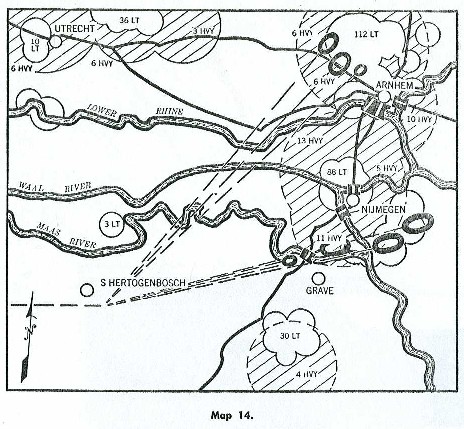
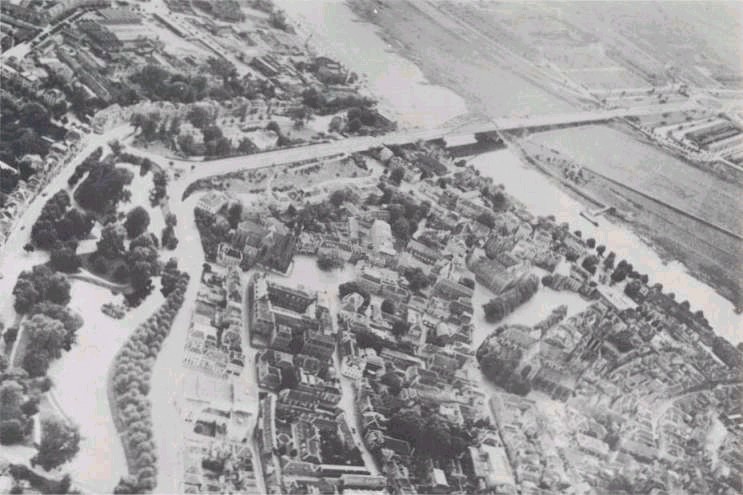
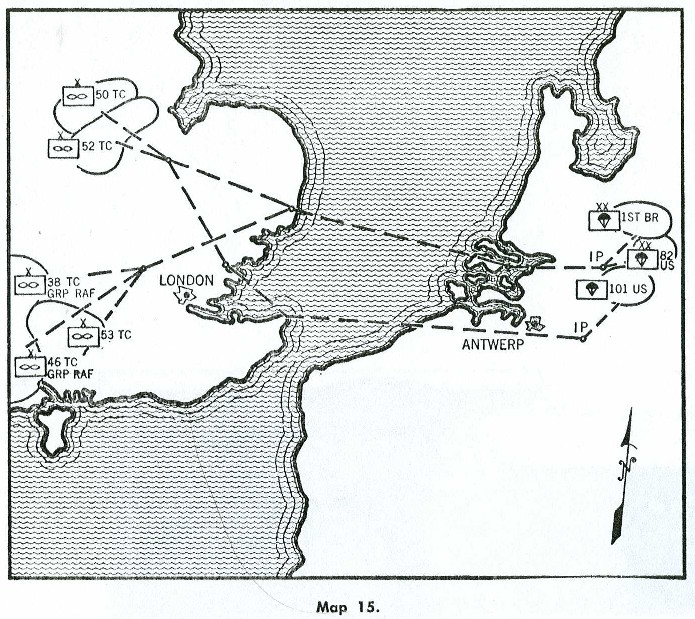
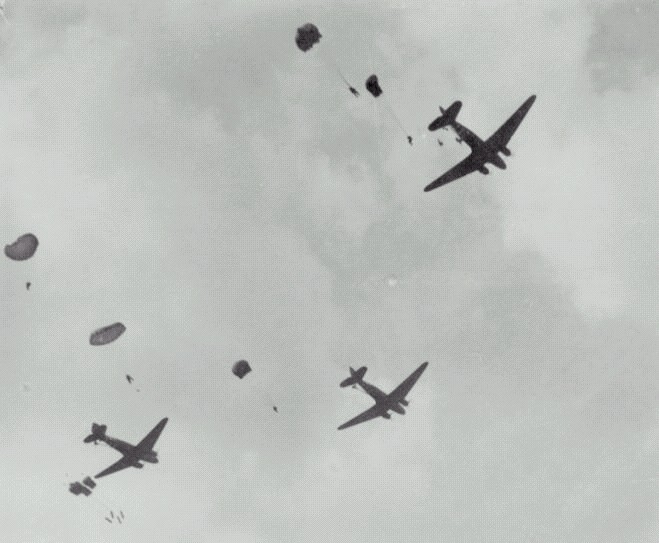
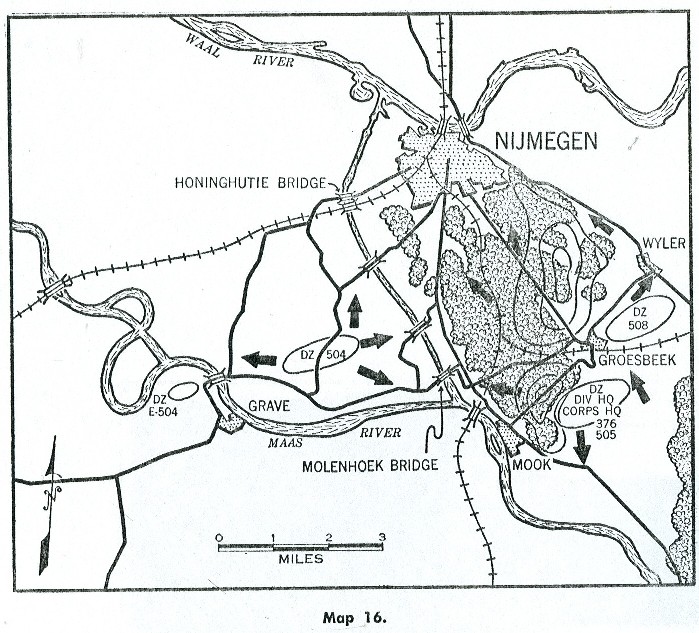
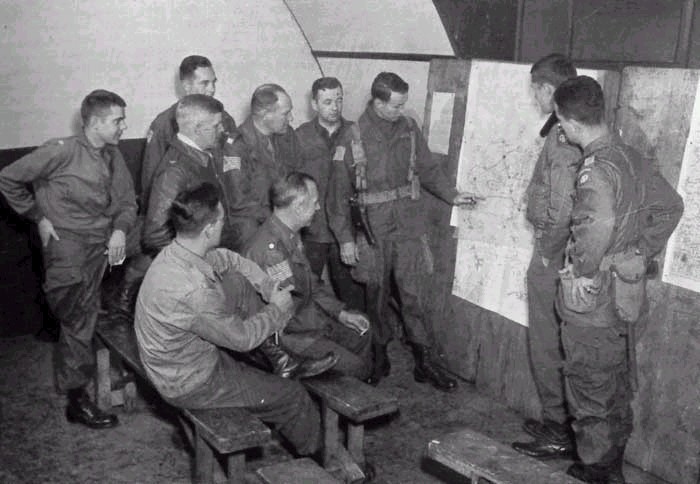
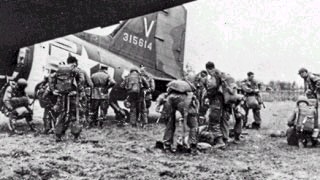
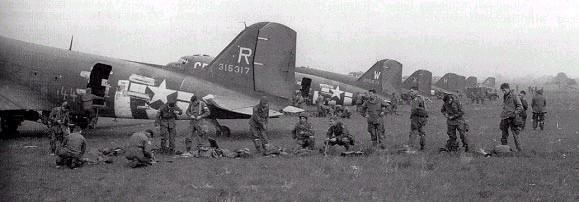
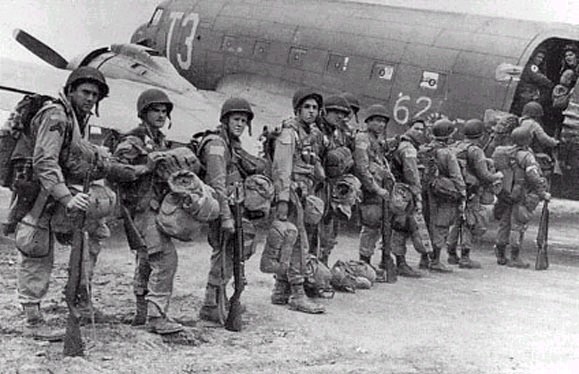
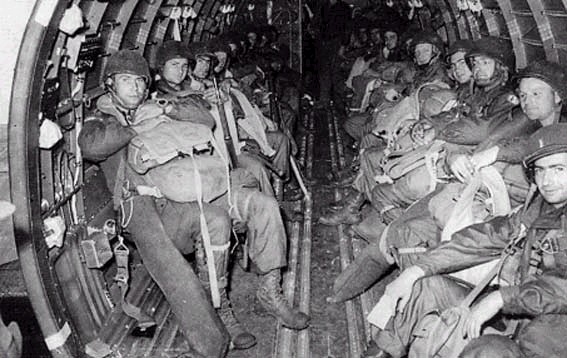
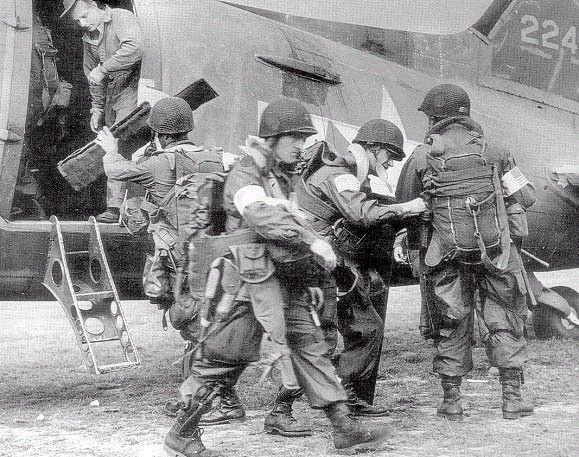
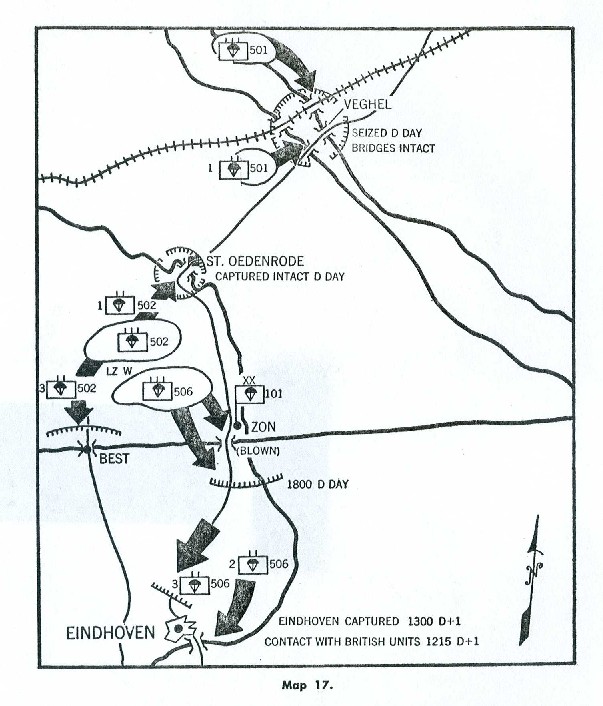
|
Unit |
Paratroop Transport |
Gliders |
Personnel Landed |
|
Div Hqrs & Hqrs Co. |
7 |
8 |
106 |
|
Divison Artillery Hqrs |
3 |
3 |
33 |
|
Division Signal Co. |
2 |
14 |
70 |
|
Division Recon Plat. |
15 |
34 |
|
|
326th Abn Medical Co. |
6 |
34 |
|
|
326th Abn Engineer Bn |
16 |
252 |
|
|
377th Prcht FA Bn |
12 |
78 |
|
|
501st Prch Inf Regt |
129 |
8 |
1967 |
|
502nd Prcht Inf Regt |
135 |
8 |
2101 |
|
506th Prcht Inf Regt |
132 |
8 |
2190 |
|
Totals |
436 |
70 |
6885 |
OBSERVATION: 7 x C-47s could drop 154 paras, with only 106 paras from HHC, it could be inferred that the 8 x CG-4A Waco gliders were carrying each a Willys 4x4 jeep and driver and/or assistant driver. Artillery Headquarters only had 33 men, so its 3 gliders must have delivered 3 jeeps or 3 x 75mm pack howitzers. Signal company's 2 x C-47s can only deliver 44 paras, so the remaining 26 men spread throughout 14 gliders implies each one of them had a jeep. Recon platoon in 15 gliders with 34 men screams out 15 more jeeps, hopefully armed with a .50 caliber heavy machine gun. Recoilless rifles were not available in 1944 which is tragic since a jeep with a RR is in a ready-to-fire condition that could blast enemy infantry positions and even bust tanks without having to stop and get a towed weapon into firing order. Why no one thought of a vehicular mount for a pair of 2.36" bazookas? comes to mind. STOL Grasshopper pilots mounted bazookas onto their Piper Cubs and killed German tanks. The 54 medics all coming in by glider implies an exact 9 men per glider, perhaps with folded stretchers? The 252 light Sapper combat engineers in 16 x C-47s suggests 16 paras per plane, hopefully with some door bundles of demolitions explosives. The field artillery battalion's 12 x C-47s for 78 men means just 6-7 men "red leg" paras per plane and thus a 75mm pack howitzer in pieces taking up most of the space inside and under the plane as an external load. Each Parachute Regiment getting 8 gliders seems to indicate 8 jeeps being delivered since 1, 967 paras only requires 90 x C-47s and the 501st used 129 planes; 2, 101 paras only need 96 x C-47s yet the 502nd used 135 planes, 2, 190 paras only require 100 x C-47s yet the 506th used 132 x C-47s. We estimate a total of 50 x 4x4 jeeps were delivered to the 101st; enough to move 200 men at a time or almost two rifle companies if massed together. The mythology that the Airborne is damned to foot immobility does not stand up to the factual vehicle capabilities on the ground.
Taking off on schedule, the 101st was airborne with the lead ships well on the way by noon. In the lead, were the pathfinder ships whose personnel were scheduled to jump twenty minutes ahead of the main body. The southern route was over friendly territory until the last turn near Berg Leopold. The entire route was well marked with navigation aids including a boat midway across the Channel. The boat signals were both radio and visual.
Sea rescue service was provided and used.
Page 93
The four divisional pathfinder ships took off from Chalgrove at 1040, circled and followed a course generally east to the coast.
All of the pathfinder personnel with the exception of one trooper had had previous experience in Normandy. From the coast, a course was followed to a point where the British Second Army was deepest into the German positions. Orange smoke was observed marking this point and the ships speeded up and headed for their DZ. Very heavy flak was encountered at 1232 and one of the ships was seen to fall into a steep dive. Four chutes were seen to leave the ship before it crashed bursting into a sheet of flame. The remaining arrive over their Drop Zones within seconds of the prescribed time. Despite spotty enemy resistance, navigational aids, radio, smoke and panels were set up in a few minutes. The first serial of the main body due at 1304 arrived over the Drop Zone at 1307, it was followed by the remaining serials according to schedule.
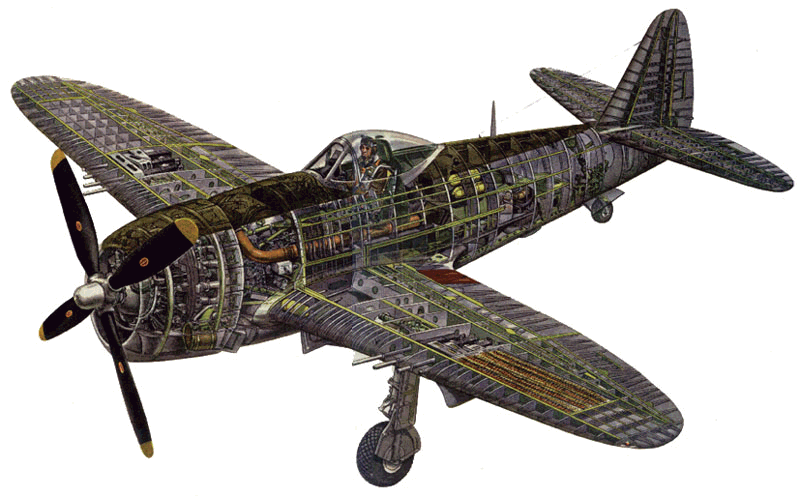
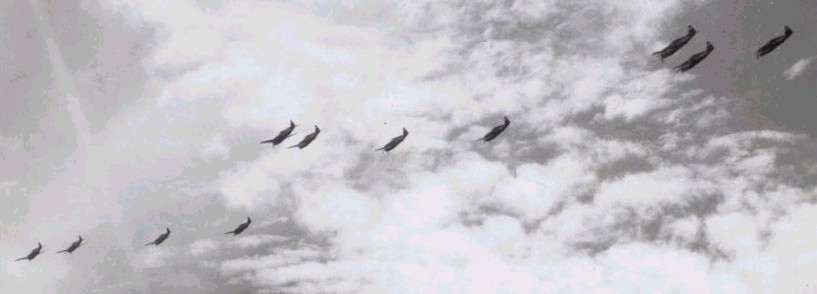
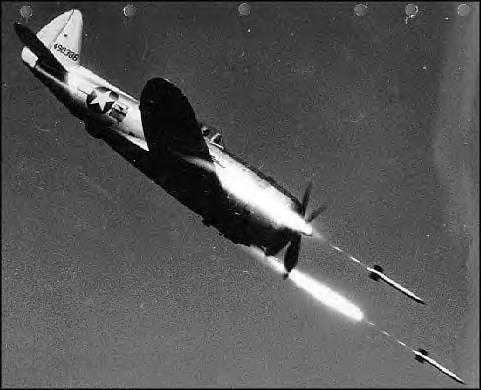
 www.youtube.com/watch?v=48Mvy7uNHxY
www.youtube.com/watch?v=48Mvy7uNHxY
The plan was to protect this great troop train by high-cover fighters, and by fighter-bombers at low level ready to dive-bomb any flak positions that opened fire. The Air Defense of Great Britain carried out these two missions as far as the initial point (IP) employing 371 Tempests, Spitfires and Mosquitoes on this mission. The Eighth Air Force provided top cover and the Ninth Air Force dive-bombed flak positions on the southern route between the IP and the DZs with 212 fighters. The thorough coverage of the flak positions was very successful. Not only were land batteries knocked out, but several flak ships and barges off the Dutch islands were destroyed. An excellent example of the value of close air support was furnished by an event near the drop zone near Zon. Eight enemy tanks were seen in the vicinity as the troops were dropping. The fighter-bombers attacked them, destroying two and driving the remainder away.
The center of impact of the drop on one DZ was 1500 yards short and on another, three miles northwest of the planned DZ.
However, the compactness and speed of delivery more than made up for these errors. The drop was better than had ever been experienced by any unit of the division and aided immeasurably in
Page 94
enabling the troops to undertake their ground missions speedily.
The drop was unusually successful. All ships but two reached the drop area, and the two that failed were both shot down. Jump injuries were light, approximately 2%. Battalions were on their way to their objectives an hour after landing.
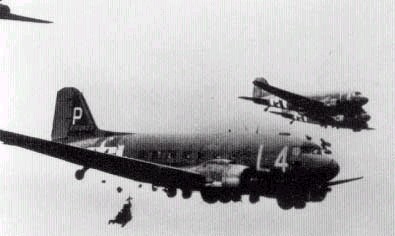
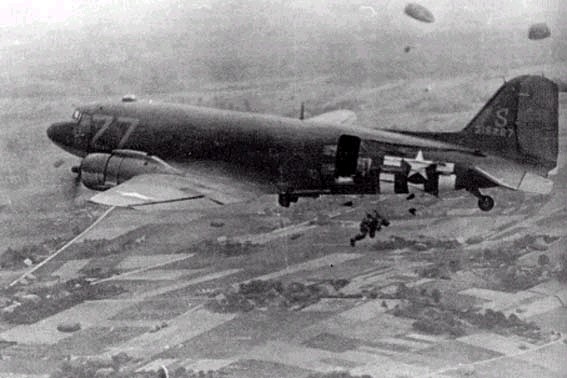
The southern parachute regiment, the 506th, swept through Zon against light resistance but found the bridges at the southern end of the town blown. Footbridges were improvised and by midnight the entire regiment was on the southern banks of the Wilhelmina Canal (see Map 17). The following morning, this regiment continued the drive towards Eindhoven encountering strong resistance at the northern exits from the town. Flanking the German positions to the east, the town was entered shortly after noon and in a matter of minutes contact was gained with reconnaissance units of the British Guards Armored Division, thus linking up the first elements of the airborne corps with the ground attack.
Soon to be realized, however, was the fact that it was nothing more than this, contact of the ground forces with but one element of the airborne corps.
Turning north, the 502nd Parachute Regiment after a "light skirmish" captured St. Oedenrode and the bridge over the Dommel River intact by dark. This was accomplished with one battalion. The remainder of the regiment was in division reserve securing the division airhead and endeavoring to seize the Best bridge with not too great a success. By last light, D plus 1 the leading elements of the British Guards had passed through St. Oedenrode and were well on the way to Veghel.
Veghel had been seized with surprising rapidity on D-Day. Landing on two drop zones, the 501st Parachute Regiment closed in promptly on the town and bridges, all four of them, and by 1500 hours owned all of the real estate in the vicinity. Some scattered resistance was met on the drop zones and on the way to the objectives, and in the vicinity of the objectives, but, moving with exemplary boldness, all objectives were seized and organized for defense before the enemy apparently could divine the purpose of
Page 95
the landings. The enemy reaction to the operations of the regiment continued to be negligible on D plus 1 and at 0645 D plus 2, the leading elements of the Guards Armored Division passed through Veghel on the way north to the airhead of the 82nd Airborne Division. Division headquarters arrived by both parachute and glider and moved into Zon where a command post was established and contact made with all units except the 501st by dark. Communications were established with the 501st at 0600 D plus 1. The over-all landing time of the D-Day echelon of the division was one hour and a half. Following the D-Day landings, some 428 gliders brought a glider infantry battalion, engineers, medical, signal and artillery troops into the Zon airhead on D plus 1. Although 450 gliders took off for the Zon area, only 428 arrived. The missing 22 were lost due to enemy action, structural failure of the gliders, tow ropes, etc.
This must be expected in an operation...of this type.
All in all, the Zon airhead was a busy place on D plus 1 since in addition to the foregoing, 121 x B-24s flown by the Eighth Air Force delivered 241 tons of supplies to the division by parachute on the same day. Of this but 50% was recovered due to various causes; scattering of drop, enemy action, difficulty of recovery due to lack of vehicles, terrain, etc.
The following day, D plus 2, 385 gliders were dispatched from England with the remainder of the airborne echelon of the division. For many reasons, principally weather, but 209 of these arrived intact on the landing zone. They included among other units, the last of the glider infantry regiment of the division.
Because of bad weather, resupply missions were cancelled on this date.
OBSERVATION: the "Screaming Eagles" had 50 x 4x4 Willys jeeps to work with that could have zoomed to the parachute bundles, hooked up to them and dragged them back to their owners. Had the American airborne been smart like the German paras, supply containers could have had wheels to be towed by rolling back to the desired supply dump. If the enemy was firing bullets at the open areas where supplies were being dropped, armored jeeps might have been able to withstand this fire to collect the supplies. Certainly today, M113 Gavin light tracked armored fighting vehicles should be organic to the airborne and be used to recover supplies on pallets by either dragging, winching onto a back cargo bed or lifting by forklift tines all under armor protection and maximum cross-country mobility. The Army Air Force dropped 241 tons of supplies but the Army on the ground could only recover 120 tons.
Since the division had been completely passed through by ground units by dark plus 2 this date terminated the purely "airborne" phase of operation MARKET for the 101st Airborne Division. Characteristically, some of its heaviest fighting took place after this date, and four more days were spent closing the remainder of the airborne echelon by parachute and gilder into the
Page 96
Zon area. The division CP was moved to St. Oedenrode on D plus 3. On D plus 5 and again on D plus 7 and 8, heavy German counterattacks cut the main arterial road within three miles of Veghel.
In its three days of operation as an independent airborne force, the 101st Airborne Division accomplished all of its missions despite the intervention of bad weather that prevented the arrival of its full strength. Striking with speed and boldness immediately upon landing, it promptly overcame local enemy troops and seized its objectives. It was evident that it had learned its lessons from Normandy well. The Veghel bridges were handled in exemplary style. It is possible that the Zon bridge might have been taken intact if a parachute force had dropped on the south end of it in the initial landings. The Zon airhead was obviously well selected. It was centrally located, comparatively easy to secure and an ideal landing area for both parachutists and gliders.
THE 82nd AIRBORNE DIVISION
The 82nd Airborne Division closed on its take-off airfields in the Grantham area by dark D minus 2, September 15. It was the fourth airborne operation for this division and little time was wasted scurrying back for things that may have been forgotten in the last second rush. By now the veterans that were left knew exactly what they wanted to take in, the SOPs were pretty well known by all individuals and the young troopers had heard enough words of caution from the survivors of the preceding three jumps to know what to take to the take-off fields whenever they went to them, whether it was a dry run or an actual fight.
The entire day of D minus 1 was spent in learning the missions of each unit and each individual. Terrain was memorized from photos, locations of probable enemy units, locations of friendly troops and the many little things that must be done to jump, to fight and to survive the sudden transition from the peaceful fields of England to the battle-torn drop zones of a combat area.
Calm, business-like and quiet, the veterans went about preparing their individual jump loads and weapons. The apprehension and concern of the veterans was no less than that of the recruits
Map 18.
but they seemed to show it less. The young troopers seemed to talk more, they jitterbugged, they yelled and shouted and generally displayed more levity than they usually did. Perhaps it was a subconscious yet ostentatious manifestation of courage; perhaps it was camouflage for a deep-seated concern and worry over the outcome of the impending battle. The veterans thought the latter, the recruits didn't seem to think much either way.
The mission of the 82nd Airborne Division was to seize the Grave bridge, the Nijmegen bridge and organize and defend the Groesbeek heights. Although not prescribed by higher headquarters, equally as important was the seizure of one of the four bridges over the Maas-Waal Canal. In order of priority; the Grave bridge, which was quite a long bridge consisting of both road and railroad bridges built on locks-the Groesbeek heights and the Nijmegen bridge. A bridge across the Maas Canal had to be seized or constructed on barges if the interior communications of the division were to come into existence. And if it couldn't
Page 97
communicate-and this means moving reserves, antitank guns, supplies, etc. as well as messages-it couldn't exist as a combat force very long.
The plan was to drop the parachute echelon of the division, less a regiment, and land the fifty gliders containing antitank guns and heavy signal equipment, on the slopes of the Groesbeek heights extending all of the way from Wyler almost to Mook.
One regiment, the 504th, was to land north of the Maas and just east of Grave (see Map 16). About thirty-six hours before takeoff the CO 504th was given authority to drop one company south of the Grave bridge. Colonel Reuben Tucker commanded this regiment and it was his belief that the bridge could best be taken intact this way. Actual developments well confirmed this estimate.
The composition and lift of the D-Day echelon was as follows:
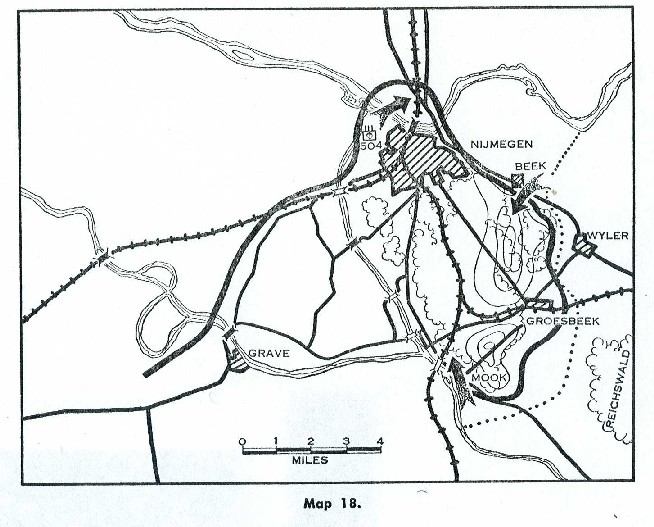
|
Unit |
Paratroop Transport |
Gliders |
Personnel Landed |
|
Div Hqrs & Hqrs Co. |
7 |
12 |
155 |
|
Divison Artillery Hqrs |
3 |
2 |
72 |
|
Division Signal Co. |
2 |
8 |
51 |
|
Division Recon Plat. |
6 |
29 |
|
|
80th Antitank Bn. |
22 |
79 |
|
|
307th Abn Engineer Bn |
27 |
388 |
|
|
376th Prcht FA Bn |
48 |
564 |
|
|
504th Prch Inf Regt |
137 |
2016 |
|
|
505th Prcht Inf Regt |
126 |
2151 |
|
|
508th Prcht Inf Regt |
130 |
1922 |
|
|
325th Glider Inf Regt* |
2 |
40 |
|
|
Totals |
482 |
50 |
7477 |
|
*Advance party for LZ control and pathfinder aides on LZ |
|||
OBSERVATION: 7 x C-47s could drop 154 paras, with 155 paras from HHC, it would be actually overloaded if some of the men were not shifted into gliders. It could be inferred that the 12 x CG-4A Waco gliders were carrying each a Willys 4x4 jeep and driver and/or assistant driver. Artillery Headquarters had 72 men, so its 2 gliders must have delivered perhaps 6 overflow men and 2 x jeeps or 2 x 75mm pack howitzers since 3 x C-47s could only carry 66 men. This could also be 6 men for 2 x jeeps or 6 men and a single jeep + 75mm pack howitzer. Signal company's 2 x C-47s can only deliver 44 paras, so the remaining 7 men spread throughout 8 gliders implies each one of them had a jeep. Recon platoon in 6 gliders with just 29 men screams out 6 more jeeps which we know were somewhat armored, hopefully armed with a .50 caliber heavy machine gun. Recoilless rifles were not available in 1944 which is tragic since a jeep with a RR is in a ready-to-fire condition that could blast enemy infantry positions and even bust tanks without having to stop and get a towed weapon into firing order. Why no one thought of a vehicular mount for a pair of 2.36" bazookas? comes to mind. Unlike the 101st, Gavin has the 80th Antitank battalion with perhaps 11 x 57mm AT guns towed by 11 x jeeps or 22 x 57mm AT guns with expectation to hand tow them or get jeeps from other units with 79 men spread out 3-4 per glider. Gavin, ever the gambler to stack everything for victory, has no medics at all in his first lift. The 388 light Sapper combat engineers in 27 x C-47s suggests 18 paras per plane, hopefully with some door bundles of demolitions explosives. The field artillery battalion's 48 x C-47s for 564 men means 25 "Red Leg" paras per plane plus on 12 x planes a 75mm pack howitzer in pieces taking up what little space left inside and under the plane as an external load. Each Parachute Regiment getting ZERO gliders means they will have ZERO 4x4 jeeps because C-47s can't deliver them, but they can be landed on multiple, uneven terrain drop zones with no concern over flat-ness for gliders to roll to a landing stop---which is why Taylor chose a centralized flat airhead for the 101st that could take gliders to give jeeps to his infantry. Gavin had, we estimate a total of 39 jeeps but probably mostly towing high explosives firepower in the form of 75mm pack howitzers and smaller bore 57mm antitank guns shooting out high-velocity rounds to bust German tanks. Gavin has at the most, 28 jeeps to move a possible 112 men-at-a-time (almost one rifle company) if massed together. To motor tow the 376th FA's 12 x 75mm pack howitzers, 12 x jeeps will have to come from either HHC, Signals or the Recon platoon since the former couldn't drop jeeps with them from their C-47s. Its likely the 376th Red Legs moved their howitzers into static firing positions guarding the Groesbeek heights with their own bodies. With a great respect for the German tank threat and choosing maximum HE and AT firepower, delivered by parachutes into drop zones and not glider landing zones, its clear Gavin's 82nd Airborne should have been given the job to take Arnhem bridge by direct assault north and south of the bridge and hold it from German panzer assisted counter-attacks.
The 82nd air train was preceded by two pathfinder ships that dropped their personnel ten minutes before the arrival of the main body. No enemy was encountered on the DZ so they set up their equipment promptly and laid out the prearranged visual signals; a yellow panel "0" and violet smoke. Among the first to
Advance party for LZ control and Pathfinder aids on LZ.
Page 99
land was the parachute company of the 504th which had the mission of landing on the south side of the Grave bridge and seizing and holding the bridge. In that company was a platoon commanded by Lieutenant John Thompson and as events developed it was his platoon that captured and held the south end of the bridge until contact was made with the regiment on the north side. His account is particularly interesting.
The jump was without incident although spasmodic firing could be heard from the town (Grave). Assembly of men and equipment was accomplished quickly although two of the men had landed in a drainage canal and had a hard time getting out. Radio contact .with the company was immediately tried but we could not get through.
Seeing that we were very close to the bridge and knowing that this was our primary mission, I sent a messenger back to where the company was assembling and told the company commander that we were proceeding toward the bridge. We worked our way down various canals wading in water up to our necks. By this time, firing from the town and the buildings around us had increased considerably and there was now firing coming from a camouflaged flak tower on the southern approach to the bridge.
As we neared the bridge we could see German soldiers running to and from a power plant which was about fifty yards due west of the bridge. They made several trips carrying something in their arms. We waited until they made about three trips and then raked the area with machine-gun fire. Later when we overran the power plant we found four dead German soldiers and one wounded.
They had apparently been carrying their personal equipment and blankets. As we got closer, we were surprised to see two trucks coming down the highway from Grave towards the bridge. My leading scout fired, killing the driver. The truck careened off the road with the German soldiers scrambling to get out. The second truck stopped and the soldiers in it jumped out and deployed. By this time my men had taken up firing, at these Germans but they were evidently trying to get away. We continued to work our way along in defilade towards the flak tower and bridge. The flak tower continued to fire but by now the fire was going over our
Page 100
heads. My bazooka man worked his way forward and fired three rounds, two of them going into the top of the tower. The gun then ceased firing. In it we found two Germans dead and one wounded. We took over the gun and engaged the guns on the far side. All communication wires leading across the bridge were cut and a roadblock was set up at the southern end. About this time, we were surprised to see two automobiles tearing down the highway towards the bridge from Grave. They were destroyed when they got close. Shortly after this, a patrol came from my battalion across the bridge from the north side. Later in the evening we moved down the main highway south of Grave and set up a roadblock. An unfortunate incident occurred about dusk when a large camouflaged tank approached. Someone at the roadblock yelled "British tank" and a lot of troopers got up and ran towards it. It fired four rounds, killing three men and wounding eleven before it withdrew. It was a German tank.
As division commander, I flew in the lead ship of a serial designated to drop on DZ "N." G-3, an aide, communications and headquarters personnel, and Captain Brestebeurje of the Dutch underground were in the same plane. The exact drop point had been gone over with the pilot and other members of the staff. It was understood exactly which field we were to jump into, and assembly in an odd triangular shaped patch of woods was agreed -upon. G-3 and other members of the staff jumped with 536 radios so that they could communicate immediately upon landing.
Loading, take-off, and marshalling went off on schedule and the giant sky train moved out across the North Sea. There was some flak reaction upon crossing the flooded Netherlands coastal area from the German flak positions but it was not very heavy.
Our own fighters could be seen weaving back and forth under the transports searching out ground targets. Everyone felt good to see them; we had been sweating out the ground flak. G-3 stood beside me at the door and we tried to follow our flight route from the unmarked maps that we had and from our memory of the air photos. Mile after mile appeared unfamiliar and identically alike; canals, green fields, and orchards here and there about
Page 101
clusters of red-roofed houses. We had been flying along for some time totally unaware of where we were with the monotony only relieved by an occasional squirt of flak when suddenly below our flight appeared a group of ships flying at an angle from our right rear to our left front. For an instant I thought that they might be German ships since I knew of no such flights planned for our forces. But just when the entire flight was under us chutes began to appear in the sky and it was clearly an American formation.
Again for an instant, I thought that we must be over our DZ area but it looked entirely unfamiliar. In a few minutes, we recognized some landmarks and found that we had drifted south of the planned flight route and that we had passed over the DZs of the 101st. From there on in we followed recognizable terrain features.
The Grave bridge showed up clearly. Crossing the Maas-Waal Canal, a hail of small-arms fire came up from a trench system paralleling the canal, heavy flak could be seen towards Nijmegen, fields and houses that we had memorized were coming into view.
We were down to about four hundred feet. The triangular patch of woods with the adjoining field that we were to jump into came into view and at about that instant the green light came on and out the stick went every trooper landing in the exact field we had planned on landing in.
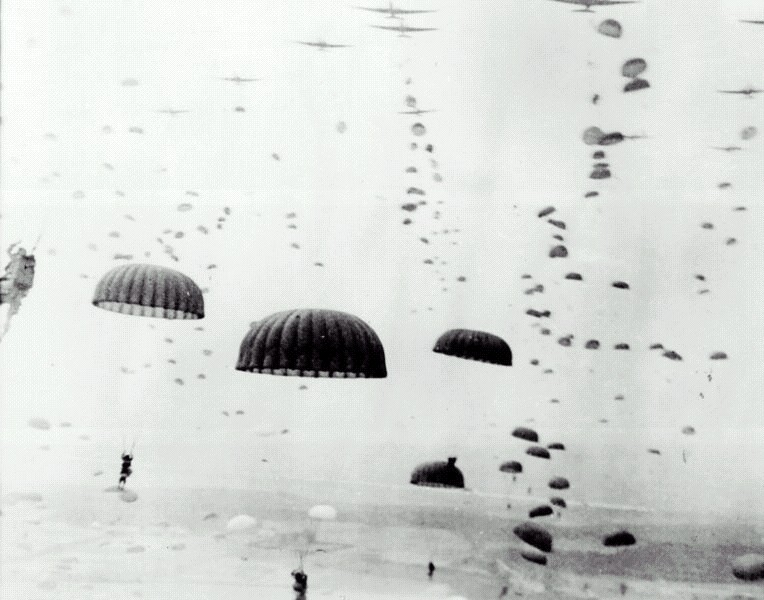
It had been an unusually successful drop. Initial ground resistance was negligible and staff sections were organized and radio communications established with regiments very quickly. Immediately upon landing Captain Brestebeurje went to a Dutch farmhouse and obtained the local enemy situation. There were about two hundred Germans guarding an ammunition storage area in a wooded area beside the DZ which accounted for the small-arms fight that seemed to be taking place. Captain Brestebeurje also called some of the nearby communities by telephone and obtained a firsthand account of the German reaction to the landings. It was an odd situation and a very amusing one and it went on for several days before the Germans took over control of the commercial telephone system. Calls were placed to Arnhem and inquiries made of the success of the landings of the British Division and calls were made to Nijmegen and
Page 102
other nearby towns. In fact, some one on the staff wanted to know why we didn't call Berlin and talk to Adolf Hitler. I suppose that we could have in the first twenty-four hours but there were other far more important things to do.
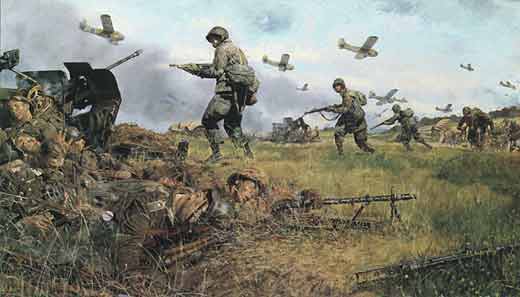
The D-Day landings were unquestionably the best in the history of the division. A few ships were shot down by heavy flak near the DZs but the pilots kept their ships on course and flew them in regardless of the flak. On DZ "T" the 508th jumped right upon a flak battery scattering the gunners in all directions, killing those that they didn't capture. One lieutenant of the regiment landed near Wyler some distance away from the planned DZ. While moving toward the assembly area he came across a flak battery busily engaged in shooting at the transports overhead. His platoon attacked and destroyed the flak positions in short order. The battery lacked security against ground attack. This was the first opportunity that the division had had to experience a reasonably heavy flak attack in a daylight drop. It had been pretty generally conceded that such a thing would be disastrous to the air formation. It was surprising therefore, and a source of some gratitude, to find how well flak batteries could be handled by small parachute units jumping directly upon them.
OBSERVATION: that air defense units have their heads-in-the-clouds means that we should NOT drop from the sky upon them where they are looking, but attack them HORIZONTALLY from an indirect, offset drop zone where they are not looking. Gavin in his later 1958 book, War and Peace in the Space Age says guided surface-to-air missiles (SAMs) mean the end of manned bombers against prepared enemies. If that is the case against bombers flying at 600 mph, then SAMs on the ground---even man-portable ones are even more of a show-stopper to much slower transport planes at 150 mph and just 500 feet above the ground. Gavin's observation here that the 508th was able to take out enemy AA gunners is proof positive that we need to NOT land on top of objectives especially held by enemies with SAMs but take out these defenses horizontally. Today our paratroopers need not be at a 1940s foot-slog handicap that Gavin tried to work around by direct delivery on objectives; with M113 light tracked AFVs named in his honor, he has enabled offset DZs to be used to avoid enemy missiles and the distances to objectives rapidly closed on via armored, cross-country mobility.
All units of the division moved promptly on their separate missions upon landing. By dusk, the Grave bridge was safely in the hands of the 2nd Battalion, 504th, while the 1st Battalion of that Regiment was busily attacking. the bridge over the Maas-Waal Canal at Molenhook six miles to the east. The 1st Battalion, 504th under the command of Lieutenant Colonel William Harrison, up to this point a two-time winner of the DSC, moved rapidly from the battalion DZ towards the bridge. As the point approached the bridge a German ran across the bridge towards what appeared to be, and later was found to be, a control building containing the manual means to blow the bridge. He was knocked down halfway across the bridge. By keeping the bridge under fire and slowly working in, the leading unit finally managed to drive the German defenders into a house on a small island on the locks of the canal. Then by keeping them pinned down by firing into the
Page 103
house the troopers managed to get onto the bridge and cut the wires and remove the charges that could be found. At 7:30 pm, the division reconnaissance platoon which had landed on DZ "N" drove all the Germans out of Molenhook and approached the bridge from the east and made contact with the 1st Battalion, 504th. Thus the bridge that was vital to the interior communications was captured intact. Several days later the Germans made a very determined effort to recapture it by driving up from Mook.
As it turned out this was the only bridge over the canal captured undamaged. The next bridge to the north was destroyed on D-Day as the troopers approached it and the 'Same fate befell the next bridge north.
OBSERVATION: the recon platon was able to surprise the enemy and get the bridge because they moved fast by 4x4 jeeps--partially armored---but light enough to float over cross-country terrain.
One of the most interesting units to land with the division was the 376th Parachute Field Artillery Battalion. This battalion, equipped with twelve pack 75s, although a veteran combat battalion and made up of old jumpers, had never entered combat as a parachute field artillery unit. There was considerable doubt in' the minds of most higher commanders of the merits of this type unit, its only saving grace compared to glider artillery was that it could be dropped from 48 x C-47s that would only occupy four minutes of air space whereas a glider battalion required 95 x C-47s as tugs and occupied fifteen minutes air space. In past operations, on the ground on landing it was usually badly scattered and took considerable time to reorganize and start firing. Parachute artillery didn't fare too well in Sicily and Normandy. But in operation MARKET the available air lift was limited, it looked as though artillery would come in very handy the first twenty-four hours, so the decision was made to take it in by parachute. As it worked out, the battalion was assembled and firing as a battalion in a little more than an hour after landing the afternoon of D-Day. It more than justified the expenditure of aircraft to bring it in. It is an interesting aspect of an airborne operation that artillery is comparatively more effective than it is in any other type operation. The reason being that the type of units that are first committed against airborne landings are local police, militia, home guards, etc. A battalion concentration will make them so ineffectual that
Page 104
they are not worth much for some time. Numerous small but highly spirited attacks were made or planned by the Germans the first day in the Nijmegen area but they were rapidly demoralized by a good artillery concentration and in many cases didn't get in threatening distance of the Infantry.
The center regiment, the 505th Parachute Infantry, commanded by Colonel William E. Ekman, captured Groesbeek with little resistance and then organized its defense as planned, extending from Mook to Heikant. Contact all along its front was made by dark with polyglot enemy units. Two threats appeared to be taking serious shape, one an enemy drive up the main road towards Mook and another up the main highway from Kranenburg to Groesbeek. But by dark all was reasonably quiet and the defense was improving by the hour.
Farther to the north and east was the 508th Parachute Infantry commanded by Colonel Roy Lindquist. It had a particularly difficult mission, possibly the most difficult of the three. First it had to hold DZ "T" for the landing of the gliders on D plus 1. Next it had to hold the high ground from Wyler to Nijmegen and establish several strong roadblocks along the base of the hills this side of its front alone was approximately six miles long. Next it was to assist in capturing the two northern bridges over the canal, those at Hater and Honinghutie. It was to completely clear up the assigned sector of enemy. Its last task was the most interesting and its solution will always be the most controversial; the capture of the Nijmegen bridge.
Up to the final twenty-four hours before take-off it appeared, from a frequent study of enemy dispositions in and around Nijmegen, that it would be impossible to capture Nijmegen and the big bridges there with anything less than a very strong attack, at least a regimental combat team. Obviously this couldn't be spared if the division was to accomplish its other missions. Just before take-off, however, I discussed the situation with Colonel Lindquist and directed him to commit not more than one battalion to the seizure of the Nijmegen bridges as soon as possible after landing, so as to take advantage of both surprise and dark-
Page 104
ness. He was given full authority to stop this attack if the degree of enemy resistance from other directions made it appear that might not be able to hold the remainder of his sector. He planned accordingly and shortly after 1800 hours D-Day when the situation in the regimental sector appeared to be in hand he ordered Lietenant Colonel Shields Warren, commanding the 1st Battalion, to move into the city and capture the bridge. The battalion was to accompanied and assisted by members of the Dutch underground. The underground knew where the building was located that contained, so they said, the controls to the demolition charges in the bridge. This was ordered destroyed. Moving out about 2231 with A and B Companies in the lead little interference was encountered until they were about halfway through the city. Hert several incidents took place the sum total of which resulted in the force making little further progress. After guiding them into the middle of the city, the underground guides apparently abandoned the battalion and may have, judging from subsequent events, betrayed them to the Germans. In any case, the battalion succeeded in destroying and burning the control house before being stopped where they dug in. They made no further progress during the night and at daylight, were hard-pressed by Germans in surrounding buildings.
Dark descended on the division airhead with its defenses rather well in hand. Communications were in, patrols out, artillery ready to shoot in any direction and most important, the Grave and Molenhook bridges were in our hands and in good condition.
During the night an incident took place that was for many one of the most amusing of the war. It is not with pride that the story is told since it reflects unfavorably on the tactical training of the individuals concerned, but it is of interest. All of the division had been going at high speed for several days prior to the jump and this day climaxed it. Sometime around midnight I lay down beneath a tree to get some sleep. I fell asleep instantly it seemed and had been asleep for some time when I heard a locomotive whistle. I It was quite close and its long shrill plaintive wail stirred nostalgic memories of other places. Suddenly, I realized that a train had
Page 105
no business being that near the command post in this situation; it was less than a hundred yards away, and at about that instant I heard G-3 call the front-line regiment near Groesbeek. Yes, the train had come into the sector. No, they hadn't established a block or mined the tracks and no one shot at the train. They all must have been too surprised. The train had gone merrily on its unhindered way right out of the northern side of the division sector and into Germany. Everyone was alerted and the stable securely bolted now that the horse was gone. Fortunately, for the personal satisfaction it gave some, another train arrived from the north an hour or so later and steamed right into a railblock. A bazooka man scored a direct hit on the locomotive and everyone started shooting at once. A few hours after daylight the last German stragglers from the train were rounded up. It isn't every locomotive that can get away with steaming through a division airhead without the wave of a curious spectator or a hostile shot. But the transition from peaceful conditions that prevail at take-off airfields to a combat airhead is sudden, unreal and exceedingly difficult for troops to adjust themselves to. Small-unit commanders must be realistic, imaginative and aggressive in their attitude towards the enemy, however nebulous that enemy may at first appear.
The story is told, and it actually happened, of another unit in another division in the Holland operation that was marching down a peaceful country lane not long after landing. A motor vehicle was heard to approach from the rear. It sounded no different than any other motor vehicle had sounded on the many marches that the unit had taken in the memory of the individuals marching down the road. Someone shouted, "Move over to the right and left, clear the road." It was not until the vehicle had almost completely passed the column and the grenades that its occupants had tossed out in passing were beginning to detonate, that the marchers realized that it was a Kraut armored car. Incredibly strange things can happen in airborne combat. Shortly after daylight D plus 1, I talked to Colonel Warren, commanding the 1st Battalion, 508th, at his CP in the Marienboom school in Nijmegen. The situation didn't look good. His
Page 107
battalion was broken up into small groups in the city, there were far too few troopers for the task at hand. There was a possibility of outflanking the Germans to the east so Colonel Lindquist sent G Company in on that side.
In the meantime one of the 508th platoons was having a very hard fight at the Honinghutie bridge. Word was sent to the CO, 504th, to get something, even a small patrol, up there right away and hit the bridge from the west side. In about an hour after the 508th force had taken very heavy losses and were settling down to an even terms fight with the bridge defenders a patrol approaching from the west was able to walk right out on the bridge and fire into the rear of the Germans who were completely preoccupied with the fight to the east. Repeatedly in this operation it was demonstrated that the proper technique in bridge combat is to attack it from two directions.
What started out to be a rather promising day, however, soon changed. About mid-morning a German attack from the direction of Kranenburg had overrun the one company of the 508th that was holding the DZ north of Wyler. This could be serious. The DZ was to be used for our glider landings about noon. In an hour, an ammunition dump established at the time of landing was reported overrun and captured. There were few defenders for the several miles of front on this side of the airhead. The fight was increasing in intensity all along the Wyler-Beek ridge and especially along the Wyler-Groesbeek front. It looked as though a German penetration was about to materialize north of Groesbeek. If they succeeded in driving into the woods north of Groesbeek we couldn't begin to hold them with the few troops we had. They had to be kept out in the open where we had fields-of-fire. The division reserve consisting of two parachute engineer companies was thrown into the estimated shoulder of the German attack.
The attack on Nijmegen by the 1st Battalion and Company G was stopped and all of the 508th, except a small covering force, was ordered to attack and clear the DZ at Wyler. By noon, the entire counterattack was under way and shortly thereafter the glider
Page 108
landing zone was cleared. It was cleared but it was no-man's land and was under seemingly incessant fire.
Around noon, midst a hail of small-arms and artillery fire, the D plus 1 glider lift of 450 gliders arrived. They carried three artillery battalions, the remainder of the antitank battalion, the division medical company, command vehicles for the infantry regiments, and the remainder of division headquarters and signals. Casualties were surprisingly light and by mid-afternoon combat teams were organized and the tactical prospects of the division appeared to improve. But for the time being every trooper available was needed to hold the Mook-Groesbeek-Wyler-Beek front. The German attacks were increasing in extent, intensity, and duration.
So far the reaction of the defenders had followed a rather definite pattern. Immediately following the landings, reconnaissance vehicles approached the airhead area from different directions with some caution. Generally they stayed to the main roads.
They were immediately followed by hastily organized and very poorly conducted attacks. Most of the prisoners told the same story. They were grabbed wherever they were, put into trucks, taken to a place like Kranenburg and unloaded and told to attack the parachutists. They were told that the parachutists were without arms in many cases and were without artillery, and that . all that they had to do was to "go and get em." The first attackers were soldiers on furlough, soldiers convalescing in hospitals, home guard battalions, etc. Invariably they were not up to the job given them and they were very roughly handled by the defenders. As a matter of fact, it was not until D plus 3 that a coordinated attack was made against the airhead on a divisional scale. An officer casualty was captured with the attack order on his person and the attack had been following it accurately. It was staged by the German 6th Parachute Division and contemplated a double envelopment of the Beek-Mook front by driving in at Beek and Mook with a combat team at each town.
The daily supply run on D plus 1 had come in about ten minutes after the gliders. It consisted of 135 x B-24s and about 80% of
Page 109
the supplies was recovered. A great deal of it was recovered after dark since much of it landed in no-man's land. This daily delivery of supplies was absolutely vital to the division. Medical supplies and ammunition, especially artillery ammunition, had to be carefully conserved. Parachute resupply is at best an emergency resupply means. Gliders are far more efficient if they are available. Actually it takes about one-third of a combat force to recover and handle resupply by parachute. This is because it is so widely scattered, there is so much of it, and either transportation cannot be used because of hostile fire or it is not available. Glider pilots of the IX Troop Carrier Command were used in supply recovery and rendered a real service in the handling of parachute supplies in this operation.
The remainder of D plus 1 was spent in improving the defense and getting the underground forces in Nijmegen organized to save the bridge. Captain Brestebeurje set up an underground headquarters where plans were laid and arms issued. Arms were taken from wounded and dead troopers and turned over to the underground. They had promised that given arms no German would get near enough to the bridge to place or blow a manual charge. They kept their promise although a number of them were killed in doing so.
D plus 2 promised to be a better day. British Airborne Corps reported that contact with the reconnaissance units of the Guards Armored should be made early that day. Actually first contact was made at the roadblock south of Grave at about 0830 hours by the 2nd Battalion, 504th. The main body of the division did not start arriving until noon. Plans were immediately made to concentrate the 504th near Nijmegen to assist in the attack for the big bridges.
The division reserve, the 2nd Battalion, 505th, commanded by Lieutenant Colonel Vandervort, was at once committed to the capture of the bridge via Nijmegen. By dark a battalion of the Guards Armored Division was assisting him and they had driven to within a city block of the southern end of the bridge.
On D plus 2 the daily parachute resupply was delivered to DZ "0". The ships flew rather high and the supplies were badly scat-
teredo It had been expected that the Glider Infantry Regiment of the Division would arrive this day, but bad weather over England and the Channel made it impossible. This was most unfortunate, since it was badly needed. It is dangerous in planning an airborne operation to gamble with weather and the final outcome of the operation. Enough means to prepare the initial task should be delivered in the initial landings.
This terminated the purely airborne aspects of operation MARKET for the 82nd Airborne Division. By this time, over six hundred wounded were lining the halls of the division hospital in Nijmegen and the division had suffered over one hundred and fifty dead. The fighting had been bitter and costly, but everyone felt that he had done a good job. But, as is usually the case in an airborne operation, the hardest fighting was still ahead.

The following day the Grenadier Guards Battalion and the 2nd Battalion, 505th, attacked the southern end of the Nijmegen bridges and the 504th Parachute Infantry supported by the Irish Guards Battalion made an exceptionally gallant attack across the broad, bullet-swept expanse of the Waal River and seized the northern end of the bridges. Thus, the way was opened to Arnhem. There a critical and courageous fight was being made by the gallant British 1st Airborne Division.
THE BRITISH 1ST AIRBORNE DIVISION
Veterans of many months of fighting in Sicily and Italy, the rugged, tough troopers of the 1st British Airborne Division were waiting their call in the Berkshire Downs and Salisbury Plain country of England in mid-September of 1944. Commanding the division was Major General R. E. Urquhart, C.B., D.S.O., a veteran of considerable combat experience; quiet and determined in manner and an officer of great courage, his was to be one of the most difficult airborne missions of the war.
The mission assigned the 1st Airborne was simple and to the point, yet, as events proved, fraught with complications. It was "to capture and hold the bridge over the Lower Rhine at Arnhem until relieved by the British Second Army."
Page 110
Map 19.
The density and weight of the flak in the immediate vicinity of the bridge (see Map 14) made it appear inadvisable to the division commander to attempt a large-scale landing there. Beyond the immediate range of the heavy flak the available DZs were few, poorly located in relation to each other, and of dubious merit. A thorough study was made of the situation and the DZs finally selected are shown on map 19.
OBSERVATION: Gavin's parachute-centric 82nd Airborne could have and should have dropped directly onto north and south of Arnhem bridge at NIGHT to evade AA defenses which should have been taken out by bombers beforehand. Another option would have been a high-altitude, stand-off glider coup de main attack like the British 6th Airborne did to take the Orne river canals or the Germans at Eban Emael.
www.airpower.maxwell.af.mil/.../cc/torrisi.html
In 17 November 1999, Air & Space Power Journal - Chronicles Online Journal, "Gliders - Rethinking the Utility of these Silent Wings for the Next Millennium" by Steven A. Torrisi writes:
It was planned to land the 1st Air Landing Brigade by glider three miles north of Heelsum from where it would first provide security for the landing zones for the D plus 1 lift, and second, occupy a perimeter defense around Arnhem itself. Just south of the landing zone of the 1st Air Landing Brigade, the 1st Parachute Brigade was to land with the mission of moving directly on the Arnhem bridge. It was to seize and hold the bridge until relieved, it being anticipated that the Polish Brigade landing immediately south of the bridge on D plus 1 would move across the
Page 111
bridge and effect the relief of and reinforce the bridgehead. Thus, the defense would consist of two half circles with their center at the bridge. The outer circle was the 1st Air Landing Brigade and the inner circle was the 1st Parachute Brigade. The 1st Air Landing Brigade had the added mission of securing the landing zones until the arrival of the subsequent echelons of the Division.
Where to drop and land these two brigades was one of the most critical decisions made during the entire operation and one of inordinate interest to every student of airborne operations. Few decisions are ever of greater importance than those having to do with the selection of DZs in relation to each other, objectives and terrain and troop allocation and rate of build-up in each DZ.
While admittedly it is easy to "Monday morning quarterback" an operation, I remember very well, hearing division staff officers of another combat experienced division discuss this aspect of the 1st Division's plan before going in and concluding that the division was undertaking a plan that they would be reluctant to attempt. Restricted in the selection of suitable DZs by habitations, woods and flak, the problem was a difficult one. It took great mental courage to attempt execution of the plan in the form in which it finally resolved itself.
OBSERVATION: then this is where you FIX the weak immobile force structure of foot-slogging paratroop units. The British had no excuse, they had Hamilcar gliders that could have landed enough Bren gun personnel carriers and Tetrarch or Locust light tanks to move the 6-8 miles and bust through any enemy opposition. If you are going to use an offset DZ due to enemy air defenses being too strong for direct delivery, then you have to compensate by having MOBILITY to rapidly traverse this horizontal distance.
The parachute and glider lift for the 1st Division, including the Polish Brigade, is shown in the table below. Since the planned schedule was badly disrupted by weather, the actual delivery rate is shown. Especially noteworthy is the fact that the Polish Brigade which was assigned the vital mission of seizing the southern end of the bridge did not land until D plus 4 and even then most of the brigade failed to arrive at the proper DZ.
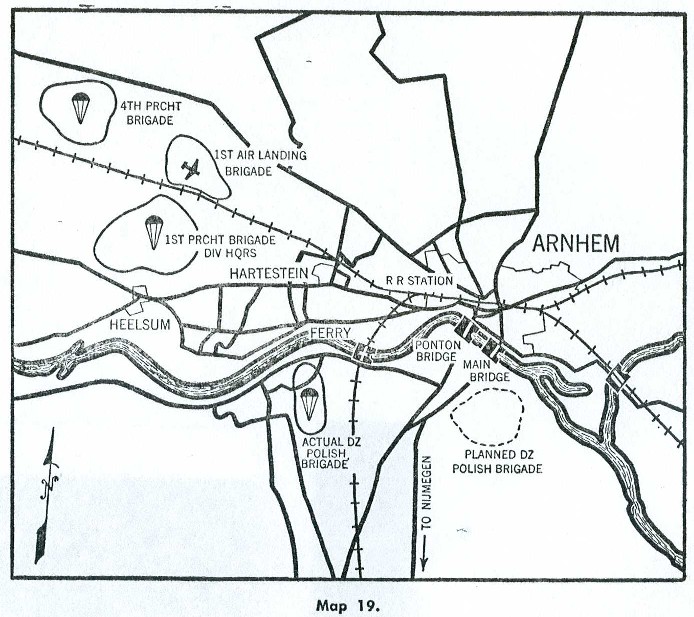
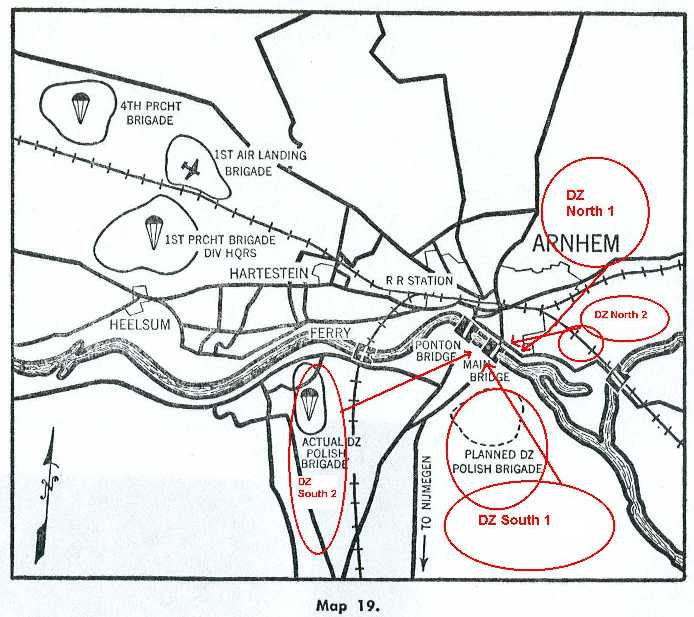
Though tied to the American concept of airborne operations, their British counterparts found they rapidly achieved their task if they deviated toward the German model. Nowhere is this more evident than in a comparison of Operations Deadstick and Market-Garden. Deadstick pulled off a D-Day coup de main against the Orne River Bridges in Normandy. Six gliders landing in total darkness, only yards away from the two inter-connected bridges, provided the means for a single infantry company to rush the bridges, assault the garrison, and capture these vital transportation arteries, all within twenty-five minutes. Simultaneously, three gliders set down a platoon of combat engineers nearby, and though out-gunned, destroyed a coastal gun battery after fierce hand-to-hand combat. Less than three months later in Holland, the British were quick to forget the success of Deadstick. during the rushed planning and execution of Operation Market-Garden. Assigned an LZ inconsistent with its earlier action, located some eight miles from the objective - Arnhem Bridge, the glider, received unfounded criticism for hampering its seizure by the reconnaissance squadron of the 1st Airborne Division. Colonel Charles S. Chatterton, (CO, the Glider Pilot Regiment) when questioned on the matter after the war, recounted his wartime assertion on the need for an Orne River Bridge-type coup de main: "I saw no reason why we could not do it, but apparently nobody else saw the need for it, and I distinctly remember being called a bloody murderer and assassin for suggesting it."
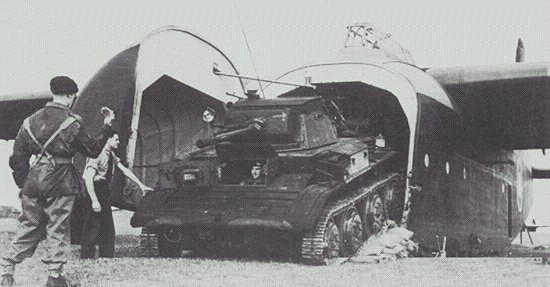
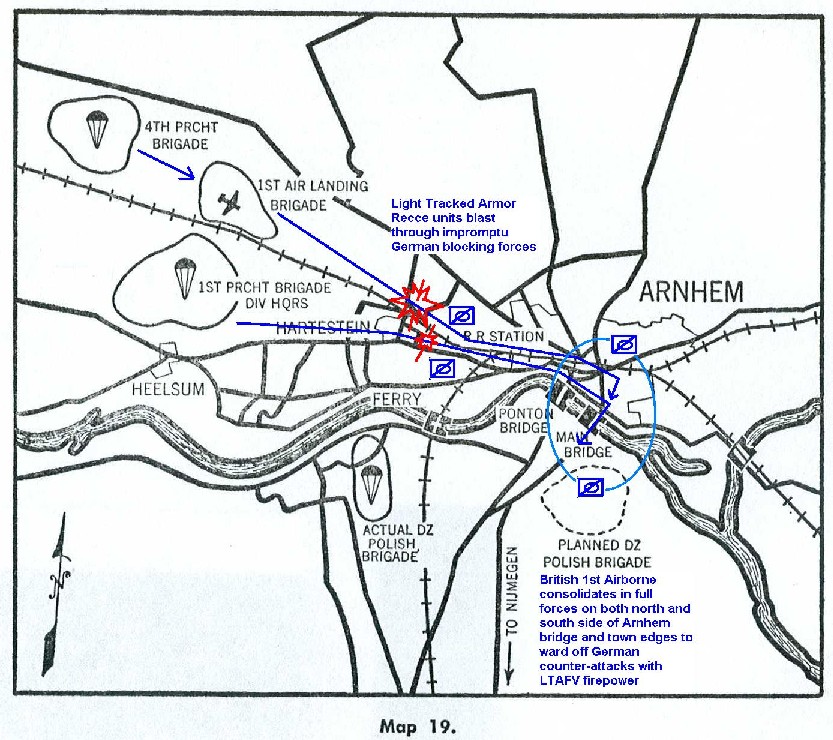
|
D-Day |
||
|
Parachute Transport |
Gliders |
|
|
Pathfinders |
12 |
|
|
1st Div. Hqrs. 1st Prcht. Brig. 1st A.L. Brig. (-) Arty, AT, Engrs. |
143 |
320 |
|
D Plus 1 |
||
|
Parachute Transport |
Gliders |
|
|
1st Div. |
||
|
4th Prcht. Brig. Balance of 1st A.L. Brig. |
126 |
256 |
|
D Plus 2 |
||
|
Parachute Transport |
Gliders |
|
|
Hqrs. Polish Brig. |
31 (44 dispatched)* |
|
|
D Plus 3 |
||
|
Parachute Transport |
Gliders |
|
|
None |
None |
|
|
D Plus 4 |
||
|
Parachute Transport |
Gliders |
|
|
Polish Brigade |
57 (110 dispatched)* |
|
The pathfinders took off in twelve Stirling bombers at 1015 hours Sunday morning, September 17 under command of Major B. A. Wilson. A pioneer in troop carrier-parachute pathfinder technique, he had worked with U.S. airborne troops in Africa and had accompanied us on many of our training exercises. The crossing was without event, only one ship being fired at, and the pathfinders, arrived at their designated drop zones with little opposition. Two troopers were hit during descent, one in his ammunition pouches and the other in his haversack. Neither was hurt.
The 1st Parachute Brigade consisting of three infantry battalions and a squadron of Royal Engineers all under the command of Brigadier G. W. Lathbury landed on schedule and moved at once to their allotted task.
Their plan was most interesting: The 2nd Battalion commanded by Lieutenant Colonel Frost of North Africa and Sicily fame was to move by way of the road along the bank of the Lower Rhine directly and speedily to the bridge. The next battalion, on the north, the 3rd Battalion, was to move, echeloned somewhat to the left rear of the 2nd Battalion to the bridge. It was to assist in capturing the bridge by attacking it from the north and provide flank protection for Frost's battalion. The remaining battalion, the 1st, was
* The marked disparity between the number that arrived and the number that was dispatched was due to many things, principally the greatly intensified flak starting about D plus 2.
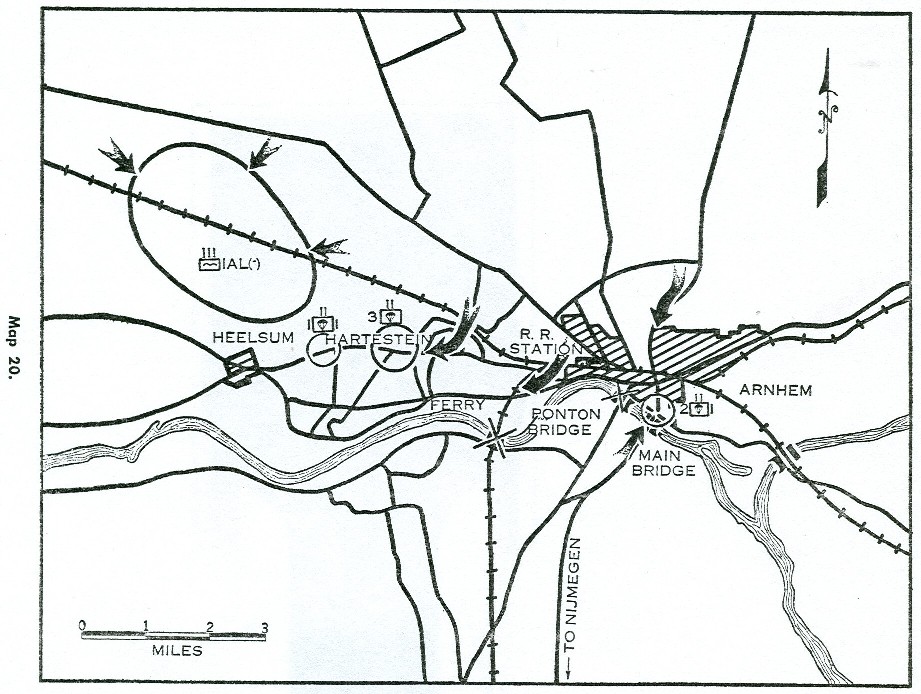
Map 20.
to be in Brigade reserve to be used to assist either column depending on the actual development of the advance. (see Map 20.) Frost's battalion moved speedily like the veteran parachute battalion it was. Spotty opposition was promptly dealt with. As they arrived at the northern end of the railroad bridge, to use the description of one of the survivors, "it seemed to curl back on
Page 114
us" It was blown in the nick of time by the Germans. Between the railroad bridge and the road bridge heavy fighting took place but by enveloping to the south and keeping close along the river bank A Company entered the city proper. By eight o'clock the bridge was in sight. It was intact and German transport was moving across it. The northern end of the bridge and the buildings dominating it were immediately seized and prepared for defense. An attempt was made to rush the southern end of the bridge but was stopped by heavy antiaircraft and armored fire. The night was spent in consolidating the defense and by dawn Frost had under his control a mixed force of between 600 and 700 men including some 57mm AT guns.
Back toward the drop zone, however, the remainder of the division was not faring too well. The 3rd Battalion which was on the left of Frost's battalion barely got away from the drop zone when it ran head on into German infantry accompanied by two armored cars. Unfortunately, the 57mm AT gun accompanying the battalion was in tow and while the crew was attempting to unlimber it and turn it around it was knocked out.
OBSERVATION: towed guns are inadequate in a meeting engagement!
How Jeep-Towed AA/AT Guns Failed the British on the way to Arnhem
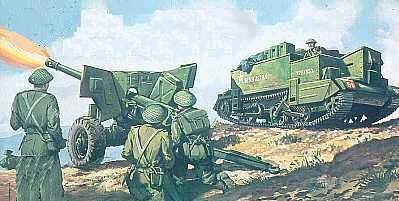
Even if your gun is towed by an ARMORED track, there's no guarantee that enemy fire will let you get out to put it into action
A mere pair of armored cars and some training students with rifles stopped two elite parachute battalions from reaching Arnhem bridge to reinforce LTC Frost who took an unopposed route. LTG Gavin reports that their jeeps towing AT guns couldn't get into return fire condition against the ready-to-fire armored cars. We know that Freddie Gough's Recce Squadron towed Polsten AA cannon. Whatever gun types they were towing, this inability to immediately return high explosive cannon fire to ward off a mere pair of armored cars RESULTED IN THE DEFEAT OF AN ENTIRE BATTLE EFFORT WITH STRATEGIC NEGATIVE CONSEQUENCES.
Most everyone thinks the Germans are the epitome of military efficiency so let's see how long it takes them to stop, unlimber and put into action a small 37mm towed anti-tank gun.
Watch video at full speed fast forward to 9:30:
 www.youtube.com/watch?v=tpJhxW9tnWU
www.youtube.com/watch?v=tpJhxW9tnWU
The small unarmored, wheeled truck stops at 9:32.
Still Sequence
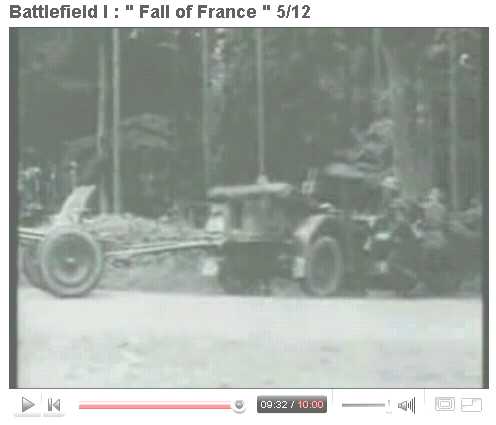
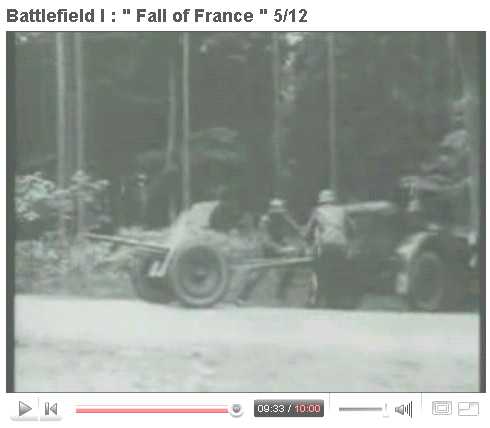
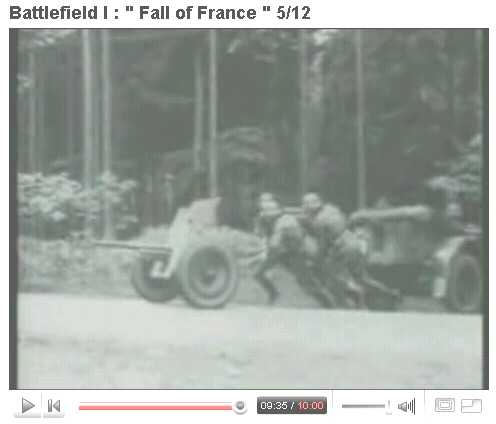
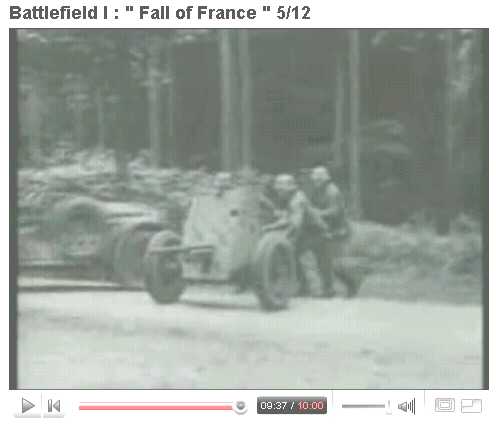
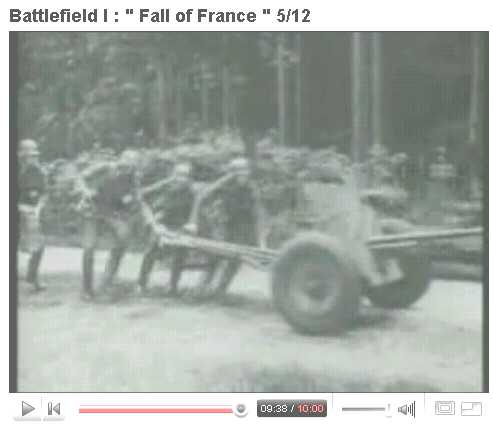
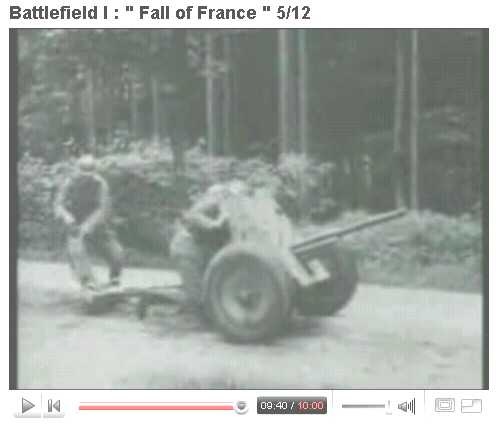
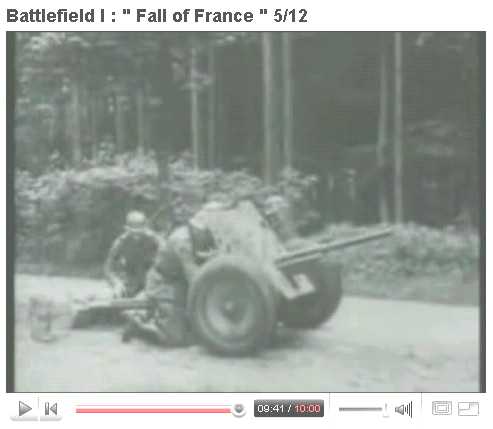
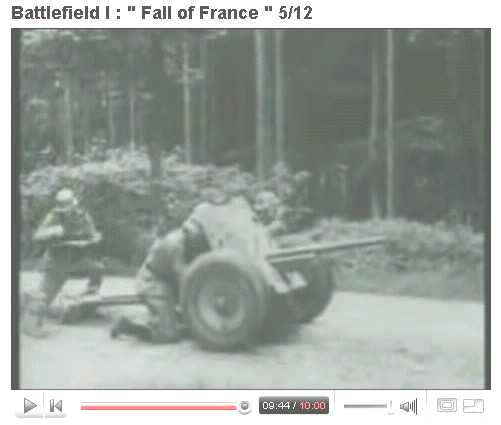
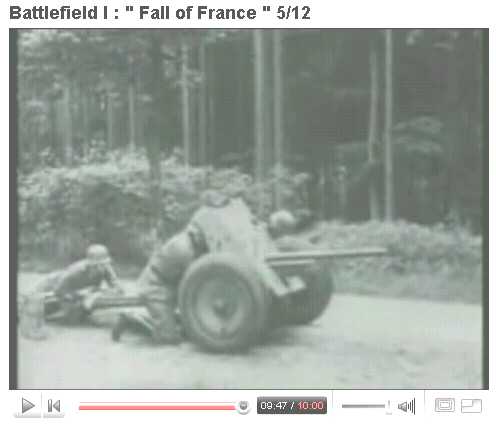
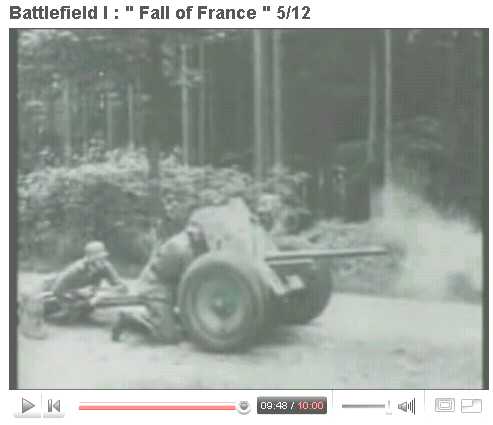
The AT only fires what looks to be one round already in its breech at 9:48, so it takes 16 seconds under ideal conditions to get a towed AA/AT gun on a paved road into action. A less efficient crew would take longer. In a meeting engagement when the enemy spots you or you spot them and both sides open fire, the towed AA/AT gun crew cannot return fire for a fatal 16 seconds. A lot can go wrong.
1.) Crew is killed and truck/towed gun destroyed before they can dismount
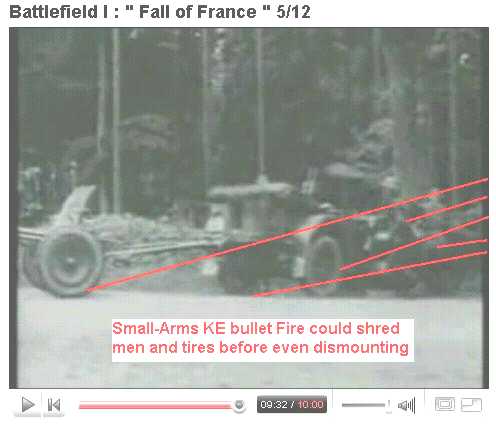
2.) Crew is killed after they dismount, truck and gun still vulnerable to destruction
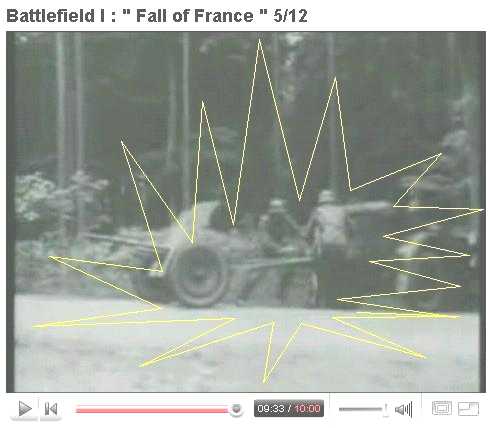
3.) Crew is only safe from frontal small arms fire 15 seconds later by virtue of a gunshield (U.S. towed guns no longer have these today) , but bullets can shred the gun's tires and immobilize it
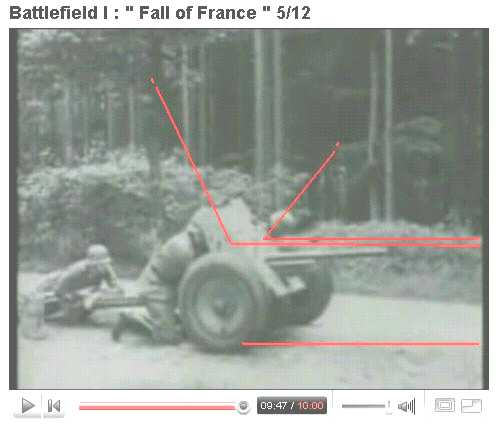
4.) Any high explosive near-miss BEHIND the gunshield wounds and kills the crew
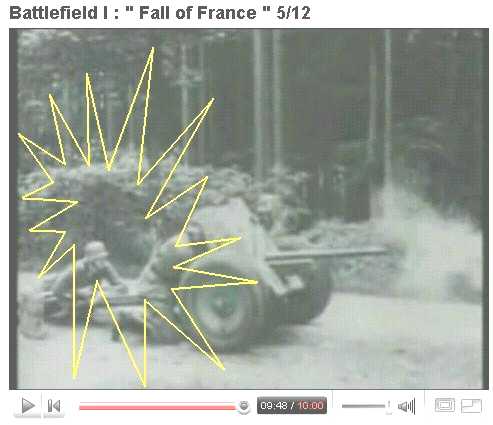
The Airborne needed then and still needs today a "MINI-STUG" if not a turreted light tank then at least a tracked armored vehicle with a large caliber gun in a fixed mounting that can turn and immediately blast through enemies. LTG Gavin's advocacy while in PROJECT VISTA of the Ontos with 6 x 106mm forward-firing on the hull verifies he understood the need for vehicles immediately ready to return fire in event of meeting engagement. The British had attached guns to their Bren gun carriers so why a 75mm pack howitzer couldn't be mounted is a good question that demands answers. The failure of the British to concentrate in force on Arnhem bridge damns the entire operation! Had the 1st and 3rd battalions reinforced Frost at the bridge they would have held out long enough for even the tardy XXX Corps to arrive and link-up.
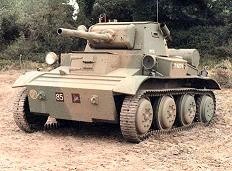
Tetrarch Light Tank
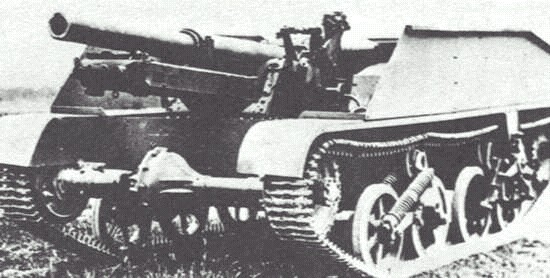
Here a 25-pounder AT gun on a Bren could clearly have blasted through even German medium and heavy tanks blocking the way to Arnhem bridge...
One company sideslipped to the right and finally made its way to the bridge and joined Frost's battalion; the remainder of the battalion, however, did not advance beyond the scene of its first fight until just before dawn D plus 1. It then advanced apparently without much opposition into Arnhem as far as the railway station. This was the limit of this battalion's advance. Here it was hit in the flank from the left, heavily engaged from the front and finally almost surrounded. It could not contact Frost's battalion holding the bridge.
The 1st Battalion, the brigade reserve, followed in the wake of the 3rd Battalion moving down the railroad. It soon became engaged with a large force of enemy that brought heavy pressure against its left flank. Despite strong counterattacks to the left to protect that flank the German pressure was unremitting, well supported with armor, and growing in weight and intensity. By 1800 D plus 1 the battalion was reduced to about a hundred men and was almost out of ammunition. It could not gain contact with Frost's battalion at the bridge.
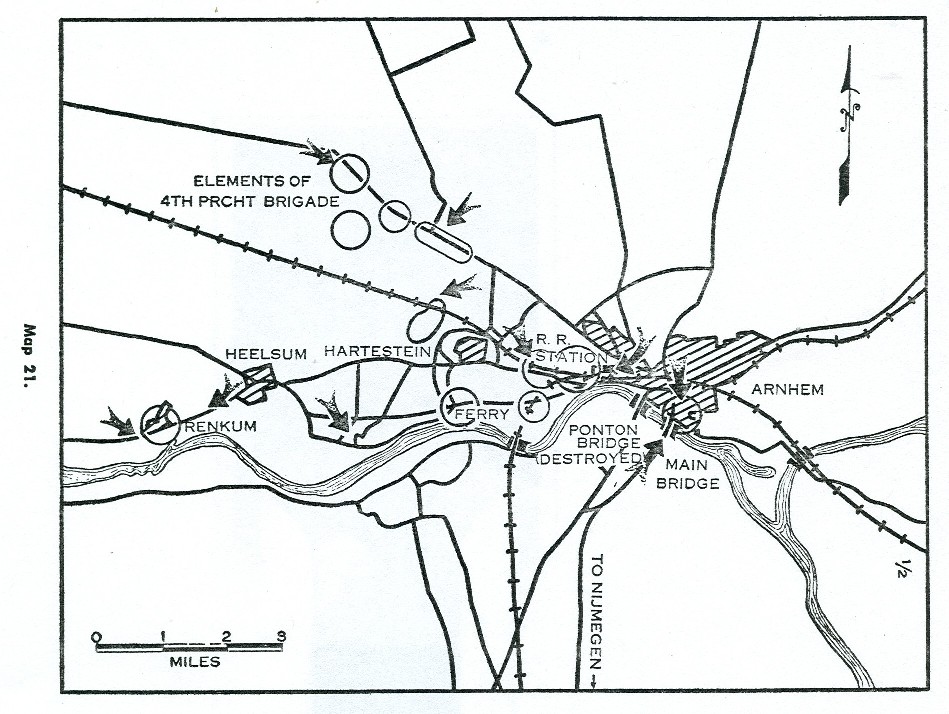
Map 21.
OBSERVATION: WHY IN THE HELL is the 1st Battalion reinforcing FAILURE? Why didn't it follow SUCCESS and Frost's route to the bridge? Where were their folding bicycles to rapidly move in a new direction at 10-25 mph speeds?
 www.youtube.com/watch?v=o44BvtQxOV4
www.youtube.com/watch?v=o44BvtQxOV4
The 1st Air Landing Brigade and Division Headquarters landed just ahead of the 1st Parachute Brigade. Consisting of over seven hundred men and forty officers the Air Landing Brigade was clear of the DZ by three o'clock. A novel method of assembly was accomplished by the British in having the piper of the brigade
Page 116
march up and down the rendezvous area playing the regimental march "The Blue Bonnets over the Border." Upon assembly the brigade promptly set about its first mission, that of securing of the dropping zones. During the afternoon and night, it was attacked several times by large German forces. The mortar fire was particularly intense and some units lost all of their vehicles. This force became too fully involved in the security of the landing zones, however, to attempt the establishment of any part of a perimeter around Arnhem on D-Day or D plus 1.
OBSERVATION: Airborne forces need light tracked ARMORED fighting vehicles not flimsy, unarmored jeeps with air-filled rubber tires easily knocked out by ANY enemy fire
Thus at the end of the first twenty-four hours of fighting, the northern end of the bridge was held by one battalion, although the situation of that battalion was becoming increasingly precarious. Two battalions were completely dissipated trying to contact the bridge battalion and at the same time maintain communications with the landing area. And two battalions were securing the DZ area for the second echelon due to land on D plus 1.
The second air lift arrived uneventfully. Brigadier Hicks, who was acting as division commander in the absence of General Urquhart-General Urquhart was involved in the fighting of the 1st Parachute Brigade and for quite a period of time was closely restricted in movement by enemy fire-directed the commitment of the now complete 1st Air Landing Brigade. Two battalions were to follow almost in track of the two parachute battalions of the preceding day in order to relieve them and reinforce the bridge. German opposition, however, had materially increased, especially in armor, and these battalions made no farther progress than the parachute battalions of D-Day.
Thus, actually, the pattern for the final battle of Arnhem was set. One battalion was on the objective due principally to its speed of movement and superb tactical handling by Lieutenant Colonel Frost. Four battalions were well-scattered between the landing zones and the objective, a distance of some five or six miles. These battalions unfortunately could neither relieve the bridge battalion nor hold the tenuous corridor from the bridge to the landing zone. The remainder of the force was in reserve and endeavoring to hold the resupply drop and landing zones against an enemy who
Map 22.
was rapidly gaining strength and had long since divined the intention of the airborne force. In the days that followed, the enemy flak built up to such intensity that General Urquhart recommended to General Browning, the airborne corps commander at Nijmegen, that the Polish Brigade be landed farther down the river than as originally
Page 118
planned at the southern end of the bridge, nearer the Heveadorp Ferry. This was done on D plus 4 when 57 planes of Polish paratroopers jumped immediately south of the 1st Division pocket at Hartestein. The Germans had in the meantime, however, captured the northern end of the ferry.
The battalion, under the command of Lieutenant Colonel Frost, fought courageously and well denying the German forces the use of the bridge until the last defender was overrun. By afternoon of the 21st, D plus 4, the force was reduced to about 110 men and five or six officers, nearly all were wounded, Colonel Frost very seriously. Ammunition was nil and food and medical supplies had long ago run out. The last defenders lodged themselves under the bridge at the northern end. German tanks, self-propelled guns [STUGs] and armored cars were brought to bear against them and they were finally overrun. Until the final hours, they were able to communicate with the outside forces through the city telephone system with the assistance of the Dutch underground, and until the last, apparently, they believed that relief from the Second Army would come momentarily. They had turned in a very gallant performance and one that almost caused a decisive change in the final outcome of the war. They aided greatly in keeping the German panzer units north of Arnhem from moving against the U.S. airborne troops fighting for the Nijmegen bridges.
Of the many problems that confronted General Urquhart during the division's eight days of isolation, supply was probably the most serious. To a degree this was anticipated and the resupply program for the division was laid on with great thoroughness.
The first delivery was made on D plus 1 consisting of 144 gross tons of which 30% was recovered. The following day 439 gross tons were delivered but, unfortunately, all of it fell into enemy hands because of the inability of the ground forces to adequately secure the drop zone from enemy fire and attack. The most successful delivery was made on D plus 3 when 35% of the 386 tons delivered was recovered. The resupply plan was obviously a very difficult one to carry out.
Dumping the divisional daily resupply tonnage in the sky over
Page 120
a division in combat has, regrettably, a surprisingly remote connection with what the trooper puts in his belly or fires from his gun in the ensuing twenty-four hours. Usually the supplies are badly scattered. They are bulky and heavy to handle and they may end up in trees, in marshes, and in enemy hands or under fire. In general a conservative estimate would be that it would take one third of a combat force engaged with the enemy to recover and deliver to the fighting troops their normal parachute resupply requirements for sustained ground combat. And then they would have to be favored by accurate dropping and work at top speed.
In retrospect, and with all of the advantages that retrospection offers, two things stand out in a study of the Battle of Arnhem.
First, the tactical handling of the 2nd Battalion of the 1st Parachute Brigade by Lieutenant Colonel Frost was exemplary and a model for parachute unit commanders. Characterized by speed off the DZ, fast movement directly on the objective leaving the flanks and rear to care for themselves, sideslipping enemy resistance when it was too strong to overcome immediately, and finally seizure and thorough organization of the objective for defense. Well deserving of the kudos bestowed upon it. It was the outstanding independent parachute battalion action of the war. And second, it seems certain now that a larger portion of the division could have participated in the seizure and defense of the main bridge if more troops had been dropped nearer the bridge. Approximately 2500 troopers survived the battle to be evacuated. It is doubtful that the division would have sustained greater losses by landing as close to the bridge as physically possible and on both sides of the bridge, and then, more likely than not, the bridge could have been held longer than four days.
The long awaited contact with the British Second Army was finally made south of the Hartestein pocket on September 25, D plus 8. The troopers that were left, about 2, 500 of them, had a well-defended bridgehead about a kilometer wide at the base and two kilometers deep. From this they were withdrawn during the night of September 25-26, thus ending operation MARKET for the British 1st Airborne Division.
OBSERVATION: this bridgehead should have been held and reinforced had AMPHIBIOUS LVT-4 tracks been used. The standard M113 Gavin AFV in use today could have crossed and reinforced such a bridgehead and should be standard equipment for U.S. Airborne units...
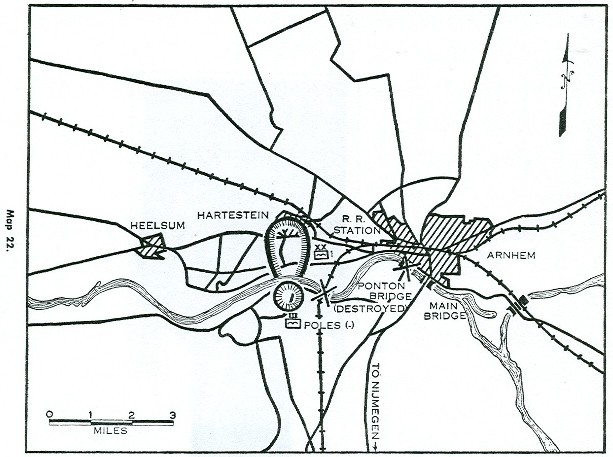
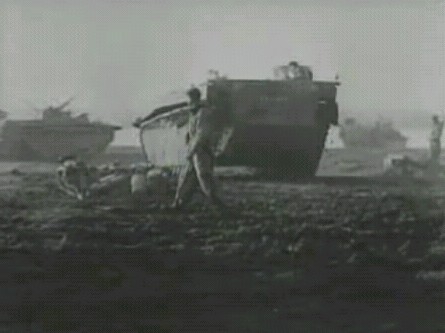
WW2 Mystery: A Bridge Too Far or We Didn't Go Far Enough? P4
 www.youtube.com/watch?v=7WftY4JUHMo
www.youtube.com/watch?v=7WftY4JUHMo
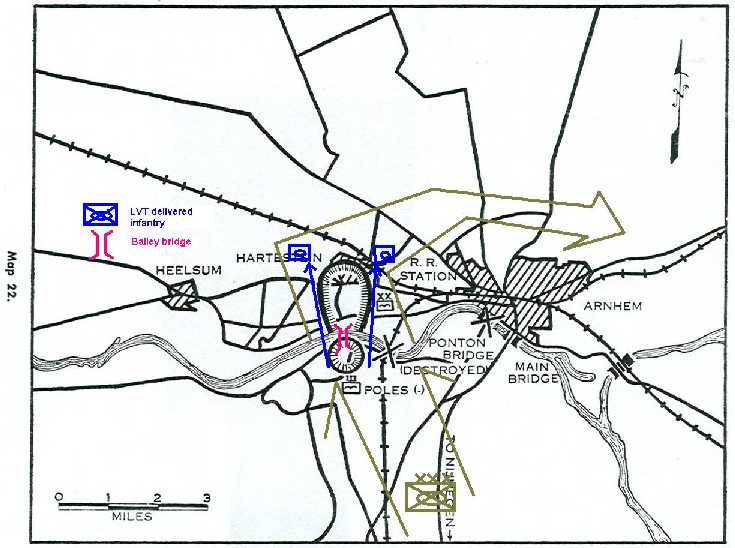
Page 121
The division had fought a difficult, costly, bitter, yet very gallant fight. The extent to which the division was chewed up can best be appreciated when it is realized that on D plus 2 all of the resupply for the division, 439 gross tons, fell into enemy hands because the prearranged drop zones could not be held, and at the same time, five battalions, including Frost's battalion at the bridge were completely cut off from the division and were never heard from again except for a few individual troopers who got through.
Despite this the mission of seizing and holding the bridge was accomplished and, what is more, the bridge was held until D plus 4 until every single trooper was killed or wounded and captured.
And when the bridge was lost a bridgehead was held until relieved on D plus 8. There was no failure at Arnhem. If, historically, there remains an implication of failure it was the failure of the ground forces to arrive in time to exploit the initial gains of the airborne division.
SUMMARY
The airborne operation in Holland was the first attempt of the Allied high command to employ an organization embodying organically all of the means of waging airborne warfare. Bombers of all classes, fighters, observation ships, and troop-carrier transports, as well as the airborne divisions were all under the direct command of the Commanding General of the First Allied Airborne Army. It was a tremendous step forward. No longer were results entirely dependent upon the different, and at times not too mutually sympathetic, branches. All branches and services contributed to the common effort under one command. The ease with which they worked and the accuracy and efficiency of the operation give ample evidence of the efficacy of the idea; one command, one army. The concept was sound. There will be need for many such armies if ever again the airborne troops are called upon to fly into a fight. A division can, in general, seize and organize an airhead about fifteen miles in circumference. It may be more and it rarely will be less. The 82nd held a 25-mile perimeter for three days greatly aided of course by major waterways that were perfect tank ob-
Page 122
stacles. A study of the fighting in Holland gives one a good idea of just about what can be expected of a division in an average situation. It appears that a good usable airhead should be at least of corps size, at least forty-five miles in circumference.
Drop and landing zones must be near or on the unit objectives. It is quite a feat tactically to be able to fight in one direction to seize an objective and at the same time keep looking over one's shoulder fighting in the opposite direction to hold a landing zone. The tactical employment of an airborne reserve deserves much further study. If airborne units consider their reserves in the same light as ground reserves they are landed and fought in the usual role of ground reserves. Each division employed its reserves in this manner in this operation. How much better it might have been if in the Nijmegen sector for example, the division had had an infantry battalion in airborne reserve that could have been dropped north of the Nijmegen bridge on D plus 3 when a river crossing had to be made to capture the bridge. It appears that an airborne division might well leave a reserve force on the take-off airfields for employment in a decisive role when the fight becomes critical. This would usually be about D plus 2 or D plus 3.
Airborne construction engineers and an advance airhead control party should accompany an airborne unit. The rapid construction of landing strips suitable for air landed troops must have number one priority in future operations. This also means that an airhead control party must be present in the first troops landed in order to handle the tremendous number of troops and tonnage of supplies that will follow.
Airstrips could have been built and made operative in any of the division airheads established.
The indications of what to expect in the way of airborne operations in the future were becoming increasingly clear. Beachheads will become airheads and it appears possible the build-up in an airhead will surpass what we have conceived of in a beachhead. "Hit 'em where they ain't" is still good tactics, and the commander that "gets there fustest with the mostest" is the one on whom to put your blue chips.
CHAPTER 5: The Airborne Operations of 1945
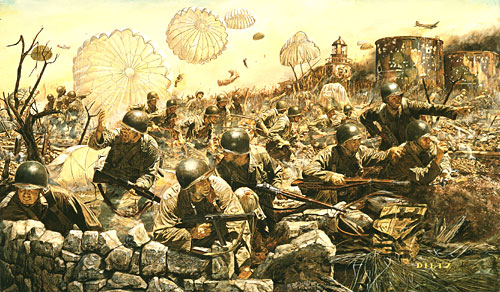
THE YEAR 1945 saw the last of the great airborne operations of World War II. Not only the last, but the most highly perfected in their own special form. The pattern of evolution clearly evident after Sicily, and through Italy, Normandy, and Holland was ended. Airborne operations were coming into their own. Corregidor, a venturesome undertaking, boldly conceived and gallantly executed, could well have been done entirely by air. The crossing of the Rhine by the U.S. XVIII Corps with 1,500 troop-carrier aircraft and 1,300 gliders participating was the most highly perfected technical job yet staged by any airborne troop-carrier force. And the final occupation of the Japanese mainland, with the U.S. 11th Airborne Division in an air landing role, showed clearly the pattern of things to come.
CORREGIDOR Some airborne operations succeed because of a commander's close adherence to established principles. Others fail despite dose adherence to these principles. Unique however is the operation that succeeds beyond every expectation despite the complete departure from almost every principle. Such an operation was the airborne landing on Corregidor in February 1945.
Corregidor is the key to Manila Bay, which-is a landlocked harbor with Corregidor in the middle of its narrow neck of entrance. He who would use the harbor must first own this island fortress guarding it.
Dominating the entrance to the bay, imposing and forbidding in appearance, Corregidor is a mass of rock that rises abruptly from the sea to a height of over five hundred feet (see Map 23). It is 2,500 yards wide and, except for a tail that gives it a tadpole outline, barely over twice as long. For centuries lookouts have watched from its cliffs for signs of the approach of hostile sea craft. Spanish galleons, Moro vintas, and British frigates have assaulted its shores. The story runs that upon the arrival of Dewey's white fleet off the island in May of 1898 there was some uncertainty in the minds of the defenders whether to fire a salute or a
Page 123
Map 23.
defensive salvo. Dewey captured it in 1898 and it was under our protection until that black day in American history, 6 May 1942, when General Wainwright had to strike his colors and surrender the island to the Japanese. It has been considered a model of defensive organization. Honeycombed with tunnels and hidden gun positions, wired, mined, and well stocked with food and ammunition, it was a formidable obstacle to overcome.
There should have been no doubt in the minds of the Japanese defenders of the intent of the approaching Americans in 1945. Having landed to the north at Lingayen Gulf on 20 January and in the south at Nasugbu on 31 January, the American ground forces had been converging on Manila for two weeks. Finally, in early February, the capture of the city appeared a certainty. To General Walter Krueger's Sixth Army the prompt availability of the port facilities for further operations against Japan was therefore imperative.
On hand to do the job, if it was to be airborne, was the 503rd Parachute Combat Team, 3000 strong, under the command of Colonel George W. Jones. The 11th Airborne Division was in
Page 124
the theater but was fully occupied cleaning up Japs south of Manila. The 503rd PRCT had two parachute combat jumps to its credit and in addition it had fought through several ground fights.
It was seasoned, tough, and conditioned mentally and physically for the task. The 317th Troop-Carrier Group under Lieutenant Colonel John S. Lackey consisted of 56 planes of the C-47 type. It had seen considerable operational flying in the Philippines area.
Both the airborne troops and the corresponding troop-carrier units were located on Mindoro within striking distance of Corregidor.
Such were the situation and the available means for an airborne attack on the island when Colonel Jones was called to Sixth Army Headquarters early in February. He was informed of the plan to make a joint airborne-amphibious assault on the island in about ten days. He was asked for his recommendations for the employment of the 503rd PRCT.
A thorough staff study of the airborne aspects of the operation then followed. It was estimated that there were somewhere between 800 and 6000 Jap defenders on the island. There was little flak from it, and it appeared that both the flak and the small-arms fire could be beaten down and kept smothered up to the moment of landing. The defenders did not appear to have taken any special anti-airborne measures on the ground. It seemed entirely feasible therefore to make the landing during the daylight homs.
Nonexistent were suitable drop zones on Corregidor. There was an old American-built airstrip, very narrow and about 300 yards long, out on the low flat tail of the island. Landing there would accomplish practically nothing since the main Jap positions were up in the cliffs and on the higher parts of the main island which completely dominated the airstrip. On the topside of the main part of the island there was a small area that passed as a golf course before the reign of Hirohito. It was barely 300 by 150 yards and covered with bomb craters and debris of bombing: To the west of the course was an area that had once served (and undoubtedly does again) as a parade ground. This was hardly 250
Page 125
by 150 yards. Together these comprised the "suitable" jump areas on the island.
There was a prevailing wind of 15-25 miles per hour and the time of descent from the minimum reasonable jumping altitude of 400 feet was 20 to 25 seconds. It was plain enough that any given jumper might well have trouble landing within the drop zone. Indeed, he would have to jump well off the drop zone and depend on the drift during descent to bring him onto it. Add to this the fact that the plane would be traveling at 110 to 120 mph, and that there would be a stick of at least six troopers from each plane, and it can be seen that the problem of delivering the troops on the tiny drop zones was a serious one. To the staff officers who were veterans of the wartime airborne courses at the Command and General Staff School the situation must have been reminiscent of the jumps planned for the top of the First National Bank of Kansas City. But the two small drop zones on topside, designated as "A" and "B," were selected for lack of any others for the operational drops.
The flight and troop delivery plan was simple and unusual.
The Combat Team was to be delivered in three echelons, each consisting of an infantry battalion and an artillery battery plus supporting detachments. The first serial, made up of 51 x C-47s, was due over the target area at 0830 hours. The next serial of approximately the same size was due at noon of D-Day, and the third and final serial was due at 0830 of D-plus-1. A resupply lift of twelve C-47s would follow the third serial. The planes of each serial, on approaching the drop area, would form into two single-plane columns, one for each drop zone. Higher overhead, a control airplane would correct the pilots and jumpmasters by voice radio in the clear. Each airplane would drop approximately six troopers at each pass over the target. Circling to the right in the right column and to the left in the left column the planes would continue making passes at the target 'areas until all troopers and their equipment were dropped. The operation showed every promise of being a most interesting affair.
Page 126
The staff hastened its detailed staff planning and troop preparations for the proposed plan. Air reconnaissance obtained both vertical and oblique photos of the operational area, and these were made available to all participants. Beginning 12 February, all battalion and company commanders studied the target area directly from bombers. All personnel had opportunity to study a scale model of the island. Personnel familiar with the island were questioned and no possible source of information was overlooked. Unit and individual drop loads were prepared and checked. Four "K" rations, two canteens of water, weapons and basic supply of ammunition formed the trooper's load to be carried on descent. In addition many were to carry BARs, mortar, and light machine-gun parts during the drop.
This differed slightly from standard practice in the European Theater. There, crew-served weapons were generally dropped in equipment containers and the extra carrying capacity of individuals used to bring down antitank mines. Tanks, the usual bugaboo of Paratroopers, were of no concern on Corregidor for none was believed to be there.
Concurrently with the preparation of the staffs and troopers, Corregidor itself was also being prepared for the coming attack.
Ships intensified their gunfire and air units their bombing, with the particular object of reducing to a minimum the enemy strength kept on topside during daylight hours. In addition the Rock got a general working over from time to time with the usual purpose of destroying defensive installations and troops. Finally, 16 February was announced as D-Day.
It began auspiciously. Fully-loaded aircraft were off Mindoro and on their way at 0715 and after an hour and fifteen minutes of flight the first landings went off exactly on schedule. The initial Japanese resistance was light, and although it was 0930 before the last trooper of the first serial was on the ground, the situation was always well in hand. The landings caught the defenders by surprise, and even though the first serial suffered 75% of the total landing injuries of the whole Combat Team, their tactical integrity was at no time endangered. Four hours after the landing
Page 128
of the first serial the second serial began to drop and it too, completed its landing as planned. Thus by dark D-Day the PRCT less one battalion and a battery of artillery had landed and accomplished all of its airborne missions.
Landing losses had been heavy, amounting to 10.7 per cent of the entire force-mostly injuries caused by the rough terrain, buildings, etc., where the unluckier troopers landed. There were three fatalities from chute malfunction. These figures did, however, compare favorably with the pre-operational estimate of a probable twenty per cent loss. And, of course, parachute landing losses must always be evaluated as well in terms of the light enemy fire losses made possible by landing in his rear-or, as on Corregidor, above his prepared defenses. .
Since the D-Day landing force needed no further reinforcement to finish the job, the regimental commander decided to bring in the last serial by boat and thus avoid unnecessary parachute landing losses. It joined the parachute echelon on topside at 1100 hours 18 February, D plus 1.
The initial D-Day landing force cleared the drop' area promptly.
By 1100 it was able to give .50 caliber heavy machine-gun and 75mm [pack howitzer] support to the amphibious landing. The amphibious attack was under way at 1030 and in the brief time of thirty minutes was well established on the crest of Malinta Hill (see Map 23). With the arrival of the second serial in the afternoon of D-Day, the troopers expanded the parachute perimeter on the high parts of the island to include an old American ack-ack emplacement about five hundred yards north of South Dock. This gave the paratroopers control of the routes from the dock to topside where their landings had taken place, and thus, to a degree, tied them in physically with the amphibious force-a critical phase in every airborne operation.
THE JAP DEFENSE
A full knowledge of the Japanese defender's problems of trying to prevent or destroy our airborne landings would be most interesting if available. Unfortunately it is not. A certain amount
Page 129
of information was obtained from prisoners, however, which gives us an insight into the attitude and behavior of the Corregidor garrison commander until he met his death at the hands of a group of paratroopers.
Corregidor was commanded by Capt. Ijn Itagaki of the Japanese Navy. He had approximately six thousand assorted troops to man its defenses. The state of affairs that caused a seafaring man to be holed up in the tunnels and caves of Corregidor must have weighed heavily on his mind and given him good cause to look with foreboding upon his future tactical prospects. Captured staff personnel tell us that he had been directed by Yamashita to look to the anti-airborne defenses of the island. In compliance with this directive he made a reconnaissance of the island. He then announced to his subordinate commanders that an airborne landing would not take place because it could not take place. No suitable landing or drop zones were, in his opinion, available for an airborne force. To be doubly sure, however and as a hedge in case his guessing was a little off, he had the old landing strip on the southern end of the island extensively mined and emplaced dug-in weapons to cover it with fire. With these preparations he awaited the inevitable amphibious onslaught confident of turning it back.
It is ironic that Itagaki was guilty of the same tactical error made by many Allied commanders early in the war. He based a defensive plan on the premise that the attacker could not do certain things, could not attack in certain ways, simply because there were extreme difficulties inherent in such attacks. Well, the problem of Captain ltagaki's postwar peace of mind was solved for him on the morning of D-Day. During the airborne attack he decided to make a personal reconnaissance out from his OP near Breakwater Point. A group of paratroopers that had drifted over the cliffs had assembled nearby and they made short work of him.
He was killed and his orderly accompanying him captured.
It is interesting and significant that a similar fate befell a German defensive division commander in the airborne battle of Normandy. He in like manner had decided to reconnoiter in
Page 130
person an airborne landing. In this regard, it is also a matter of historical interest, that on the night of December 6-7 when Japanese parachutists attacked the American air base at San Pablo, Leyte, in the Philippines, it happened that the headquarters of the U.S. 11th Airborne Division was in the midst of the area attacked. The division commander, Maj. Gen. Joseph Swing, started out of his CP, then stopped to talk for a moment to his chief of staff. After some discussion he deemed it wiser to stay at the CP until the situation quieted down. It was well that he did.
Many casualties were inflicted on our own troops that night, by friendly troops in the area as well as by the enemy. The battle station of a commander in a hostile airborne attack is where his communications are and where he can control the fighting. There is little need for him to indulge in hand-to-hand fighting himself unless his command post is attacked.
UNUSUAL OPERATION
Corregidor was an unusual airborne operation. The landings took place directly on top of the defenders, the drop zones were entirely inadequate by accepted standards, and the landing period of each battalion was extended over a period of hours instead' of the normal minutes. Despite this, in some respects, this operation enjoyed a greater measure of success than any other airborne operation of the war.
If there is a lesson to be learned from the Corregidor operation it is that orthodoxy and mental inflexibility have no place in airborne tactics. Established and accepted tactical principles must be applied with common sense. Blind adherence to stereotyped forms of attack and unquestioning acquiescence to a system of rote can only spell, in the long run, disaster. For as the defender organizes his defense so the attacker must plan his attack. The attack must adapt itself to' the peculiarities of the defense. And then, if the form of the attack turns out to be peculiar or startling, well and good. The future, with its devastating missile and bombardment attack and consequent widespread troop dispersion, holds many
Page 131
peculiar and hitherto unheard-of tactical dilemmas in store for us. Each will require its own solution with but due regard for what has happened in the past.
CROSSING OF THE RHINE BY XVIII CORPS
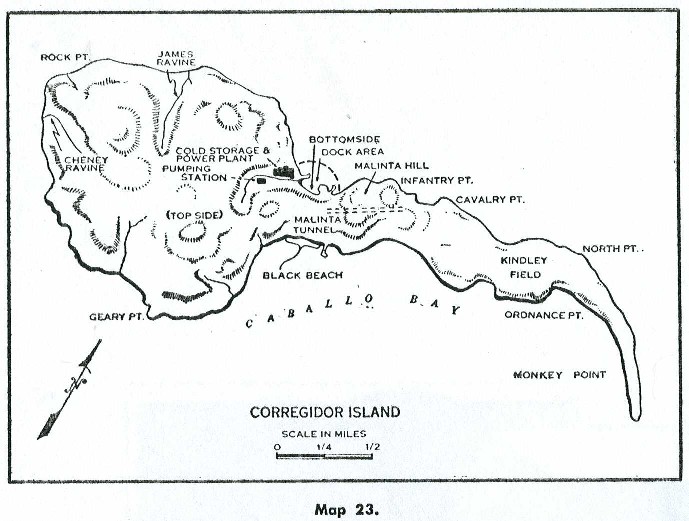
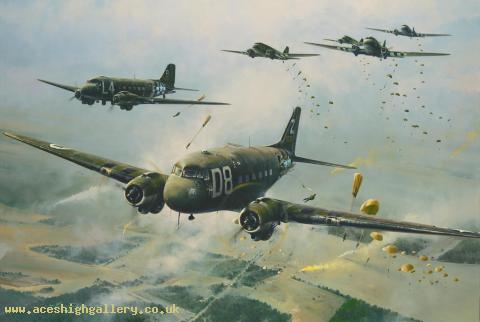
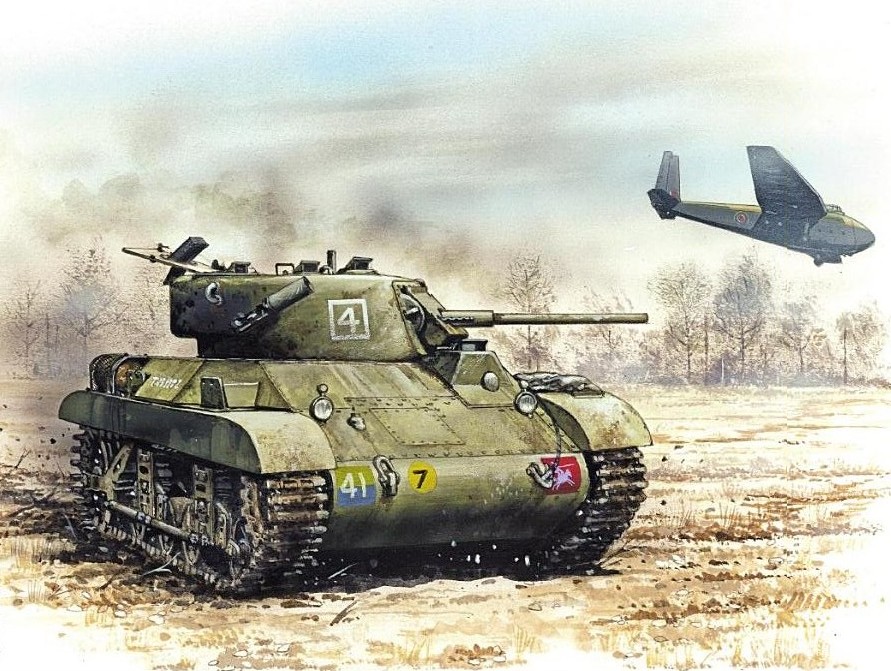
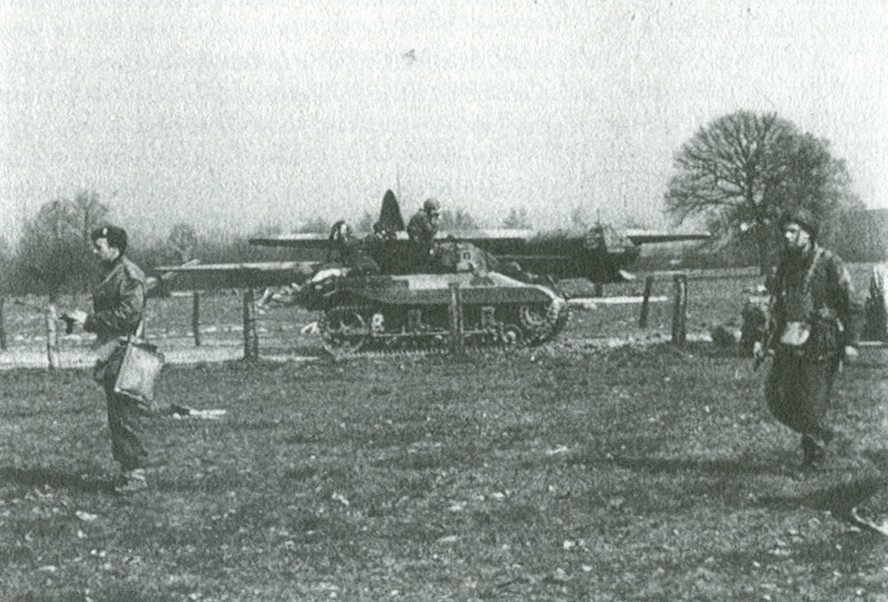
American-made M22 Locust light tank in combat with the British 6th Recce Squadron during operations across the Rhine
Operation VARSITY, as the airborne crossing of the Rhine River by the U.S. XVIII Airborne Corps came to be known, was the most complex simultaneous airborne-troop carrier lift of the war. Involving thousands of support aircraft as well as five troop-carrier wings, it used most of the airfields of England, Belgium, and northern France. At its climax over five thousand fighters and three thousand bombers supported the 1, 595 troop-carrier planes and the 1, 347 troop-carrier gliders.
The over-all operation was planned by the First Allied Airborne Army under command of Lt. Gen. Louis Brereton whose chief of staff was Major General Floyd L. Parks. The actual assault by parachute and glider was charged to the U.S. XVIII Airborne Corps commanded by Major General Matthew B. Ridgway. There were two airborne divisions involved: the British 6th of Normandy fame, commanded by Major General E. Bols; and the U.S. 17th which had performed brilliantly in the Bulge, commanded by Major General William Miley. The troop-carrier lift was all under the command of Major General Paul Williams of the IX Troop Carrier Command, whose pilots had been flying airborne troops since the first invasion of North Africa.
Spring was the harbinger of violence and death in the Rhine River Valley in 1945. The Allied Armies were not to be denied.
After absorbing all the Wehrmacht could offer in the winter offensive of 1944-45, the Allied forces recoiled again and swept across the Roer, crushing all in their path, finally rolling up to the banks of the Rhine itself. There, preparations were hastened for the final blow that would open the door to the very heart of Germany.
On the northern flank, the main Rhine crossing was to be made on the front of the 21st Army Group commanded by Field Marshal Montgomery. The crossing was charged to the British Second
Page 132
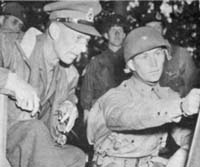
Army commanded by Lt. Gen. Sir Miles Dempsey and the sector designated for the crossing was immediately north of Wesel (see Map 12). Available to assist the Second Army in its crossing was the U.S. XVIII Airborne Corps of two airborne divisions. Preliminary orders were issued to the Corps Commander, Maj. Gen.
Ridgway on February 9. D-Day was tentatively designated as March 24. The mission assigned to the XVIII Corps was as follows:
"To disrupt the hostile defense of the Rhine in the Wesel Sector by the seizure of key terrain by airborne attack, in order to rapidly deepen the bridgehead to be seized in an assault crossing of the Rhine by British ground forces, in order to facilitate the further offensive operations of the Second Army." Clearly implied was the requirement for a close-in tactical mission. It was intended that the airborne troops land directly upon, or close to, the defensive installations blocking a river crossing. Critical terrain, bridges, and defiles, within five to ten miles of the river, were to be seized and held until relief by the ground troops was accomplished.
The enemy situation was more favorable than it had been for some time. Two German divisions were holding the sector opposing the Second Army crossing; the 7th Parachute and 84th Infantry Divisions. Both were depleted in strength but had had time to reorganize after the final withdrawal across the Rhine. These units were taking specia1 precautions against an airborne assault. Gunners had to sleep at their posts at all times. Selected and specially organized anti-airborne forces were covering all likely drop and landing areas. Such was the enemy situation as the plans of the XVIII Corps were taking final form.
The 21st Army Group and First Allied Airborne Army commanders made a number of decisions that distinctly characterized the coming operation. They are worth enumerating:
(1) The landing of the airborne troops would follow the attack of the ground troops-the assault crossing of the river on the
Page 133
night of March 23-24. The airborne landings would be made the next morning.
(2) The airborne landing areas would be within medium artillery range of Second Army artillery.
(3) The entire airborne force would be flown in one lift.
There would be no continuous build-up plan like those for Normandy and Holland.
(4) The resupply lift would be flown within several hours of the first landings. (Actually it followed the initial landings by six hours)
(5) All landings would be upon or very near to objectives. There would be no eight-mile marches to reach an objective of importance.
The planning went ahead in the XVIII Airborne Corps. ln its final form, the corps plan contemplated the drop and landing of the two divisions abreast, with the 17th on the right. The plan in general was to seize the woods and high ground three to five miles east of the Rhine and bridges over the IsseI River, to gain contact with the ground troops, and then seal off Wesel, contact the U.S. Ninth Army, and then be ready to advance to the east. It was anticipated that the airborne divisions would be withdrawn by D plus 6.
Within the divisions, planning kept apace with corps planning.
All units were well briefed and ready to go by dark, 23 March. The troop-carrier aircraft were dispersed over eleven airfields in England and fifteen in France. The flight plan was based upon very close timing. Air groups marshaled over their take-off areas and departed for wing initial points on a timed schedule. From there they converged on the command initial point at Wavre, Belgium. Three separate streams of planes moved on the target area. It can best be appreciated how particularly difficult the timing problem was if it is realized that the air armada contained at least five elements of different characteristics and speed. For example in the U.S. 17th Division the air column was two hours and eighteen minutes long and consisted of 298 parachute transports and 610 glider tugs towing 906 gliders. The parachute transports
Page 134
were of two types: 226 x C-47s and 72 x C-46s. There were 314 single-tow gliders and 296 double-tow. Especially significant is the fact that the parachute lift, consisting of but 298 transport planes, carried two parachute regimental combat teams and a command echelon of division headquarters in but thirty minutes of air space. The rest of division headquarters, with division special troops, the engineer battalion, the antiaircraft-antitank battalion, a glider infantry regiment, and two glider field artillery battalions required 610 transports and one hour and forty-eight minutes of air space. (Certainly the glider performance in World War II must be improved upon.
Short tow bars instead of 30-foot tow ropes would be a step in the right direction of reducing air space. D-Day turned out to be a beautiful warm spring day. Having visited the take-off airfields and talked to many of the troopers of the 507th Parachute Infantry who had jumped with the 82nd Airborne Division in Normandy, I was very much interested in how they would fare. The flight route passed over the 82nd area near Reims so I managed to get an airplane and took off and flew over the armada on the way in to see how things would go. It was a new experience to fly an airborne mission but not jump it. We flew at two thousand to three thousand feet, staying above the combat formations at all times.
It was an indescribably impressive sight. Three columns, each nine ships or double-tow gliders across, moved on the Rhine. On the far side of the river it was surprisingly dusty and hazy, no doubt caused by the earlier bombing and the artillery firing. On the near (west) bank of the Rhine clearly visible were panel letters to guide the troop-carrier pilots. Yellow smoke was also being used near the panels. It was hard to see how any pilot could make a serious navigational error.
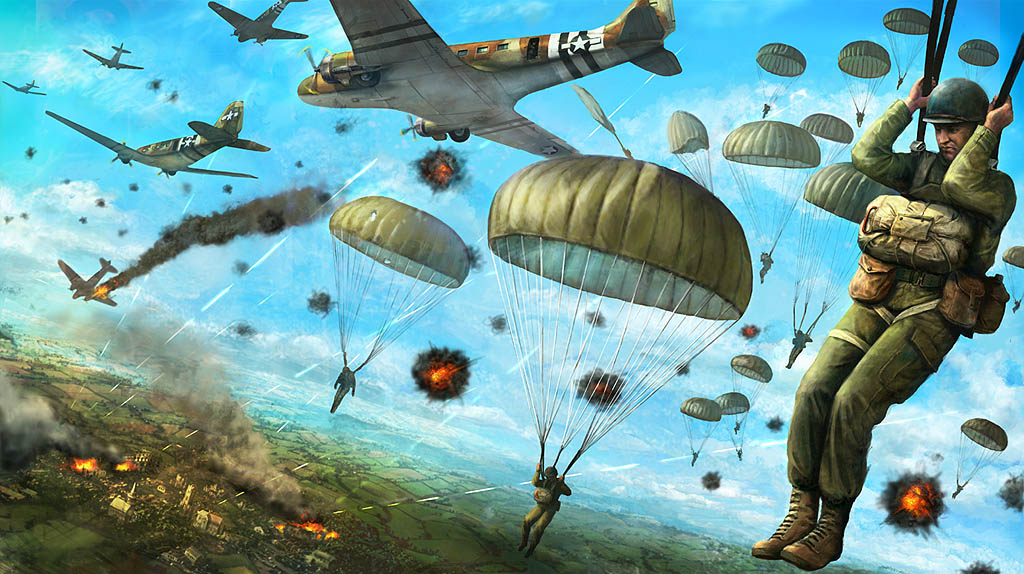
The air armada continued on and crossed the river. Immediately it was met by, what seemed to me, a terrific amount of flak. A number of ships and gliders went down in flames and after delivering their troops, a surprising number of troop-carrier pilots we saw on their way back were flying planes that were afire.
Page 135
The crew I was with counted twenty-three ships burning in sight at one time. But the incoming pilots continued on their courses undeterred by the awesome spectacle ahead of them. Perhaps I was unduly impressed by the spectacle as viewed from the air during the drops and landings, but certainly the troop-carrier pilots did a splendid job. The actual figures show that 440 troop-carrier aircraft were badly damaged and that fifty-three of these were definitely destroyed by enemy fighters and flak.
Despite these aircraft losses all airborne units were delivered to their operational areas. Except for the 513th Parachute Infantry of the U.S. 17th Division, all units arrived at their correct landing areas. A total of 17,122 troops, 614 jeeps, 286 artillery pieces and mortars, plus hundreds of tons of gasoline, food and ammunition, had been delivered to a corps airhead in two hours.
The 513th Parachute Infantry, which landed in the area of the British 6th Division some twenty-five hundred yards north of its assigned sector, had an experience typical of what often happens to an airborne regiment. The account of the Regimental Commander, Colonel James W. Coutts, is of particular interest:
We rode the C-46s across the Rhine to the Wesel bridgehead.
It was that type plane's first combat test and both airmen and troopers were anxious to see how it would perform. I liked the ship personally but we were to see some two dozen of them go down later, in the Corps airhead. Only one crashed with all hands aboard, but because of the ship's size that meant one precious platoon less for the fighting.
My regiment with some attached Engineers and Medics took off in seventy-two C-46s from a single airdrome near Amiens. We flew a course that was called the right-right stream. Since the 46 was a faster plane we started later than the C-47s and doubled past the right stream of planes that was taking off from the continental airports. Flight time was calculated so that we would overtake the C-47s, then swing in front of them and straighten out on course again before the head of the 313th Group (C-46s) reached the Rhine. I feel that the timing was a little off, we were a little late. Consequently when we crossed the Rhine itself the 46s were not yet swung back
Page 136
on course. I believe that caused us- to land north of our pre-selected DZ. Perhaps it would be better to have the faster type plane fly the prescribed courses at a higher altitude, then let down in front of the slower ships as the DZ approaches.
As we crossed the west bank of the Rhine we were hooked up and ready to jump. Funny little jagged holes began appearing in the fuselage. I suddenly realized that we were catching a sizable share of German flak. The port engine broke out in flames. I glanced at my wrist watch wondering if the ship would get us there. It did. Our pilot kept us steadily in formation in spite of flak and flames for a little more than three minutes. Over the roar of the many motors I now discerned the sharp reports of gunfire. I knew we were close.
In a moment the light changed to green and we were out of the burning plane. I remember looking at the ground after my chute opened. We had flown in at about five hundred feet. The Krauts were shooting at us as we floated down. It was a waste of ammunition; they only hit a few troopers in the air.
After landing and shedding my chute, I started looking for the farm house and the orchard that should be there. Through the haze I spotted it and figured that the troop-carrier boys had hit it right on the nose. Later I realized I was wrong. The customary noises of battle were on all sides. I remembered particularly the whine of small- arms fire as it passed and the sickening heavy thud that a Kraut mortar shell makes. My radio operator was a casualty. Within half an hour we found another operator and moved our little command echelon to the north. I started looking for orienting terrain features that I had memorized, but couldn't find them. I noticed more and more British Paratroopers, their cherry berets. I saw British Horsa gliders landing. Either the British or we were in the wrong place. Through an interpreter we learned from a very scared German family that we were northwest of Hamminkel rather than southwest. The British were in the right area, we were wrong.
In about another thirty minutes heavy firing was heard to the south and we-moved towards it. By this time all infantry battalions and regimental headquarters were well in hand. The combat team artillery was missing. In just a few minutes Colonel Booth, the artillery battalion commander, called by radio and wanted to know where in the hell the infantry was. His battalion had landed on the proper DZ and was having quite a fight. Despite this it had assembled twelve of its guns and reported itself ready to fire missions.
The infantry moved out in column of battalions towards the prop-
Page 137
er DZ which was three miles away. It turned out to be a good formation because we had no idea of the location or type of resistance that we would run into. As a matter of fact some of it turned out to be pretty tough. But we did manage to report in to Division by radio, and, with the excellent but rather unusual support that we received from our combat team artillery we reached the DZ area by mid-afternoon. The artillery support was unusual in that the artillery positions were in front of us and they were supporting us by firing directly towards us. It worked very well and must have seemed very confusing to the Krauts. By dark we were on our objectives and all defenses buttoned up. We had about 2,000 prisoners which was more than the infantry strength of the combat team. But there was no doubt that the Kraut defensive set-up was shot to pieces and he was badly beaten.
The greatest single contributing factor to our tactical success in this odd situation was the fact that the troop carrier pilots put us down together in tactical groups despite the heavy flak and battle haze that made finding pin-point DZs almost impossible.
HIGHEST STATE OF AIRBORNE DEVELOPMENT
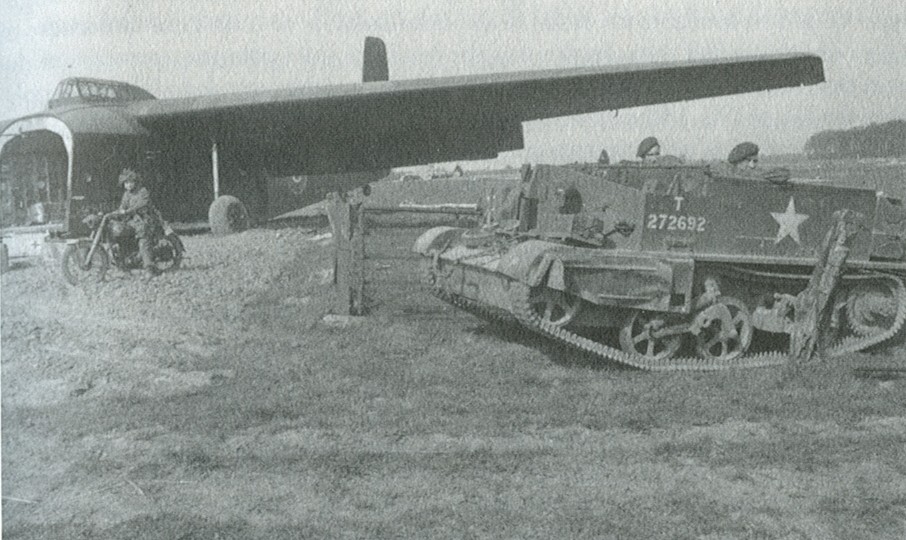
Author Keith Flint in Airborne Armour, page 153 reports that the British glider-landed an entire company, the 716 Light Composite Compsany, RASC in 12 x Hamilcars with 12 Bren gun armored personnel carriers and trailers whose sole purpose was to use their tracked mobility and armored protection to redistribute supplies from other gliders and recover parachute resupply drop bundles--a good idea we need to emulate today with M113 Gavins
Operation VARSITY portrays the highest state of development attained by troop-carrier and airborne units. Commanders and pilots had learned their lessons well. Rarely, if ever, in history has man made such rapid strides in the development of an entirely new form of military technique.
And yet, with all of this, better than anyone else the pioneers of troop-carrier and airborne realize that it is still in its infancy.
Larger and faster planes, greater ranges, and new landing techniques, combined with the greater dispersion in the defense that is certain to be caused by the use of atomic energy as a military weapon, all show clearly that the future of any winning army is in the air.
Operation VARSITY was the second Corps airborne operation of corps size. Armies, as well as corps, can fight airborne. To win in the future, they must.
FINAL PERFORMANCE JAPAN
That the air arm, with all its power and fury, would open World War II seemed to be a foregone conclusion even well be-
Page 138
fore Munich. Not many believed, however, that the air arm would develop in decisiveness to the point where it would close the war. Even so, as late as July 1945 many thousands of dollars were being laid on the line by air officers in the Philippines to back their beliefs that it would. After the costly land battles of Iwo and Okinawa most ground officers were convinced that only an amphibious invasion of Japan proper would bring the final decision. On the other hand practically all air officers believed that continued heavy bombing would bring the Japs to their knees.
Finally, when the atom bomb did the trick, there was some chagrin in the ground forces camp, and there were many accusations generally in the vein, "Well, you knew you were going to use the atom bomb all along." As a matter of historical military fact, when the final invasion did come it was a combination of both air and ground. It was an airborne division with accompanying specialist teams flown by the Air Forces that first landed on Japan proper.
The U.S. 11th Airborne Division was assembled south of Manila in mid-August 1945 when Japanese surrender negotiations were concluded. Here it received. orders to prepare for an air operation against Japan-it was not known at first whether it would be parachute or airlanding. Leaving behind its heavy equipment the Division was flown to Okinawa beginning on August 15, 1945. B-24s as well as regular troop-carrier transports were used for the move, and the division was closed on Okinawa in twenty-nine hours.
No time was to be lost. The division was to obtain over 600 jeeps from units on the island and fly to Japan within twenty-four hours. But even in airborne operations the time-honored "hurry-up-and-wait" system is sometimes found. Unexplainable delays on the part of the Japanese (it was presumed that they were destroying documents and war records) , and then a typhoon, caused the take-off to be postponed from day to day until finally the advance party under the command of Colonel C. T. Tench did not take off until August 28.
"Advance Party: Mission Surrender" by Colonel C. T. Tench, Infantry Journal, August 1946.
Page 139
In the meantime over two hundred C-54s of the Air Transport Command were rushed to Okinawa and the move to Japan as a result was a move in comparative comfort. The first complete combat unit to land on Japanese soil was a battalion of the 188th Glider Infantry of the 11th Airborne Division. It was followed by the other troops of the 11th as soon as circumstances permitted.
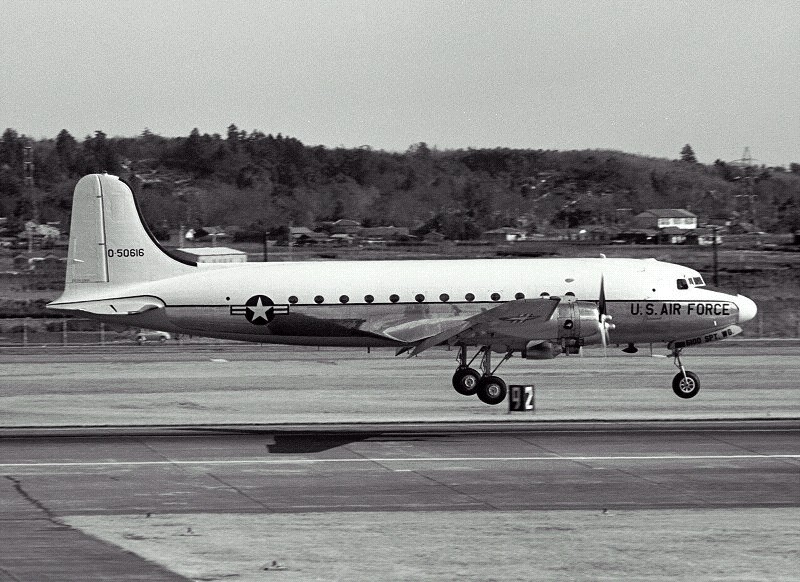
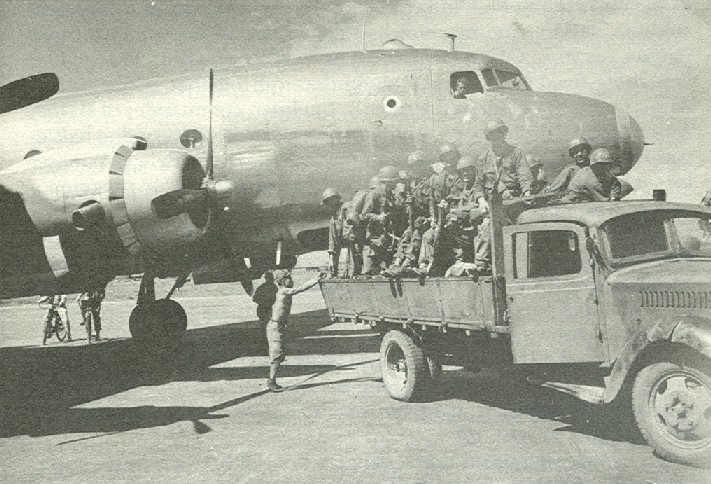
Since there were many higher headquarters personnel and scientific groups to be flown in the early echelons, and the typhoon caused a forty-hour delay, the division did not close for nine days.
This illustrates exactly what will happen in any airlanding occupation when the airhead is secure. There is no need to take more combat troops into an airhead than those necessary to secure it. The great need is then for service units.
There is a parallel in this respect between an airhead and a port of debarkation. The only difference is that in an airhead many more service troops are required than in a beachhead because a much more rapid tonnage-delivery rate is possible by plane.
The flight plan of this final operation holds little of new or technical interest for the operation was entirely unopposed and spread out over a long period of time. Actually, it was merely a problem of transporting men and equipment under almost peacetime conditions to an occupied country. By far the most significant aspect of the operation is the fact that the final trump in the long contest with Japan was played by the air arm. And the weight behind the trump was the troop force transported by the air arm.
This may be the easiest operation of any war or it may be the most difficult. But whether the preliminaries are carried out by bombers or guided missiles, some type of follow-up is inevitable.
Only by this means can the enemy will to resist be completely broken, temporary cracks in the enemy's defensive armor quickly exploited, and the fight carried to the heart of enemy territory where the final decision is gained. This is the role of airborne troops-the pattern of things to come.
CHAPTER 6: Airborne Armies of the Future

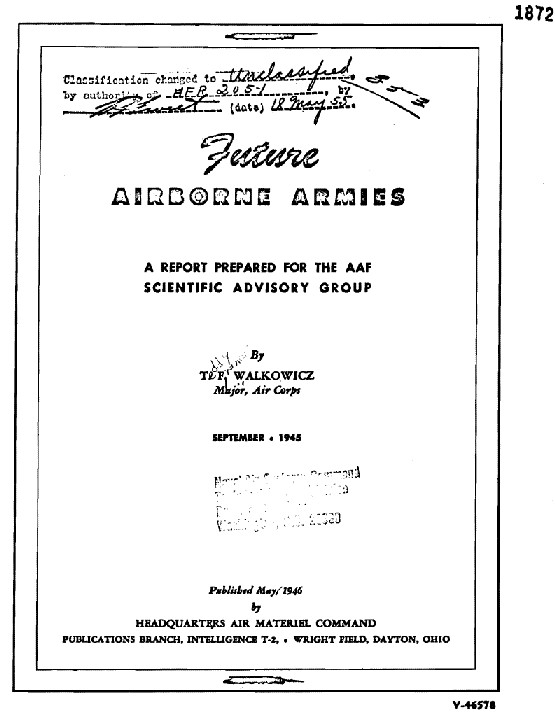
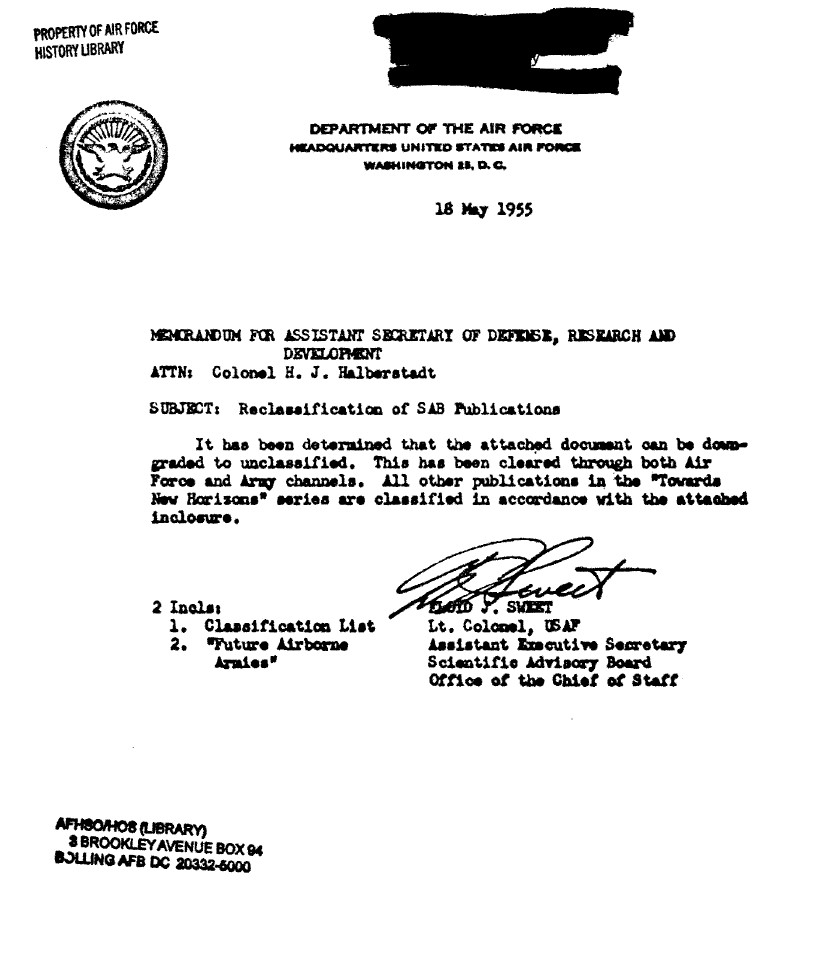
DOWNLOAD REPORT
www.combatreform.org/VKarman_FutureAirborneArmies_C5.pdf
General Gavin was highly influenced by Von Karman's Report "Future Airborne armies"--posted here exclusively for the first time on the internet.
THE FUTURE of our armed forces is in the air. All fighting men and everything they need to fight with in the future and live on as they fight must be capable of movement by air. Only through flight can we wage a future war in accordance with the principles of surprise, mass, and economy of means. Only by exploiting to its utmost the great potential of flight can we combine complete dispersion in the defense with the facility of rapidly massing for counterattack which today's and tomorrow's Army must possess. Even without the power and use of atomic energy for war these things would be true. With the use of atomic energy they become axiomatic.
Never in the history of mankind, certainly, has anything affected man's thinking and his probable military behavior so drastically as the atomic bomb. It changes-must greatly change-our whole military thinking, organization and tactics. And I say this despite the positive and often expressed convictions of many highly skilled professional Soldiers who as yet predict little change in ground fighting methods. To my mind, we professional Soldiers are traditionally laggard in facing and adopting changes, especially radical changes that upset proven methods and the ways in which we have been doing things for years past. I hope that what follows here is a worthy contribution to the military thinking behind our national security. It may seem visionary now, it may even be highly theoretical now, but in time I am sure it will prove to be sound.
The strategy and tactics of our armed forces in any given era consist of the full exploitation of the means of waging war available in that period of time. Most important among the means are the available arms, transportation, and equipment. As these improve and change, of necessity the tactics and strategy change. It is important to remember however that the principles underlying the methods do not change. It is therefore possible by a thorough and fully open-minded study of the trend of development in the means of warfare to determine what the future methods are most
Page 140
likely to be. The latitude and power we shall be able to employ in conducting a possible future war can be accurately measured in terms of the future development of our arms, transportation, and equipment.
DEFINITE NEED FOR GROUND COMBAT TROOPS
To begin with, I am assuming that there will be a definite need for troops to fight upon the ground. Despite the opinions of advocates of victory solely through air power such as Douhet and De Seversky, I believe that any bombing or guided missile attack will need a human follow-up force to exploit the disorganization and chaos that future bomb and missile attacks will cause. The ground fighting that follows mayor may not be severe or prolonged but that there will be need for such fighting in some form does appear to be inevitable. Not because there will be an effective active defense against the use of atomic power; for there is no such defense.
Dispersion and other passive security measures will be taken.
Many installations will be placed underground and troops will be kept underground for use in attack and counterattack. The particularly lucrative targets for attacking airborne troops will be launching sites for guided missiles, sources of strategic materials used in making atomic bombs and warheads, military fabrication plants where bombs and warheads are made, politically sensitive areas either before or after bomb or missile attack, airfields and take-off areas for enemy airborne troops, and terrain of particular tactical value such as groups of airfields about which an airhead may be developed.
In view of the traditionally non-aggressive role of our country in international affairs I think it can be assumed that, initially at least, the foregoing targets would be -targets for the airborne troops of the enemy. But they are equally suitable for our own troops. This would mean, then, that when an enemy made an airborne landing to attack targets in our own areas there would appear to be two prompt tactical antidotes. We would either have to neutralize the enemy airhead with missile attack or recapture it with airborne troops. Of course, if adequate ground forces are
Page 141
within striking distance they can make the counterattack with or without airborne assistance. But if the strategic and tactical dispersion of our forces is as it should be, troops could be marshaled in time to operate effectively in our own territory against a major enemy force only by the employment of airplanes.
The first problem in the employment of airborne units is that of transferring from a high-speed airplane to the ground, in the shortest time possible, men and means in condition and quantity to fight successfully. With the support they receive from the air, airborne troops must be able to destroy any hostile ground force they encounter. They must take along the means to do this by any or all of the three methods so far devised-parachute, glider, and, air-transport. The potentials for further development of these will indicate clearly the future capabilities of airborne troops.
THE PARACHUTE
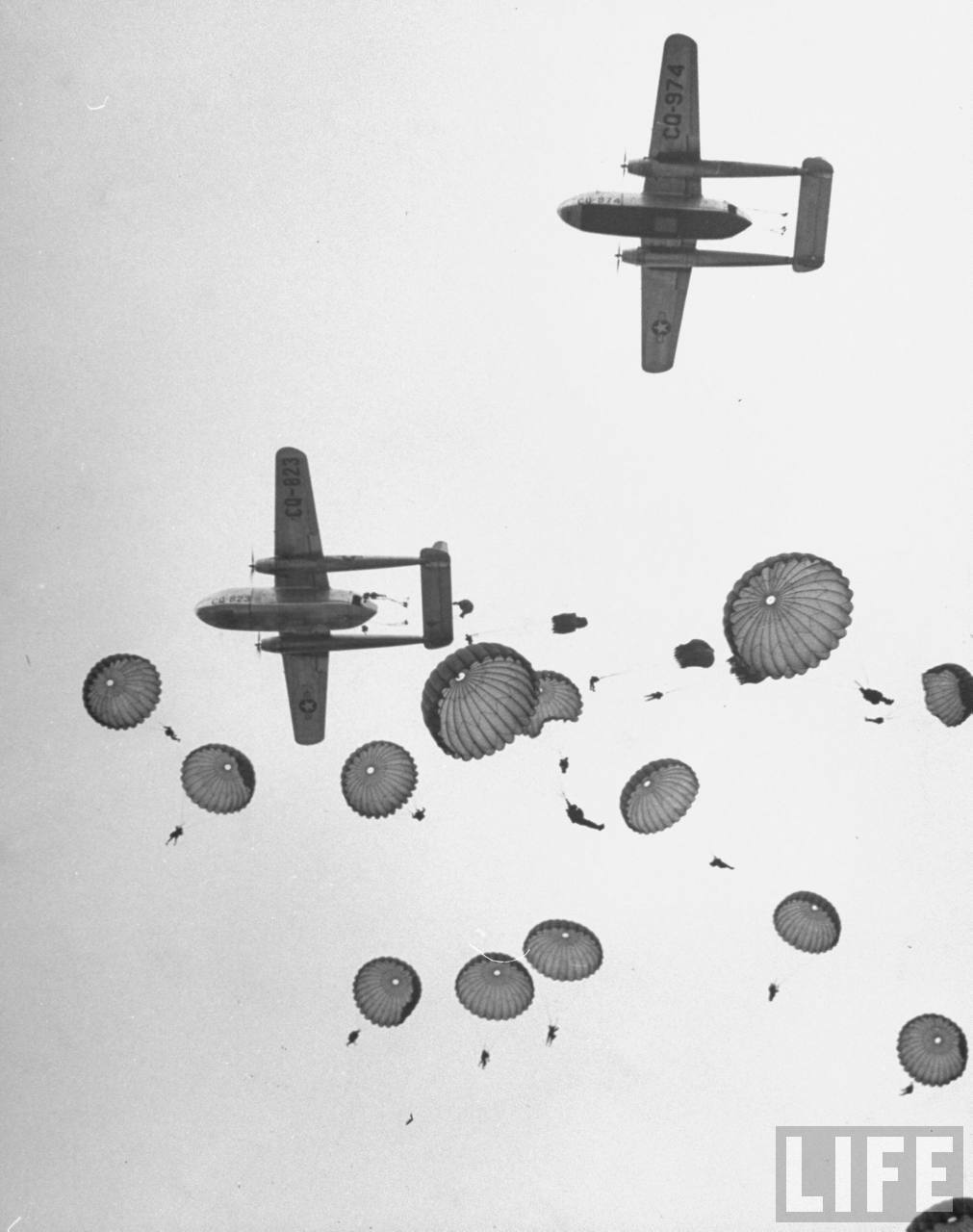
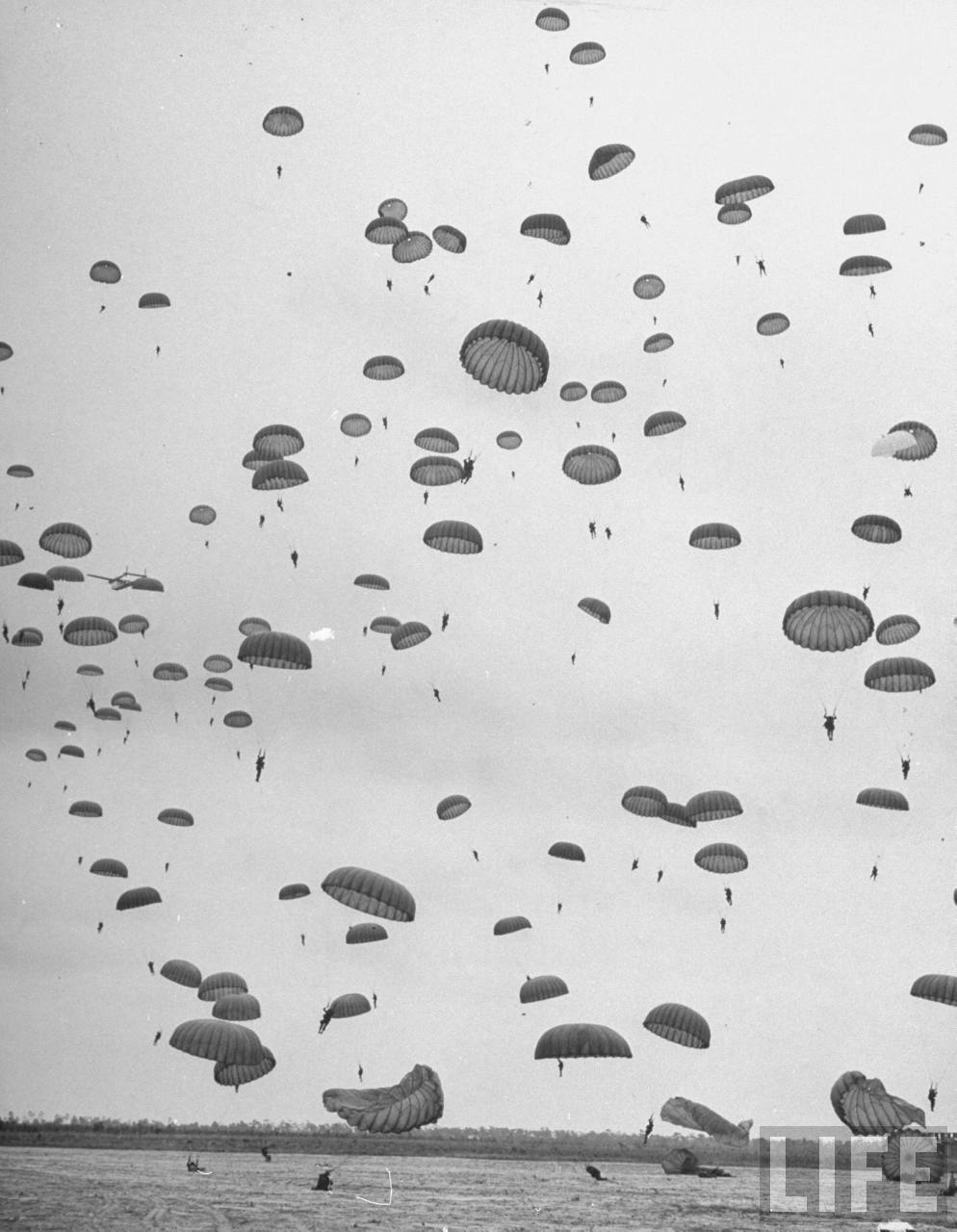
At the end of World War II the parachute in use by airborne units was suitable for individual troopers with hand weapons, and food and ammunition for several days fighting. The troopers' usually landed carrying a rifle, tommy gun, or automatic weapon of the Browning type with from 150 to 250 rounds of ammunition. Dropped from the same plane in equipment containers were the supporting mortars, heavy machine guns, recoilless rifles, bazookas, 75mm howitzers, etc., necessary to engage on even terms anything from a foot Soldier to a heavy tank. The equipment containers held loads up to 250 pounds on a single chute. There was much experiment with dropping clusters of normal sized chutes and single larger chutes, but to my knowledge there was no practical application of these methods during the war.
RR Light Tanks?
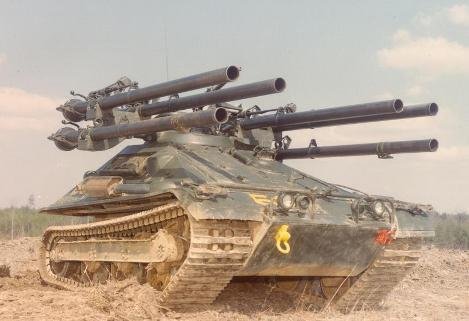
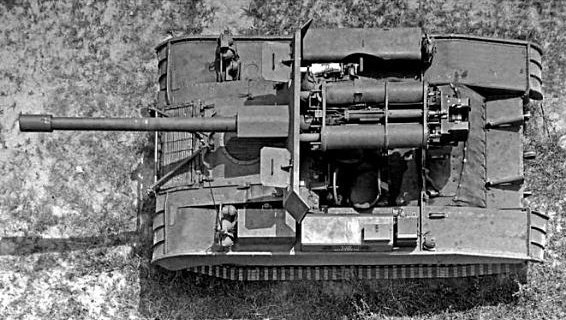
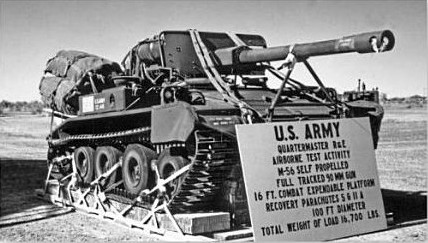
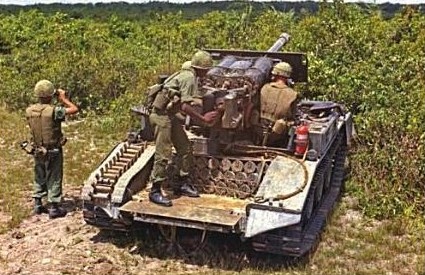
The M56 was replaced by the fabulous M551 Sheridan light tank but it was too heavy due to its turret to be helicopter-transportable but was the first tank to be parachute dropped into combat in Panama in 1989 where it achieved decisive results alongside M113 Gavins airlanded by C-5s and C-141s days beforehand.
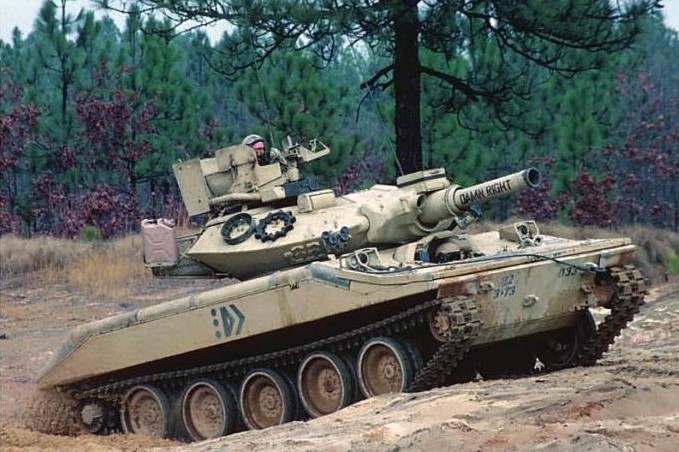
Today, we can make an "Ontos II" by shrinking the M113 Gavin chassis down by one road-wheel to make it CH-47 helicopter-transportable.
The chutes we did employ were designed for use at speeds of 100 to 120 miles per hour from planes that normally cruised at 150 miles per hour. In these circumstances individual troopers could be on the ground ready to fight in less than one minute from the time they left the plane, and a well-trained airborne battalion could begin a coordinated fight in about twenty minutes after it landed. Notably lacking, however, in the equipment of such a
Page 143
force were ground transportation and antitank weapons of long-range and high penetration. Long-range, lightweight radios were also lacking and there was need for additional medical service.
Since the war, intensive experiments have been conducted with the view to designing parachutes suitable for use at much higher speeds, chutes that can deliver much heavier loads, chutes that a man can shed faster and chutes with less tendency to malfunction.
This work continues both in this country and abroad.
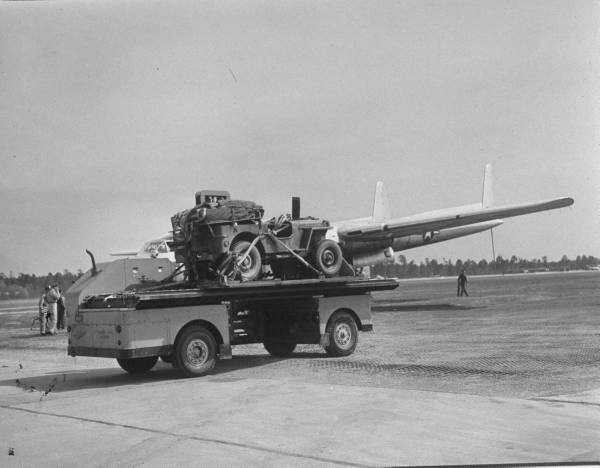
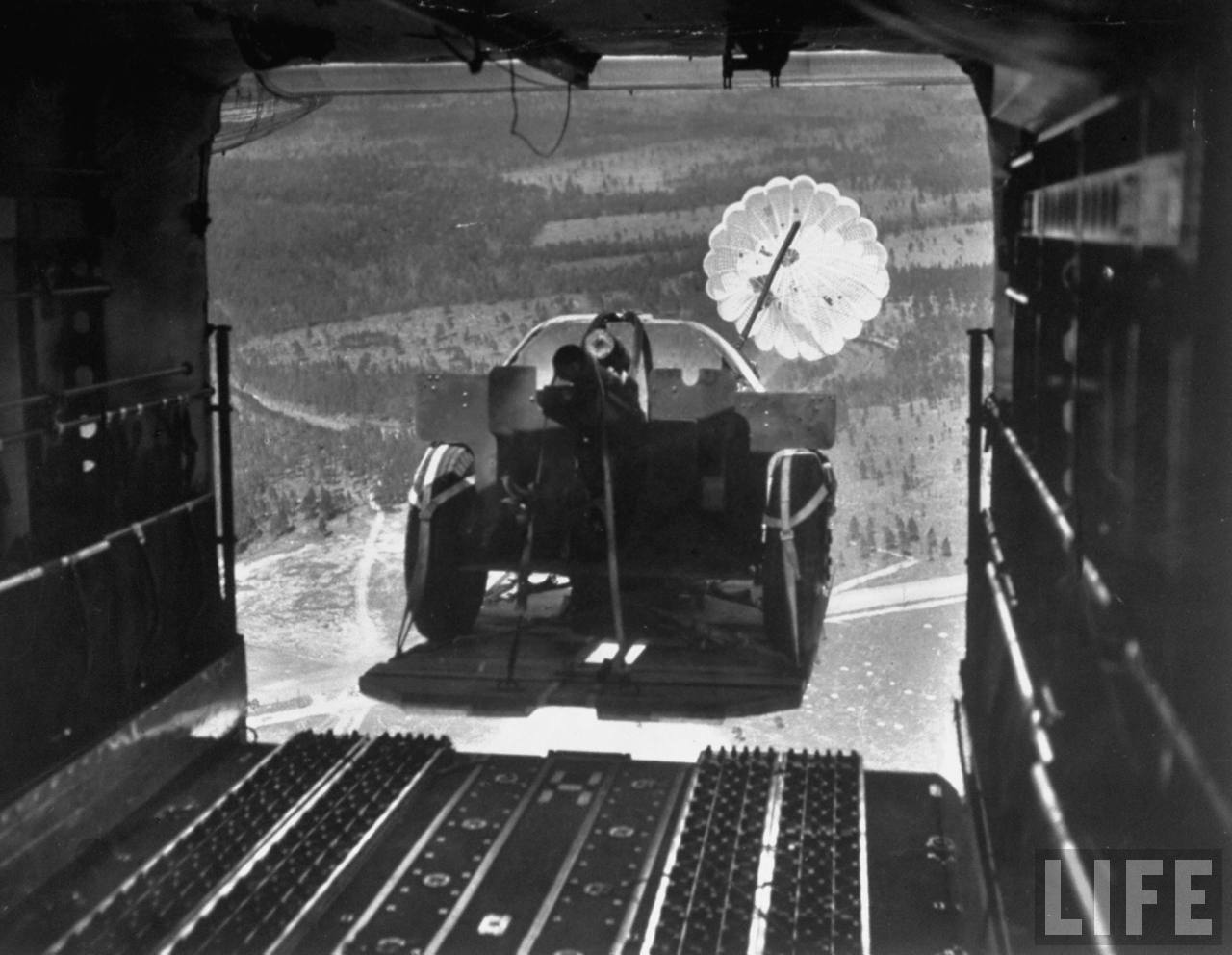
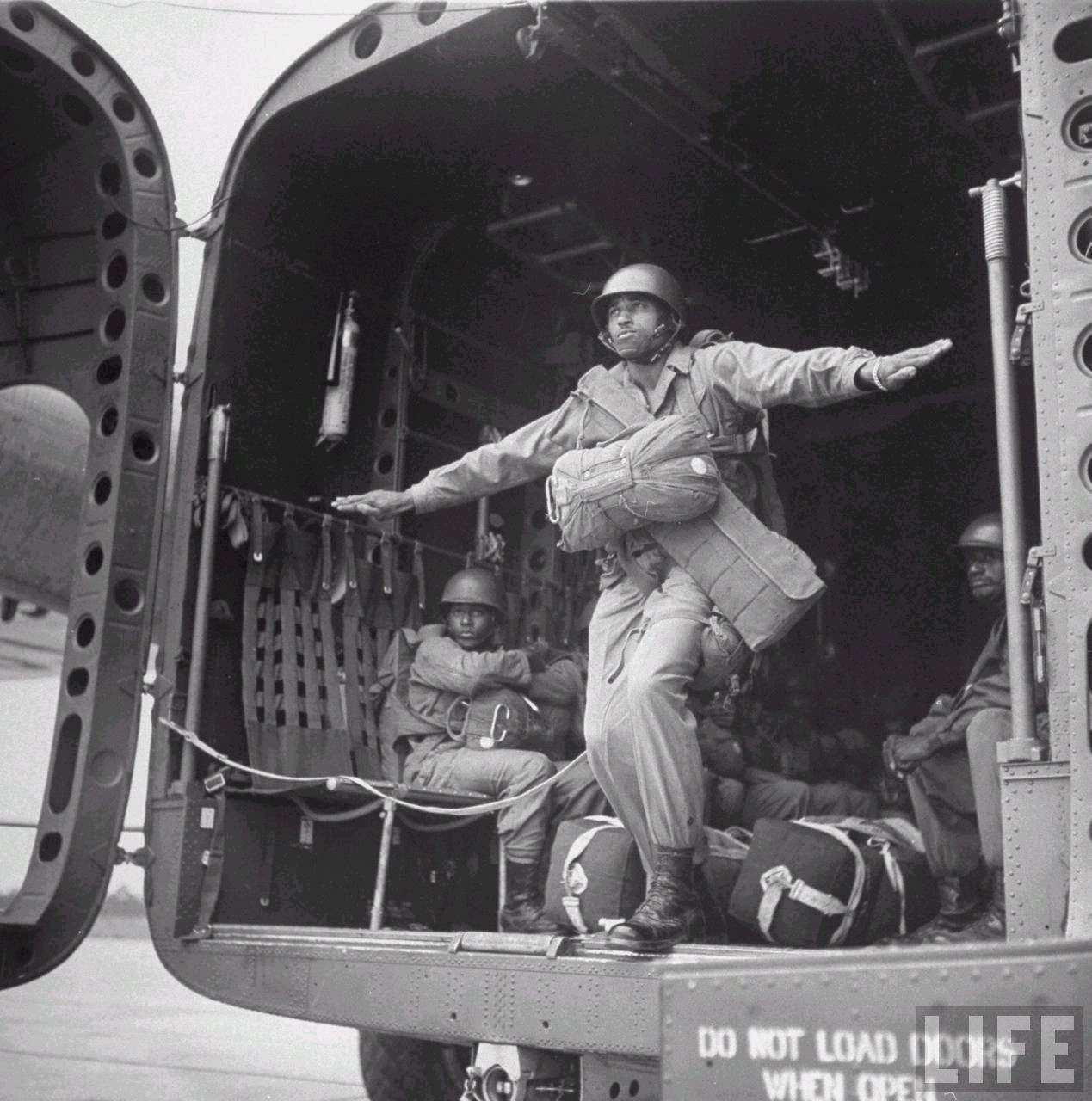
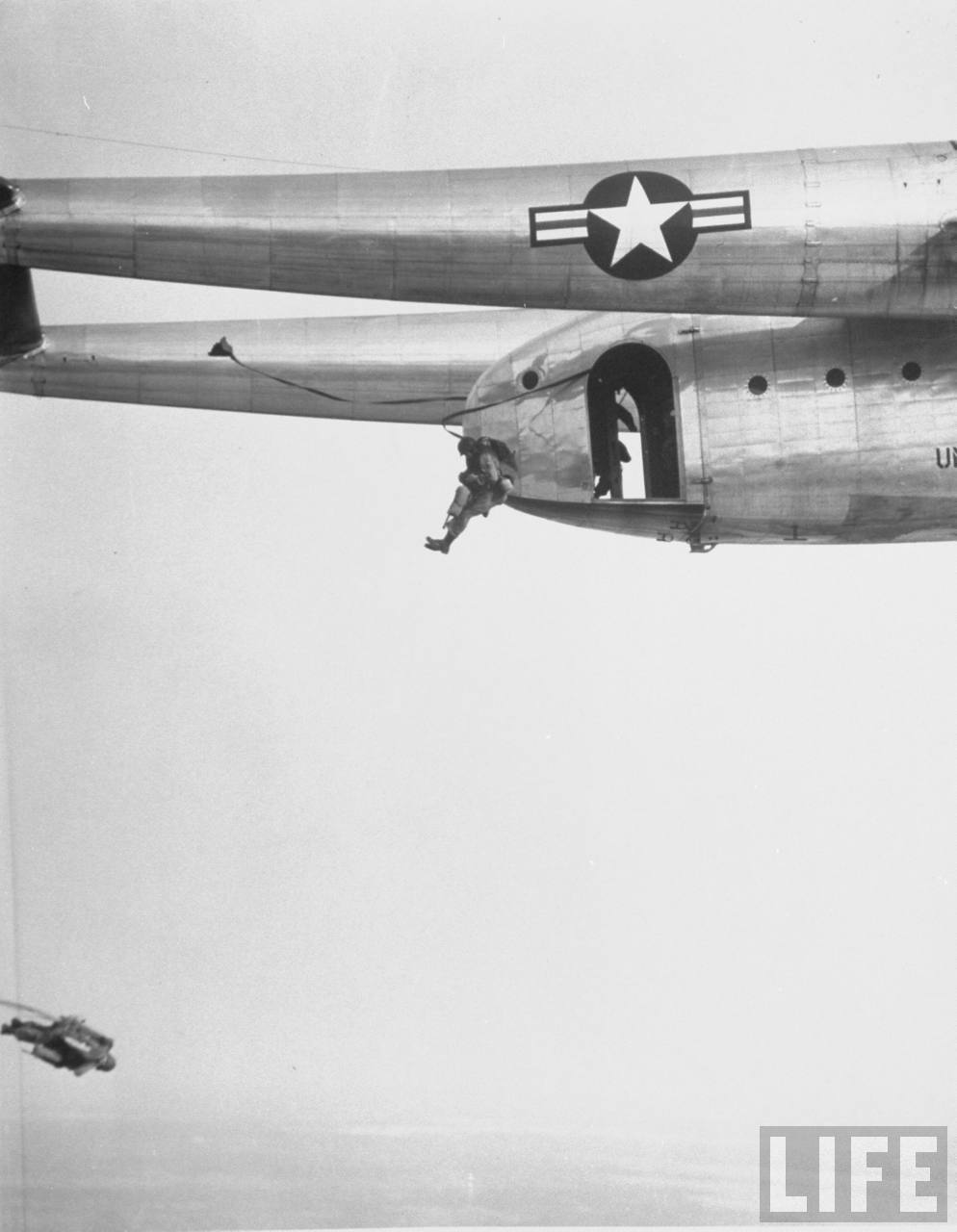
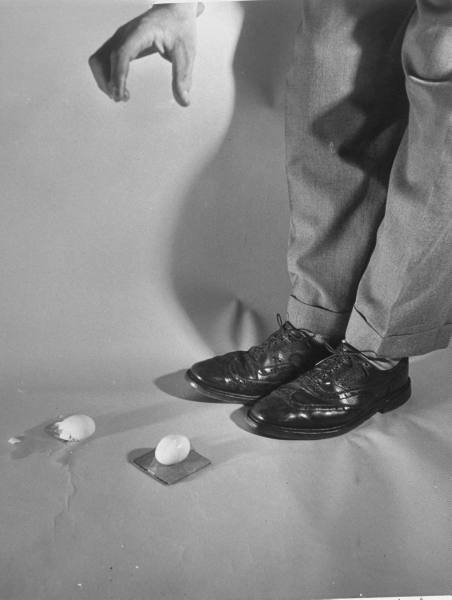
Shock-absorbing honeycomb cardboard cushions even an egg to fall without breaking!
The high-speed problem has been approached from several angles. Experiments are being conducted with elastic and wrapped steel-spring suspension lines which reduce the shock to the jumper of the opening of the chute. In recent tests, men using regular type chutes equipped with elastic suspension lines jumped at 175 miles per hour with no ill effects. Another approach to this problem has been to reduce the area of silk exposed to the air blast in the opening shock. The Germans made considerable progress in this and developed the ribbon chute. Since the conditions that result in an easy opening chute also make it descend too rapidly, such a chute must be looked upon more as a braking chute than a landing chute. Under present jumping conditions the ribbon chute may be used for opening and the reserve chute for landing.
But the most successful technique employed so far has been that of "reefing" a standard type chute. This is done by placing metallic rings on the suspension lines at a predetermined point below the canopy. If the reefing ring is placed around the suspension lines exactly at the main canopy then there is considerable delay until the pressure built up in the canopy forces the ring to slide along the suspension lines and thus permit the canopy to open fully. This delay permits the falling body or object to fall long enough to lose its initial speed. Obviously if the reefing ring is placed at the lower end of the suspension lines there will be no delay in the opening since there is no restraint on the suspension lines or main canopy. In tests conducted to date it has been possible to regulate the time of opening a chute to within
Page 144
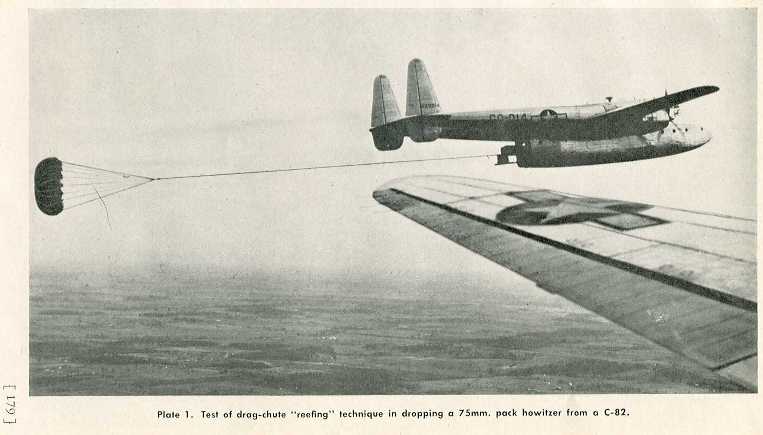
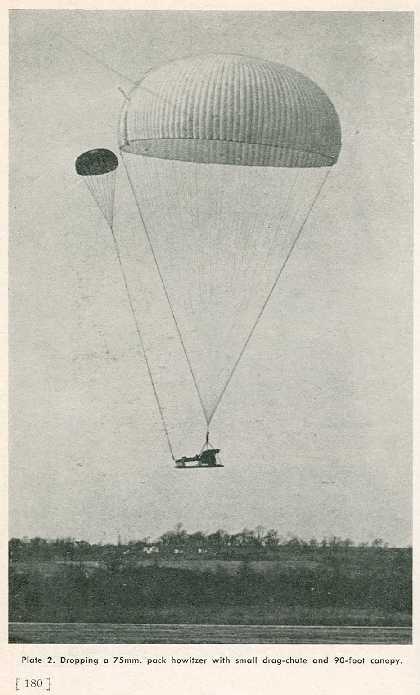
one-tenth of a second by the initial placement of the reefing rings. In dropping the 75mm pack howitzer from a C-82 (see the picture on page 179) the drag chute was reefed. This made it possible for the jumpmaster in the airplane to cause the drag chute to open at any time he wanted it to, by merely pulling the prefixed reefing ring back along the suspension lines. The pack howitzer was on the way earthward at a set number of seconds after the drag chute was permitted to open and become operative.
It is our hope that chutes can be developed, which will permit safe jumping up to several hundred miles per hour. The most intensive work in this field is being done on chutes for fighter pilots. But high speed for combat jumping of airborne troops involves one particularly difficult tactical problem, a problem that may actually hold combat jumping to the comparatively low speeds of 100 to 150 miles per hour.
Present-day troop-carrier aircraft fly from 100 to 120 miles per hour during jumps and spread their loads of 36 to 44 jumpers and their equipment over a distance of 800 to 1000 yards. The troopers leave their planes from two doors, one on each side of the fuselage. The unit dropped is usually a platoon. The distribution over such a distance creates a problem for the platoon leader, which at once becomes a very serious one if the landing is immediately op. posed in strength. To double or triple this distance makes his problem extremely difficult. It would require the use of much larger drop areas free of obstacles both to landing and reorganization. The solution may lie in designing aircraft with multiple exits. But this problem must be considered along with the developments in gliders and air transport.
There has also been considerable study and test of dropping much larger weapons and equipment and cargo loads than ever before thought possible. Larger chutes and clusters of several chutes have both been used with marked success. The British have made exceptionally good progress in this work. Recently they have dropped loads up to 6000 pounds at a rate of descent of 20 to 24 feet per second, using a cluster of three 42-foot chutes.
Page 145
This means the successful dropping of 25-pounders (76mm) and 105mm and 75mm artillery, and prime movers for all of them.
There is also good progress in drop deceleration with two methods being tested. The first employs a V-shaped tube affixed to the drop load; the tube contains sand cartridges and a propellant that is fired toward the ground from the open ends of the V just before landing. The second method works on the principle of giving the chute itself a decelerating lift just before landing. A small charge is placed within the canopy near the apex of the chute. As the load descends an accurately measured length of line swinging below it strikes the ground first and detonates the charge in the canopy and this gives the chute a sudden upward thrust, stopping the rapid descent so that the load lands lightly. In recent tests conducted at Wright Field, the 75mm pack howitzer was dropped very successfully (see the picture on page 180). Its dropping weight was 2,250 pounds. Impact with the ground compared favorably with that normal to the firing of the piece, so the gun landed undamaged. The gun was dropped by causing it to be dragged by a small drag chute from a C-82 with its clamshell doors removed. As it fell, its weight opened the main 90-foot chute against the action of the static line which was anchored in the plane. Using a 150-foot canopy singly, or in combination with a 90-foot canopy, it is practicable to drop an artillery piece and its prime mover. Some visionary individuals have even suggested that personnel carriers be dropped in this manner. The idea has merit.
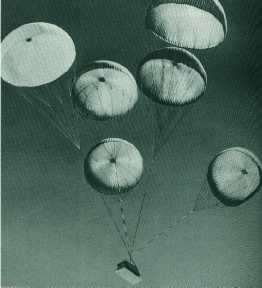
M113 Gavin Armored Personnel Carrier under Parachute Canopy: Created Later by LTG Gavin while U.S. Army Chief of Research & Development.
GLIDERS
There have been many types of gliders from the small assault glider the Germans used in Crete to the huge Hamilcar which the British used in France. These two represent completely different ideas on the use of gliders. The small German glider carried assault infantrymen with their weapons ready to fight. The Hamilcar, carrying more than eight tons, was used to bring in heavy equipment that could be transported to the airhead by no other means. Allied developments in parachutes have made the German
Page 146
assault glider technique obsolete. Nowadays most airborne commanders look upon the parachute as the vehicle for the assault infantry and the glider as the vehicle for heavy guns, radios, and so on that can be brought only with their use.
Three critical characteristics of gliders determine suitability for military use-their weight-carrying capacity, their interior and door dimensions, and their landing speed. There are many others of importance such as floor structural strength, location and number of doors, ease of handling, and limitations of flying speed.
But from the viewpoint of the using airborne combat commander the first three questions are these: What can I carry in it? How much landing space will it take? And how fast will it come in?
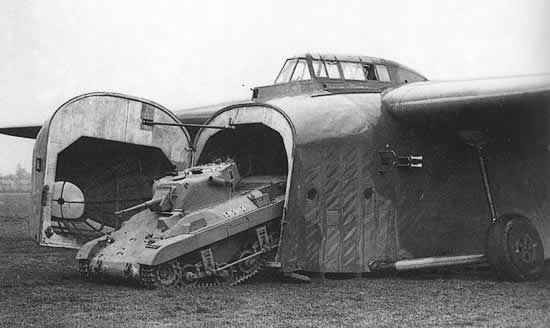
VIDEO: Gliders = Silent Wings
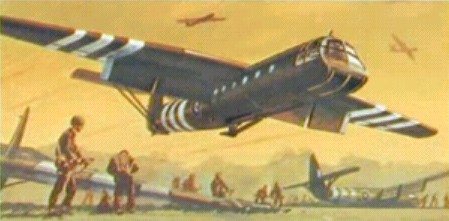
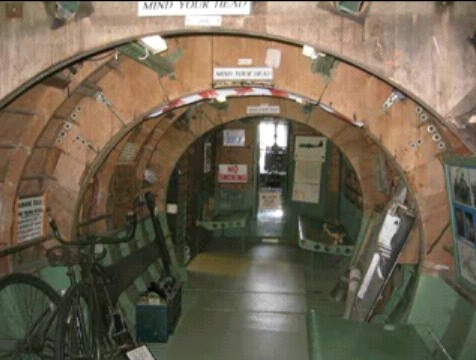
British plywood gliders were more prone to catch fire than American steel tube and fabric-covered gliders; notice the folding bicycle in the Horsa glider
 www.youtube.com/watch?v=d09YOacP-9g
www.youtube.com/watch?v=d09YOacP-9g
U.S. Waco gliders
 www.youtube.com/watch?v=prLqYQzKND4
www.youtube.com/watch?v=prLqYQzKND4
New Glider Documentary in the Making
 www.youtube.com/watch?v=cjZyaRANv4Q
www.youtube.com/watch?v=cjZyaRANv4Q
Museum in Texas: A Virtual Tour
 www.youtube.com/v/0GGyICoyDAI&rel=1
www.youtube.com/v/0GGyICoyDAI&rel=1
The most successful gliders of World War II were the U.S. CG-4A and the British Horsa. The CG-4A could carry up to 3,750 pounds which, measured in terms of effective equipment, meant two men and a 57mm antitank gun or a 75mm or 105mm artillery piece, or a jeep.
Short-Barrel M3 105mm Towed Howitzer used by the U.S. Airborne in WW2
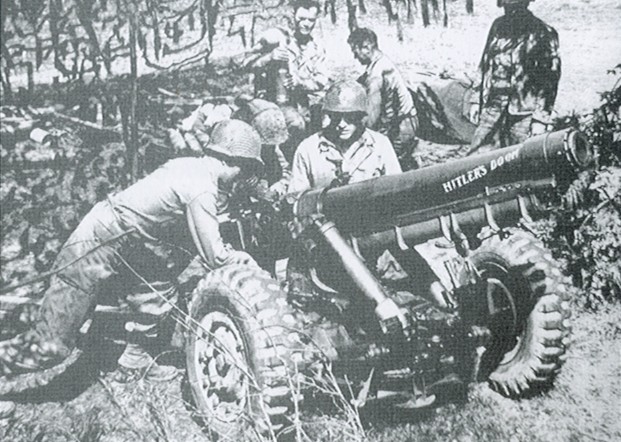
But a weapon and its prime mover could not be flown in the same glider-a serious deficiency. The glider, of cloth-covered tubular steel construction, was amazingly rugged in view of the handling it had. It landed at about sixty miles per hour. Thousands were used in all the airborne operations on the European continent.
Each Horsa = jeep + towed gun
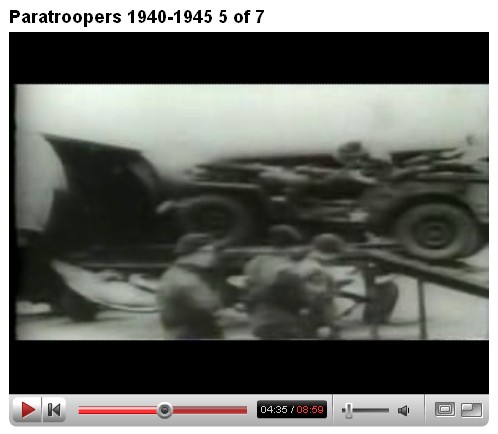
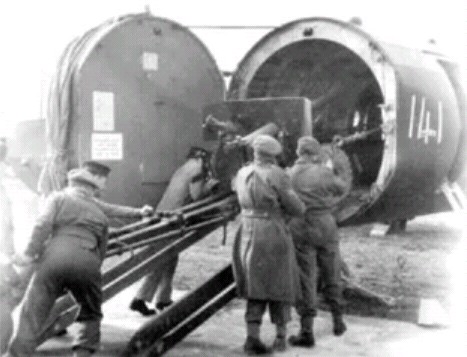
The British Horsa could carry up to 6,700 pounds-an antitank gun or artillery piece and a jeep. The Horsa was made of plywood which splintered badly upon landing. It also seemed to be rather inflammable in the heavy flak exposure it received crossing the Rhine. It was not popular with American airborne troops despite its admirable weight-carrying characteristics.
The CG-4A had one serious shortcoming when it first appeared on the battlefield, a nose opening. It took but one operation to show that four out of five gliders ended up against fences, stone walls, or trees, thus making it almost impossible to remove the combat cargo. Future gliders must open in the tail. Both the CG-4A and the Horsa used the conventional tow rope, three hundred feet of nylon from the tug to the glider. This made them take up about-
Page 147
three times as much air space as they should have, and also made it impossible to fly them in cloudy weather.
The present glider development program is directed toward improving conventional type gliders with the lessons in mind that were learned from the war. All-metal gliders with tail openings suitable for carrying into an airhead the weapons and equipment necessary for engaging on favorable terms anything that may be encountered on the ground, are now in production. Without going into airborne tactics too deeply at this point, I should point out that in the final analysis the measure of an airborne unit's effectiveness is its ability to hold what it takes. Its greatest mobility is in the air and after it lands it should have little need to move considerable distances except for reconnaissance and security.
Under present conditions of ground combat the backbone of the defense of an airhead is its antitank defense. Consequently the greatest contribution gliders can make to airborne tactics is to bring to the battlefield antitank defensive means, anti-personnel artillery, reconnaissance and security vehicles, and airfield construction engineers, in that order of priority. With this in mind, gliders are being developed which will carry four and eight tons.
Their ultimate development will depend largely upon the progress made in air transports. It is clear that in airborne operations a point will be reached when it will be more profitable to land power airplanes with heavier loads than to continue the use of gliders. This would seem to put a ceiling of about ten to twelve tons on the requirement of a tactical glider. Larger gliders will undoubtedly be developed for strategic uses, such as the mammoth Me-323 Goliath, capable of carrying sixteen tons, which was used by the Germans in the Mediterranean area.
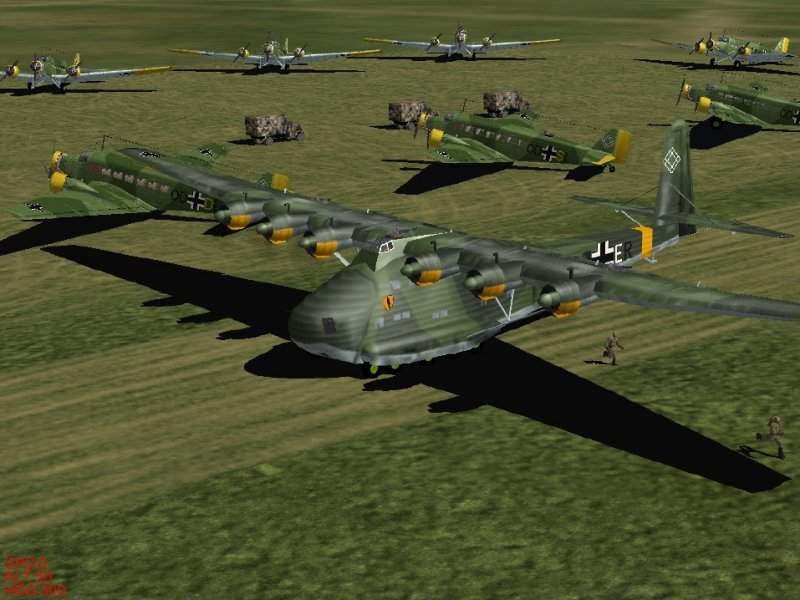
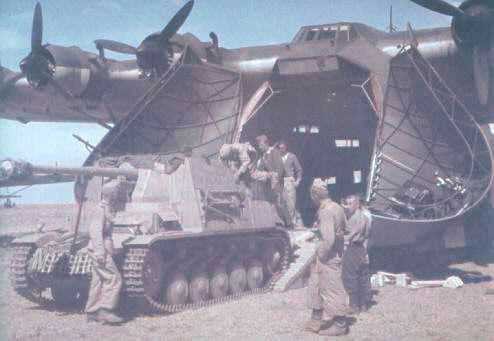
 www.youtube.com/watch?v=R1S16jLUVpM
www.youtube.com/watch?v=R1S16jLUVpM
The Germans wisely exploited the excellent Czech-built 38T light tank chassis all throughout WW2. Here a 38T chassis is the basis for the Marder II turret-less assault gun or "STUGs" that were the most successful tanks of WW2.
TRANSPORT PLANES
The United States has the greatest air transport production potential of any nation in the world. Leading the world with such ships as the Douglas Skymasters, Lockheed Constellations and the Constitution, Boeing Stratocruisers, Republic's Rainbow, the air industry of the United States is well out in front. With the
Page 148
know-how acquired is producing the types now flying, and the lessons to be learned from the flying wing and jet types, American air engineers should have the field to themselves for some time to come. These transports have the following characteristics:
STRATEGIC TRANSPORTS (10,000-pound Payload) Range in Miles
Skymaster (C-54) ....................... 3,700
Stratocruiser (C-97) ..................... 3,800
Constellation (C-69) .................. 3,900
Rainbow. (XR-12) . . . . . . . . . . . .. 4,000
Globemaster I
(C-74) ................. 4,300
C-74 has bomb-bay cargo elevator floor
Constitution. . . . . . . . . . . . . . . . .. 4,400
XC-99 (converted from B-36)........... 10,000
Besides these large airplanes, there are several smaller types, at least two of which have proven themselves combat-worthy. The Douglas C-47 and the Curtis-Wright C-46 turned in fine performances under fire, especially the C-47 which was in use in the opening days of the war. Of recent date, the Fairchild Packet known as the C-82 has been used in training by airborne troops.
The characteristics of these airplanes are as follows:
Cruising Speed (mph) Payload Type (Tons) Range (Miles)
C-47 160 3 1200
C-46 175 5 750
C-82 200 5 1200

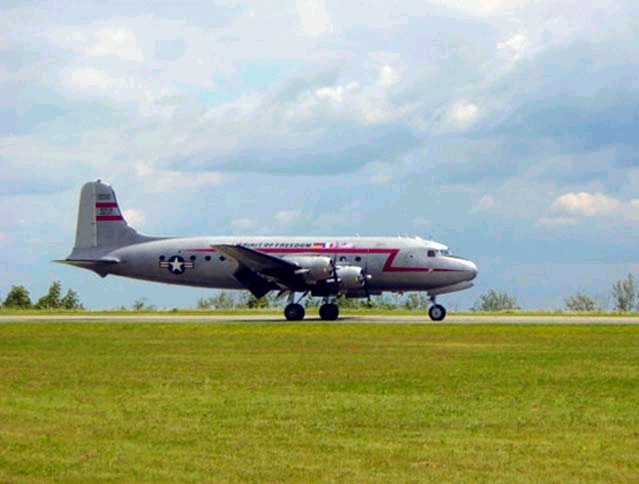
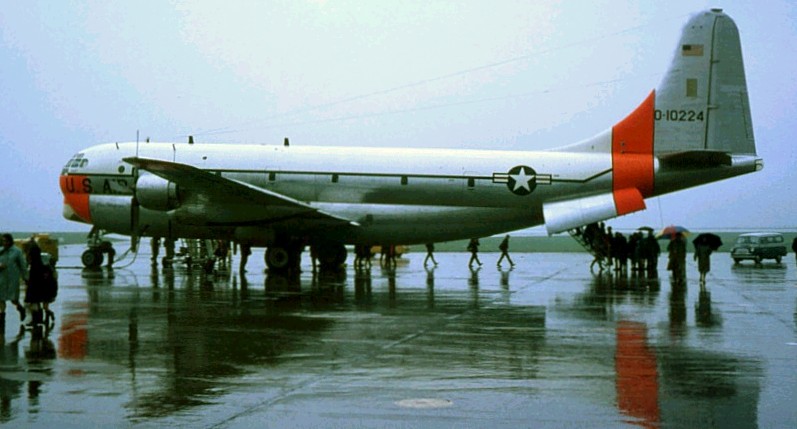
Derived from the B-29 bomber, the C-97's cargo was loaded through large clamshell-type doors in the belly of the aircraft using a built-in ramp and a hoist. Paratroops could jump through this opening (see 1965 James Bond movie, "Thunderball")
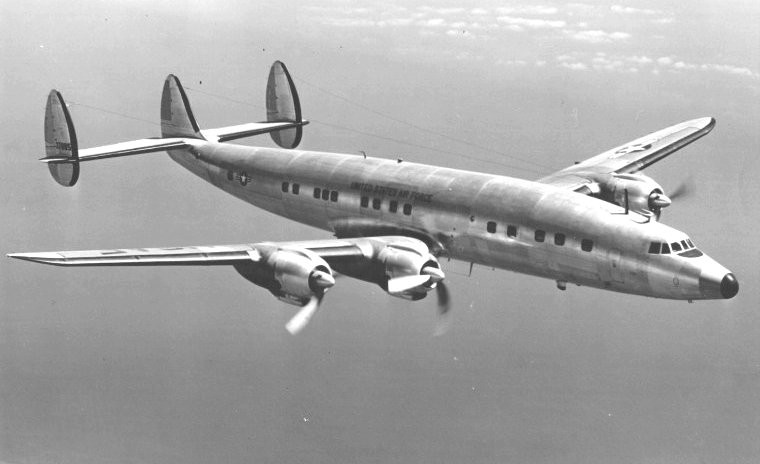
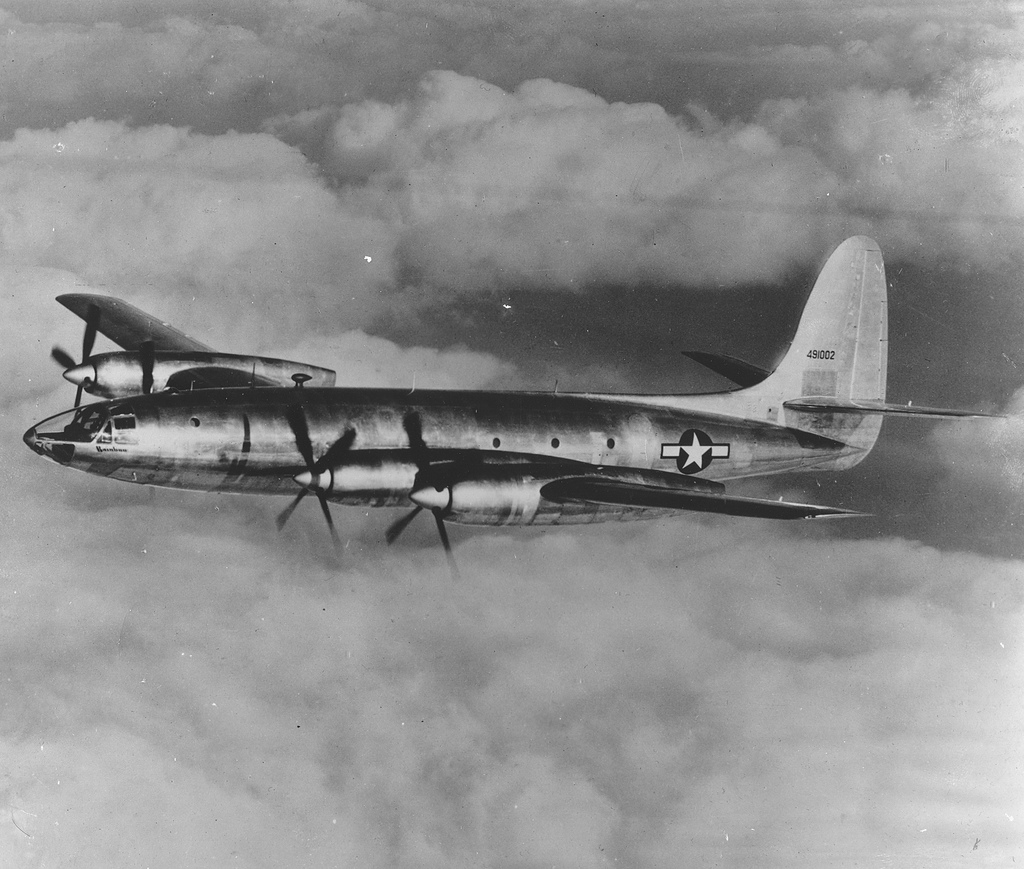
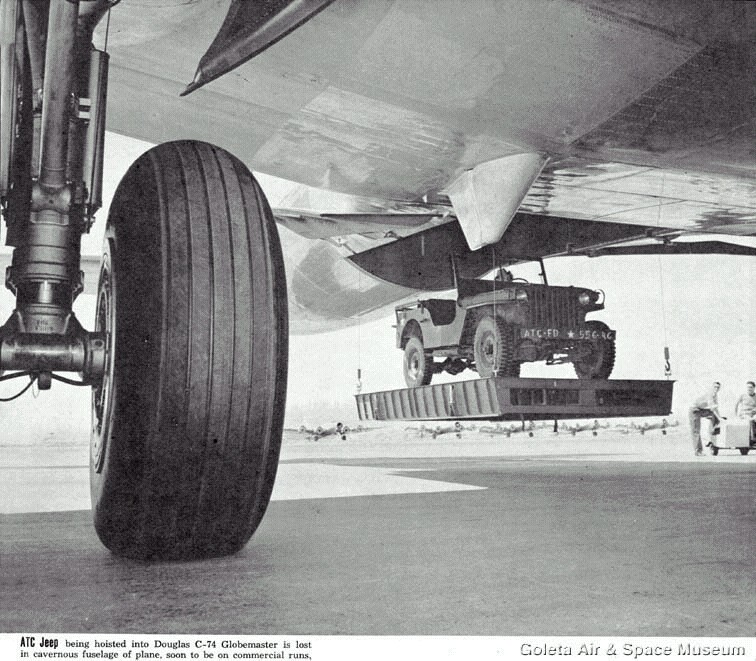

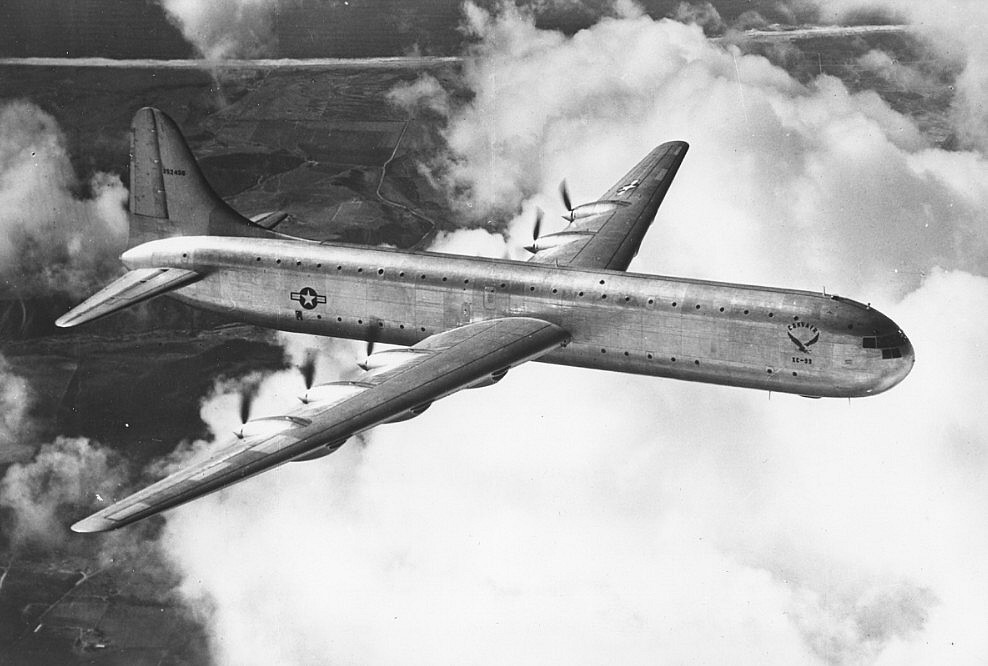

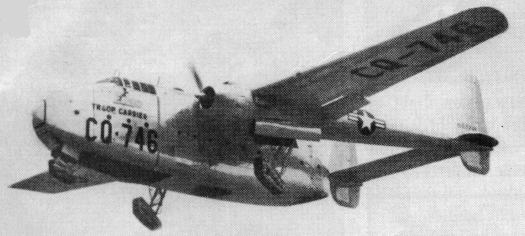
C-82 with tractor gear. Only one was produced, but the idea was to reduce the pressure exerted from 60 psi to 20 psi and give it the capability to land anywhere
The ideal troop-carrier combat transport would appear to be a large transport of the twin-boom type for which personnel, artillery, and vehicles could be dropped. It should have a range of two thousand miles and should be equipped with self-sealing tanks, pilot armor, and a retractable track-laying undercarriage. This last feature would permit its landing and takeoff in pastures and cultivated areas. It would thus be able to enter the airhead early in an operation, landing and taking off from areas normally
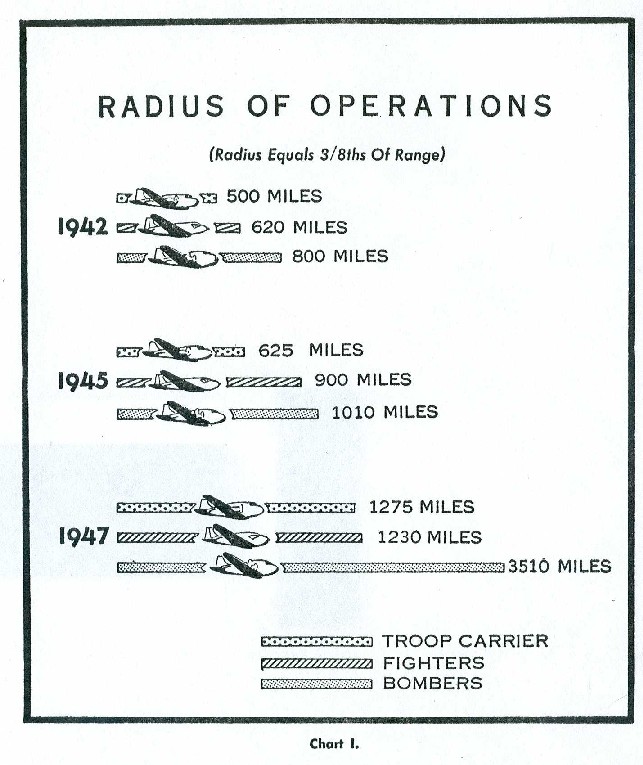
Chart I.
suitable only for gliders. Troop-carrier transports of this type must be designed with droppable or detachable fuselages.
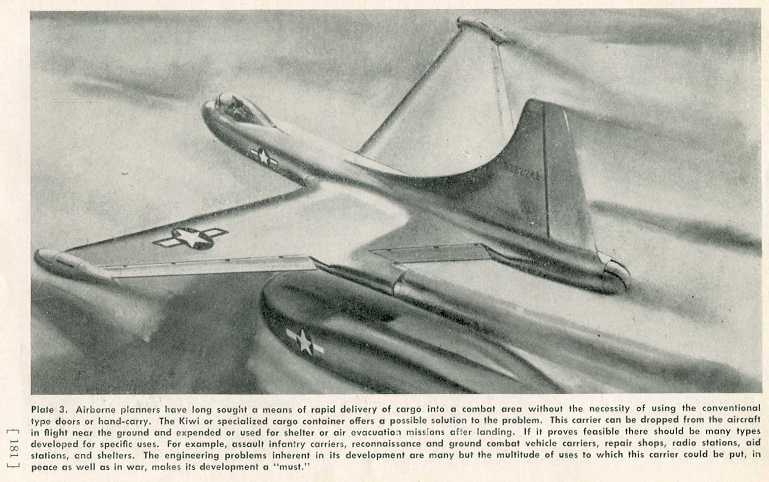
DISCUSSION: Container Transport Planes: Cow Pasture KIWI Pod Aircraft for Speedy, Minimalist Air Delivery
LAPES (Low Altitude Parachute Extraction System) from 5-10 feet has been discontinued from USAF use due to a fatal accident at Sicily Drop Zone on Fort Bragg, North Carolina when a M551 Sheridan light tank on a platform as it rolled off the rear ramp of a C-130 caught both the ground and the edge of the ramp, ripping the plane's tail off. The pilot was actually TOO LOW. The idea of LAPES--using the minimum of parachute materials to get a load to the ground is sound, it just didn't go far enough because it was trying to WORK AROUND A FUSELAGE, subsidizing a pre-existing inefficiency.
LTG Gavin realized this long ago in 1947, in his book Airborne Warfare [www.combatreform.org/airbornewarfare.htm] that the most efficient way to be already loaded and ready-to-fight is to be already be in a KIWI POD, and the fastest way to get this stuff to the ground is not to pull it out break-bulk from inside a fuselage but to DROP THE ENTIRE KIWI POD. If you drop the pod you don't have risks of getting caught up inside the fuselage.
We have Gavin's KIWI pods today--they are called ISO shipping containers. These containers can be made into "BATTLERBOXes" for specific Army missions like being bunkers for troops to live in as well as carry everything the Army needs to fight etc. The early-model Sikorsky CH-54 SkyCrane VTOL helicopter was ahead of its time but required special expensive lightweight pods to conserve its limited 15-ton payload that the Army couldn't afford to buy. The Army today doesn't need costly single-application pods, there are millions of ISOs that can travel by land, sea or air available at less than $5, 000 each. What the Army needs is the USAF to do its damn job and supply a fixed-wing SkyCrane-type transport plane that can deliver 100 tons and drop its BATTLEBOXes with extreme STOL "cow pasture" landing capabilities.
This is a bugaboo because the fighter-bomber jock USAF wants to try to win wars by firepower bombing and doesn't give a damn about helping the Army to win wars by maneuver. The USAF has for over 6 decades refused to supply the Army with a plane that can land on any cow pasture by conveniently only creating runway dependant transports that could parachute airdrop things IF the Army takes the time to rig them with expensive and costly parachutes. This is fine to take a drop zone by assault but afterwards for RESUPPLY the USAF wants a secure and smooth, long 3, 000 foot minimum runway which places Army Paratroopers in a suicidal position of having to first take a heavily-defended airfield or build-one-from-scratch. The latter is do-able but it takes TIME we may not have provided us by a laggard enemy.
All of this complication can be solved by simply creating a C-17 SkyCrane derivative that can carry and DROP 10 x 20-foot BATTLEBOXes from very low altitude as in ZERO---because the plane itself touches only a small air cushion and as it flies forward, ISO containers are dropped in sequence from back to front without ANY special parachutes or platforms.
 www.youtube.com/watch?v=XKeCVYTiIWg
www.youtube.com/watch?v=XKeCVYTiIWg
The BATTLEBOXes might be lined with SKEDCO plastic on the bottom to slide easier along the ground---but that's it. The KIWI Pod C-17 doesn't need a smooth surface for landing gear wheels because its Air Cushion Landing System (ACLS) enables it to land on any roughly flat unprepared surface to then commence BATTLEBOX dropping from such a low actual height that no position-righting parachutes are needed nor any parachutes to pull it out from the fuselage BECAUSE THERE IS NO FUSELAGE! There will not be any LAPES/Sicily Drop Zone type accidents, after the C-17 SkyCrane has dropped its BATTLEBOXes, it takes-off and leaves the assault zone even if its considered "secure" because we don't want the bottleneck of "MOG rate" that occurs when wheel landing gear planes need to after landing taxi back to an upwind take-off position, hogging up the runway. With C-17 SkyCranes there wouldn't be any runways---just an open area with lanes marked on it so multiple C-17s can essentially touch 'n go and drop their BATTLEBOXes.
After the C-17 SkyCrane takes-off from its designated lane, 10 x special M113 Gavins tracked armored fighting vehicles with forklift tines on their front bulldozer blades drive to the 10 x BATTLEBOXes and pick them up like the video game "Pac-Man" and drive them to the collection point, clearing that SkyCrane lane for another pod drop-off sortie. The British figured out they needed tracked armored vehicles to clear supplies off exposed drop and landing zones by glider-landing Bren gun carriers in 1945, and we are long overdue to use this method.
The C-17 SkyCrane-BATTLEBOX would dramatically speed the delivery of supplies to Army forces because there'd be no parachute/shock absorber rigging cost/complication and at 5 tons per BATTLEBOX there'd be plenty of ammo, food, water to grab by simply opening the doors of the ISO containers and getting what you need. The Army just has to grab the entire BATTLEBOX and move it to where it wants it, to include arranging them as walls to create fortified forward operating bases. All that requires for this to occur is for Congress to order and fund Industry/USAF to create and field C-17 SkyCranes to create the EFFICIENCY up-front to deliver containerized supplies without having to work around built-in cargo volume fuselages--current transport aircraft are like old fashioned cargo ships and need to become containerized to be maximally efficient like the container ships the entire world depends on.
Air transports for military purposes fall into two classes; strategic airplanes of the Stratocruiser and the Constitution types, and tactical airplanes of the C-47 and C-46 types. The larger planes are now being produced and flown by civil aviation.
There is a distinct parallel between the military uses of aircraft and seacraft. Larger ocean-going vessels have lent themselves well to the strategic movement of troops. Tactical vessels however
Page 149
had to be manufactured for a particular combat use. For some years we tried to adapt ordinary seacraft to amphibious operations, work for which they were never designed. We seem to be doing the same thing in aircraft today. Commercial airplanes have fought our tactical battles so far despite their limitations.
But the future of airborne operations requires the development of tactical aircraft embodying certain combat essentials, notably self-sealing tanks, pilot armor, interior arrangements to facilitate parachute operations, built-in recesses for paracontainers, arrangements for glider tow with built-in phone connections, and other special items. It is imperative that we make steady progress in such planes if we are to maintain any effective airborne forces.
General H. H. Arnold stated in 1945 that guided missiles will replace the heavy bomber. In September 1946, Lawrence D. Bell, president of the Bell Aircraft Corporation, said that the ultimate military weapon is "a long-range, high-speed guided missile carrying an atomic head that is capable of being directed by automatic navigation to its target." The principal future of the airplane in war is clear. It is that of the highly developed troop carrier transport and its accompanying escort, backed by a fleet of large strategic airplanes; the parallel between sea battles and air battles is again obvious. What we must develop now is the counterpart of the LSTs and LCTs with their accompanying destroyers and PT boats. Until we develop such craft we can make little real progress in airborne warfare.
So far the means discussed for solving the problem of getting from the airplane to the ground under specified conditions have been limited to the parachute, the glider and air transport. The ideal type of troop-carrier aircraft would be one that would permit the release of the entire fuselage as a land vehicle upon landing or at an altitude of a few feet upon arrival at the airhead.
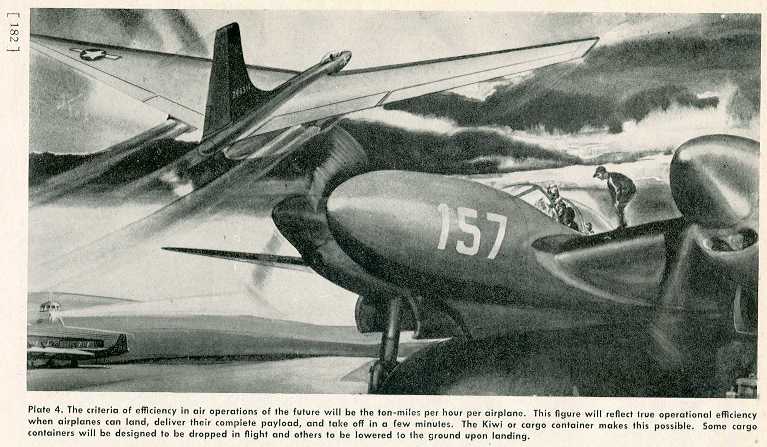
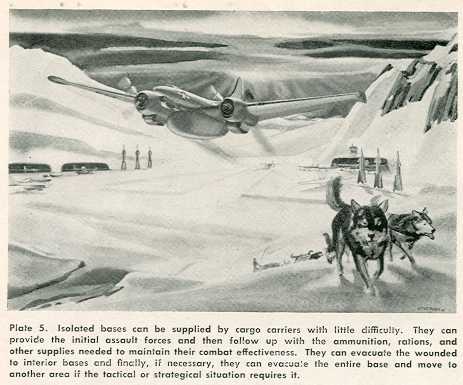
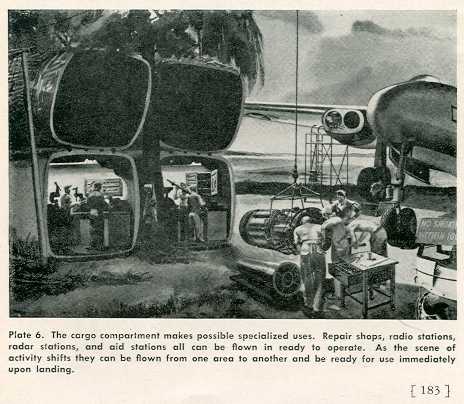
The pilot could then return with the power plant and pick up another cargo body to be flown into the combat area. If such a craft can be developed it would have all the advantages of the glider without the tow ropes, wings, and control surfaces.
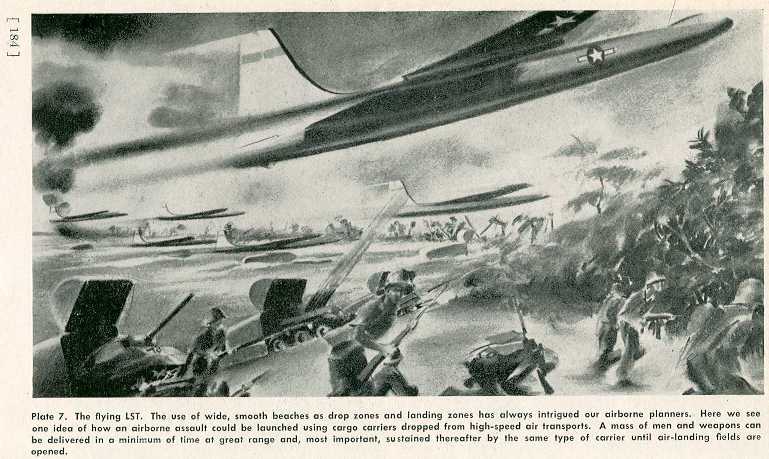
It could also be used as a land vehicle and thus regain for airborne troops some of their
Page 151
lost tactical mobility. Here again, the development of the DUKW for amphibious purposes offers an interesting parallel. There were many who thought the DUKW could not be developed effectively.
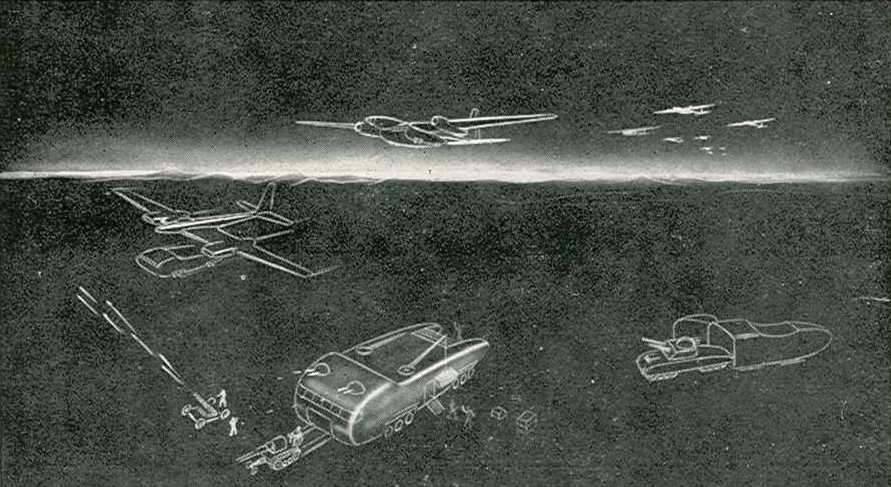
This "kiwi" (we may as well call it that as anything else for by itself it is a bird that can't fly) may, if properly developed, make parachutes and small gliders obsolete. Its development would be a great advance toward making all ground forces airborne, for the special training now needed for parachuting would no longer be required.
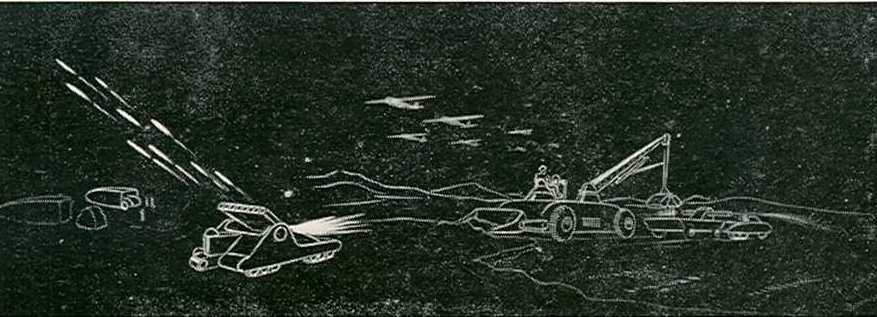
The helicopter also offers interesting possibilities, especially if the rotating members could be kept folded in the mother plane until the helicopter is dropped. Then the airborne cargo could be lowered to the ground with some selectivity in landing. Somewhere in these fields of development lie the future craft of airborne war.
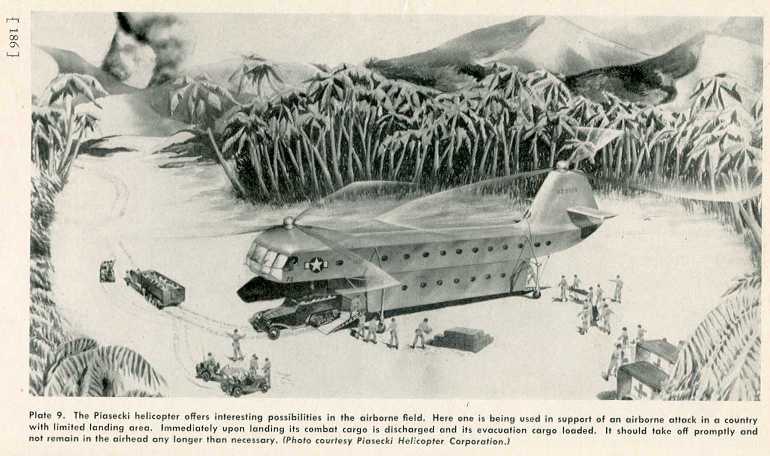
I have so far summarized the developments in the means of transporting airborne troops to close proximity with the enemy.
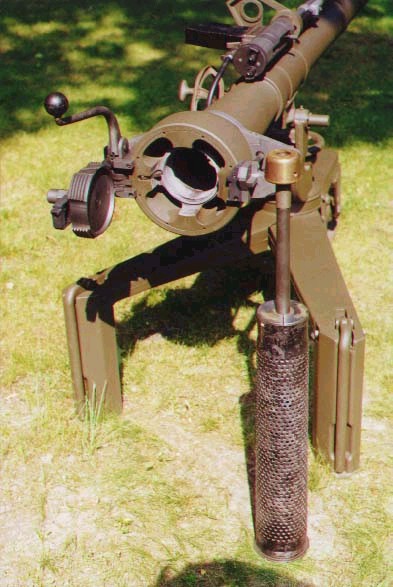
The M40 106mm recoilless rifle has a legendary capability to take out targets
Before going on to discuss the application of these means of transport, I should point out the rapid strides toward improvement of the weapons now available to airborne troops for ground combat. Recoilless artillery, hollow charge weapons such as the bazookaand panzerfaust, lighter metal in weapons construction have all improved the. chance of survival on the battlefield for airborne units of all sizes. In fact they can not only survive, they can carry the attack to the enemy deep in his own territory.
CRITICAL FACTORS IN AIRBORNE OPERATIONS
Experience has shown that there are several factors which are critical when we are endeavoring to apply the means of conducting airborne warfare. These are the number of aircraft required, the number of airfields required for take-off, the air space that we must dominate, and the range of our aircraft.
It is interesting now to recall that as late as 1942 the faculty of one of our leading service schools was generally of the belief that airborne operations were impossible on a divisional scale be-
Figure A.
A division can seize and hold for several days a perimeter of fifteen miles and dominate the area enclosed within that perimeter. But In the future, with considerably greater dispersion in both the attack and the defense, It Is very likely that this effective perimeter may Increase to twice or three limes Its present circumference. If this is the situation the attacking division after seizing its initial area will constrict itself to conform to the weight and location of pressure applied by the defender. It would be fatal for a division to remain congested In an area four and a half miles across unless actual enemy pressure made this necessary. If the airhead Is to be the Initial phase of a large-scale airborne attack then the use of a corps offers much better prospect of success. The capabilities of a corps, for purposes of illustration are shown as three limes those of a division. The corps, in my opinion, is the smallest unit that offers promising tactical prospects in the establishment of an Independent airhead. It Is large enough to contain several airlanding areas and It can provide protection to the airlanding of several divisions.
cause so many take-off airfields would be required. There seemed to be no argument with this thesis then; it appeared sound. But since 1942 the airfield problem has been well solved as the charts I, II and III show. We all know now that the simultaneous lift of a corps was readily accomplished in 1944 and 1945. And as the size of the aircraft employed increases, this particular problem becomes simpler. It will, however, again become a very serious logistical problem in the future when we need to stage the lift of one or more armies and at the same time provide sufficient dis-
Page 152
Figure B.
This illustrates schematically the development of an army airhead. Beginning with the landing of the Initial corps on D-Day plus 1 the entire corps airhead should be cleaned up and the airhead ready to receive the second corps. While the second corps is coming In, units of the first corps landed should expand the airhead in the direction of the expected advance for from five to ten miles. By dark of D plus 2 the new airhead should be established and reconnaissance pushed well out in the direction of the attack to be made on D plus 4 to 6. By D plus 4 to 6 the army command post should be established in the airhead and the ground mission well under way. The forward command echelon of the troop-carrier command should arrive In the airhead and become operative by the time the airborne army command echelon arrives.
persion for a reasonable degree of passive protection against atomic missiles.
The range of aircraft has always determined where we could go, and to some extent what we could do. Range varies inversely with the payload. It now appears that the range of troop-carrier tactical aircraft will be about 2000 miles. This could be the maximum range increase for tactical aircraft if the development of air power should follow in form the development of sea power. The larger strategic aircraft will ultimately become global planes of great carrying capacity and high speed, whereas tactical planes will be designed, armed, and built for the specific mission of airborne combat close to the enemy.
AIRBORNE ATTACK
Any airborne force with an offensive mission must perform the
Page 153
Figure C.
An airborne corps can dispose of Its Initial landing units In any manner necessary to accomplish Its first mission of establishing Itself firmly In enemy territory. The extent of the dispersion Is normally determined by the number and type of subordinate missions that must be given to smaller units, the location and size of available drop and landing zones, enemy flak and troop dispositions, and probable enemy reaction to the landings. In the Holland operation of World War II, divisions were twenty miles or more apart; In Normandy and the Rhine crossing they almost overlapped. Dispersion usually means loss of control. Even so, consistent with the speedy and certain accomplishment of the mission, units should be dispersed as much as possible. Tactical dispersion as a passive defense against atomic attack
Page 154
Charts II & III.
following tactical steps. First it must land in hostile territory where it must establish itself firmly, securing itself against surprise and directly aimed ground fire. Next it must reinforce and resupply itself. Finally, it must move in the planned direction the force necessary to accomplish its specified mission. These steps constitute the establishment of an airhead just as amphibious means in a similar manner establish a beachhead. The only difference between an airhead and a beachhead is that an airhead covers 360 degrees whereas a beachhead usually covers 180 degrees. An airhead is two beachheads back to back with the reinforcements and resupply coming by air instead of by sea. And as for delivery potentialities, it is about as easy to deliver several hundred tons of supplies and equipment per hour by air as it is to deliver the same amount per day by sea. These tonnages can be delivered; but to handle their mountainous proportions there must be in the airhead a sufficient number of trained and equipped airhead service troops.
An analysis of the airborne operations conducted to date and an estimate of the capabilities of the future troop-carrier airborne team indicates clearly just about what our potentialities are. Figures A to F (pages 152-160) are based upon what does appear to be practicable in the foreseeable future with the means now becoming available. The illustrative figures are schematic, and
must always be in mind. If the corps is dispersed over an area enclosed by a perimeter of 50 to 150 miles, there should be enough room for this dispersion. After the initial airhead is cleaned up there must be Increased attention to aggressive reconnaissance, especially against developing enemy resistance and toward the area of probable expansion.
Page 155
Figure D
So far, I have shown the growth of an airhead In a schematic manner to Illustrate the capabilities of airborne units. In this figure there Is an Imaginary tactical situation. The airhead includes six actual or possible airfields, the capture of which must be definitely assigned to certain units. If enemy flak and ground dispositions permit, It will be best to land right on them. The area shown for the airhead is bounded on one side by a river, with the thought in mind-always important-of definitely limiting or canalizing the direction of enemy armored attack.
There are two Interior bridges in the airhead. The capture of these is always most important.
In every large airborne attack in World War II, the seizure and retention of bridges, especially interior bridges, had a decisive bearing on the outcome of the fight for the airhead. They must be captured if the initial assault force is to be able to shift reserves, antitank guns, artillery, reconnaissance and communications vehicles, and, in the final analysis, continue to exist as a combat entity. The capture of each must be specifically assigned to a given unit.
They should be hit from both sides. All unit commanders must be familiar with the plan to capture them In case their unit, through accident, lands near them.
While some units are given fighting missions to perform immediately upon landing other units are given contact missions. If the troop carrier has delivered airborne units to their correct areas, all interior contact should be made and the reorganization following the landing should be buttoned up in a matter of hours.
Page 156
are intended to illustrate the idea. They are not applied tactics. The old saw that "a chain is no stronger than its weakest link" applies to airborne as to all other military organizations. So far this discussion of airborne offensive tactics has limited itself to the whole "chain", the complete airhead. Clearly, if the subordinate units do not have the means, ability, and skill to fight well, the airhead will be short-lived.
Small-unit tactics in airborne organizations differ very little from those of any other ground unit. One difference-the first problem to be solved upon landing-is that of reorganization and initiation of combat. All airborne units have their SOPs for this.
They are based upon the principle of using every assembly aid permissible without enemy interception and interference between friendly units. Recognizable terrain features, flares, infrared signals, smoke, assembly lights, and radios, directional and otherwise, all play a part in accomplishing the assembly. Small-unit training emphasizes the following which are considered characteristically airborne:
* Speed and a rapid initiation of combat immediately upon landing.
* Retention of the initiative by all individuals and units from the moment of landing until the objective is seized or the mission accomplished.
* Recognition of isolation as a normal battlefield condition.
* Readiness of all units to attack or defend in any direction at any time.
* Improvisation of weapons and means, and the use of enemy weapons and defensive works to our own advantage.
* Extended intervals and distances in the defense with a "screening and counterattack" type of defense.
Tough, trained, properly equipped troops, imbued with courage and confidence in themselves, given sensible and courageous leadership can accomplish any of the airborne missions I have outlined. The divisions for the assault echelon should be care-
Figure E.
I assume next, for purposes of realism, that by dark of D plus 1 the airhead Is tidied up except for one airfield still held by the enemy within the airhead and another on one side of the airhead that we were unable to capture. One bridge was destroyed and one was captured and is usable. Effort must be now concentrated on capturing the airfield within the airhead and the engineers must be put to work on new airstrips and another bridge. Advance parties of the second corps should now be coming in. Supply units of every echelon should be working at top speed to recover supplies and establish their dumps. Aggressive reconnaissance should be operating In all directions from the airhead and the reconnaissance units should have a definite feel of any large enemy forces nearby. By dark of D plus 1 the initial assault force should have the situation well In hand and should be looking to the next phase In the over-all operation.
fully selected and especially trained. For when they go in, they go in as every airborne force has in the past, they go in to conquer or die. Theirs is not a choice. Their mission is to do their job and do it well. With the great dispersion we shall have in the future, with the strategic and tactical transport now in development, and the improvements being made in hand weapons, the future use of
Page 158
airborne troops is limited only by the imagination and courage of their commanders.
Before I leave the subject of tactics for airborne attack, the analogy between the development of sea power and the development of air power is worth reviewing. Commercial vessels of global range have been used strategically exactly as we must use global air transport: Commercial air transports, however, are not suitable for troop-carrier tactical employment. In close proximity to the enemy, and in airborne operations as influenced by the development of atomic weapons, close proximity may mean as much as five hundred miles or more. We must shift to smaller tactical aircraft especially designed for use in the combat zone exactly as we shifted to LSTs and LCTs in amphibious operations. Finally, for the assault we must develop special vehicles comparable to the DUKW in amphibious operations except that in airborne 0perations they will fly and drive on land. The DUKW is not an all-purpose vehicle; it has to be supplemented by larger vessels for larger land vehicles and by many auxiliary types, depending upon the tactical requirements of the beachhead. Similarly, we must have special vehicles and equipment for the airhead. There will still be need for parachutists for many missions.
In addition, special types of craft that can be launched from the air into the airhead for use on the ground must be designed. Equipment for the quick removal of trees and other obstacles to airlanding craft, airborne tractors and bulldozers, and special reconnaissance vehicles must all be made available for the assault echelon of an airborne attack. If our development of equipment for amphibious warfare were as retarded as our development for airborne warfare has been, we would have made the Normandy assault in rowboats. The most acute requirement of all is the organization and equipping of the many service units needed in an airhead to handle the hundreds of tons that can be airlanded hourly from modern transport.
American ingenuity and industry have met every requirement of our armed forces in the past. That it will in the future there is little doubt. We have barely begun however, to solve the prob-
Figure F.
By D plus 4 the command echelon of the airborne army Is operative In the airhead as well as the troop-carrier and corps commands. Because of the severe fighting around one airfield, that field will not be usable. Two new strips have been opened by the engineers and the troop-carrier command should have its hands full operating seven fields. Vehicles and cargo handlers should now be organized and going at top speed. Planes bringing cargoes in should be flying wounded out. By this time, the airborne army should be about set to start moving on its next phase.
lems of airborne transport and equipment. And when we do solve these problems we will be able to make a more intelligent approach to the problems of arms and organization of airborne units.
Following the solution of these problems, there will be a vast improvement in the strategic and tactical capabilities of all airborne troop-carrier forces.
Page 160
CHAPTER 7: Anti-Airborne Defense
THE BASIS of any effective anti airborne defense is knowledge of enemy airborne troops and their equipment and capabilities. Knowledge dispels fear. Without it fear and panic will mount during an airborne attack that can quickly change civilians and Soldiers from a defensive asset to a liability.
Well-illustrated and well-written publications describing the enemy airborne troops in detail must be distributed to. all troops and civilians in likely operational areas. Everyone, civilians especially, must understand what action is expected of them if the enemy delivers an airborne attack. Airborne troops always need transportation, and usually they need food, water, medical assistance, and directions. They must be denied these things. The presence of hostile airborne troops must promptly be reported to the proper defensive agency.
The defending commander must analyze his sector to determine the likely airborne targets and probable landing areas. On the basis of this evaluation he makes his first passive defensive measures. These may consist of erecting poles and similar obstacles in landing areas, mining landing areas, establishing observation posts, emplacing weapons, camouflaging defensive installations, and burying wire communications. Alternate means of communications must be provided including alternate radio frequencies.
Auditory and visual alarms must be provided.
Critical tactical objectives such as airfields, airlanding areas and bridges require special defense preparations. Bridges are prepared for demolitions, for the destruction of a bridge will often be the first step toward isolating the attacking force. Remote switches are provided so that a bridge can be blown from some distance away, even a mile or more, in case the bridge is lost intact. Countersigns are provided and everyone practiced in their use. Thoroughness in preparation for a good passive defense may be a substitute for troops in the first critical minute following the hostile landings.
On the combined basis of the enemy's capabilities and prob-
Page 161
able behavior and the extent of the passive defensive measures, the defending commander then prepares a plan for the active defense of his sector. Troops must be posted at critical objectives such as airfields, airlanding areas, bridges, power plants, military fabrication plants, missile launching sites, etc. These troops constitute the reconnaissance and security screen. They give the earliest warnings of the location and weight of the attack. They cover the arrival of larger defense forces by attacking, impeding and blocking the invading airborne troops.
These garrisons must be backed by larger mobile anti-airborne forces especially trained and equipped for the role they are to fill.
Armored units are particularly valuable against airborne troops.
Command posts should be established for the larger defense forces and made clearly known to everyone. Their locations must only be marked by coded signs. Once the hostile forces land the defending forces handle them in the following sequence: locate, isolate, surround, and destroy.
The theory followed by some anti-airborne defensive commanders in World War II of always attacking every airborne landing at once with all means available is not sound. The main force may attack later but initially in most cases the reconnaissance or security force should make every man and weapon count in locating and determining the weight of the attacking force.
The attacking force can then be handled as the next higher commander considers appropriate to the accomplishment of his mission.
But the defensive plans themselves are worth little unless they are rehearsed. Realistic rehearsals of the passive and active defensive plans must follow their preparations. These rehearsals constitute the training of the defending forces. They are supplemented by conference and theoretical discussions of every detail of the defensive plans. There should be frequent war games in which hypothetical situations are presented for solution to various individual commanders and staff members in every echelon of the defending force. In this manner all become familiar with the
Page 163
plans as well as the thinking and probable actions of subordinate commanders in carrying out the plans.
Finally, all plans must be kept up to date. Rapid strides are being made in the development of airborne equipment and the capabilities of airborne units are improving monthly Hence to be of any value plans must be revised and rehearsed frequently.
ORGANIZATION AND EQUIPMENT
A military organization must be functional. The principle underlying the creation of any organization, combat or service, is that its composition and structure be suitable for the specific type of work for which it is created.
The tactical situations encountered in airborne and anti-airborne operations are so many that it would be impracticable to create a special unit for the solution of each. The solution to most of them lies in the direct application of the modern weapons with which combat organizations are now equipped. -But as the magnitude of the tactical situations increases, there is a consequent increase in the size of the units involved and it soon becomes apparent that the structure of the units has a direct bearing on their ability to solve their tactical problem successfully. In the infantry, artillery, and engineer battalion, where there is little need for any different organization than those units have in the division, the smallest combat unit organized, armed and equipped to fight on its own, we find the first direct effects of structural organization. Let us look into the background of the present combat infantry division, its composition, and structure, to see the reasons for that structure.
And with this as our basis, let us then determine the requirements of our combat divisions of the future.
WORLD WAR I SQUARE DIVISION
The infantry division of World War I known as the square division (fig. G) consisted of two infantry brigades of two infantry regiments each. It also had an artillery brigade of two regiments, an engineer regiment, and the usual service units. This was a very strong division, totaling approxi-
Figure G.
World War I square division.
Figure H.
World War II triangular division.
Figure I.
Quadrilateral division of the future.
mately twenty thousand men, and was obviously designed for the power plays that war demanded. Normally one brigade of infantry could be employed in the assault and when its attack waned in intensity the second brigade could carryon through it backed up by the entire weight of the division's supporting arms.
The brigade headquarters was a tactical headquarters and as such came in for frequent criticism because it delayed the transmission of orders from division headquarters to the fighting units.
It was a cumbersome slow-moving organization, lacking in flexibility, designed to fight in the direction in which it was pointed.
WORLD WAR II TRIANGULAR DIVISION
The triangular division of World War II (fig. H) was well-suited for the time and. equipment of that war. Light, with fourteen thousand men, it was highly mobile. And freed of the command obstacle of brigade headquarters the division commander could directly influence the combat action of each of his regiments. For a war that often had to be fought at high speed, and with definite direction, it served its purpose well. In some situations however the triangular division began to show deficiencies that we should now recognize and appreciate.
For example, in the defense of the Normandy coast east of Ste. Mere Eglise, the commander of a German triangular division was confronted with the problem of preparing to meet attacks from two directions, each of them possibly powerful enough to
Page 164
overcome his division. Quite certain of being attacked from the sea, and equally certain of being attacked by airborne troops from the "rear" the division was structurally unsuited to its double task.
The division commander attempted to solve his dilemma by dividing his reserve regiment in two parts. By chance the attacking airborne division landed between the parts and they were destroyed. His beach regiments were overrun by the amphibious attack.
Again, in defending the Rhine against the British Second Army in March 1945, the German division commanders were confronted with the same dilemma and again found their reserve regiment overwhelmed by numbers and wiped out at the same time the "front" regiments were beaten by direct assault.
The triangular organization was designed so that two of its parts could be put against the known enemy and the third held in reserve. But if the direction of the enemy is not known and cannot be foreseen, the triangular organization is unsuitable and inadequate to meet the requirements of a 360-degree defense.
QUADRILATERAL DIVISION OF THE FUTURE
The division of the future-and this division must be airborne or adaptable to air transport-must be thoroughly flexible. It must be readily able to fight in any direction in a defense, and to ward off blows from any direction while attacking. The division commander should be able to influence directly the action of any of his regiments. A quadrilateral division (see figure I) is designed with these prerequisites in mind.
Each of its four infantry regiments is directly under command of the division commander. There are two combat commands, similar to those of our armored divisions during WorId War II, provided to control and make use of any forces assigned to them by the division commander for and during combat. He can place any two regiments under each combat command which means that he can fight in any direction. He can as readily place more than two under a single combat command if the situation seems to require it.
Page 166
The artillery of the quadrilateral division would be trained and fought under the direction of the commanding general of the divisional artillery. It consists of four light battalions and one medium general support battalion.
The four-way division provides both flexibility in its ability to fight in any direction in the defense as well as depth with corresponding security in the attack. The division must, however, be kept light and mobile. The infantry regiments should not exceed 2,400 infantrymen. There is definite need for a lighter weight semi-automatic weapon than the M-1 [Garand] rifle, and for rockets, recoilless artillery, and weapons of the bazooka and panzerfaust type to replace the present heavy-type weapons.
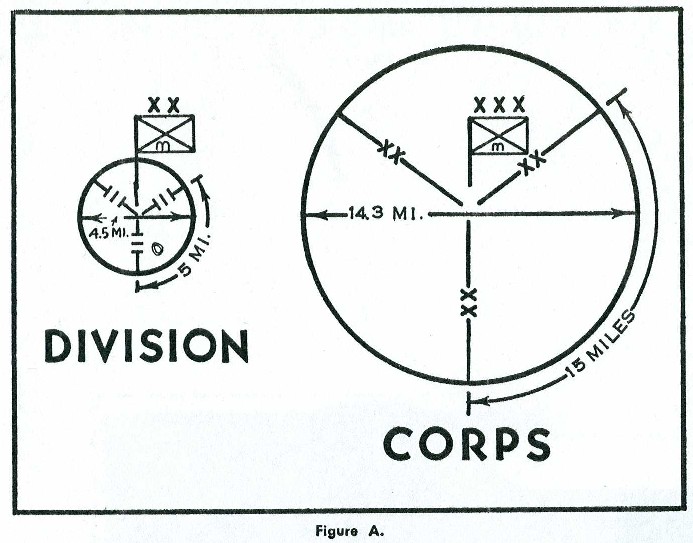
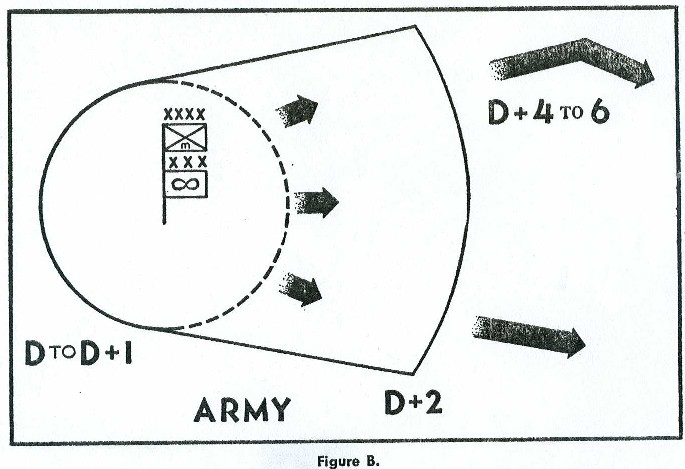
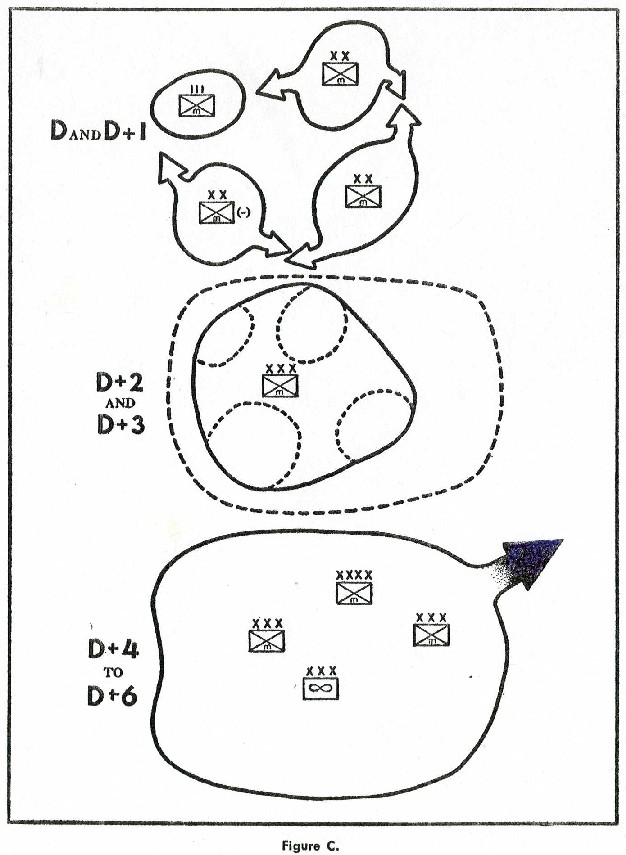
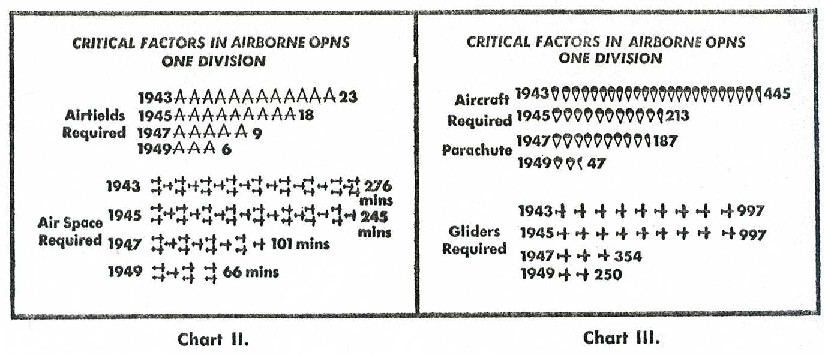
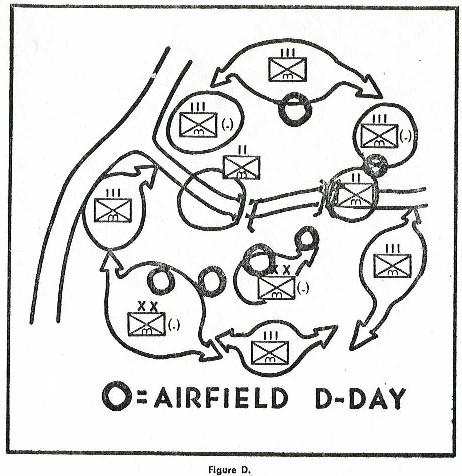
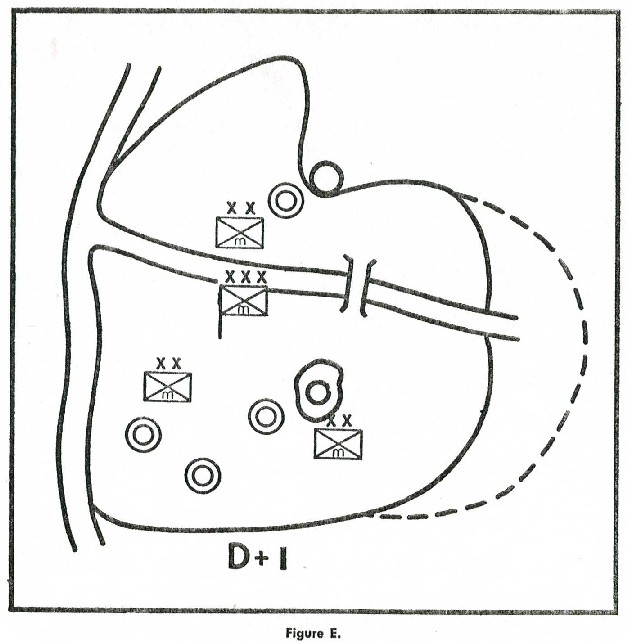
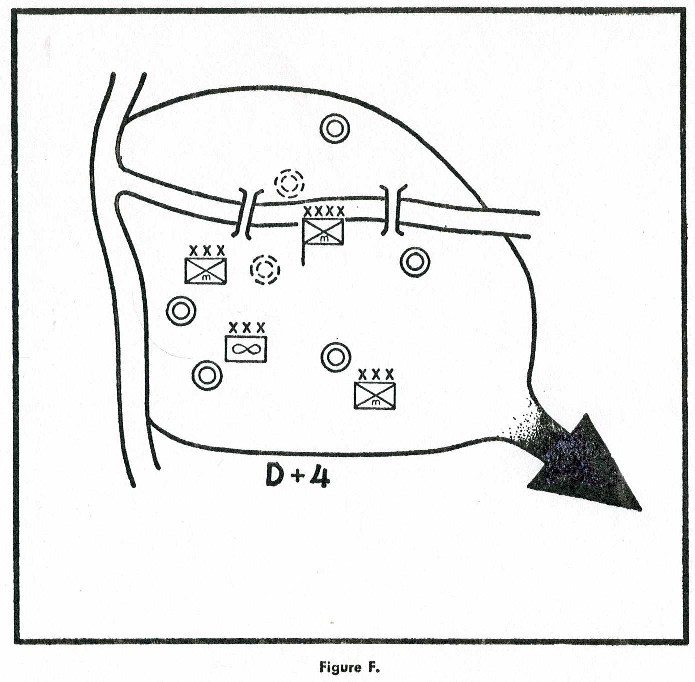
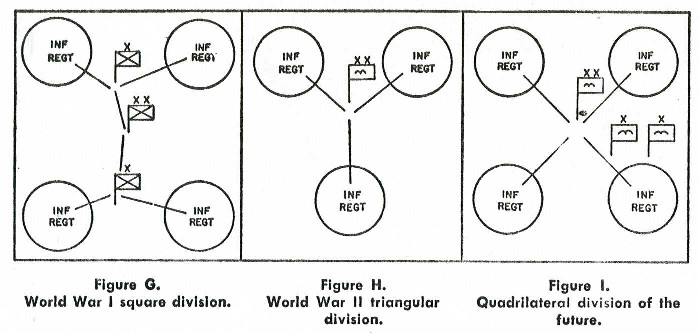
 www.youtube.com/watch?v=PtuRwMqaleQ
www.youtube.com/watch?v=PtuRwMqaleQ
It is also imperative that radios be built with greater range and lighter weight for airborne use. With the dispersion that airborne units are sure to have in the future dependable communications are of the utmost importance.
The division must be kept a fighting division. Such outfits as mobile showers, laundry units, refrigeration units, and the like do not belong with an assault division. These can be attached when needed and when combat conditions permit. Rations must be light and in concentrated form. And certainly as far as the assault divisions are concerned airborne divisions must learn to make the utmost use of all captured enemy supplies. Considerably more supplies are captured in airborne attack than in ground attack where the enemy usually has time to destroy or remove them. In this respect we are reverting to the supply methods of Genghis Khan's day and time, and this is especially true of the smaller airborne units. At the same time any large-scale airborne invasion must be supported by a well prepared supply plan and implemented by service units and equipment adequate to permit the invading army or armies to exist indefinitely by air in the heart of hostile territory.
AIRPORTS FOR SERVICE ELEMENTS
Large-scale airborne forces, if they are to succeed, must unquestionably be supported by adequate service forces. In order for a large airborne force to exist as a combat entity, it is necessary
Figure J.
Highway landing strip and taxiway.
that it capture and construct a major airport suitable for the reception of heavy air transport within a few weeks of the initial landings. Whenever possible the initial airborne attack should be made with this important item in mind, exactly as the necessity for a major seaport must be considered in preparing plans for an amphibious invasion. Once the initial landings are made, there:
should be at least one sometimes suitable for handling air transports of the troop-carrier type (five to ten tons payload) per division. Such airfields can sometimes be made by using a stretch of highway augmented by a circular taxiway built by airborne engineers (see Figure J). This is the simplest type of combat airfield. Transports land and taxi around the outside circle until the lead transport is at the approach end of the runway. Service units unload cargo to the outside of the taxiway and then the ship is dispatched. The
Page 167
Figure K.
Build-up of the service area.
taxiway can be used both ways. The field would operate under a field commander furnished by troop-carrier command.
This system of landing and dispatching has been used very successfully in training. At the present time the biggest bottleneck is the inability of the combat and service units to clear the unloading areas in time for other arriving planes. Such a field can handle at least two hundred tons per hour. In ground combat a division is assigned whenever possible at least one good road for a main supply road. In the same manner an airborne division should be assigned an airfield or an airfield site. Engineers, trained and equipped in airfield construction, should be among the first to land.
Page 168
As the airhead expands and additional service troops begin to arrive and become established, airborne combat divisions must be freed of service unit functions (fig. K). In the average situation a combat division will have its own sector of tactical responsibility bounded in front by the enemy or a suitable terrain barrier, and in the rear by the service area. The service area will be commanded by an officer designated by the commander of the entire force. Within the service area will be the airfields and airports to support the service requirements of the entire force.
The problem of handling the hundreds of tons of troops and cargo that can be delivered by air into an airhead of this type requires special study and development. Dispersion must be the rule or the loss from bombing or missiles will make the operation impossible. Dispersion can only be accomplished through having airplanes designed for rapid unloading, perhaps aircraft with droppable cargo fuselages that can move under their own power out from the landing field to dispersion areas. Special types of engineer equipment to build airfields, clear roads, and transport the cargo must accompany the early waves into the airhead. If the combat divisions accomplish their initial missions and properly organized and equipped service units are by then available to back them up, in a short time the airborne army should be well established and prepared to make a full exploitation of its pres. epee in enemy territory. Of particular historical interest are the many airheads established by the German army in their war with Russia in 1941-45. Some succeeded and some failed; where they failed it was because of lack of proper aircraft and equipment, and service forces to aid the combat division within the airheads.
In the final analysis an airborne invasion will succeed or fail depending upon the adequacy of the supply program supporting it. This is acutely true at present when so little has been done to develop airborne service units and special equipment for them. The army that solves these problems will be the army that wins. Such an army should be able to move to any area on the globe on short notice, and what is more important, fight to a winning decision when it gets there.
CHAPTER 8: The Use Of Airborne Troops In The Future
THE NATION or group of nations that control the air will control the peace. This means being able to transport airborne troops to any spot on the globe. It means being able to deliver these troops, trained and equipped, and capable of imposing their will on any potential or actual belligerent.
The development of air power and the improvement in the capabilities of aircraft establish clearly their global character.
The flight of the Truculent Turtle from Australia to Ohio and the Pacusan Dreamboat from Hawaii to Egypt in 1946 are forerunners of routine global flights in the future. Guided missiles, which should properly be considered airpower, will soon be spanning the globe. Combat designed troop-carrier aircraft must be developed and produced to fit into their niche in the airpower and aircraft picture. When this is accomplished trained troop-carrier airborne teams will be capable of striking a decisive blow from any point to any point on earth.
The use, or threatened use, of atomic weapons has had one immediate effect on our nation's strategic and tactical thinking-the realization that dispersion must govern all operations of the future. Never again may troops concentrate as they have in/the past. For example, a build-up similar to that for the Normandy assault would suffer a most disastrous scorching if caught under an atomic bombing or missile attack. In the same manner the defending force opposing such an attempt as the Normandy assault would have to remain continuously dispersed or they would be practically wiped out without a foot being set onshore.
Never again may troops and ships congest a beach as they did after landing in the invasion of Normandy. Not if they are to survive the counterattack of missiles certain to be directed against them. Troops and supply installations must be kept dispersed.
Only after close contact is established with an enemy ground force will it be permissible to concentrate, and then only in direct proportion to the weight of the enemy opposition.
Page 170
AIRBORNE TROOPS IN THE FUTURE: ALL-PURPOSE AIRBORNE UNITS
Airborne troops of the future will have to be capable of performing every type of ground operation now known. Strategical and tactical dispersion will be made possible and surprise in the attack obtained by their full and proper exploitation. Airborne troops will conduct raids, reconnaissances-in-force, and withdrawals. They will fly in vehicles designed to land on roads and in fields, and if their plan requires a withdrawal, troops will move to prearranged take-off areas after they have accomplished their ground missions and will there be picked up and flown back to.
their bases. Dummy raids will be staged and air and ground screening forces employed to deceive the defender. If, on the other hand, an airhead of some permanence is to be established, strong build-up forces will follow in the wake of the initial assault. Attacking armies will concentrate in flight from dispersed airfields. They will be preceded by a missile barrage against hostile airbases, troops, and missile bases, and they will close on their objectives in accordance with a planned schedule. Flights will be made "on the deck" to avoid hostile missiles and initial landings will be widely dispersed. Ground control will be accomplished through improved communications. Enemy pressure will be sought rather than avoided since through contact in strength partial immunity from hostile atomic attack will be possible. When the strength within an airhead permits, a vigorous offense will be undertaken to exploit the landings and make possible the accomplishment of the airborne mission. Thus the fight will be carried to the enemy in his own territory and a decision gained.
No war can be won otherwise.
At the present time, and as far as we can see into the future, the accuracy of missiles will be directly related to their range.
Their accurate range will not exceed a couple of hundred miles, beyond that their dispersion of error will increase greatly. There will be a premium therefore on denying any hostile power access to bases from which it could launch accurately guided missiles against American industries. It is likely that the launching equipment will be air-transportable, hence it is entirely possible that
Page 171
bases could be established and a missile attack launched against our vital production system before we could do much about it.
If this happened we too could employ missiles but a more certain method would be to attack and destroy the enemy's launching sites with our own airborne troops. If the bases were too powerful, then the airborne troops would be used to contain the enemy troops until greater forces could be brought to bear against them.
What was Pearl Harbor in 1941 followed in six months by an amphibious effort at Midway will, in the future, be a missile barrage followed in six minutes or six hours by an airborne attack. To even begin to cope with such a tactical situation, adequate, , trained, and properly equipped troop-carrier and airborne forces must be available.
PROTECTION AGAINST AIRBORNE ATTACK
The essentials of our national security are our industries and factories, our armed forces, and our airfields. These can be given limited protection from modern weapons through dispersion, and, in the case of the factories, earthen protection by being placed well underground. These measures however will not protect them from airborne attack or accurate missile attack. Protection from these can only be accomplished by denying an actual or potential enemy, the air base or missile sites he would want to use.
The degree of our vulnerability to such an attack can be partially gauged by considering the two most prominent land extremities of this continent-Florida and Alaska. Florida, spotted with lakes, rivers, and many airfields, offers a most promising target for airborne forces. Whether land based or sea based it would take but a small force, hardly more than a division, to sever the Peninsula at anyone of several points. Unless the Peninsula were heavily held, it could be mopped up in short time and it would provide an excellent base for missile and airborne operations against the rest of the country.
Equally interesting as an airborne study is the Territory of Alaska and the near-by industrial area of northwestern United States.
Page 172
Practically devoid of highways yet well covered with airfields and airfield sites that are almost without exception inaccessible to ground troops, Alaska offers an almost ideal tactical setting for airborne operations. In a few hours airborne troops can seize airfield areas in Alaska that could not be reached by other means for weeks. And their seizure by an enemy force would in many cases place in immediate striking range our west coast industries. The only possible certain antidote is an airborne force prepared to counterattack and isolate or destroy enemy forces that might attempt to seize such areas. Sooner or later the hostile seizing, forces would have to be destroyed but this phase might have to wait the arrival of forces by air from as far as several thousand miles away.
Through the use of airborne troops our means of defense .can be concentrated at the decisive time and place to provide us with the necessary margin of power for security.
BEST HOPE FOR THE FUTURE
We are at a critical point in the evolution of military science.
We are in a competition, a competition in which the winner will emerge from the present crisis with the best means and methods of fully using the space about our planet.
Man was an earth-bound animal not so far in the past. More than most things in his environment, he dreaded the sea. In it he would perish and beyond it were eternal flame and boiling waters. But in time he learned to sail upon it and use it. And when the first Phoenician seamen traveled beyond the Pillars of Hercules they were the greatest heroes of their time-as great and renowned truly as many of the Knights of the Wild Blue Yonder of the present age.
Soon man learned to use the sea to his advantage in war. In the year 492 B.C. the Persian King Darius launched the first large-scale amphibious invasion, an operation against the Greeks. The Punic Wars saw the Romans decisively defeat the Carthaginians at sea and thus end for all time the rise of Carthage as a great power. The Carthaginians had by far the best ground forces and their elephants were unprecedented on the battlefield in size and
Page 173
immunity to hand weapons. But by developing radically new types of combat seacraft, the triremes and quadriremes for example, and thus bringing unheard of mobility and striking power to the sea battles, the Romans completely upset the Carthaginian balance of ground power.
It was 2,200 years later when sea power reached its full potential. Then, in the battle of Normandy, the Allied powers, using hundreds of seacraft of all types, invaded the Continent of Europe. The sea was used to the fullest. It is significant, however, that part of the invading forces were transported by air. It was significant because that battle saw sea power at its peak. Air power was just beginning. And this is the critical point we have now arrived at, and this is the competition we are in. This media that envelops us we must use. We must imagine, design and develop the means and methods of using it. We must-if our people and our institutions are to survive. For the people with their institutions who best learn how to use this media will survive in this highly competitive world.
Air power is now the decisive element in modern war. And by air power is meant every contribution to waging war that man has created and that can be flown. Men, weapons, ammunition, food, bombs, missiles, and all that it will take to fight a future war must fly. Clearly, therefore, in the development of our air - power and airborne potential changes must be made in our ground force equipment as well as in our air force equipment.
For example, there is in existence at the present time a bazooka that will penetrate seven inches of armor. This means that under favorable conditions an individual trooper with a hand weapon can knock out a Tiger, Stalin, or Sherman tank. It is unsound to reason that now we must build an airplane that will fly a tank with still greater thickness of armor. It takes a very costly converted B-36 (XC-99) to fly a 50-ton tank with six to seven inches of armor at the present time. Ground fighting equipment must be modified.
The conventional type steel and cast-iron earth-bound tank cannot in its present form win the battle with air-transported shaped charge weapons. In its present form it is as extinct as the ele-
Page 175
phants of Zama and the heavily armed knights of Agincourt. The entire airborne-armored problem must be reviewed in the light of the capabilities of modern shaped-charge and rocket weapons.
The same is true of our communications equipment, tracks, reconnaissance vehicles, artillery, food, and, in fact, everything that must be flown.
Organizations created to fight the last war better are not going, to win the next. Nor is building an airplane around the ground weapons that won the last war an assurance that we will win the next. Keeping foremost in our minds the functional purposes of our means of ground combat, these means must be developed and produced so that they can be delivered to the battlefield in sufficient quantity to gain the decision. Not only must our airplanes, chutes, gliders and kiwis be developed but our ground-fighting weapons and equipment as well. Only thus will we attain a position of dominance in airborne warfare.
The nation that in the future has the-best trained and equipped airborne forces has the best chance of survival. Indeed, more than this, only by having such security forces can any nation survive. For as long as these means of waging modern war are available to us they are available to aggressor nations. And modern airborne forces of aggressor nations cannot be fought successfully with the weapons that fought past wars. Not if they are to be engaged at parity, and beaten.
Airborne troops are our best national security and the world's most promising hope for international security.
The knowledge of the existence of a well trained airborne army, capable of moving anywhere on the globe on short notice, available to an international security body such as the United Nations, is our best guarantee of lasting peace. And the nation or nations that control the air will control the peace.
INDEX
Aa River, 91-122
Acate River, 11
Agropoli, 29-36
Aircraft, design, 76
Airlields, needed, 151, 166
Albanella Ridge, 28-36
Albert Canal, 71-122
Alexander, Major Mark, 15
Alinda Bay, 34
All-purpose units, 171
Altavilla, 28-36
Amalli, 20-36
Amfreville, 53-67
Anti-airborne devices, 46, 65, 161-170, 172
Antiaircraft lire, 77-78
Anzio, 33-36
Apeldoorn, 72-122
Appetici, Mount, 33
Armies, future, 140-160
Arnhem, 72-122
Arnold, Gen. H. H., 150
Artillery, 66, 103, 145
Atomic power, 140, 170
Attack, future, 153-160
Attack, protection against, 172
Avellino, 23-36
Badoglio, Marshal Pietro, 27
Battipaglia, 23-36
Bayeux, 41-67
Beek, 107-122
Bell, Lawrence D., 150
Berg Leopold, 92-122
Bergendahl, 75-122
Best, 94-122
Biazzo Ridge, 10-17
Biscari, 10-17
Bols, Maj. Gen. E., 131
Bombing, 23-24
Bradley, Gen. Omar N., 42
Brereton, Lt. Gen. Lewis, 68-122, 131-137
Brestebeurje, Captain, 100-101, 109
Brieling. See Planning
Browning, Lt. Gen. F. A- M., 38, 72-122
Caen, 41-67
Calore River, 28-36
Capua, 23-36
Carboni, General, 27
Carentan, 42-67
Catania, 16-17
Centocelle, 27-36
Cerveteri, 27- 36
Chef du Pont, 53.67
Cherbourg, 42-67
Clark, Lieutenant, 14
Clark, Gen. Mark W., 24
Comiso, 15-17
Cooperation, air, 84
Coordination, 19, 44-67
Corregidor, 123-131
COSSAC, 38
Coutts, Col. James W., 135
Darius, 173
Deception, 37
Defense, 65-67. See also Anti-airborne devices
Dempsey, Lt. Gen. Sir Miles, 132
DeSeversky, Alexander, 141
Dispersion, 170
Division, types, 163-165
Dodecanese, 33
Dommel River, 92-122
Douhet, General, 141
Douve River, 43-67
Drop zones, 81-82. See also Landing zones
Dropping, 3-4, 25, 30, 35, 144
Eindhoven, 68-122
Eisenhower, Gen. Dwight D., 55
Ekman, Col. William E., 104
Equipment, defensive, 163
Escaut Canal, 71.122
Etienneville, 53-67
Falley, Lt. General, 65
Farello, 15
Ferrell, Lt. Willis J., 13
Frost, Lt. Colonel, 113-120
Furbara, 27-36
Future airborne troops, 170-175
Future combat, 67.68, 140-160
Gale, Major General, 63
Gela, 1.0-17
Glider capacity. See Loads and loading Glider design, 145-147
Gorham, Lt. Col. Arthur, 7, 8-13, 14
Goering, Marshal Hermann, 50
Grave, 72-122
Groesbeek, 75-122
Ground troops, 141
Guidonia, 27-36
Gurna Bay, 34
Harrison, Lt. Col. William, 102
Hartestein, 119-122
Hater, 104-122
Hawksworth, General, 23.36
Heelsum, 111.122
Heikant, 104-122
Heveadorp, 119-122
Hicks, Brigadier, 117
Hitler, Adolf, 50
Holland, 68-122
Honinghutie, 104-122
Identification, 79
Intelligence, 63-64, 68. See also Reconnaissance; Anti-airborne devices
Issei River, 133
Itagaki, Capt. Ijn, 129
Italy, 18-36
Japan, 137-140
Jones, Col. George W., 124
Kellam, Major F. C. A., 59.61
Kranenburg, 104-122
Krause, Lt. Col. Edward, 60
Krueger, Lt. Gen. Walter, 124
La Fiere, 59.67
La Haye-du-Puits, 62-67
Lackey, Lt. Col. John S., 125
Landing zones, 81-82. See also Drop zones
Lathbury, Brig. G. W., 113
Lee, Maj. Gen. William c., 38
Leros, 33 Lessay, 42-67
Lessons, 18, 35
Leyte, 130
Liaison. See Cooperation; Coordination lifts. See Troop carriers; Loads and loading
Lindquist, Col. Roy E., 59-67, 104
Lingayen Gulf, 124
Littorio, 27-36
Loads and loading, 4, 18, 38,45,73,92,98, 112-113, 133-134, 145.151
Losses, 15
Maas River, 75-122
Maiori, 20-36
Malinta Hill, 128-131
Malta, 9
Marecageuses Prairie, 43-67
McGinity, Major James, 14, 61
Mediterranean campaign, 18-36
Merderet River, 43-67
Miksche, Major F. 0., 42
Miley, Maj. Gen. William M., 131.137
Mindoro, 125
Missile attack, 171
Molenhook, 102-122
Montgomery, Field Marshal Sir Bernard, 44-67, 131
Mook, 88-122
Nasugbu, 124
Naval support, 11-17
Neuville-au-Plain, 53-67
Nijmegen, 72-122
Niscemi, 7-17
Nocera, 19-36
Normandy, 37-67
Nota, 14-17
Operation Avalanche, 19
Operation Giant I, 21-36
Operation Giant II, 24-36
Operation Market-Garden, 68-122
Operation Neptune, 37-67
Operation Overlord, 37-67
Operation Shingle, 33-36
Operation Varsity, 131-137
Operations, factors in, 151
Organization, defensive, 163
Orne River, 37-67
Page 176
Pacusan Dreamboat, 170
Prestum, 29-36
Parachute, design and use, 142-145
Paratroops (Miksche), 42
Parks, Maj. Gen. Floyd L., 131
Pathlinders, 27, 29, 54
Photographic coverage. See Reconnaissance
Planning, If, 18-28, 38-56, 68-91, 124-127, 132-133. See a/so Preparation
Ponto Olivio, 1-17
Preparation, 85-90. See also Planning
Ragusa, 15-17
Ranges, 148
Reconnaissance, 5, 41, 46, 75, 80-81, 125
Reeling, 143
Reichswald, 87-122
Reinforcements, 30-31
Reserves, 122
Resupply. See Supply Rhine crossing, 131-137
Ridgway, Lt. Gen. Matthew B., 8, 13, 18-36, 38, 60, 64, 85-122, 131-137
Roccadaspide, 28-3.6
Rome, 24-36
Rommel, Field Marshal Erwin, 50
Rommelspargel, 47
Routes, 79-81
Saint Oedenrode, 72,122
Saint Sauveur-le.Vicomte, 43-67
Sainte Mere Eglise, 53-67
Salerno, 18-36
Santa Croce Camerina, 14-17
Sarno, 19-36
Sayre, Capt. Edwin M., 6-8
Sele River, 28-36
Service troop airports, 166
Sicily, 1-17
Sorrento Peninsula, 20-36
Southern Italy. See Mediterranean
Student, Col. Gen. Karl, 16, 49
Supply, 21-36, 70, 82-84, 108
Swing, Maj. Gen. Joseph M., 130
Tactical requirements, 157
Tanks, 8-11
Taylor, Maj. Gen. Maxwell D., 27, 62-67, 72-122
Tedder, Air Marshal Sir Arthur, 24
Tench, Col. C. T., 138
Thompson, Lt. John, 99
Training 65-67
Transport capacity. See Loads and loading
Transports, 147-151
Trapani, 16-17 Trillisco, 21-36
Troop carriers, 75-77, 148. See also Loads and loading
Truculent Turtle, 170
Tucker, Colonel Reuben, 98
Uden, 72-122
Units, all-purpose, 171
Units mentioned:
1 Air Landing Brigade (Br), 68-122 1 Airborne Division (Br), 68-122 First Allied Airborne Army, 68-122, 131-137 First Army (U.S.), 70 1 Infantry Division (U.S.), I, 81 Parachute Brigade (Pol), 68-122 1 Parachute Division (Ger), 16-17, 2336 Second Army (Br), 70, 131.137 II Corps (U.S.), 1-17 Third Army (U.S.), 70 4th Infantry Division (U.S.), 63 Fifth Army (U.S.), 19-36 V Corps (U.S.), 44-67 Sixth Army (U.S.), 124 VI Corps (U.S.), 28-36 6th Airborne Division (Br), 37-67, 131137 6th Parachute Division (Ger), 108-122 6th Parachute Regiment (Ger), 63 VII Corps (U.S.), 44.67 7th Parachute Division (Ger), 132-137 Eighth Air Force (U.S.), 83, 84-122 VIII Corps (U.S.), 72-122 Ninth Air Force (U.S.), 84-122 Ninth Army (U.S.), 133 IX Troop-Carried Command (U.S.), 54-67, 78-122, 131-137 X Corps (Br), 28-36 11th Airborne Division (U.S.), 124-131,138 XII Corps (U.S.), 72-122 15th Army Group, 24-36 16th Infantry (U.S.), 8 17th Airborne Division (U.S.), 131-137 XVIII Airborne Corps (U.S.), 72-122, 131-137 21 Army Group, 37-67, 131 21th Panzer Division (Ger), 41 XXX Corps (Br), 72-122 45th Infantry Division (U.S.), I, 10-17 46th Division (Br), 21-36 52st Troop-Carrier Wing (U.S.), 17 64th Troop-Carrier Group (U.S.), 32 82nd Airborne Division (U.S.), 1-17, 18-36, 45-67, 73-122 84th Infantry Division (Ger), 132-137, 91st Infantry Division (Ger), 51, 65 101st Airborne Division (U.S.), 37-67, 73-122 179 Infantry (U.S.), 10-17, 180 Infantry (U.S.), 11-17
Page 178
188th Glider Infantry (U.S.), 139-189 Field Artillery (U.S.), 11, 243rd Infantry Division (Ger), 51, 307th Airborne Engineer Bn. (U.S.), 11, 29 316th Troop-Carrier Group (U.S.), 8 317th Troop-Carrier Group (U.S.), 125 376th Parachute Field Artillery (U.S.), 103 456rd Parachute Field Artillery (U.S.), 15 501th Parachute Infantry (U.S.), 94-122 502rd Parachute Infantry (U.S.), 94-122 503rd Parachute Infantry (U.S.), 124-131 504th Parachute Infantry (U.S.), 13-17, 2736, 39, 98-122 505th Parachute Infantry (U.S.), 1-17, 53-67, 104-122 506th Parachute Infantry (U.S.), 94-122 507rd Parachute Infantry (U.S.), 134-137 508th Parachute Infantry (U.S.), 46-67, 102-122 509th Parachute Infantry (U.S.), 23-36 513th Parachute Infantry (U.S.), 135-137 920th Infantry (Ger), 64 992th Infantry (Ger), 64 1058th Infantry (Ger), 61 British Airborne Corps, 68-122 Grenadier Guards Battalion, 110 Guards Armored Division, 94-122 Hermann Goring Panzer Division, 6-17, 23-36 Irish Guards Battalion, 110
Urquhart, Maj. Gen. R. E., 110-122
Vandervort, Lt. Colonel Benjamin, 60, 109
Vandevegt, Lieutenant, 14
Vedetta, Mount, 33
Veghel, 72-122
Vire River, 37-67
Vito, Cape, 16-17
Vittoria, 10
Volturno River, 21
Waal River, 75-122
Warren, Lt. Colonel Shields, 105-106
Watts, Lt. George J., 13
Wavre, 133
Wesel, 132-137
Wilhelmina Canal, 92-122
Willems Vaart Canal, 92-122
Williams, Major General Paul, 131
Wilson, Major B. A., 113
Wyler, 98-122
Yamashita, General Tomoyuki, 129
Zon, 92-122
Zuider Zee, 71, 122
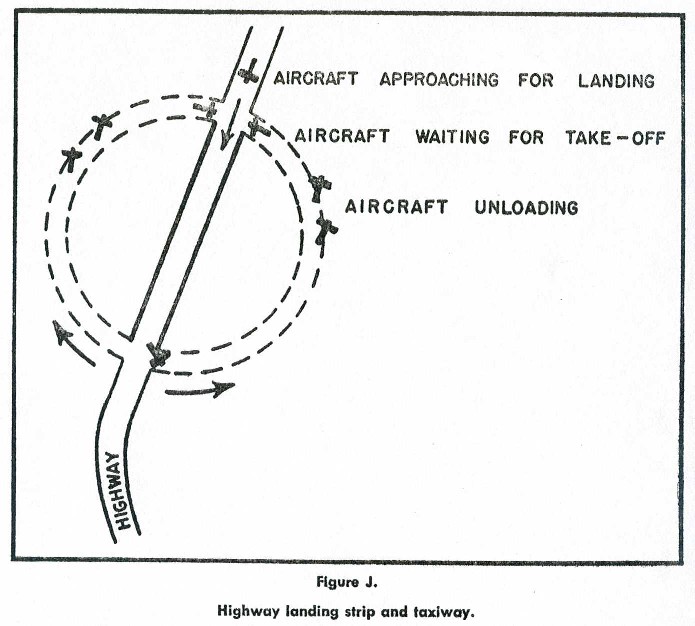
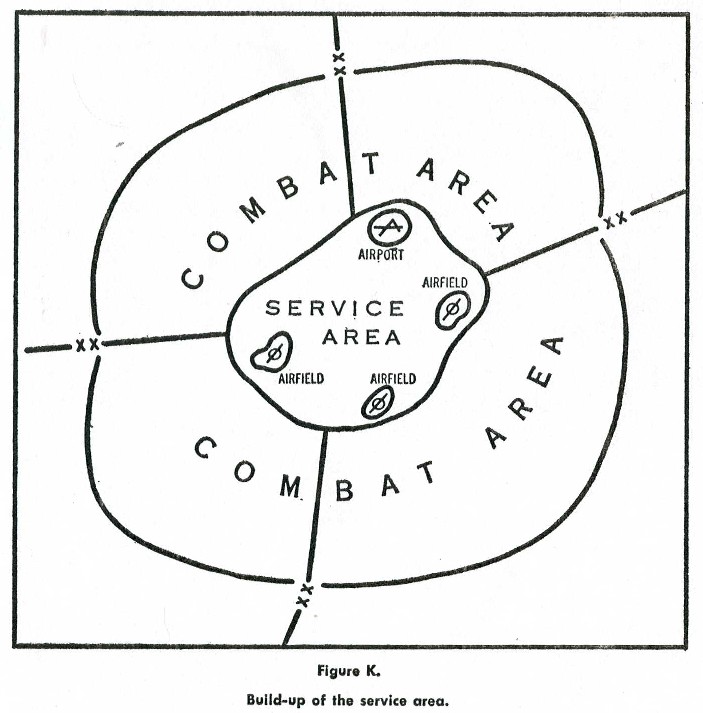
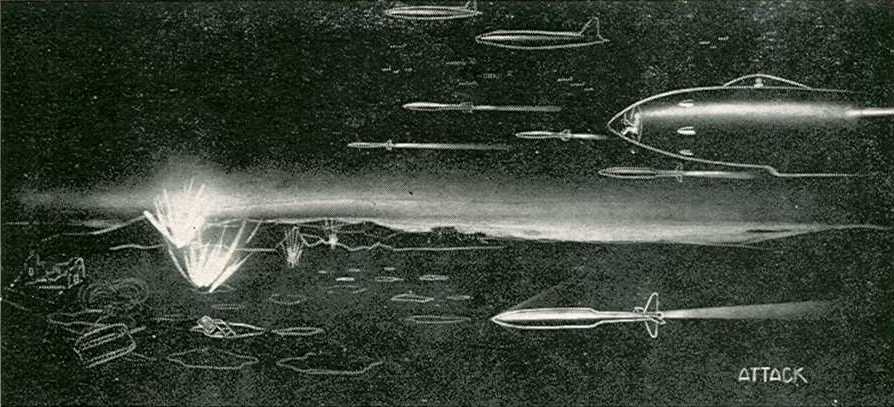
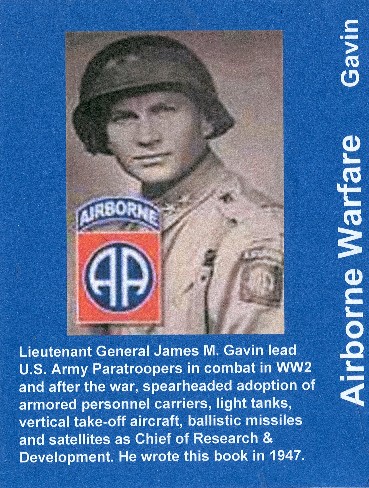
OBSERVATIONS
Maximalist Solution "Raise the Bridge"
Gavin here in Airborne Warfare [also on mirror web page at www.combatreform.org/airbornewarfare.htm] realizes that using converted civilian airliners damns the Army airborne 3D maneuver force to a bad set of parameters; they are unarmored and unarmed and can't take much enemy damage, intact units of paratroopers cannot be dropped together, supplies by parachute are scattered requiring 1/3 of the combat force to try to retrieve them, and tracked tanks for mobility and firepower on the ground cannot be delivered. He notes that trying to work around militarized civilian airliners by towing gliders results in even more of the airborne force not getting delivered by tow ropes breaking. At Sicily, he lost an entire battalion of men to friendly fire, at Arnhem the mission failed because the glider-centric British chose landing zones distant from the bridge over the Rhine river to avoid anti-aircraft fire but did not exploit the tracked AFV and jeep-carrying potential of their Horsa and Hamilcar gliders to compensate for this separation to punch through to the objective.
What Gavin does notice is that gliders piloted by human pilots deliver supplies with greater precision than multiple bundles by parachutes and they are all together IN THE GLIDER on the ground. This realization would later be used to resupply the 101st Airborne enabling it to hold Bastogne and defeat the German "Battle of the Bulge" counter-offensive.
Figuring this all out, Gavin proposes that America field armored, armed transport aircraft with tracked landing gear that can land on any cow pasture and drop off "Kiwi" pods with assault troops, AFVs, supplies and even act as fortifiable mobile buildings to form "airheads" aka Forward Operating Bases to GET IT, DRIVE ON (GIDO). The Kiwi pod by being ATTACHED DIRECTLY to the transport aircraft doesn't have a tow rope complexity of a glider and the pod itself can be dropped exactly where we want it with everything we want inside and intact with its own ground propulsion means to get out of the way of incoming aircraft and get to the supply area so the aircraft can continue on back to its rearward base for a reload. No time is wasted off-loading airlanded planes as Gavin discovered planning for the Rome coup de main operation, which takes more time than parachute dropping without having to come in and land on a runway. Kiwi assault pods with fold-out wings detach and become the stealthy assault gliders Gavin noted were so successful at Eban Emael and the Orne river enabling the motor driven transport plane to remain out of sight, sound and radar range of the enemy so they are not alerted. Kiwi pods could contain folded-wing, close air support planes (Fighter-In-A-Box) to fly from the airhead to suppress enemy mortar, tube and rocket artillery from striking them as the British unit diaries from Arnhem show whenever Typhoon fighter-bombers flown from distant England or France arrived overhead escorting supply drop transports, the German gunners stopped out of fear for their lives. The FINAB "maneuver air support" plane could also be attached directly to the transport plane and launched in mid-air using the "Airborne Aircraft Carrier" parasite fighter concept.
Reading the war diaries of the British light troops surrounded near Arnhem below:
www.pegasusarchive.org/arnhem/war.htm
Its increasingly clear that 3D maneuver troops must have a "hard shell" in the form of their own light tracked armored fighting vehicles (LTAFVs) so enemy high explosive pounding of them will not attrit them to where they cannot hold a position. These light tracked AFVs should also have back hoes attachments so overhead cover fighting positions and hull-down vehicle positions can be created to bolster the baseline vehicle armor. LTAFV armored mobility also insures airdropped supplies---however they are scattered---can be recovered so even though the 3D force is in a non-linear situation with enemy all around, their fighting strength can be perpetuated indefinitely til the heavier 2D forces link up or they themselves implode the enemy resistance by their own maneuver actions.
The other handicap light troops have against heavier enemy troops is that they don't have the supplies to artillery duel with them to keep them from laying down mortar, rocket and artillery pressures upon them since the latter has home field advantage of greater supplies in hand. The air-mechanized light force needs to never be outgunned like the weak, helicopter-centric firebases were in Vietnam and LTAFVs enable this because they can self-propel in a ready-to-fire manner tube and rocket/missile artillery that can through clever design keep the enemy's artillery shut down. Also notice how CAS fighter-bombers when overhead silence enemy guns---the AMS force should have its own "hip-pocket" air force of fighter-in-a-box (FINAB) aircraft in ISO container BATTLEBOXes delivered by KIWI pod aircraft right there on the scene operating from their airhead to do CAS as well as interdict enemy fighter-bombers and pesky UAVs from surveilling overhead to help target for the enemy.
Gavin realizes paratroops will still be needed to jump to take the airhead, but understands the Kiwi pod system would enable THE ENTIRE U.S. ARMY to be containerized and ready-to-fight ie; become an AIRBORNE ARMY.
All of these great capabilities are possible IF you pay for it up front by obtaining the Kiwi pod-carrying transport planes.
However, the problem is the year Gavin wrote his book, 1947---the Air Force broke away from the U.S. Army and became is own service devoted to trying winning wars all by themselves with FIREPOWER through sexier bombers and fighter-bombers----not maneuver. The U.S. Air Force does not want to 1.) land anywhere in the dirt, 2.) drop anyone where they can get shot down and most importantly to them, 3.) waste any more money than they have to flying the budgetary rival Army to where they can possibly get the glory. They will fly transports with minimal capabilities to prevent the Army from having maximimalist capabilities by perpetuating their claim to be the air force for all the armed services but the majority of their monies and plans are for them to win the war by themselves trying to make Douhet work with fighters and bombers that are ego-gratifying.
So even though Gavin was right and is still right, the USAF is not likely to "raise the bridge" for 3D maneuver operations unless someone forces them to make say a kiwi-pod equipped version of the C-17 or replacement for their worn-out C-5s.
Minimalist Solution "Lower the River"
Though an idealist, Gavin has his mind tempered by the realism of having to use what you got, as we say, "F It, Drive On" (FIDO). If we can't get Kiwi pod transports, then the planes we use at least better have a large opening in the rear so large loads can be off-loaded on the ground or from the air by better parachutes--something which the Army does have control over. During WW2, nose-opening gliders sometimes rolled to a stop against trees and fences and couldn't open their noses to off-load jeeps and towed guns. We did get this capability from the USAF first with the CG-20 high tail, rear ramp glider that became the C-123 Provider powered transport then with the legendary C-130 Hercules turboprop plane.
This is where we, in the Air-Mech-Strike Study Group in the 1990s picked up the 3D maneuver torch from General Gavin through the vision of General David Grange. Not getting our hopes up for a new USAF pod-equipped plane anytime soon, we went to work figuring out how to have "combat kiwi pods" come out the rear ramp of existing USAF C-130/C-17 transport planes and Army CH-47 helicopters--small, light tracked AFVs. The air-transportable, light tracked AFVs we need we already have---General Gavin's M113s are in the inventory by the thousands to include enough in storage to transform all the Army light infantry's HHC AT, mortar sections and the Airborne/Air Assault's Delta Weapons companies within weeks with an immediate capability and within 2 years to high technology turbine-electric drive, stealthy and 60+ mph band tracks and RPG/land mine resistant armors qualitatively as good as what's possible in a heavy 2D maneuver force Bradley medium-weight TAFV. The M113 can be reduced to roll-on/off from Army CH-47 Chinook helicopters for VTOL and Army C-27J STOL aircraft for in-house, short-range, tactical 3D maneuver operations against fleeting, high-value targets without having to get bureaucratic permission from the USAF to supply larger transports. This minimalist solution maximizes what our new technology turboprop and turbofan aircraft can carry over piston-engined WW2 transports, and gives paratroopers up to 30 days of supplies on board their tracked, armored ground "mother ship" as first pointed out by armor futurist, Stan Crist. The break bulk of supplies afterwards coming from inside USAF transports can be avoided by having our tracked AFVs equipped with material handling equipment to pick up these supplies which are configured with forklift tine slots like SeaBox's ECDS pallet. The light tracked AFV can roam around the drop zone with low ground-pressure cross-country mobility and armor protection so a 1/3 of the combat force can be focused on combat. To get around the USAF's desire to not get shot down when we need their larger C-130/C-17 transports for range and force size requirements, our paratrooper's parachutes can be fitted with a drogue chute to open first, then the main chute on a timer as Gavin suggested, so we can jump at high altitudes above enemy air defenses but without the scattering that befell the 509th PIR whose parachutes opened immediately after exiting their C-47s over Avellino in 1943. High altitude, low opening of supplies was decisive in 1972 saving the surrounded ARVN at An Loc and can be applied to paratroops and their TAFV/pods as well. The stealthy glider stand-off capability can be regained by large ram-air parachutes opening after the cargo rolls of the rear ramp of a transport aircraft. The 8-to-1 glide ratio is not as good as the potentially 100-to-1 glide ratio of solid wings that a glider launched from a mother aircraft could have, but its 25-50 mile range is worthwhile. Having paratroopers follow their TAFV under their own ram-air parachutes is a possibility but current types only have a 3-to-1 glide ratio. Having paratroopers inside the TAFV/pod is possible as the Russian Airborne does with their BMD light tracked AFVs, but it is dangerous, if parachute fails to open its likely everyone inside will not be able to bail-out from a tumbling conglomeration.
We can even work within the USAF's fuselages that don't detach and get Gavin's Kiwi pods by using the ISO shipping containers the entire civilian world lives by. A little heavy because they are designed to be strong enough to stack on container ships, an aluminum version "BATTLEBOX" only weighs 3, 000 pounds empty compared to the steel version's 4, 500 pounds and 8 x 20 foot long versions can fit inside a C-17, and two in a C-130 if the SeaBox detachable corner posts are used. Once delivered for the Army, these "BATTLEBOXes" can be camouflaged and dug-in to be hardened troop living areas for very well-organized FOBs. Small observation/attack FINAB planes which use the same JP-8 fuel as ground vehicles use can be fielded within the ISO container inter-modal system to render "hip-pocket air force" MAS capabilities.
At the end of Airborne Warfare, Gavin draws out the sizing of future airheads in anticipation for future nation-state wars, showing a desirable corps-size perimeter with several long runway FOBs within a 150 miles radius to be dispersed enough to withstand even small nuclear weapon attacks. Today, PGMs can hit with enough precision to mimic a nuclear effect for those on the receiving end. However, our all volunteer (victim) force of ego and paycheck gatherers is lacking in numbers to guard such a large perimeter. What we cannot support with quantity we need to compensate with higher quality by the hardened BATTLEBOX system that is able to avoid/withstand enemy high explosive attacks that has its own mini-Army Air Force on hand to keep enemy aircraft, saboteurs and artillery away. If our aircraft are VTOL or STOL requiring open areas of just 2, 000 feet or less, the perimeter defense math of Pi x Radius Squared works in our favor for a circle 6 times runway length or 2 miles compared to the bloated USAF air base built around a 10, 000 foot runway for large aircraft that needs 12 miles of barrier materials and TAFV mobile security forces. Smaller FOBs, means more ground combat troops with TAFV superiority can fight and a less obnoxious presence to antagonize the local civil populace that we are occupying their country.
By taking General Gavin's innovations for non-linear 3D maneuver warfare to heart and applying them by either maximalist or minimalist efficiency means, we can create decisive forces that will save our taxpayer's billions of dollars while smothering conflicts so those who are consumed by violence can turn to peaceful means to settle their differences.
General Gavin as the U.S. Army's Head of Research and Development employed young talent like then Captain Hal Moore to come up with improved parachutes and later tracked armored fighting vehicles. This was the first "heavy drop" of a platform-loaded artillery howitzer using a delayed opening, two-state cargo parachute system, which we take for granted today. Here the extraction chute pulls the load out the back of the C-82.

no captions

no captions

no captions

no captions
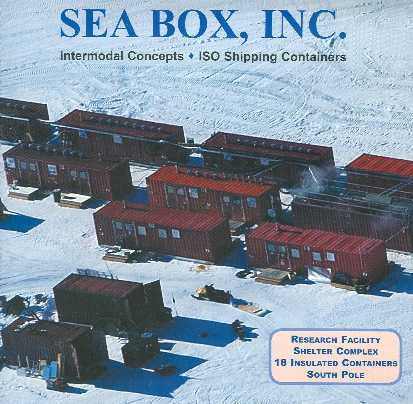
Gavin also realizes such modular shelters mean the entire base can be moved in an instant to a new location as required, so no time or money is wasted on inferior static buildings you cannot take with you on peaceful expeditions or expeditionary warfare.

no captions
More proof that the current USMC is living off the legacy of the past lusting to re-enact WW2 beach assaults. We do not get a clear signal from the NAVSPECWAR community whether its safe to drop SEALs in a rubber boat 5-10 feet above the water from the rear ramp of a C-130 using LAPES. Richard Gabriel in his book, Military Incompetence says it was tried in the 1983 Grenada invasion but with disastrous results. If the carrier aircraft is a seaplane, it simply lands on the water, comes to a slow taxi or halt, then detaches the floating KIWI pod. The Geiger Board of 1946 said to avoid nuclear targeting of the vulnerable and obvious surface fleet, marines should come ashore by seaplanes. An actual "Flying LST" was fielded, the R3Y Tradewind but the WW2 re-enactment bureaucracy with billion dollar amphibious ships for Navy officers to play Captain Kirk killed the whole seaplane option when they found a flimsy technical excuse to kill programs. In the case of the R3Y it was problems with their engines that gave them their excuse and voila! a U.S. Navy without ANY aircraft capable of landing in the water. That we could have amphibious KIWI pods that would be the only part of the carrier plane to touch the water, then take-off is a level of sophistication several steps ahead of the current marine and naval mind.
Notice as far back as 1947, General Gavin has TRACKED tanks coming out of his KIWI pods to render fire support for his beloved Paratroopers who realize OPEN TERRAIN when they see it = DROP ZONE for them. Another of the tracked tanks is shooting a barrage of rockets to saturate bombard the enemy, yet another capability absent in today's Navy/Mc team. The tragedy is that 60 years later AMERICA'S PARATROOPERS STILL DO NOT HAVE ANY TRACKED LIGHT TANKS AND PERSONNEL CARRIERS while the rest of the world's Airbornes do...to include impending foe, Red China's Paratroopers.
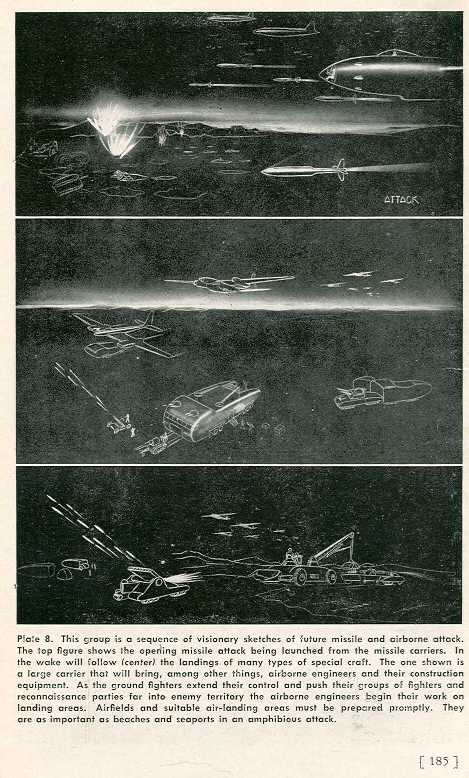
no captions

"Precision Guided Munitions" circa 1947. Clearly, when you read general Gavin's book he knows its not just nuclear weapons that demand we decentralize our maneuver units, but also precision guided high explosives, too. This is why for the Pentomic Army he had our Soldiers in air-transportable, armored M113s on tracks so they could fan out on the non-linear battlefield (NLB) and keep moving even if there was no roads/trails via cross country and amphibious mobility.
The official history of the U.S. Army for that time period says the following:
www.army.mil/cmh-pg/books/amh/AMH-26.htm
The seven divisions stationed in the United States constituted the strategic reserve. Four of these-two airborne and two infantry-were designated in 1957 the Strategic Army Corps (STRAC) and were maintained in a high state of readiness for quick deployment in event of an emergency. The other three were earmarked as STRAC reinforcements and as a training base for expansion of Army forces should the crisis become prolonged or develop into a full-scale war.With the emphasis on mobility, even the larger and heavier weapons and equipment were designed to be air-transportable.
A program to produce ground and air vehicles with the necessary battlefield mobility led to the development of armored personnel carriers, such as the M113 with aluminum armor, that could move troops rapidly to the scene of operations while providing greater protection for the individual Soldier. Since
585
highways and bridges might be damaged or destroyed, dual-capability amphibious vehicles that could travel on rough terrain and swim across rivers and swamps freed the fighting units from total dependence upon roads.
What today's planners don't realize is that what was required for a nuclear battlefield is required today with PGMs in a Surveillance Strike System (SSC) that can be as equally devastating but in a more localized way: units ON TRACKS not wheels. We need GREATER PHYSICAL mobility, firepower, protection and livability features not less regardless if tied in to a "Mother May, I?" computer network to alleviate the anxieties of senior officials.

THE AMAZING DETAILS OF GENERAL GAVIN'S VISION
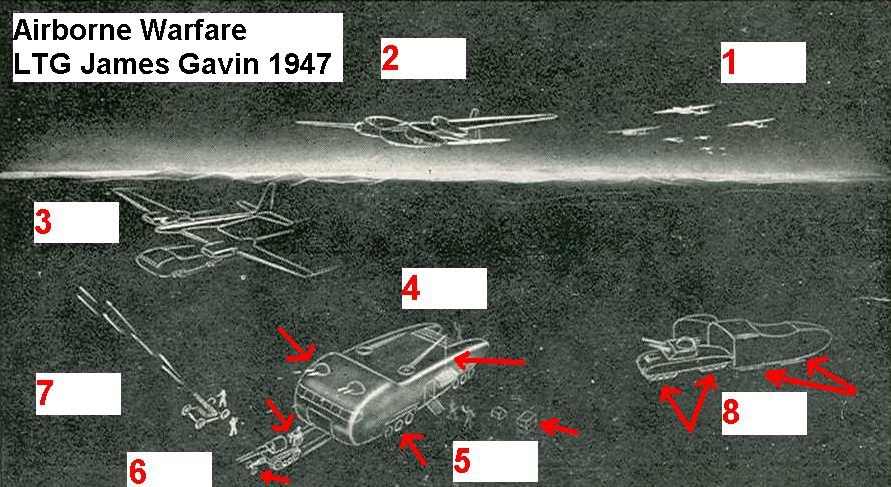
1. General Gavin's goal is to get THE ENTIRE Army "Airborne" and capable of 3D maneuver by aircraft delivery. Today's C-5s and C-17s make this a reality, we just have to CONTAINERIZE everything the Army owns so we do not waste precious time break bulk loading & unloading the USAF's current internal cargo volume T-Tail airlifters and the Army's internal volume CH-47 heavy lift helicopters.
2. Note that the ideal KIWI pod carrier is still a specially-designed aircraft that the pod snaps into for maximum efficiency since the aircraft doesn't carry the dead weight of a large internal volume cargo fuselage. The aircraft depicted here is like the XC-120: a CH-54 SkyCrane but with fixed instead of rotary wings.
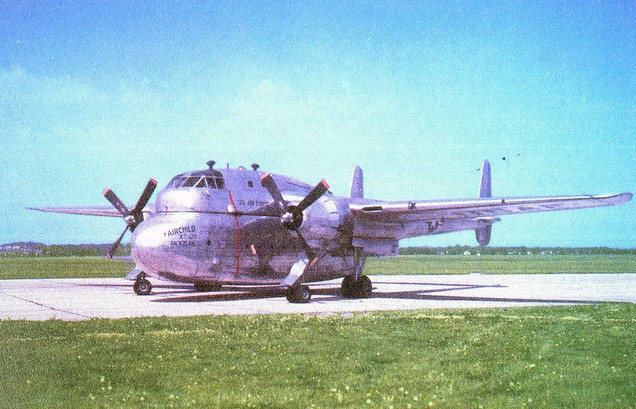
 www.youtube.com/watch?v=9gspWjduh3Q
www.youtube.com/watch?v=9gspWjduh3Q
3. Once a KIWI pod system is fielded all kinds of options become possible from the very aggressive to the very safe. The most aggressive is FREE DROPPING the pod a few feet above the ground or water; if the carrier aircraft is a Burnelli ESTOL design the slightly above stall speed would be just 60 mph so a LAPES without a parachute or perhaps with a tail parachute on the KIWI pod may not be so severe an impact that the pod gets damaged. People inside are another matter. If its a land carrier plane, with tracked or air cushion landing gear ON THE KIWI pod itself, the plane could detach the pod once firm contact with the ground is made and pull up to return to flight back to base. The conservative option would be to land then could come to a taxi or stop and then detach the pod.
The KIWI pod has tracks to propel itself over the ground after detaching from its carrier aircraft.
4. The KIWI pod. First notice the two cargo cranes in back to load/offload supplies on pallets. There's a side door for Paratroopers to enter/leave the KIWI pod.
5. There are two sets of tracks which is incredible that General Gavin proposes this since it enables a vehicle to run over a land mine and still have 3 sets of tracks intact to keep going. On top of the KIWI pods are two machine gun or autocannon turrets to defend itself from enemy attacks or to attack the enemy, whichever happens first.
6. LOOK WHAT'S COMING OUT OF THE KIWI POD!!
Why its a LIGHT TRACKED ARMORED FIGHTING VEHICLE...sort of like a M113! Notice on its front are two mine roller wheels to sacrifice themselves if a land mine is run over to keep the main vehicle's tracks intact to stay mobile. And right behind it is either a Paratrooper on a motorcycle and/or pedal bike!
7. Here is retired LTC Chuck Jarnot's "T-MARS" minimalist 227mm rocket launcher described in our Air-Mech-Strike book to offer a barrage of rockets to saturate the Paratrooper's enemies for maximum "bang" with least amount of weight for air delivery purposes. Certainly General Gavin saw our own and the Russian and German WW2 barrage rockets on trucks and trailers and wanted the capability continued. Where are they today? Heavy units have 227mm rockets on very heavy MLRS tracked launchers and a few Airborne units are getting the HIMARS FMTV truck with a single 6-rocket MLRS 227mm rocket pack...otherwise there are no ground rockets in our Army light units and marines today! Gavin's trailer mobile rocket system still has merit.
The Current Future Combat System (FCS) of 2006
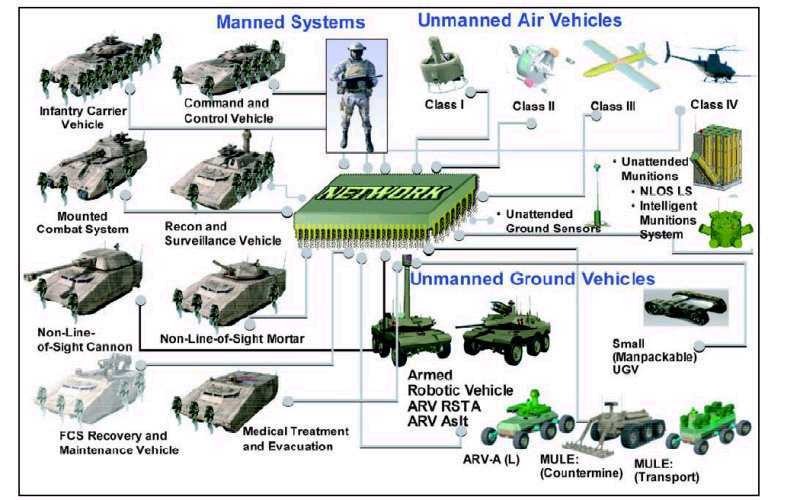
8. 60 years later, the Army is still playing with "futuristic" concepts like FCS when we could have had them back in 1947! Compare the current "Future Combat System" of 2006 (see pic above) to Gavin's of 1947...his vision is actually more revolutionary, creative and practical because its PHYSICALLY offering capabilities while the current FCS is all about joining hands mentally with Tofflerian computer networks and embracing PHYSICAL WEAKNESS when we still live in a very large PHYSICAL world full of real, PHYSICAL enemies! Here Gavin shows a future TANK with 4 sets of tracks to like today's Bv206S keep moving in event of a landmine attack. Notice he has the driver in the hull center like today's M1 Abrams heavy tank. The turret has twin autocannon like the German Geopard for a high rate of fire to shoot down aircraft or ground targets.

Another amazing concept from General Gavin: Airborne Combat Engineers arriving inside KIWI pods with ALL the gear they need to scrape out and pave a runway for an assault landing zone. Gavin has a front bulldozer blade and a backhoe with operator facing rearward like on today's John Deere 510 combination front end loader and backhoe. He even has a sprayer vehicle that today could be Rhino Snot [Envirotac II] instant soil pavement for follow on echelon aircraft to land. Also notice he has a small 2.75" or 5" rocket barrage tracked vehicle that may even be UNMANNED. So much for the "new" and "revolutionary" unmanned ground vehicle concepts we hear today.

Lastly, General Gavin was THE driving force behind the Army getting thousands of helicopters. It also cost him an early retirement when he made lots of enemies at the Pentagon to get this to happen. Here he's got some help from the legendary Frank Piasecki, another (still living) legend and maverick with a tandem rotor heavy lift helicopter with what looks strangely like a detachable 40 foot ISO shipping container underneath as armored half tracks drive in and out from front/rear ramps long before the C-5 was created with them in the 1960s.
General Gavin's KIWI pod concept was and still is far ahead of its time.
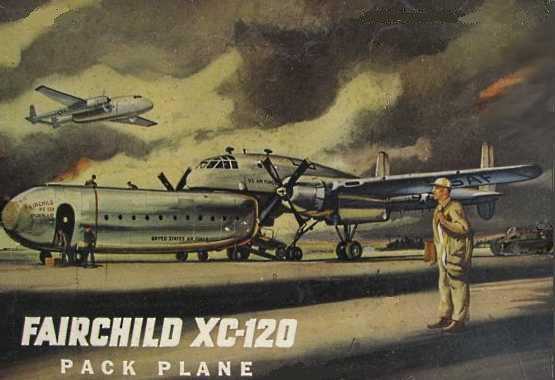
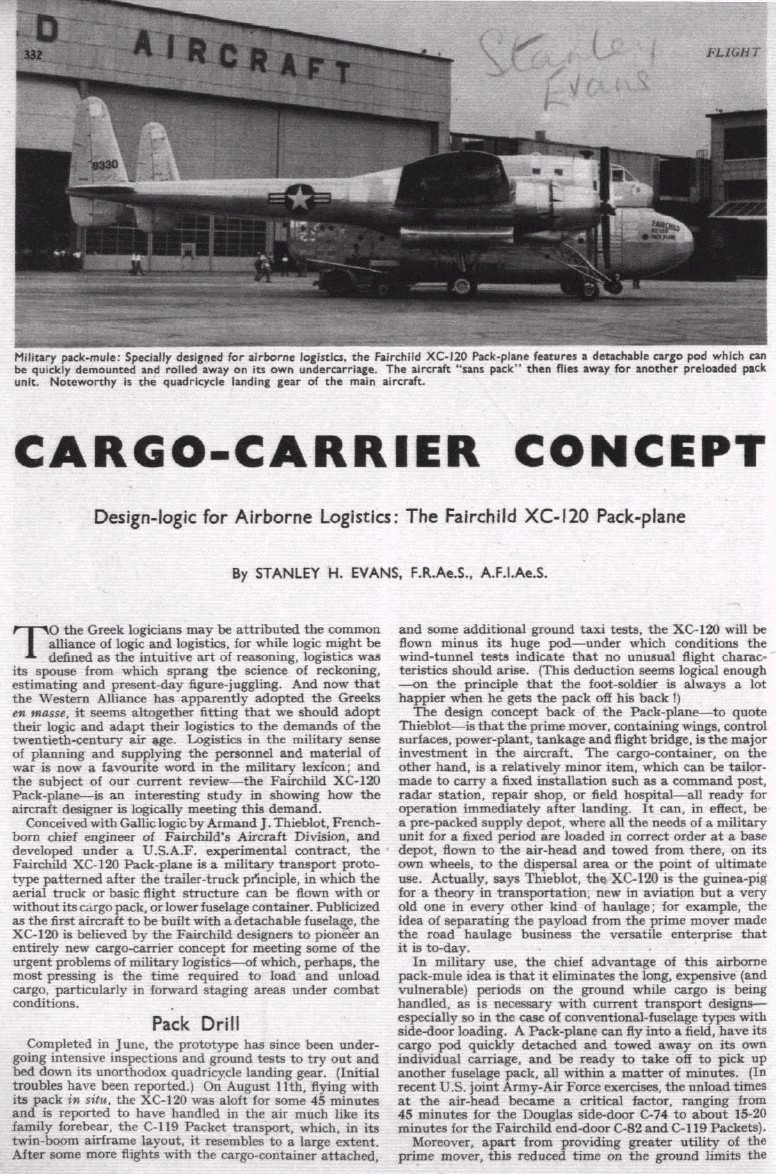
XC120details1.pdf
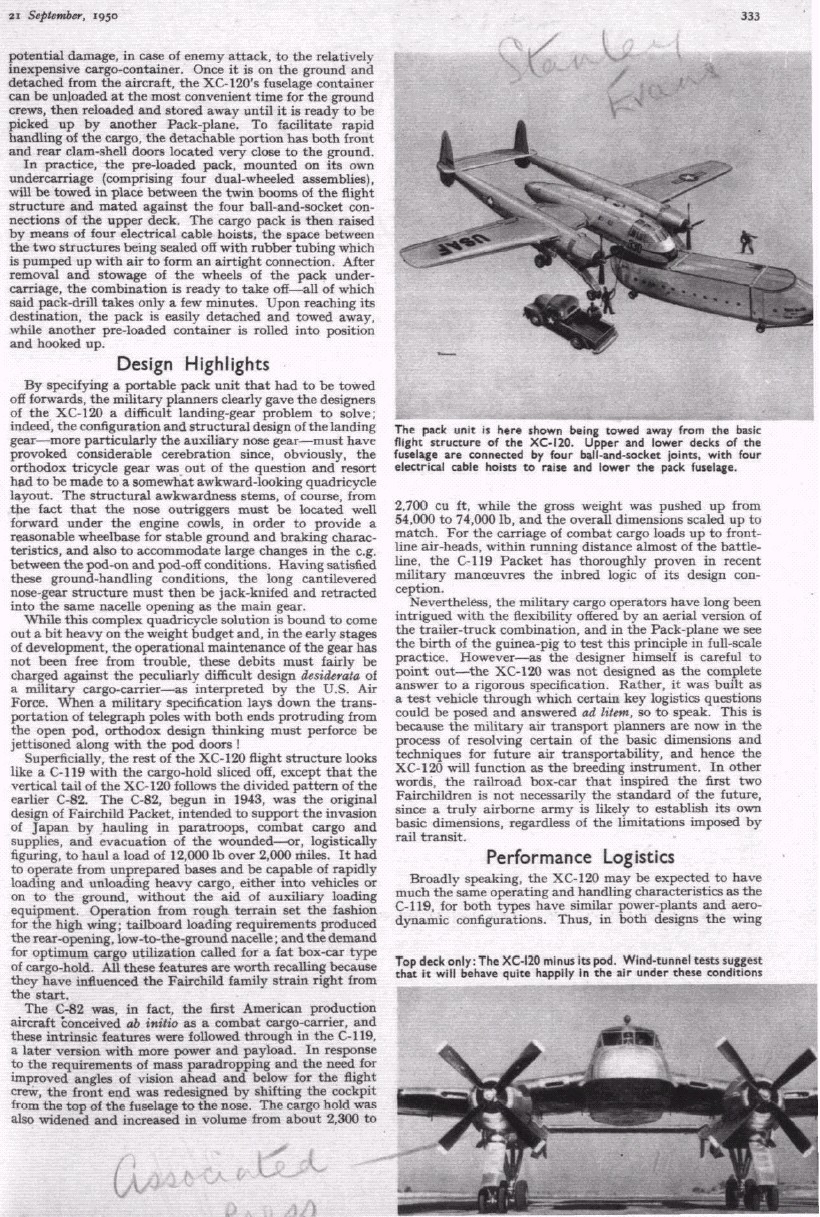
XC120details3.pdf
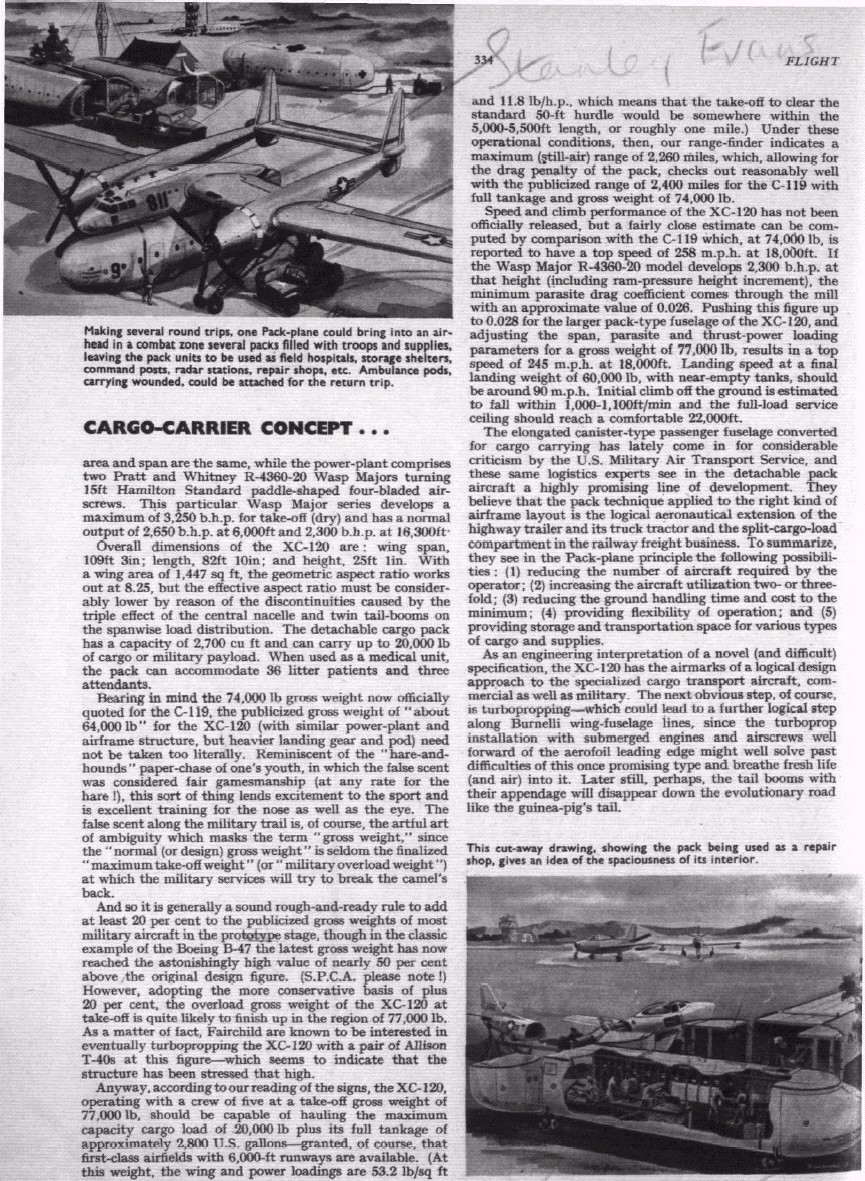
XC120details3.pdf
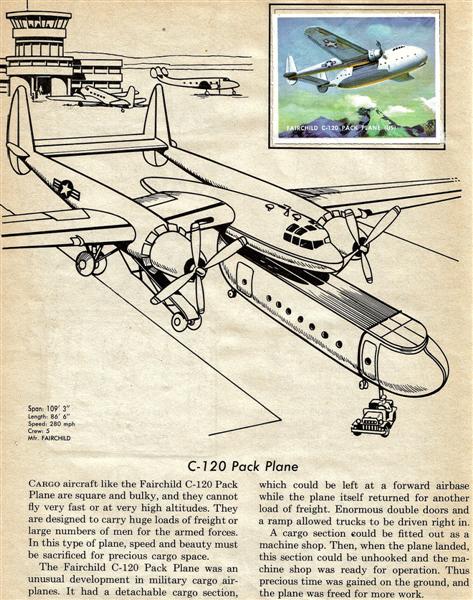
The piston-engined XC-120 simply did not have enough extra power to spare for the extra tare weight of a detachable pod. Today's turboprops and turbofans can enable a modular pod equipped plane to work but anti-physical DoD is not interested and wants to play with mental gadgets to steer firepower when Planet Earth is still a very big place where MANEUVER is the key to changing peoples and governments. We have the world-wide ISO shipping container system to be our "KIWI pods" we just need to design a fixed-wing cargo plane around these "BATTLEBOXes". The S-64 SkyCrane can carry one ISO container now snug up into its skeletal body (see description below). Pods would enable every unit in the U.S. Army to be READY-TO-FIGHT at all times with "BATTLEBOXes" ready to operate as soon as they are delivered by air, land or sea.
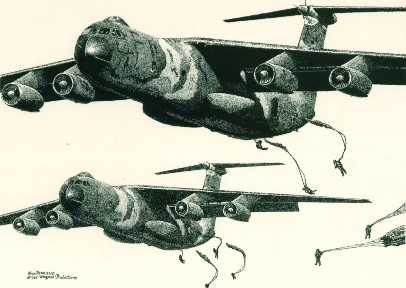
 M113 Gavin Low-Velocity AirDrop Part 1: How It's Done
M113 Gavin Low-Velocity AirDrop Part 1: How It's Done
www.youtube.com/watch?v=pp24PPc2orA
The truth of his words shown true today by the deeds of the U.S. Airborne in Korea, the Congo, Dominican Republic, Vietnam, Grenada, Panama, Desert Shield/Storm, Haiti, Bosnia, Albania/Kosovo, Afghanistan, Iraq...
"In reviewing these actions it is apparent that some military capabilities have been quite useful while others have assumed a much more modest role. In Panama, Haiti and Somalia the principal instrument of American power was its light infantry divisions. Secretary of State Warren Christopher noted that, 'despite the threat of air and naval attack, it was only when the Army's 82nd Airborne Division was in the air that the Haitian government of General Cedras stepped aside and agreed to the restoration of power to President Aristide.'"--Colonel M. Thomas Davis, USA, who is currently serving as a Federal Executive Fellow at the Brookings Institute. A separate version of this paper appeared in the 20 October 1996 edition of the Los Angeles Times.
"2 Para came within an ace of failure as, nearing exhaustion, outnumbered, low on ammunition, and lacking adequate fire support, they fought over open ground, and in daylight, against prepared positions.... was the battle necessary at all? Why did London overrule the brigade commander's reluctance to attack Goose Green? Did Colonel 'H' Jones's solo charge on Darwin ridge--which won him a posthumous VC--decide the issue? Goose Green was the first land battle of the war. It was also the longest, the hardest-fought, the most controversial, the most important to win, and the only one that hung in the balance for several hours.."
In response to the bitter fighting that resulted from the slow ship deployment of British troops to the South Atlantic which gave the Argentines time to reinforce, dig-in and lay mines, the Ministry of Defense created the 5th Airborne Brigade that can now fly to a world hot spot like the Falklands within hours. Hopefully detering aggression in the first place like the British Airborne as a full-sized Division did to stop Iraq invading Kuwait in 1961.
"Britain's Airborne rapid development force, 5th Airborne Brigade was setup in its present form after the Falklands War to deal with Out of Area Operations (O.A.O.). Which could be rapid reinforce of dependent territories; the evacuation of United Kingdom nationals from overseas trouble spots; assistance to friendly governments; international peace keeping operations and rapid response to emergencies."
CPT William S. Riggs in his article, "Global Cavalry" in the March-April 1998 U.S. Army Armor magazine writes:
"The marine meu (light infantry battalion-sized unit) possesses the ability to seize limited objectives from the sea as long as the objective is relatively near an ocean. If objectives are in land-locked countries, or located far from the sea, the marines are severely limited. In addition, with the procurement of advanced missile technology by many nations, the employment of marine forces places considerable risk on the ships bringing them ashore.Consider the problems and losses faced by the British in the Falklands against Argentine defenses. The marine corps is currently working on equipment and doctrine for extended projection operations from ships over the horizon... However, in the end, the ability to project CREDIBLE ground combat power into a theater is NOT a marine corps function.
The use of pre-positioned ships depends on a multitude of factors, ranging from having a secure port to disembark vehicles to air-heads that will support troop transports flying in Soldiers to link-up with their equipment. All of this assumes that the enemy has not sunk the pre-positioned ships prior to their arrival at a port facility. Therefore, the use of heavy forces in support of power projection operations is limited to their ability to be shipped and is therefore, realistically, not a good option if time is a factor."
Classic example of why the U.S. Army/AF wins the rapid deployment issue:
In March of '96, things got "hot" in Zaire.
The State Dept recalled all U.S. Citizens to the U.S. Embassy for possible evacuation. The mc, of course considering the NEO mission only for them, sent 26th MEU steaming to the region. Things were too hot however, and the NCA directed SETAF to take care of things. Immediately 1/508th ABCT, and the 21st Special Operations Squadron deployed to Congo, and Gabon. They were ready at the border to launch the NEO mission; Operation Guardian Retrieval with no notice. While they waited for the mc, the combined Paratrooper/MH-53J Pave Low III helicopter team rehearsed the mission.
The lightning fast mc, didn't arrive until the middle of April. SETAF then handed the mission over to 26th MEU. Naturally on the 26th MEU homepage, there is no mention of the troopers that arrived weeks before them, at a closer proximal staging area, with better trained troopers, and better rotary assets.
Then the next month, U.S. Army SF and the 21st SOS evacuated 2,000 Americans from Liberia for Operation Assured Response.
The point being the U.S. Army/Air Force Airborne team--be it the 82nd Airborne Division "All Americans" from CONUS or a regional Airborne Combat Task Force like in the Pacific, the 1/501st "Geronimos" or the previously mentioned European SETAF, the 1/508th "Red Devils" [now the 173rd Airborne Brigade]----can rapidly deploy themselves and their helicopters inside USAF transport jets to the scene faster and do the job immediately--be it rescues, NEOs or combat missions than the slow moving mc. The C-17 Globemaster III can also land almost anywhere 3,000 feet long and clear (roads, clearings etc) after flying inter-continental distances using in-flight refueling capabilities. The Paratroopers and their vehicles can also parachute in to ANY small clearing.
ERITREAN-ETHIOPIAN WAR ESCALATES: WHERE IS THE McMEU-SOC NOW?
ASMARA, June 7 - The Eritrean capital braced for more strikes by Ethiopia's powerful air force on Sunday after hundreds of foreigners seized their chance to fly to safety.
With no end in sight to the bewildering and undeclared war between the Horn of Africa neighbours, Asmara residents faced the real threat of more bombing raids from 7 a.m. (0400 GMT).
A 13-hour suspension of raids on Asmara airport, agreed by Ethiopia on Saturday, is due to end at that hour.
The let-up allowed hundreds of foreign nationals to board evacuation flights sent by the United States, Germany, Russia, Italy, Britain and the United Nations.
Ethiopian MiG fighters have hit Asmara airport three times since the war between the former comrades over a barren border area erupted on Friday.
Eritrea's tiny airforce is no match for Ethiopia's aerial might inherited from the Soviet-equipped regime which the two neighbours jointly toppled in 1991.
The United States and Rwanda, close friends of the two belligerents, have failed to mediate a settlement or a cessation of hostilities.
Italy, the colonial master of both countries between 1936 and 1941, described the conflict as "absurd" on Saturday.
One U.S. airforce Hercules transport plane flew Americans, including embassy staff, and other nationals to safety in Jordan on Friday night. A second, protected by U.S. marines, was still on the ground after midnight as U.S. charge d'affaires Don Yamamoto waited at the airport.
`I'm very unhappy to leave. I did want to stay but when they attacked the airport then I knew it was time to go,' said Julie Stewart of Columbus, Ohio, who had been teaching journalism at Asmara University.
Like many foreigners she feared heavy reprisals for Friday's strafing of streets in the northern Ethiopian town of Mekele by an Eritrean warplane. The 47 civilian victims, at least 10 of them children, were buried on Saturday as popular anger mounted in Ethiopia.
'Following the attacks on Mekele I expect the Ethiopians to bomb civilian targets in Asmara,' Stewart said before she was evacuated.
Ethiopia has a population of 60 million, which dwarfs Eritrea's by 15 to one. But both countries have huge armies by African standards and shared out an impressive arsenal of Soviet-bloc tanks, artillery and ammunition after their victory in 1991."
So if Airborne forces in both Britain and the U.S. can evacuate their country's citizens, better and faster than sea-based forces, why keep the latter if only sized and equipped to do minor raids/evacuations?
General Gavin is right. The time of the costly ship has passed, especially if embarked forces are not of significant size or loaded with numerous heavy armored vehicles and kept nearby troubled areas, since we can fly light Paratroops and AFVs in faster directly to the spot on land needed. Ships can bring in supplies to sustain the fight in the unlikely event it takes longer than 72 hours, but we should not surrender surprise and the initiative to the enemy by waiting for supply ships just so we can execute Montgomery-style set-piece attritional battles. The sad truth is that a grunt with a rifle in his hand and a ruck on his back is just as logistically isolated with his ships 50+ miles over-the-horizon as the Paratrooper whose supplies come by jet transports that fly at 500+ mph but are farther away, in fact more so. The V-22 cannot even carry a Humvee truck inside! There is no guarantee that noisy water landing craft (LCACs, AAVs) will not get exploded by mines or enemy ambush on the dash into the beach. Or that slower transport helicopters in broad daylight over the coverless water don't get shot down as they were readily in Vietnam. From there, the supplies have to travel overland somehow without motor vehicles? As our world shrinks by telecommunications, its getting more and more simpler to just call long distance by SATCOM and deliver LARGE AMOUNTS of supplies DIRECTLY to the Paratroopers in need by AIR drop/STOL airland, just like FedEX, than play around with miniscule amounts in the open sands. We must lead the attack from the AIR, move to the ground for lasting leverage and follow up with sea-based logistics if needed.
In war, TIME IS EVERYTHING.
Do you realize that in one pass, an aircraft kicks out everything inside, men and equipment, vehicles? At 500 feet thats less than 30 seconds in the air before on the ground. With the British LLP we could jump at 250 feet and make that 15 seconds. The entire force is assembled and moving to assault objectives in under 30 minutes. This is entire Brigades.
Have you ever been in a passenger plane?
Sure you have. Airlanding---requires a plane to land one at a time onto a runway or if it has STOL capabilities an "Assault Zone" cleared of parachutes/air items from the initial drop that is preferably 3,000 feet long but the C-130J and C-17 can do it in 1,400 feet. Airlanding ends up in a very slow build-up of combat power; study Crete, Dominican Republic and Grenada. The only benefits of Airlanding are that it enables light troops and posasibly medium-to-heavy M1/M2 tanks etc. to get there by AIR, but at a cost--the Assault Zone has to be seized first by Paratroopers. A technical bennie is you can squeeze a little more stuff in planes by airlanding; but you have to wait for it one at a time.
The concept that so few people understand is PIECEMEAL. In war you need MASS and/or superior firepower effects at the point of attack to prevail. So many think the helicopter is such a great tool when its under the same piecemeal woes as the fixed-wing A/C and it carries far less and only for short distances. We are trained at PATHFINDER School to try to get as many helos to land simultaneously as possible within a given Landing Zone (LZ) as possible. Without PATHFINDER support you get helos shot out of the sky at Koh Tang island in 1975, a McPiloted RH-53D crashing into a C-130 at Desert One in 1980 and the McNear-debacle in 1995 where a CH-53E Super Stallion lands too close to a farm fence and cannot lower its rear ramp, so an entire load of men sit inside a fuel-laden target unable to do anything.
In contrast, airdrop is faster, delivers more combat power and reduces aircraft exposure time to seconds. Its also safer for the aircraft than to land on a foreign Assault Zone even if surveyed by a CCT. Drop the Airborne and fly back to get another load.
The science of airdrop has improved to where injuries are now at 0.5% of the force delivered despite the brags of some which are just to create a danger "mystique" with jumping for ego purposes. Parachute forced entry is about strategic combat power, not ego.
In war, if you want to be lazy and sit on your ass taken to battle by a engine-driven machine of any kind you---are going to get creamed on the sensor-swept battlefield. Its far better to be a little less lazy and deploy away from the enemy's detection range than to expect vehicles to deliver you to rooftops, runways and beaches, where the enemy awaits.
Seize & Maneuver is the Future of Airborne Warfare--Not WW2 "Seize & Hold"
 www.youtube.com/watch?v=BE5NkDia3bY
www.youtube.com/watch?v=BE5NkDia3bY
General Gavin wanted to MANEUVER; even in WW2 if it meant on foot. Those that want to "Seize & Hold" are not living up to the Airborne legacy set by General Gavin and his Paratroopers. Don't be phonies. LEAD THE WAY.
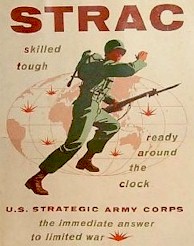
The U.S. Army XVIII Airborne Corps can Low-Velocity AirDrop: Para-Gator All-Terrain Vehicles, 4x4 HMMWVs with 2.75" Hydra-70 rockets and .50 cal HMGs, Enhanced Fiber-Optic Guided Missiles, and Line-of-Sight Anti-Tank firing hyper-velocity missiles, HIMARS trucks with MLRS long-range rockets; all it lacks is exchanging some 22,000 pound trucks for 11-ton M113A3 Gavin AFVs which would carry Paratrooper infantry squads and fire 106mm Recoilless Rifles or Javelin "fire & forget" ATGMs and to obtain some M8 Buford Armored Gun System Light tanks with 105mm main gun shock action, and its a completely mobile combined-arms force. Attack helicopters like "Killer Bee" OH-58D Kiowa Warrior, AH-64A/D Apache LongBow and something like the cancelled RAH-66 Comanche "Stealth" helicopter can be STOL airlanded into the Assault Zone by C-17 or C-130 aircraft in large numbers, or self-deploy by external fuel tanks to the combat arena, ready to fight. We win by operational maneuver from the AIR, that strikes at the enemy's "center of gravity" and collapse his will to fight and/or defeat the mind of the enemy commander(s).
That's for Nation-State Wars (NSWs).
For Sub-National Conflicts (SNCs) we need Airborne Quick Reaction Forces (QRFs) like the Rhodesian Fire Forces but enhanced with High-Tech M113 Gavin light tanks that can go cross-country at will for non-linear conflicts like Afghanistan--backed by border security sensor fences to box-in these fluid elements with an actual line at the border.

 Return to U.S. Army Airborne Equipment Shop
Return to U.S. Army Airborne Equipment Shop
